Dimitrios Konidaris's Blog, page 5
February 10, 2023
Aristotleâs Three Logical Figures: A Proposed Reconstruction
Aristotleâs Three Logical Figures: A Proposed ReconstructionReviel Netzhttps://brill.com/view/journals/phro/...
Abstract
Full Text
Metadata
References
Figures
Metrics
AbstractBased on the evidence of the likely near-contemporary mathematical practice of diagrams, this article proposes a possible reconstruction of Aristotleâs three figures as introduced in Prior Analytics 1.4â6.Keywords: Aristotle; Prior Analytics; reconstruction
Already Einarson 1936 pointed out the debt Aristotleâs logic owed to the mathematics of his time. Smith 1978 may have been the first to point out specifically that the alphabetic labels used in Aristotleâs logicâthe many A, B, Câ must have reflected diagrams in the manner of Greek mathematics.1 Indeed, (1) Aristotle was deeply aware of the mathematics of his time;2 (2) there was a significant burst of mathematical activity in the fourth century, much of it by authors related to Platoâs circle and so directly familiar to Aristotle;3 and, finally, (3) the use of lettered diagramsâindeed, of illustration in generalâwas, throughout antiquity, specific to mathematics and extremely rare in any other context.4 We can safely say: when Aristotle refers to letters, he almost certainly refers to diagrams in the Greek mathematical manner.
That Aristotleâs logical diagrams are now absent from the manuscripts of the Prior Analytics is disappointing but not surprising. There are cases where the Aristotelian corpus invokes diagrams, internal to the text, which were then lost to the textual transmission,5 and other cases where the transmitted Aristotelian text expected its readers to refer to diagrams external to the text itself.6 Either could obtain here. Smith himself did not try to reconstruct Aristotleâs logical diagrams but a number of proposals have been made in the past. Already in Late Antiquity, commentators produced visual pedagogic tools to help readers navigate Aristotleâs syllogisms. Modern scholars identify the first such use in Ammonius, early in the 6th century CE, with examples that clarify, for instance, statements in modal logic by the use of particular examples and a visual setting out of the relations between the terms:7
[image error]View Full Size
Citation: Phronesis 68, 1 (2023) ; 10.1163/15685284-bja10062Download Figure
Download figure as PowerPoint slide
The evidence from silence, prior to Ammonius (if this is indeed by Ammonius and not by later scribes) is not meaninglessâAristotleâs logic is among the most annotated texts from antiquity and the absence of such ancient figures, prior to Ammonius, is telling. It was likely in the same era as Ammonius, for instance, that the famous âPorphyryâs treeâ was first drawn, perhaps in the context of medical education in Alexandria.8 Diagrams such as those (perhaps) introduced by Ammonius or some other late ancient authors, as well as Porphyryâs tree, turn a conceptual relation into a two-dimensional structure, emphasizing the person of the teacher as the readerâs guide into a bookish world of learning: the typical move of late ancient and medieval commentary.
Many modern authors took such medieval diagrams as their inspiration for the reconstruction of Aristotleâs own lost diagrams. So, for instance, Kneale and Kneale 1962, 71â2:
[image error]View Full Size
Citation: Phronesis 68, 1 (2023) ; 10.1163/15685284-bja10062Download Figure
Download figure as PowerPoint slide
Rose 1968, 113â16 was overall cautious and explicitly noted the limits of relying upon the medieval tradition, and yet seems to have endorsed (cautiously) the following version:
[image error]View Full Size
Citation: Phronesis 68, 1 (2023) ; 10.1163/15685284-bja10062Download Figure
Download figure as PowerPoint slide
Such proposals are usually made in passing and without undue confidence. The only author I am familiar with to devote considerable effort to this reconstruction is Wesoly, in a series of spirited articles from 1996 onwards (followed by Englebretsen 2020). Wesolyâs diagrams possess much greater detail, with precise two-dimensional arrangements as well as arrows so that the visual annotation, as such, becomes in some sense logically sufficient. It seems that this logical efficacy is Wesolyâs main criterion for his historical reconstruction. So, Wesoly 2012, 198:
[image error]View Full Size
Citation: Phronesis 68, 1 (2023) ; 10.1163/15685284-bja10062Download Figure
Download figure as PowerPoint slide
What is absent from such modern reconstructions is an effort to locate Aristotle in the context of the mathematical practice that, after all, must have inspired him. Let us turn to this inspiration.
There are several contexts in which Greek mathematical texts refer to non-spatial entities, with some or all of the entities referred to, in the text, by single letters. It so happens that all of them use the very same diagrammatic principles, so that, if indeed these are Aristotleâs inspiration, the form of his logical diagrams becomes very clear.
The main extant sources are the treatment of numbers, in Euclidâs Elements Books 7â9; the treatment of general magnitudes in proportion, in Euclidâs Elements 5; and the treatment of notes, in the ps.-Euclidean Sectio Canonis. The comparison to music is the most obvious (and was the one emphasized by both Einarson 1936 as well as Smith 1978). Greek musical theory often proceeds by considering two concepts: single notes, and the intervals defined by them. This is reminiscent of the way in which, in Aristotleâs logic, one works through two main objects: single terms (such as âanimalâ, âhorseâ) and two-term premises (such as âAnimal belongs to all horseâ). In fact, one finds a similar structure in general proportion theory, with magnitudesâand their ratios. And since the discussion in Euclidâs arithmetical books, as well, usually concerns the ratios between numbers, we find a large, coherent field of applications, all reminiscent of Aristotleâs logic, studying non-spatial terms and their dyadic relations.
In the extant manuscripts, there are two major ways in which the terms belonging to those fields are represented.9 In the simplest case, the individual terms are represented as single lines, each set separately, all parallel to each other; next to each, its alphabetic label. Sectio Canonis 1 is a simple example:10
Let there be an interval BC, and let B be a multiple of C, and let B be to D as is C to B. I assert then that D is a multiple of C.
[image error]View Full Size
Citation: Phronesis 68, 1 (2023) ; 10.1163/15685284-bja10062Download Figure
Download figure as PowerPoint slide
A somewhat more complicated case arises where one needs to sum up, or subtract, terms. Now, in music, one note added to another does not make a third note, but, instead, it makes an ontologically distinct objectâthe interval. (Occasionally, however, notes are considered strictly as numerical values, and then they may be summed up or subtracted.). A magnitude, however, added to a magnitude, does give rise to a third magnitude, hence representations such as those of Euclidâs Elements 5.1:
Let any number of magnitudes whatever AB, CD be respectively equimultiples of any magnitudes E, F equal in multitude. I say that, whatever multiple AB is of E, that multiple shall AB, CD also be of E, Fâ¦. Let AB be divided into the magnitudes AG, GB equal to E â¦11
[image error]View Full Size
Citation: Phronesis 68, 1 (2023) ; 10.1163/15685284-bja10062Download Figure
Download figure as PowerPoint slide
In the course of Elements 5.1 one considers AB as a composite of AG, GB; hence the magnitudes AG, GB are each defined by two labels. The magnitudes E, F do not participate in such compositions and therefore each is labeled by a single letter. In this case, then, we still have lines set in parallel, but some of the lines have a single letter next to them while others have three or more letters, referring to two or more elements, each bounded and labeled by the combination of two letters.
The examples from music, proportion theory and arithmetic are not only widespread, and coherent, but are even close in time to Aristotleâs (in general, it seems clear that mathematics directly inspired by music theory was especially dominant in the fourth century BCE12). It is worth noting that the practice is found in later sources as well: so, for instance, Archimedesâ Sphere and Cylinder 1.2, solving a problem in geometrical proportion theory, where AB, D are set out as general magnitudes (see the figure on the next page).13
In short, there is no ambiguity in the historical evidence, and to the extent that we believe that mathematics was indeed Aristotleâs inspiration, we know precisely which diagrams it was that inspired him: parallel lines, with letters set next to them.
[image error]View Full Size
Citation: Phronesis 68, 1 (2023) ; 10.1163/15685284-bja10062Download Figure
Download figure as PowerPoint slide
The text of the Prior Analytics rather infrequently refers to the combination of two labeled terms (the very first introduction of labeled terms, 25a14, is one such exception: hÄ AB protasis, âthe premise ABâ, and there are a few similar uses later in the treatise. These, as noted, are the functional equivalent of âintervalsâ in music). Much more often, the text refers simply to single terms taken in isolation. And, indeed, such terms are like musical notes, not like mathematical magnitudes. A âhorseâ, added to an âanimalâ, does not make a new, third term. It can only make an ontologically distinct categoryâa premise. To the extent that Aristotle is inspired by mathematics, then, his diagrams should take the form of parallel lines, with a single letter next to each.
Fortunately for us, Aristotle does briefly discuss the spatial structure of the figures as they are introduced. So, with the first figure (25b35â7):14
I call that the middle which both is itself in another and has another in itâthis is also middle in positionâand call both that which is itself in another and that which has another in it extremes.
Obviously Aristotle uses the word âmiddleâ primarily in a logical sense, but he notes that, in the figure, the object standing for the logical middle is in fact in the spatial middle of the figure (âin positionâ); this helps to clarify that âextremesâ, too, are so-called because they are at the two spatial extremes of this arrangement which we can now understand as three parallel lines. Aristotle later on refers to one of those extremes as âgreaterâ and to the other as âsmallerâ. In the usage of Aristotle scholars those adjectives become âmajorâ and âminorâ and scholars have got used to think of those terms as marking a logical position in the syllogism, but it is extremely likely, given the presence of a figure with straight lines, that Aristotle in fact refers to the sizes of the lines.15 In this case of the first figure, then, relations of size are replicated as relations in space: the line in the middle is also middle in size.
So far, then, we have established that we have three parallel lines marked (in Latin transliteration) from A to C and arranged in that order, such that A>B>C in length. There are in principle two degrees of freedom, depending on the direction by which we wish to move from A to C: left to right or right to left, top to bottom or bottom to top. (It would be very surprising, given the mathematical examples or indeed given general cognitive considerations, to have anything other than a single horizontal or vertical arrangement).
The second figure is discussed in slightly greater detail (26b35â39):
⦠I call such a figure the second. In it, I call that term the middle which is predicated of both, and call those of which it is predicated extremes; the major extreme is the one lying next to the middle, while the minor extreme is the one farther from the middle. (The middle is placed outside the extremes and is first in position).
Previously, Aristotle noted the coincidence that the middle in size was also the middle in position. He does not repeat this now because the relations of position are now altered. Unless Aristotle actively seeks to confuse his readers, we are meant to understand that the relations of âgreaterâ, âmiddleâ and âsmallerâ are now strictly the relations of size between the lines. The positions, on the other hand, are explicitly spelled out: the middle is first in position, followed by the greater and then finally followed by the smaller. Aristotleâs reference to âfirstâ and âfartherâ strongly imply that he is referring to a figure organized from left to right. Had the figure been organized from the top to bottom, one would have expected terms such as âaboveâ and âbelowâ; it is hard to believe that âfirstâ does not mean, here, âleftmostâ, with the three terms arranged in the order of writing, from left to right.16
Finally, here is the description of the third figure (28a13â15):
[in the third figure,] by major extreme I mean the one farther from the middle and by minor the one closer. The middle is placed outside the extremes and is last in position.
Here we have the greater line, followed by the smaller line, with the middle line appearing last.
In the preliminary passage of chapters 1.4â6, as he introduces the figures, Aristotle makes several comments and produces several examples for each. When discussing the first figure, the terms are then always (in Latin transliteration) A, B, C; when discussing the second, they are M, N, X; when discussing the third, they are P, R, S. The alphabetical order from M to X, and from P to S, is assigned according to the spatial, rather than the logical arrangement: thus, in the second figure, M is the middle while, in the third figure, S is the middle. The consistent reference to the same labels in those chapters, 1.4â6, powerfully suggests that Aristotle refers, throughout, to a single set of material figures. Further, the explicit reference to âsecondâ and âthirdâ figures suggests that the figures are located together and marked by a word or, perhaps better, a numeral. Indeed, the main reason to think that the figures are organized together on a single diagram is the very choice to mark each with a separate set of labels. Later on in the treatise, when Aristotle discusses the second and third figures, he generally speaking reverts to A, B, C: there is no deep connection, in his mind, between the second figure and the letters M, N, X and between the third figure and the letters P, R, S. The choice to label each with different letters makes sense, however, if the three figures are considered as part of a single drawing, so that A, B and C are simply not available for the second and third figures. Aristotleâs âthree figuresâ are therefore, likely, to begin with, a single diagram with, indeed, three figures in it, which we are now in a position to reconstruct:
[image error]View Full Size
Citation: Phronesis 68, 1 (2023) ; 10.1163/15685284-bja10062Download Figure
Download figure as PowerPoint slide
If nothing else, then, this is helpful in the basic terms of Aristotelian hermeneutics. The passages quoted above have all been a thorn in scholarshipâs side, the references to the relative locations taken in various metaphysical or syntactic senses,17 but they become straightforward as soon as the visual reference is understood. For this reason alone, I am profoundly perplexed by the fact that the argument of this paperâwhich is, as far as I can see, nothing more than the plain reading of Aristotleâs textâhas not yet been made. Perhaps this is yet another example of past humanistsâ focusing on text and ignoring image (even where the text plainly speaks about images.) More to the point, a number of past scholars, as noted, did suggest possible reconstructions of the figures and what is noticeable is that all of them looked for efficacious diagrams: that is, diagrams whose very structure would provide material help in judging the validity of logical claims. This trend in the scholarship in part reflects the influence of the transmission: it is hard to look for Aristotleâs figures without thinking about the significant accumulation of late ancient and medieval visual tools which are, indeed, generally speaking, more eloquent than those reconstructed above. But this is unfair: modern scholars know full well that this scholiastic tradition begins not earlier than Late Antiquity. The main reason past scholars looked for efficacious diagrams must have been that, otherwise, it was less clear to them why Aristotle would go through the trouble of drawing them in the first place.
Why indeed have the figures? To begin with, the figures reconstructed above are not entirely unhelpful. One thing which I think they are good for is for showing that it is indeed reasonable to have precisely three figures. A momentâs combinatoric reflection shows that there are six ways of arranging three lines of unequal length and that these six fall into three symmetrical pairs. (One gets all six arrangements by taking the three figures reconstructed above, and then flipping each along a vertical axis, so that the decreasing first figure A-B-C becomes an increasing mirror figure C-B-A, etc.) Clearly, the symmetrical arrangement is not considered to be a separate case, since one studies a particular relative order between the middle and the extremes; hence three figures are sufficient.
Further, the figures are clearly useful as, so to speak, mnemonic tools: once we become familiar with the meaning of length and sequence, we can use them to read off the overall structure of the figure. A syllogism has two premises and a conclusion. Each of these states a predication, which is spatially organized from left to right. The premises are the two predications involving the middle; the conclusion is the one involving the greater and the smaller alone. Thus, in the first figure, the two premises are that the greater is predicated of the middle and the middle is predicated of the smaller. In the second figure, the two premises are that the middle is predicated of both greater and smaller; in the third, that both the greater and the smaller are predicated of the middle. In all cases, the conclusion is that the greater is predicated of the smaller. (That the predication runs from the greater to the smaller and not vice versa is simply Aristotleâs way of choosing his three figures out of the six available).
In other words, the figures of the Prior Analytics, as I reconstruct them, are good for specifying the references of the discourse. Of course, diagrams can do much more in geometry, where the more topological relations seen in the diagram, such as inclusion or intersection, can be read off as holding between the geometrical objects themselves.18 A minimal version of this is preserved by some non-spatial diagrams, for instance as seen in Elements 5.1 above: the relation of the labels A, G, B as depicted along a single line in the diagram can be used to show that AG + GB = AB (this is topological inclusionâas algebraic summation). But this is no longer the case in the diagrams of Greek music, arithmetic or proportion theory, where each line has only a single letter standing next to it. Thus, in a diagram such as the first one of the Sectio Canonis, as seen above, the relations of the labelsâthat these are three lines, in decreasing length from left to rightâare not deductively active at all. Once the setting-out verbalizes those relations, the ordering of the three lines in a particular order of size serves, perhaps, as a mnemonic, allowing the reader to pick off from the figureâwithout the need to go back to the textual statement of the setting outâwhich is a multiple of which (the greater, of the smaller). But no conclusion flows from the visual ordering of the figure itself, over and above the statements already contained in the setting out. Such, then, were, I argue, Aristotleâs logical figures. Which is evidently the case: after all, the loss of the figures did not prevent us from following any of Aristotleâs arguments. The figures are, indeed, in this sense, deductively inert.
But perhaps all of this misses a more fundamental point. This way of talking about âmnemonicsâ seems to suggest that Greek mathematicians used line diagrams in their music theory, arithmetic and proportion theory, so that they would have a good mnemonic with which to know what âAâ, âBâ and âCâ refer to. This, I think, is misleading and seems to ignore the crucial fact that the use of such diagrams was an absolute requirement. Absent a figure with lines, Greek mathematicians felt that they did not properly set up their references. In other words, the function of the lines is not mnemonic but semiotic. We are so habituated to the use of letters as semiotic tools that we see them as transparently representative of abstract objects such as magnitudes, numbers or notes, but it should be emphasized a shape such as âAââtwo slanted lines and a smaller horizontal line running in between themâhas nothing to do, as such, with, say, the sounds of music. âAâ is no more and no less natural as a symbol for a musical note than a vertical straight line. In Greek mathematics, one became habituated to lines as the natural semiotic tools. It is not as if the symbolism of a Greek mathematical text was constituted by letters of the alphabetâwhich were then displayed, for mnemonic purposes, as lines. Rather, the symbolism of a Greek mathematical text was constituted by points and lines, which were then labelled, for the sake of ease of reference, by letters of the alphabet. In a geometrical context, a lineâhowever badly drawnâstands for a line. In an arithmetical context, it stands for a number, in a musical context for a note. And in the case of Aristotleâs logic, it could stand for a horse.19 It is inconvenient, in geometry as in logic, to keep pointing with oneâs index fingerââthis lineâ, âthat lineââand for this reason letters of the alphabet were attached as indices allowing easier reference (that could also be directly textualized).20
Two comparisons come to mind. First, in Chrysippusâ logic one no longer uses letters and instead, when the elements of logical demonstrations (which, in Chrysippusâ logic, are propositions) are picked up, they are referred to by ordinal numbers, âthe first,â âthe second,â etc.21 This is not a matter of innocuously transitioning between equivalent ordinal systemsâletters of the alphabet, ordinal numbersâbut rather serves to remind us that Chrysippus no longer uses diagrams. Chrysippusâ ordinal numbers do not pick up elements in a spatial array of lines but, instead, pick up elements in the temporal series of natural language. The âfirstâ proposition is the one first asserted, the âsecondâ follows it, etc. So, yet another example of Chrysippusâ turning away from the science of his time.22
Second, we may note claims such as those made by Kneale and Kneale (1962, 61), that one of Aristotleâs great innovations was that he â[used] letters as term-variablesâ. Considered sufficiently abstractly, it is perhaps valid to consider the line, next to which the letter A lies, as a term-variable. (The line may stand for âhorseâ but it may also stand for âanimalâ). But the letter A is not a variable, because it is not even a symbol but is, instead, simply an index, picking up a reference to a particular line. Perhaps a failure to see that is among the difficulties preventing past scholars from visualizing Aristotleâs figures. It is noteworthy that the reconstructions offered by past scholars are all variations on the idea of enmeshing alphabetic letters within system of curves and arrows, the letters standing for terms and the curves and arrows for their relations. In fact, Greek diagrammatic practice does not use letters as symbolic representations for the terms under discussion: for this, one mostly has to wait for modern algebra. Aristotle himself would have been familiar with a different kind of diagrams, where the letters were tools for pointing at things; a textualized alternative to oneâs index finger.
We find ourselves pondering Aristotleâs index finger and so we are drawn to consider the context and materiality of the figures. As noted, the stability of the lettering for each figure for the duration of chapters 1.4â6 suggests the existence of a single set of figures and the most obvious hypothesis is that Aristotle worked in a classroom where he could refer to a fixed drawing (a whiteboard, perhaps?23). I think that this is very likely but that we should also admit our ignorance and consider a wider range of possibilities. As noted above, the lettering of the second figure with M, N, X and of the third with P, R, S is kept only through 1.4â6 and, later on in the treatise, Aristotle usually refers to diagrams with A, B, C even when discussing the second and third figures. This reveals to us two things. First, it emphasizes, once again, that the main semiotic tool are the lines, not the labels. Aristotle evidently feels that the figure consists not in the choice of three labels but in the spatial arrangement of three lines of differing lengths. Second, the text of the Prior Analytics does not emerge just from the context of speaking about a single diagram, on a single whiteboard, on the walls of the Lyceum. Had Aristotle referred throughout the treatise to that single figure, drawn on the wall, he would always use the labels introduced in chapters 1.4â6. But if he does not refer to a single set of figures throughout, and instead relies on different visual aids in different contexts, we are left very much in the dark concerning the details of his practice in any particular context. The best statement in my view is that the environment of Aristotleâs school was awash in a variety of textual artifacts: papyri, whiteboards, wax tablets (among other media).24 Learning and research were done mostly in oral conversation, making reference to such textual artifacts as the need arose. Sometimes, one looked at the documents of the master and of his close associates. Probably multiple copies were made of these, and it is likely that many of those copies accompanied the text itself by the drawings it implied. Sometimes, one would refer to drawings attached to the wall. In particular, it seems likely that at some point Aristotle discussed in oral teaching the basic principles of the syllogistic, and that this discussion was pursued in sight of a whiteboard, containing the three figures. This discussion informed chapters 1.4â6 of the Prior Analytics. Its diagram was then lost; I believe it is now reconstructed.
BibliographyAsper, M. (2015). Peripatetic Forms of Writing: A Systems-Theory Approach. In: Hellmann, O. and Mirhady, D., eds., Phaenias of Eresus, New Brunswick: NJ, pp. 407â432.
Barker, A. (1989). Greek Musical Writings. Cambridge.
Bobzien, S. (2005). Logic. In: Algra, K., Barnes, J., Mansfeld, J. and Schofield, M., eds., The Cambridge History of Hellenistic Philosophy, Cambridge, pp. 77â176.
Carman, C.C. (2018). Accounting for Overspecification and Indifference to Visual Accuracy in Manuscript Diagrams: A Tentative Explanation Based on Transmission. Historia Mathematica 45.3, pp. 217â236.
Corbett, G.G. and Fraser, N.M. (2000). Default Genders. In: Unterbeck, B. and Rissanen, M., eds., Gender in Grammar and Cognition, New York, pp. 55â97.
Einarson, B. (1936). On Certain Mathematical Terms in Aristotleâs Logic. American Journal of Philology 57, pp. 33â54, 151â72.
Englebretsen, G. (2020). Figuring it Out: Logic Diagrams. Berlin.
Heath, T.L. (1926). The Thirteen Books of Euclidâs Elements. Cambridge.
Ierodiakonou, K. (2002). Aristotleâs Use of Examples in the Prior Analytics. Phronesis 47.2, pp. 127â152.
von Jan, K. (1895). Musici Scriptores Graeci. Leipzig.
Kneale, M. and Kneale, W. (1962). The Development of Logic. Oxford.
Lee, E. (2020). Visual Agency in Euclidâs Elements: A Study of the Transmission of Visual Knowledge. Stanford PhD.
van Leeuwen, J. (2016). The Aristotelian Mechanics: Text and Diagrams. Berlin.
Manders, K. (2008). The Euclidean Diagram. In: Mancosu, P., ed., The Philosophy of Mathematical Practice, Oxford, pp. 80â133.
Netz, R. (1999). The Shaping of Deduction in Greek Mathematics: A Study in Cognitive History. Cambridge.
Netz, R. (2004). The Works of Archimedes, Translation and Commentary. Volume I: The Two Books on the Sphere and the Cylinder. Cambridge.
Netz, R. (2013). Authorial Presence in the Ancient Exact Sciences. In: Asper, M., ed., Writing Science, Berlin, pp. 217â253.
Netz, R. (2020). Scale, Space and Canon in Ancient Literary Culture. Cambridge.
Netz, R. (2020b). Why were Greek Mathematical Diagrams Schematic? Nuncius 35.3, pp. 506â535.
Netz, R. (2022). A New History of Greek Mathematics. Cambridge.
Rose, L.E. (1968). Aristotleâs Syllogistic. Springfield.
Savage-Smith, E. (2002). Galenâs Lost Ophthalmology and the Summaria Alexandrinorum. Bulletin of the Institute of Classical Studies 77, pp. 121â138.
Smith, R. (1978). The Mathematical Origins of Aristotleâs Syllogistic. Archive for History of Exact Sciences 19, pp. 201â209.
Smith, R. (1989). Aristotle: Prior Analytics. Indianapolis.
von Staden, H. (2013). Writing the Animal: Aristotle, Pliny the Elder, Galen. In: Asper, M. (ed.) Writing Science, Berlin, pp. 111â144.
Striker, G. (2009). Aristotle: Prior Analytics Book I. Oxford.
Thomas, J.J. (2019). The Illustrated Dioskourides Codices and the Transmission of Images during Antiquity, Journal of Roman Studies 109, pp. 241â273.
Thomas, R. (1992). Literacy and Orality in Ancient Greece. Cambridge.
Vitrac, B. (2002). Note Textuelle sur un (Problème de) Lieu Géométrique dans les Météorologiques dâAristote (III. 5, 375 b 16â376 b 22). Archive for history of exact sciences 56, pp. 239â283.
Wallies, M. (1899). Ammonii in Aristotelis Analyticorum priorum librum I commentarium. Commentaria in Aristotelem Graeca IV.6. Berlin.
WesoÅy, M. (1996). Aristotleâs Lost Diagrams of Analytical Figures. Eos 74, pp. 53â64.
WesoÅy, M. (2012). ÎÎÎÎΥΣÎΣ Î ÎΡΠΤΠΣΧÎÎÎΤΠ. Restoring Aristotleâs Lost Diagrams of the Syllogistic Figures. Peitho, pp. 83â114.
NOTES
1
The best treatment of Aristotleâs quasi-mathematical passages is a concise section in an article by Vitrac (2002, 248â55).
2
Not that this requires any special evidence, but the ubiquity of mathematical examples in the Analytics itself is relevant: see Ierodiakonou 2002.
3
This claim is elaborated in the second chapter of Netz 2022.
4
Netz 2013, 232â41.
5
The clearest case is the ps. Aristotelian Mechanics, whose extant diagrams were introduced by Byzantine handsâso, evidently, were lost at some point prior to the Middle Ages (van Leeuwen 2016, 97â101).
6
In his biological works Aristotle occasionally asks the reader to consult a separate text, titled the anatomai, âdissectionsâ, in order to visualize the contents of the biological text. It is widely believed that the anatomai contained visual images of anatomical structures. See von Staden 2013, 115â17.
7
Image (with my translation) from Wallies 1899, 39. I am not sure that the figures in Ammoniusâ text are from his own hand, rather than coming from the hand of a later Medieval accretion, but at any rate no earlier figures of this kind are attested. (Of course, the fact that the earliest author in whose textual tradition those diagrams are found is Ammonius is not dispositive though it does suggest, as the text asserts, a fairly late origin). This particular form of curved lines connecting terms is ubiquitous in Medieval scholia of music and proportion theory and belongs to an entire domain worthy of study on its own right (Lee 2020 is a beginning in this direction of the study of what he calls visual scholia).
8
Savage-Smith 2002, 122â5.
9
There is reasonable room for debate concerning the fidelity of the medieval transmission of diagrams. See Carman 2018, Netz 2020b. However, the question considered here is that of the basic tools of representation and it is a prudent assumption that our manuscript evidence is, at this broad level, correct. (Notice, however, that I do not think we should put much stock in, for instance, the orientation of the lines in the manuscriptsâthis was certainly transformed, at least occasionally, according to the spatial needs of the scribes; see n. 11 below).
10
von Jan 1895, 150 clearly explains the manuscript evidence concerning the diagrams, which seem to be reconstructed by the editor while keeping closely to the manuscript evidence. Translation from Barker 1989 II, 194.
11
Translation (and first figure) from Heath 1926 II, 138. In fact, in the main Greek manuscripts the lines are vertical, and I provide an example in the second figure, from Vat. Gr. 190 75v. This manuscript stands out, however, in that the diagrams of Book 5 are inset within the main text; usually, they are arranged on the margins and it is possible that this could have influenced the orientation. âThe most common and apparent external factor guiding diagram shape is its allocated spaceâ (Lee 2020, 226).
12
Once again, this is discussed in Netz 2022, second chapter. I emphasize the musical context in this paper. It was the main context suggested by the seminal paper in the field of the mathematics of the Prior Analytics, namely Einarson 1936. Netz 2022, chapter 2, serves to explain why this is in fact likely to have been the most salient context. Briefly: no figure loomed as large over the mathematics of the early fourth century as that of Archytas, and it is reasonable to assume that, of his achievements, the foundation of musical theory is the one that mattered most to contemporary philosophers.
13
Netz 2004, 44. As noted there, the lay-out of the figure is the same across the manuscripts.
14
Translations of Prior Analytics are all from Smith 1989.
15
It is perhaps worth mentioning that what is sometimes called, in modern logic, âthe minor premiseâ is, for Aristotle âthe premise at the smaller extremeâ (e.g. 51a23: my translation).
16
That the natural order of diagrams is, in Greek, according to the order of writing from left to right, is expected and overwhelmingly observed in the evidence. A related consequence is that diagrams are often inverted when translated into Arabic: Lee 2020, 262.
17
For instance Striker 2009, 100, on the second figure: â⦠The labels âmajorâ, âmiddleâ, and âminorâ are no longer linked to the extensions of the terms. This has the somewhat paradoxical result that the middle is said to be âplaced outside the extremesâ.â
18
This argument has been pursued by Manders 1995 (2008) and Netz 1999, and is now widely accepted in the scholarship.
19
This is flippant: the reference of the line is not a horse but more general. Indeed, there is no good account in the literature for the use of the neuter article for the terms of the syllogism such as to A, âthe Aâ (the noun âtermâ, itself, is masculine). It appears that the neuter article takes on, in this specific context, the indefinite meaning of âthe A <whatever it might be>â. This is a question of Greek grammar rather than of Aristotelian exegesis, but it does appear that at some level of abstraction, neuter could be understood as the default case. (For a suggestive analogous discussion, see Corbett and Fraser 2000, 6â72: why does Russian use neuter in bylo kholodno, âit [neuter] was coldâ? Who is the neuter subject being cold here? Apparently, âthings in generalâ?) Whatever our interpretation of this grammatical question, it is clear the article refers not to the line (which would have required a feminine article) but to the thing represented by the line.
20
The indexical character of the letters used in Greek mathematical texts is the subject of Netz 1999, 42â51. Of course, in the case of mathematics the texts we possess were intended for an audience of readers, distant in place and time, so that indices alone could never suffice; this is less clear for the texts we now know as the works of Aristotle.
21
See e.g. Bobzien 2005, 129â31.
22
Netz 2020, Section 4.4.
23
There was a practice of publishing decrees etc. not only as stone inscriptions but also on wooden boards (made white by being covered with gypsum; presumably the writing itself was charcoal-based). Such temporary inscriptions were referred to as leukÅmata (not to be confused with the homonymous eye disease). Since the technology was available, it is assumedâthough no direct evidence existsâthat it was also used for teaching. A suggestive proposal is that writing on wood would be especially amenable for more elaborate drawings (Thomas 2019, 262â3; for a brief statement on leukÅmata in general, see Thomas (no relation) 1992, 83).
24
This is analogous to the way in which the Peripatetic writing project gradually became a manifold of many genres, the argument of Asper 2015.
February 9, 2023
AEGINA AS A STATE-LIKE POLITY EARLIER THAN MYCENAE
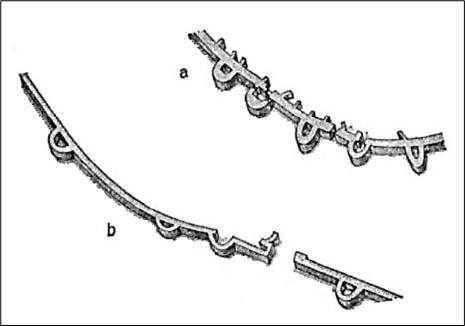 ÎÏÏ
ÏÏμαÏικά ÏείÏη (α) οικιÏÎ¼Î¿Ï Los Millares και (β) ΧαλανδÏÎ¹Î±Î½Î®Ï Î£ÏÏοÏ
ÎÏÏ
ÏÏμαÏικά ÏείÏη (α) οικιÏÎ¼Î¿Ï Los Millares και (β) ΧαλανδÏÎ¹Î±Î½Î®Ï Î£ÏÏοÏ
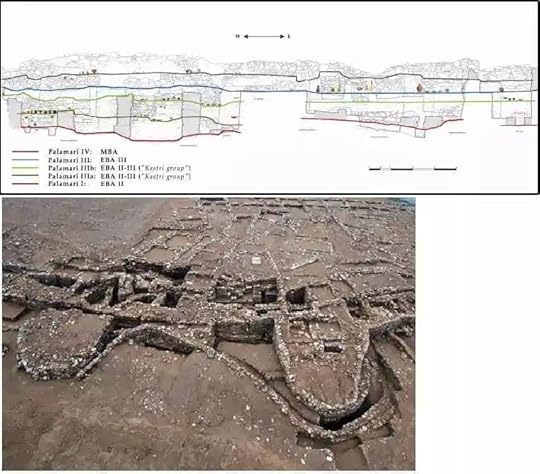 ΠαλαμάÏι ΣκÏÏοÏ
ΠαλαμάÏι ΣκÏÏοÏ
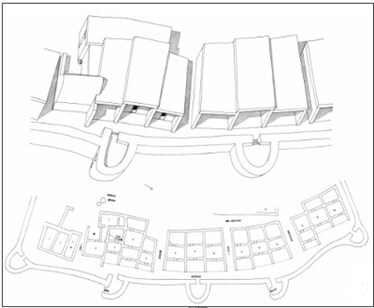 ÎÏÏ
ÏÏμαÏικά ÏείÏη και Î¿Î¹ÎºÎ¯ÎµÏ ÎολÏÎ½Î±Ï V[1]
ÎÏÏ
ÏÏμαÏικά ÏείÏη και Î¿Î¹ÎºÎ¯ÎµÏ ÎολÏÎ½Î±Ï V[1]Î ÏÏÏÎ¿Ï Î¿ÏÏ ÏÏÏεÏÏ Î¼Îµ ÏεÏαλÏÏÏÎ·Î¼Î¿Ï Ï ÏÏομαÏÏÎ½ÎµÏ Î±ÏανÏά ÏÏÎ¹Ï Î¸ÎÏειÏ: ΧαλανδÏιανή ΣÏÏÎ¿Ï , ΠαλαμάÏι ΣκÏÏÎ¿Ï , Îάξο (ΠάνοÏμοÏ), Îίγινα, ÎÎÏνη, αλλά και ÏÏο Liman Tepe, ÏÏο ÏÎµÎ»ÎµÏ Ïαίο μάλιÏÏα Ïε δÏο θÎÏειÏ.[2]
ΣÏμÏÏνα με ÏÎ¿Ï Ï Ludvik, Kenoyer & PieniÄ Å¼ek είναι:[3]
Το οÏÏ ÏÏμÎνο κÎνÏÏο ÏÏα μÎÏα ÏÎ·Ï 3Î·Ï ÏιλιεÏÎ¯Î±Ï Ï.Χ. ÏÏην Îίγινα-ÎολÏνα αναÏκάÏηκε αÏÏ Ïο ΠανεÏιÏÏήμιο ÏÎ¿Ï Î£Î¬Î»ÏÏμÏÎ¿Ï Ïγκ Ï ÏÏ Ïον C. Reinholdt ÏÏα ÏÎλη ÏÎ·Ï Î´ÎµÎºÎ±ÎµÏÎ¯Î±Ï ÏÎ¿Ï 1990/αÏÏÎÏ ÏÎ·Ï Î´ÎµÎºÎ±ÎµÏÎ¯Î±Ï ÏÎ¿Ï 2000. Î Îίγινα-ÎολÏνα βÏίÏκεÏαι ÏÏο ÎµÎ»Î»Î·Î½Î¹ÎºÏ Î½Î·Ïί ÏÎ·Ï ÎÎ¯Î³Î¹Î½Î±Ï ÏÏον ΣαÏÏÎ½Î¹ÎºÏ ÎÏλÏο, ÏεÏίÏÎ¿Ï 30 Ïλμ. νÏÏια ÏÏÎ¿Ï Î½Î¿ÏÎ¹Î¿Î´Ï Ïικά ÏÎ¿Ï Î ÎµÎ¹Ïαιά, ÏÎ¿Ï Î´Î¹Î¬ÏÎ·Î¼Î¿Ï Î»Î¹Î¼Î±Î½Î¹Î¿Ï ÏÎ·Ï ÎµÎ»Î»Î·Î½Î¹ÎºÎ®Ï ÏÏληÏ-κÏάÏÎ¿Ï Ï ÏÎ·Ï ÎθήναÏ. ΠοικιÏμÏÏ ÏÏο λÏÏο ÏÎ·Ï ÎολÏÎ½Î±Ï ÏÏονολογείÏαι αÏÏ Ïην Τελική Îεολιθική (ÎολÏνα Î), αλλά Ïα ÏÏÏÏα μνημειακά κÏίÏια ανεγÎÏθηκαν καÏά Ïην ÏÏÏεÏη Î ÏÏÏοελλαδική ÎÎ ÏεÏίοδο (ÎολÏνα ÎΠκαι ÎÎÎ, ÏεÏ. 2500-2200 Ï.Χ.). ÎÏÏ Ïα ÏÎλη ÏÎ·Ï 3Î·Ï ÏιλιεÏÎ¯Î±Ï Ï.Χ. (Î E ÎÎÎ, ÎολÏννα V) ÎÏÏ ÏÎ¿Ï Î»Î¬ÏιÏÏον Ïην ÏεÏίοδο ÏÏν Î»Î±Î¾ÎµÏ ÏÏν ÏάÏÏν (ÎÎ ÎÎÎâΥΠÎ, ÏεÏ. 1700â1600 Ï.Χ., ÎολÏνα X) η Îίγινα-ÎολÏννα ήÏαν μια οÏÏ Ïή ακÏÏÏολη. ΠοικιÏμÏÏ ÏÏ Î½ÎµÏίÏÏηκε μÎÏÏι Ïην ΥΠÎÎÎΠμε Î¿Ï ÏιαÏÏική εÏανακαÏάληÏη ολÏκληÏÎ·Ï ÏÎ·Ï ÏεÏιοÏÎ®Ï ÎºÎ±Ïά Ïην ÏÏÏεÏη ÎÏÏαÏκή και ÎλαÏική ÏεÏίοδο. Î ÏοÏοθεÏία ÏÏα ÏÎλη ÏÎ·Ï 3Î·Ï ÏιλιεÏÎ¯Î±Ï Ï.Χ. ήÏαν "ÎÎ½Î±Ï ÎµÎ½ÏÏ ÏÏÏιακÏÏ ÎºÎ±Î¹ καλά οÏÏ ÏÏμÎÎ½Î¿Ï Î¿Î¹ÎºÎ¹ÏμÏÏ⦠[ÏÎ¿Ï Î¿ÏÎ¿Î¯Î¿Ï ] οι οÏÏ ÏÏÏÎµÎ¹Ï Î±Î¾Î¯Î¶Î¿Ï Î½ ÏÏγκÏιÏη με Ïα ÏείÏη ÏÎ·Ï Î¤ÏοίαÏ". ΠαÏÏιÏεκÏονική ÏÎ·Ï ÎολÏÎ½Î±Ï ÎÎ-ÎÎΠανήκει ÏÏην ÏαÏάδοÏη ÏÏν λεγÏμενÏν «οικιÏν με διάδÏομο», Î¼Î¹Î±Ï Ï ÏοÏάÏεÏÏ ÏÎ·Ï Î Î ÎÎ ÏÎ¿Ï ÏαÏακÏηÏίζεÏαι αÏÏ Ïην εμÏάνιÏη Î±Ï ÏÎ¿Ï ÏÎ¿Ï ÏÏÏÎ¿Ï Î¼ÎµÎ³Î¬Î»Î·Ï ÎºÎ±ÏαÏÎºÎµÏ Î®Ï Ïε θÎÏÎµÎ¹Ï ÏÏÏÏ Î· ÎÎÏνα, η Îήβα ή η ΤÏοία, ÏαÏÏμοια. Ïε Î³ÎµÎ½Î¹ÎºÏ ÏÏÎδιο Ïε κÏίÏια ÏÏÏÎ¿Ï ÎεγάÏÏν ÏÎ·Ï ÎναÏÎ¿Î»Î¯Î±Ï ÎºÎ±Î¹, "ÏÏ Î½Î´Ï Î¬Î¶ÎµÏαι με μια νÎα, Ïιο ÏÏ Î³ÎºÎµÎ½ÏÏÏÏική μοÏÏή Î´Î¹Î±ÎºÏ Î²ÎµÏνήÏεÏÏ Ïε θÎÏÎµÎ¹Ï ÏÏην ηÏειÏÏÏική Îλλάδα". Πμνημειακή αÏÏιÏεκÏονική, οι ενÏÏ ÏÏÏιακÎÏ Î¿ÏÏ ÏÏÏÎµÎ¹Ï Ïε ÏÏ Î½Î´Ï Î±ÏÎ¼Ï Î¼Îµ ÏÏ Î³ÎºÎµÎ½ÏÏÏÏÎµÎ¹Ï Î±Î³Î±Î¸Ïν ÏÎ¿Î»Ï ÏÎµÎ»ÎµÎ¯Î±Ï ÏÏÏÏ Î¿ θηÏÎ±Ï ÏÏÏ ÏÎ¿Ï ÏÏ Î¶Î·ÏείÏαι λεÏÏομεÏÏÏ ÏαÏακάÏÏ, ÏαÏÎÏÎ¿Ï Î½ ÏÏοιÏεία για κάÏοια μοÏÏή ιεÏαÏÏικήÏ, ÏÏ Î³ÎºÎµÎ½ÏÏÏÏÎ¹ÎºÎ®Ï ÎºÎ¿Î¹Î½ÏνικοÏολιÏÎ¹ÎºÎ®Ï Î¿ÏγάνÏÏÎ·Ï Î® «ελίÏ» ÏÏην ÏοÏοθεÏία. Îι κάÏοικοι ÏÎ·Ï ÎίγιναÏ-ÎολÏναÏ, με Îνα καλά ÏÏοÏÏαÏÎµÏ Î¼Îνο κÎνÏÏο, εÏίÏÎ·Ï Ïε καλή θÎÏη για να εÏÏÏεληθοÏν αÏÏ Ïο θαλάÏÏιο εμÏÏÏιο με Ïην ÎµÏ ÏÏÏεÏη ÏεÏιοÏή ÏÎ¿Ï ÎÎ¹Î³Î±Î¯Î¿Ï , ÏιθανÏÏαÏα είÏαν ÏÏεÏικά ενÏαÏική εÏαÏή με ÏÎ¿Ï Ï Î»Î±Î¿ÏÏ ÏÎ·Ï ÎναÏολίαÏ, με κοινÏÏÏηÏÏÎ¿Ï Ï ÏÏÏÎ¿Ï Ï ÎºÎµÏαμεικÏν και κοÏμημάÏÏν και ÏαÏÏμοια αÏÏιÏεκÏονική και ÎºÏ Î²ÎµÏνηÏικά (;) κÏίÏια, ιδιαίÏεÏα καλά Ïε ÏÏγκÏιÏη με Ïην καÏάÏÏαÏη ÏÏη ÏÏγÏÏονη ΤÏοία II-III ÏÏην Î´Ï Ïική ÎναÏολία. Îι ÏÏ Î³ÎºÏίÏÎµÎ¹Ï Î¼Îµ Ïην ΤÏοία ÏÎ·Ï 3Î·Ï ÏιλιεÏÎ¯Î±Ï ÎµÎ¯Î½Î±Î¹ ÏεÏαιÏÎÏÏ Î¬Î¾Î¹ÎµÏ Î±Î½Î±ÏοÏάÏ, καθÏÏ Î· ÏÎµÎ»ÎµÏ Ïαία ήÏαν Îνα ÏλοÏÏιο και ιÏÏÏ ÏÏ ÎµÎ¼ÏοÏÎ¹ÎºÏ ÎºÎνÏÏο καÏά Ïα ÏÎλη ÏÎ·Ï 3Î·Ï ÏιλιεÏÎ¯Î±Ï Ï.Χ. με εκÏεÏαμÎÎ½ÎµÏ Ï Î»Î¹ÎºÎÏ Î´Î¹Î±ÏÏ Î½Î´ÎÏειÏ. Îι ÎµÎ»Î¯Ï ÎºÎ¬Ïοικοι ÏÎ·Ï Î¤ÏÎ¿Î¯Î±Ï ÏÎ·Ï 3Î·Ï ÏιλιεÏÎ¯Î±Ï Î®Ïαν οι ίδιοι καλά διαÏÏ Î½Î´ÎµÎ´ÎµÎ¼Îνοι με Ïα διαÏεÏιÏεÏειακά ÏÏ ÏÏήμαÏα αλληλεÏίδÏαÏÎ·Ï ÏÎ¿Ï ÏÏ Î½Îδεαν Ïην ÏεÏιοÏή καÏαγÏÎ³Î®Ï ÏÎ¿Ï Ï ÏÎ·Ï Î´Ï ÏÎ¹ÎºÎ®Ï ÎναÏÎ¿Î»Î¯Î±Ï Î¼Îµ Î¬Î»Î»Î¿Ï Ï ÏολιÏιÏμοÏÏ ÏÎ·Ï ÎναÏολίαÏ, Ïο ÎµÏ ÏÏÏεÏο Îιγαίο, Ïην ÎεÏοÏοÏαμία και ÏÏι μÏνο. ÎÏοδεικνÏεÏαι ÏÏÏον αÏÏ ÎµÏ ÏήμαÏα ÏÎ¿Ï ÏÏοÎÏÏονÏαι αÏÏ ÏεÏιβάλλονÏα οικιÏμÏν ÏÏο και αÏÏ Î±ÏκεÏοÏÏ Î±Î½Î±ÏκαÏÎνÏÎµÏ Î¸Î·ÏÎ±Ï ÏοÏÏ. ΧÏÏ Ïά ανÏικείμενα ÏÎ¿Ï ÏÏοÎÏÏονÏαι αÏÏ Î±Ï Ïά Ïα ÏλαίÏια ÏÏην ΤÏοία ÏαÏÎÏÎ¿Ï Î½ μεÏικοÏÏ ÎºÎ±Î»Î¿ÏÏ ÏαÏαλληλιÏμοÏÏ Î¼Îµ ÎµÏ ÏήμαÏα αÏÏ Ïην Îίγινα-ÎολÏνα. ÎÏ ÏÏ Ï ÏοδηλÏνει ÏÏι η αÏιÏÏοκÏαÏική κοινÏνική ομάδα ÏÏην Îίγινα-ÎολÏνα ÏÏ Î¼Î¼ÎµÏείÏε ÏÏην ίδια ÏολιÏιÏÏική ÏÏαίÏα αλληλεÏιδÏάÏεÏÏ Î¼Îµ ÏÎ·Ï Î¤ÏοίαÏ. Îεν ÏÏοκαλεί ÎκÏληξη Ïο γεγονÏÏ ÏÏι ÎµÏ ÏίÏÎºÎ¿Ï Î¼Îµ ομοιÏÏηÏÎµÏ ÏÏÎ¿Ï Ï ÏÏÏÎ¿Ï Ï Î»Î¯Î¸Î¹Î½Ïν ÏανδÏÏν ÏÎ¿Ï Î²ÏÎθηκαν και ÏÏÎ¹Ï Î´Ïο θÎÏιÏ.
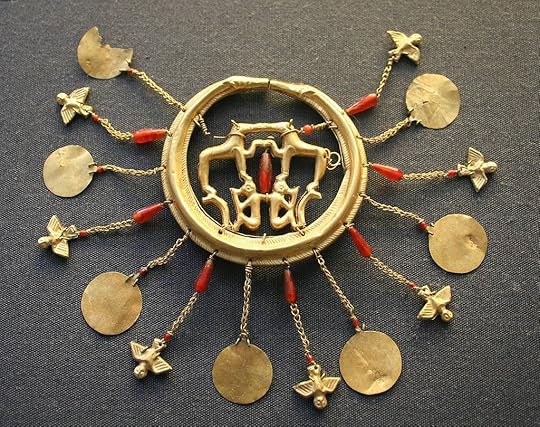 ΧÏÏ
ÏÏ ÎºÏεμαÏÏÏ ÎºÏÏμημα[4]
ΧÏÏ
ÏÏ ÎºÏεμαÏÏÏ ÎºÏÏμημα[4]ÎÏÏ Ïην άλλη η Îίγινα ÏÎ·Ï ÎÎ ÏεÏιÏÎ´Î¿Ï ÎÏει ÏÏοβληθεί ÏειÏÏικά ÏÏ Î¼Î¯Î± ÏÏοÏθημÎνη ÏολιÏική ονÏÏÏηÏα με κÏαÏικÎÏ Î´Î¿Î¼ÎÏ, ÏÏην οÏοία ÏαίνεÏαι ÏÏι μÏοÏοÏν να αναζηÏηθοÏν μεÏικά αÏÏ Ïα ÏαÏακÏηÏιÏÏικά ÏÎ¿Ï Î¸Î± αÏοδοθοÏν αÏγÏÏεÏα ÏÏην ÎÏ ÎºÎ·Î½Î±Ïκή ÎÏοÏή. ΠαναÏκαÏή ενÏÏ âθολÏÏÎ¿Ï ÏάÏÎ¿Ï â ÏÏην ÎολÏνα με ÏολÏÏιμα ÎινÏικά και ÎÏ ÎºÎ»Î±Î´Î¹ÎºÎ¬ κÏεÏίÏμαÏα θα αÏοκαλÏÏει μιαν εικÏνα ÏÎ¿Ï Î´ÎµÎ½ ÎÏει να ζηλÎÏει ÏίÏοÏα αÏÏ Î±Ï Ïήν ÏÏν ÎÏ ÎºÎ·Î½Ïν.[5] ÎάλιÏÏα η ίδια η ÏÏαÏξη ÏÎ¿Ï Î¸Î·ÏÎ±Ï ÏÎ¿Ï ÏÎ·Ï ÎÎ¯Î³Î¹Î½Î±Ï ÎµÎºÏιμάÏαι ÏÏ ÏαÏÎÏÎ¿Ï Ïα Ïην βάÏη να θεÏÏήÏÎ¿Ï Î¼Îµ ÏÏι Ïα ανÏικείμενά ÏÎ¿Ï Î±ÏεÏÎλεÏαν με Ïην ÏειÏά ÏÎ¿Ï Ï Î±ÏιεÏÏμαÏα Ïε ÏάÏÎ¿Ï Ï ÏολεμιÏÏÏν, εÏομÎνÏÏ Î¿Î¹ ÏάÏοι αÏιÏÏοκÏαÏÏν Ï ÏήÏξαν ÏÎ¿Î»Ï Î¬Ïιθμοι. Î¥ÏÎÏ ÏÎ·Ï Ï ÏάÏξεÏÏ ÏολεμιÏÏÏν αÏιÏÏοκÏαÏÏν ÏÏην Îίγινα ήδη αÏÏ Ïην ÎÎ ÏεÏίοδο ÏÏ Î½Î·Î³Î¿Ïεί η διακÏÏμηÏη διαζÏμαÏÎ¿Ï ÏÎ¯Î¸Î¿Ï ÏÎ·Ï ÏÏλεÏÏ IX ÏÏÎ¿Ï ÏαÏÎ¿Ï ÏιάζεÏαι εÏανδÏÏμÎνο Ïλοίο, καθÏÏ ÎºÎ±Î¹ άλλο ÏÏÏÏακο με ÏαÏή ÏαÏάÏÏαÏη ÏολεμιÏÏÏν ÏεÏÏνÏÏν δÏÏαÏα,[6] ÎµÎ½Ï Î´ÎµÎ½ λείÏÎ¿Ï Î½ ÏαÏαÏÏάÏÎµÎ¹Ï Î¼Îµ Î¼Ï Î¸Î¿Î»Î¿Î³Î¹ÎºÎÏ Î±Î½Î±ÏοÏÎÏ, ÏÎ¿Ï Ï ÏογÏÎ±Î¼Î¼Î¯Î¶Î¿Ï Î½ Ïην Î¼Ï Î¸Î¿Î»Î¿Î³Î¹ÎºÎ® â θÏηÏÎºÎµÏ Ïική ÏÏ Î½ÎÏεια ÏÏ Ïην ÎλαÏική εÏοÏή![7] ΣÏα ÏλαίÏια Î±Ï ÏÏν ÏÏν διαÏιÏÏÏÏεÏν η ÏÏαÏξη ÏειÏÎ¬Ï Î¸Î¿Î»ÏÏÏν ÏάÏÏν ÏÏην Îίγινα, ÏÏÏÏη κÏαÏική ονÏÏÏηÏα ÏÎ¿Ï Î·ÏειÏÏÏÎ¹ÎºÎ¿Ï ÎÎ»Î»Î±Î´Î¹ÎºÎ¿Ï ÏÏÏÎ¿Ï ,[8] αÏÏ ÏÎ¹Ï Î±ÏÏÎÏ ÏÎ·Ï Î´ÎµÏ ÏÎÏÎ±Ï ÏιλιεÏίαÏ,[9] ÏÏοβάλλει Ïο νηÏί ÏÏ ÏÏοÏομÏÏ ÏÎ·Ï ÎÏ ÎºÎ·Î½Î±ÏÎºÎ®Ï ÎµÏοÏÎ®Ï ÏÎ¿Ï Î±Î½Î±ÏÎλλει ..
ÎαμβάνονÏÎ±Ï Ï ÏÏÏιν Ïην ανάÏÏÏ Î¾Î· ÏÏν λεγομÎνÏν ÏημείÏν κεÏαμÎÏν ÏÏην Îίγινα, Î¦Ï Î»Î±ÎºÏÏή, ÎÎÏνη, ÏÏήλαιο ΦÏάγÏθι, ΤίÏÏ Î½Î¸Î±, Îγία ÎιÏήνη κ.α.[10] καÏÎ±Î»Î®Î³Î¿Ï Î¼Îµ ÏÏο ÏÏ Î¼ÏÎÏαÏμα ÏÏι, αν και οι γνÏÏÎµÎ¹Ï Î¼Î±Ï Î³Î¹Î± Ïο θÎμα είναι ελλιÏείÏ, Ïο Îιγαίο ÏαίνεÏαι ÏÏι ÏÏ Î¼Î¼ÎµÏείÏε ÏÏÎ¹Ï Î´Î¹Î±Î´Î¹ÎºÎ±ÏÎ¯ÎµÏ ÏÎ¿Ï ÎºÎ¿ÏÏ ÏÏθηκαν με Ïην εÏινÏηÏη ÏÎ¿Ï Î±Î»ÏαβήÏÎ¿Ï .
ΣÎÎÎÎΩΣÎÎΣ
[1]. https://www.facebook.com/permalink.ph...[2]. ÎονιδάÏÎ·Ï 2022, Ïημ. 9_39. ÅahoÄlu 2008, pp. 483, 487-488, nn. 36-40; Erkanal and ÅahoÄlu 2016, p. 157; Alram-Stern 2004, pl. 7. Îια Ïην ενÏÏ ÏÏÏιακή οÏÏÏÏÏη ÏÎ¿Ï Î Î±Î»Î±Î¼Î±ÏÎ¯Î¿Ï Î£ÎºÏÏÎ¿Ï Î²Î». ÎλαÏÏÏÎ¿Ï Î»Î¿ και ΠαÏαδημηÏÏÎ¯Î¿Ï ÎÏμαδÏÏÎ¿Ï , καθÏÏ ÎºÎ±Î¹ Ïα Ï Î»Î¹ÎºÎ¬ ÏÏεÏÎ¹ÎºÎ®Ï Î´Î¹ÎµÏιÏÏÎ·Î¼Î¿Î½Î¹ÎºÎ®Ï ÏÏ Î½Î±Î½ÏήÏεÏÏ (ÎλαÏÏÏÎ¿Ï Î»Î¿Ï ÎºÎ±Î¹ ΠαÏαδημηÏÏÎ¯Î¿Ï ÎÏμαδÏÏÎ¿Ï 2016; ΡÏÎ¼Î¬Î½Î¿Ï , ΧÏ. 2015).[3]. Ludvik, Kenoyer and PieniÄ Å¼ek 2020, (3).[4]. Younger, The Iconography of Rulership, BM Catalogue of Jewelry no. 761: gold pectoral, part of Aigina Treasure, perhaps from Mallia, the Chrysolakkos (Higgins 1957: 42-57; Kaiser, Reief 206). Composition: a gold torque with human head finials at either end; each head has two long curls at the back, the eyes once filled with blue inlay. Higgins thinks the heads are of sphinxes; Kaiser compares them to the head of the Mallia sword acrobat; also see the sphinx terracotta aplique from Mallia Quartier Mu ..[5]. ÎονιδάÏÎ·Ï 2022, Ïημ. 9_235. Aravantinos 1995, p. 615, n. 11.[6]. ÎονιδάÏÎ·Ï 2022, Ïημ. 9_236. Niemeier 1995, p. 76, nn. 35, 36; Rutter 1993, pp. 778-779, figs. 13, 14: b, c.[7]. ÎονιδάÏÎ·Ï 2022, Ïημ. 9_237. Niemeier 1995, p. 77, n. 37; Rutter 1993, pp. 778-779, figs. 14: a. Î Î¼Ï Î¸Î¿Î»Î¿Î³Î¹ÎºÎ¿Ï ÏαÏακÏήÏα ÏαÏάÏÏαÏη ÏεÏιλαμβάνει άνθÏÏÏο εÏί δελÏÎ¹Î½Î¹Î¿Ï ÎºÎ±Î¹ εÏÏεÏοειδÎÏ Î¸Î±Î»Î¬ÏÏιο ζÏο. Î ÏÏÎ¹Ï Î±ÏοÏελεί ÏÏÎ½Î·Î¸ÎµÏ ÎινÏÎ¹ÎºÏ ÏÏÏÏ ÎºÎ±Î¹ ÎÎ¹Î³Ï ÏÏÎ¹Î±ÎºÏ ÏÏμβολο, εμÏανίζεÏαι δε με θÏηÏÎºÎµÏ Ïική ÏÏ ÏÏÎÏιÏη Ïε ÎηβαÏκÎÏ ÏÎ¹Î½Î±ÎºÎ¯Î´ÎµÏ ÎÏÎ±Î¼Î¼Î¹ÎºÎ®Ï Îâ, ÎµÎ½Ï ÏÏ Î¿Î¹ÎºÎ¿Ï ÏÏÏ ÏÏÎ¹Ï Î±Î½Î±ÏÎÏεÏαι ÏÏÎ¹Ï ÏελεÏÎÏ ÏÎ¿Ï ÎµÎ»Î¬Î¼Î²Î±Î½Î±Î½ ÏÏÏαν ÏÏην ÎκÏÏÏολη, βλ. Varias Garcia (Varias Garcia 2014).[8]. ÎονιδάÏÎ·Ï 2022, Ïημ. 9_238. Niemeier 1995.[9]. ÎονιδάÏÎ·Ï 2022, Ïημ. 9_239. Niemeier 1995, p. 77. Î ÎεÏμανÏÏ Î±ÏÏαιολÏÎ³Î¿Ï ÏÏονολογεί Ïον θηÏÎ±Ï ÏÏ ÎµÎ½ÏÏÏ ÏÎ·Ï ÏεÏιÏÎ´Î¿Ï 1900-1700 Ï.Χ.[10]. ÎονιδάÏÎ·Ï 2022, Ïημ. 15_48. Hirschfeld 2007; Lindblom 2001.
ÎÎÎÎÎÎÎΡÎΦÎÎ
https://journals.openedition.org/pale...
https://journals.openedition.org/pale...
Ludvik, G. E., J. M. Kenoyer and M. PieniÄ
żek. 2020. âNew evidence for interregional interaction in the 3rd millennium BCE Aegean: Indus-style carnelian beads at Aegina-Kolonna, Greece,â Varia 46 (1-2), pp. 161-178.
ÎονιδάÏηÏ, Î. Î. 2022. Îι ΧεÏÏαίοι και ο κÏÏÎ¼Î¿Ï ÏοÏ
ÎιγαίοÏ
, Îθήνα.
https://www.academia.edu/8736438/The_...
https://kuscholarworks.ku.edu/bitstre...
Younger, J. G. 1995. "The Iconography of Rulership in the Aegean: a conspectus," in The Role of the Ruler in the Prehistoric Aegean (Aegaeum 11), ed. P. Rehak, Liège, pp. 151-211.
Younger, The Iconography of Rulership, BM Catalogue of Jewelry no. 761: gold pectoral, part of Aigina Treasure, perhaps from Mallia, the Chrysolakkos (Higgins 1957: 42-57; Kaiser, Reief 206). pl. p. 209 LXa: Composition: a gold torque with human head finials at either end; each head has two long curls at the back, the eyes once filled with blue inlay. Higgins thinks the heads are of sphinxes; Kaiser compares them to the head of the Mallia sword acrobat; also see the sphinx terracotta aplique from Mallia Quartier Mu ..
Î. ΠαλαιολÏγοÏ
, Σ. ÎγγελίδοÏ
, Î. ÎαÏ
ÏοθαλαÏÏίÏη. Î ÏαÏικÏÏ ÎºÏÎºÎ»Î¿Ï Î.
http://odysseus.culture.gr/h/2/gh251....
https://www.academia.edu/28607668/J_D...
Davis, 1J. 978. "The Mainland Panelled Cup and Panelled Style," AJA 82, pp. 216-222
.. . There is no reason to believe, however, that the circle was used at all before the final phase of the Middle Bronze Age, contemporary with the MM IIIB period at Knossos.21
MM III: starts at about 1800 .. Phylacopy II, MC, 2000-1700 BC
Î ÎÎÎΠΠΡÎΣΦÎΤÎΣ ÎÎÎ ÎÎΥΤÎΣÎÎΣ - ÎÎ ÎÎÎÎÎÎÎ: 090223
December 29, 2022
Warriors and Weapons in the Central and Eastern Balkans
ÎÎΣÎÎΩÎÎ: Το ÏαÏÏν ÏÏ Î½Î¹ÏÏά μεÏάÏÏαÏη ÏÎ¿Ï ÎÎ³Î³Î»Î¹ÎºÎ¿Ï ÎºÎµÎ¹Î¼ÎÎ½Î¿Ï , εμÏÎ»Î¿Ï ÏιÏμÎÎ½Î¿Ï Î¼Îµ εμβÏÎ»Î¹Î¼ÎµÏ ÏαÏαÏηÏήÏÎµÎ¹Ï ÎºÎ±Î¹ ÏημειÏÏÎµÎ¹Ï ÏÎ¿Ï Î³ÏάÏονÏοÏ, ÏÏÎ¿Ï Î¿ ÏÏ Î¼Î²Î¿Î»Î¹ÏμÏÏ [Î] & ΣÏΠεÏιÏημαίνει Ïα εμβÏλιμα ÎµÎ½Ï Î¿ {}Ïη αÏÏÎ¹ÎºÏ ÎºÎµÎ¯Î¼ÎµÎ½Î¿.
Îε Ïην ανάÏÏÏ Î¾Î· ολοÎνα και ενÏονÏÏεÏÏν κοινÏνικÏν ανιÏοÏήÏÏν και Ïην ÏÏεÏική αÏξηÏη ÏÏν βίαιÏν ÏÏ Î³ÎºÏοÏÏεÏν, η ÎÏ ÏÏÏαÏκή ÎÏοÏή ÏÎ¿Ï Î§Î±Î»ÎºÎ¿Ï ÏαÏακÏηÏίÏÏηκε γενικά αÏÏ Ïην ÏαÏεία ανάÏÏÏ Î¾Î· ÏÎ·Ï ÏÎ¿Î»ÎµÎ¼Î¹ÎºÎ®Ï ÏεÏνολογίαÏ.[Î2] Το ÏÏ ÏÎ¹ÎºÏ ÏÏλο ÏÎ¿Ï ÏολεμιÏÏή ÏÎ·Ï ÎÏοÏÎ®Ï ÏÎ¿Ï Î§Î±Î»ÎºÎ¿Ï (ÎΧ) ήÏαν Ïο ξίÏοÏ. ÎÏÏ ÏÎ¹Ï Î±ÏÏÎÏ ÏÎ·Ï ÎΧ καÏά Ïην 3η ÏιλιεÏία Ï.Χ.,[Î4] δεν γνÏÏÎ¯Î¶Î¿Ï Î¼Îµ ÏÏεδÏν κανÎνα ÏÏÏÎ¹ÎºÏ ÏÏλο (ÏÏιλÎÏα) αÏÏ Ïην κενÏÏική και αναÏολική ÏεÏÏÏνηÏο ÏÎ¿Ï ÎÎ¯Î¼Î¿Ï , αλλά αÏÏ Ïα ÏÎλη ÏÎ·Ï 4Î·Ï ÏιλιεÏÎ¯Î±Ï Ï ÏήÏÏαν μεγάλοι αÏιθμοί αÏÏ Î±Ï Ïά. ÎÏιθμÏÏ ÎºÎ¿ÏÏικÏν ÏÏλÏν, ÏÏ Î³ÎºÎµÎºÏιμÎνα βαÏιά μονÏκοÏα Ïάλκινα ÏÏεκοÏÏια, Î±ÎºÎ¿Î»Î¿Ï Î¸Î¿ÏÏαν ÏαλαιÏÏεÏÎµÏ Î¼Î¿ÏÏÎÏ ÏελÎκεÏν ÏÎ·Ï Î§Î±Î»ÎºÎ¿Î»Î¹Î¸Î¹ÎºÎ®Ï.{1}
ΠνεκÏÏÏολη ÏÎ·Ï ÎάÏÎ½Î±Ï ÏÏην ÎαÏÏη ÎάλαÏÏα ÏÏοÏÏÎÏει Ïα ÏαλαιÏÏεÏα με αÏÏάλεια ÏÏονολογημÎνα ÏαÏαδείγμαÏα ÏάλκινÏν ÏελÎκεÏν.[Î6] ÎÏ Ïά ÏÏ Î½Î´Ï Î¬Î¶Î¿Ï Î½ Îνα άκÏο κοÏÎ®Ï ÏÏην μία ÏÎ»ÎµÏ Ïά με Îνα άκÏο ÏÏÏ ÏÎ¹Î¿Ï ÏÏην άλλη και εÏομÎνÏÏ Î¿Î½Î¿Î¼Î¬Î¶Î¿Î½Ïαι Î¬Î¾Î¿Î½ÎµÏ ÏÏÏ ÏÎ¹Î¿Ï Hammeräxte / hammer axes. ÎÏ ÏίÏκονÏαν εν ÏÏήÏει ÏÏην ÎάÏνα ÏεÏίÏÎ¿Ï Î±ÏÏ Ïο 4650 Ï.Χ. ÎÎ¯Î³Î¿Ï Ï Î±Î¹ÏÎ½ÎµÏ Î±ÏγÏÏεÏα, γÏÏÏ ÏÏο 4400 Ï.Χ., ÏÏοÏÏÎθηκαν ÏεÏαιÏÎÏÏ ÎºÎ±Î¹Î½Î¿ÏÎ¿Î¼Î¯ÎµÏ ÏÏην ÏεÏνολογία ÏÏν ÏÏλÏν: ÏÎ¬Î½Ï Î±Ï' Ïλα, οι αÏÏαιÏÏεÏÎµÏ Î±Î¹ÏμÎÏ Î»ÏγÏÎ·Ï Î® ακονÏÎ¯Î¿Ï , οι οÏοίεÏ, ÏÏÏÏ Ïα Ï ÏοδείγμαÏα ÏÎ·Ï ÎγγÏÏ ÎναÏÎ¿Î»Î®Ï ÎºÎ±Î¹ ÏÎ¿Ï ÎÎ±Ï ÎºÎ¬ÏÎ¿Ï , είÏαν Î»Ï Î³Î¹ÏμÎÎ½ÎµÏ Î»Î±Î²ÎÏ ÏÏο ÏÎÎ»Î¿Ï ÎºÎ±Î¹ ÏημαÏοδοÏοÏν Ïην αÏÏή ενÏÏ ÏÏ ÏÎ¹ÎºÎ¿Ï ÏÏÎ»Î¿Ï ÏÎ·Ï ÎΧ. ΣÏο δεÏÏεÏο ήμιÏÏ ÏÎ·Ï 5Î·Ï ÏιλιεÏÎ¯Î±Ï ÏÏ Î½Î±Î½Ïάμε για ÏÏÏÏη ÏοÏά Îνα άλλο ÏαινÏμενο ÏÏην Χαλκολιθική ÎάÏνα, Ïο οÏοίο εÏÏÏκειÏο να γίνει ÏαÏακÏηÏιÏÏÎ¹ÎºÏ ÏÎ·Ï ÎΧ, δηλαδή η διακÏÏμηÏη ÏÏλÏν με ÏολÏÏιμα μÎÏαλλα: για ÏÎ¿Ï Ï ÏÎ¿Î»Ï Î»Î¯Î³Î¿Ï Ï ÏÎ¿Î»Ï ÏλοÏÏια ÏÏοικιÏμÎÎ½Î¿Ï Ï Î¬ÏÏÎµÎ½ÎµÏ Î½ÎµÎºÏοÏÏ ÎºÎ±Î¸ÏÏ ÎºÎ±Î¹ για ÏÎ¹Ï ÏλοÏÏÎ¹ÎµÏ ÏÏ Î¼Î²Î¿Î»Î¹ÎºÎÏ ÏαÏÎÏ, οι ξÏÎ»Î¹Î½ÎµÏ Î»Î±Î²ÎÏ ÎºÎ±Î¹ Ïα ÏÏμαÏα ÏÏÎµÎºÎ¿Ï ÏιÏν αÏÏ ÏÎÏÏινα ÏÏεκοÏÏια καλÏÏθηκαν με ÏÏÏ ÏÏ ÏÏλλο.{2} ΠκοινÏνική ανιÏÏÏηÏα ÏÏ Î½Î¿Î´ÎµÏεÏαι λοιÏÏν αÏÏ Ïην αιÏθηÏικοÏοίηÏη ÏÏν ÏÏλÏν - ÏÏν οÏγάνÏν Î²Î¯Î±Ï - ÏÎ¿Ï ÏÏηÏιμεÏÎ¿Ï Î½ για Ïη διαÏήÏηÏη ÏÎ·Ï Î±Î½Î¹ÏÏÏηÏÎ±Ï ÎºÎ±Î¹ ÎÏÏι ÏÏÏα Ïη ÏÏ Î¼Î²Î¿Î»Î¯Î¶Î¿Ï Î½ και με ÏολÏÏιμο Ï Î»Î¹ÎºÏ.
Πίδια διαδικαÏία αιÏθηÏικοÏοιήÏεÏÏ - ÎµÎ´Ï Î®Î´Î· με Ïη μεÏαÏÏοÏή Ïε καθαÏÏ ÏÏμβολο - ÏÏηÏιμοÏοιήθηκε και ÏεÏί Ïα μÎÏα ÏÎ·Ï 3Î·Ï ÏιλιεÏÎ¯Î±Ï Ï.Χ., ÏÏÏÏ Î´ÎµÎ¯Ïνει Ïο ÏÏ Î¼ÏαγÎÏ ÏÏÏ ÏÏ Î¾Î¹Ïίδιο / ÏÏιλÎÏο με Î±Î¼Î²Î»Ï Î¿ÏιζÏνÏιο άκÏο αÏÏ Ïην ÏελεÏÎ¿Ï Ïγική δομή αÏ. 5 ÏÎ·Ï Î½ÎµÎºÏοÏÏλεÏÏ DÄbene.{3}
ÎαÏά Ïην 2η ÏιλιεÏία ÏαÏαÏηÏοÏμε μια ÏαÏεία ανάÏÏÏ Î¾Î· ÏÎ·Ï ÏεÏÎ½Î¿Î»Î¿Î³Î¯Î±Ï ÏÏν ÏÏλÏν, η οÏοία ÏÎ¿Ï Î»Î¬ÏιÏÏον εν μÎÏει ÏÏ ÏοδοÏήθηκε αÏÏ Ï ÏεÏÏεÏιÏεÏειακÎÏ ÎµÏαÏÎÏ. ÎδιαίÏεÏη ÏημαÏία ÎÏει ÎµÎ´Ï Î· ειÏαγÏγή μακÏÏν και ÏÎ¿Î»Ï Î»ÎµÏÏÏν ÏÏÏικÏν ÏÏαθιÏν (ξιÏάκια), ÏÎ¿Ï Î¼ÏοÏεί να είÏαν γίνει ÏÏιν αÏÏ Ïο 1500, αÏÏ ÎινÏικά και ÎÏ ÎºÎ·Î½Î±Ïκά εÏγαÏÏήÏια ÏÏλÏν ÏÏην Îλλάδα (Îικ. 2). Îνα ξίÏÎ¿Ï Î±ÏÏ Ïην ÎÏάμα ÏÏη ÏημεÏινή ÎÎ ÎÎ¿Ï Î»Î³Î±Ïία, Îνα αÏÏ Ïο Sokol ÏÏην Ïεδιάδα ÏÎ¿Ï ÎÎ¿Ï Î½Î¬Î²ÎµÏÏ ÎºÎ±Î¹ Îνα αÏÏ Ïο Lilovo (ΣÏÎ: Îγιο ÎνÏÏνιο) κονÏά ÏÏο Devin ÏÏην ΡοδÏÏη (αÏιθ. καÏ. 113) ÏÏεÏίζονÏαι άμεÏα με Ïα ÎιγαιοÏελαγίÏικα ξιÏοειδή με βάÏη Ïολλά ÏαÏακÏηÏιÏÏικά {-> ΣÎÎ. 71} ÏÏ Î³ÎºÏίÏεÏÏ. Τα ξίÏη αÏÏ Ïα ÎÏ Ïικά Îαλκάνια εÏηÏεάζονÏαι εÏίÏÎ·Ï Î¬Î¼ÎµÏα αÏÏ Ïα ÏÏλα ÏÎ¿Ï ÎÎ¹Î³Î±Î¯Î¿Ï (ΧάÏÏÎ·Ï 1).{4}ÎνÏίθεÏα, οÏιÏμÎνα ξίÏη αÏÏ Ïην ΤÏανÏÏ Î»Î²Î±Î½Î¯Î± και Ïη ÎλαÏία ÎÏÎ¿Ï Î½ ÏÏήμα λεÏÎ¯Î´Î±Ï ÏÎ¿Ï ÎµÎ¯Î½Î±Î¹ γενικά ÏÏ Î³ÎºÏίÏιμο με Ïα ÏÏÏιμα ÎÏ ÎºÎ·Î½Î±Ïκά ÏÏλα, αλλά διαθÎÏÎ¿Ï Î½ εÏίÏÎ·Ï Î´Î¹Î±ÎºÏιÏά ÏαÏακÏηÏιÏÏικά (ΧάÏÏÎ·Ï 1).{5}
ΩÏÏÏÏο, μÏνον ÏÏα ÏÎλη ÏÎ¿Ï 15Î¿Ï ÎºÎ±Î¹ ÏÏÎ¹Ï Î±ÏÏÎÏ ÏÎ¿Ï 14Î¿Ï Î±Î¹Ïνα οι Ïιο ÎνοÏλοι ÏολεμιÏÏÎÏ ÏÏν κενÏÏικÏν και αναÏολικÏν ÎαλκανίÏν καÏείÏαν ξίÏη ÏÎ¿Ï ÏαίÏιαζαν ακÏιβÏÏ Î¼Îµ Ïα ÎÏ ÎºÎ·Î½Î±Ïκά ÏÏλα ÏÎ·Ï ÏεÏιÏÎ´Î¿Ï (ΧάÏÏÎ·Ï 2). Îίναι η ÏεÏÎ¯Î¿Î´Î¿Ï ÏÎ¿Ï Ïο ÎÏ ÎºÎ·Î½Î±ÏÎºÏ Î±Î½Î±ÎºÏοÏÎ¹ÎºÏ ÎºÏάÏÎ¿Ï ÎµÎ³ÎºÎ±ÏαÏÏάθηκε και εÏεκÏάθηκε ÏÏÏαÏιÏÏικά - εδαÏικά ÏÏον ÏÏÏο ÏÎ¿Ï ÎÎ¹Î³Î±Î¯Î¿Ï . Îι εÏÏβαλκανικÎÏ ÏεÏιοÏÎÏ Î´ÎµÎ½ ενÏάÏθηκαν ÏÏο νÎο ÏÏÏÏημα Î´Î¹Î±ÎºÏ Î²ÎµÏνήÏεÏÏ, αλλά ÏÏοÏανÏÏ ÎµÎ¯Ïαν εÏαÏή με ÏÎ¿Ï Ï ÏολεμιÏÏÎÏ ÏÎ¿Ï . ÎÏ ÏÏ Î¸Î± μÏοÏοÏÏε ÏÏοÏαδικά να ιÏÏÏει και για ÏολεμιÏÏÎÏ Î±ÏÏ Ïην Î´Ï Ïική ακÏή ÏÎ·Ï ÎικÏÎ¬Ï ÎÏίαÏ, ÏÏÏÏ Ï ÏοδηλÏνεÏαι αÏÏ Îνα ξίÏÎ¿Ï ÏÎ¿Ï ÏιθανÏÏαÏα καÏαÏÎºÎµÏ Î¬ÏÏηκε εκεί και ÎÏÏαÏε ÏÏη βοÏειοαναÏολική ÎÎ¿Ï Î»Î³Î±Ïία.{6}[ΣÏÎ: ÏÏÏκειÏαι για Ïο γνÏÏÏÏ ÎÏ ÎºÎ·Î½Î±ÏÎºÏ Î¾Î¯ÏÎ¿Ï Î¼Îµ Ïην αÏιÎÏÏÏη ÏÏεÏικά με Ïην νίκη εÏί ÏÎ·Ï Assuwa!][Î8]
 ενεÏίγÏαÏο ÎÏ
κηναÏÎºÏ Î¾Î¯ÏÎ¿Ï Î±ÏÏ Ïην ΧαÏοÏÏα â αÏιÎÏÏμα ÏÏην νίκη εÏί ÏÎ·Ï Assuwa
ενεÏίγÏαÏο ÎÏ
κηναÏÎºÏ Î¾Î¯ÏÎ¿Ï Î±ÏÏ Ïην ΧαÏοÏÏα â αÏιÎÏÏμα ÏÏην νίκη εÏί ÏÎ·Ï AssuwaΠιο ÏημανÏικÎÏ ÏμÏÏ Î®Ïαν οι ÏÏÎÏÎµÎ¹Ï Î¼Îµ Ïο ÎÏ ÎºÎ·Î½Î±ÏÎºÏ ÎÏ ÏÎ¹ÎºÏ Îιγαίο. ÎÏ ÏÏ Î±ÏοδεικνÏεÏαι αÏÏ ÏÎ¿Î»Ï Î¬Ïιθμα ÎµÏ ÏήμαÏα ÏÏαθιÏν με κÎÏαÏα ÏÏο άκÏο ÏÎ·Ï Î»Î±Î²Î®Ï, ÏÎ¿Ï Î²ÏÎθηκαν ÏÏÎ¹Ï Î±Î½Î±ÏολικÎÏ ÎºÎ±Î¹ κενÏÏικÎÏ ÏεÏιοÏÎÏ ÏÎ·Ï Î§ÎµÏÏονήÏÎ¿Ï ÏÎ¿Ï ÎÎ¯Î¼Î¿Ï Î±ÏÏ Ïη ΡοδÏÏη μÎÏÏι Ïην Ïεδιάδα ÏÎ¿Ï ÎοÏναβη και Ïε εξαιÏεÏικÎÏ ÏεÏιÏÏÏÏÎµÎ¹Ï ÎµÏίÏÎ·Ï Î²ÏÏεια Î±Ï ÏÎ¿Ï (ÏάÏÏÎ·Ï 2, αÏ. καÏ. 278).{7} ÎÏ Ïά Ïα ÏÏλα αναÏÏÏÏθηκαν εÏίÏÎ·Ï ÏεÏαιÏÎÏÏ Ïε ÏοÏικά εÏγαÏÏήÏια ÏÎ±Î»ÎºÎ¿Ï (ΧάÏÏÎ·Ï 2, αÏ. καÏ. 289, 290 & 293; Îικ. 4).{8} ÎμοίÏÏ, μεÏικÎÏ Î±Î¹ÏμÎÏ Î»ÏγÏηÏ, ÏÎ¿Ï Î»ÏÎ³Ï ÏÎ¿Ï Î¼Î®ÎºÎ¿Ï Ï ÎºÎ±Î¹ ÏÎ¿Ï ÏÏήμαÏÏÏ ÏÎ¿Ï Ï Î®Ïαν ÏιθανÏÏ ÏÏÏικά ÏÏλα, ανάγονÏαι ÏÏÎ¹Ï ÎÏ ÎºÎ·Î½Î±ÏκÎÏ ÎºÎ±Î¹Î½Î¿ÏÎ¿Î¼Î¯ÎµÏ (αÏ. καÏ. 279, εικ. 3).{9} Îίναι ÏαÏακÏηÏιÏÏÎ¹ÎºÏ ÏÏι Ïα ÎÏ ÎºÎ·Î½Î±Ïκά κεÏαμεικά αγγεία ειÏήÏθηÏαν εÏίÏÎ·Ï Î³Î¹Î± ÏÏÏÏη ÏοÏά ÏÏα αναÏολικά Îαλκάνια καÏά Ïην ÏεÏίοδο Î±Ï Ïή, ÏÏÏÏ ÏαίνεÏαι αÏÏ Ïα ÎµÏ ÏήμαÏα αÏÏ Ïην Dragojna και Ïο Ada Tepe[Î10] ÏÏα Î²Î¿Ï Î½Î¬ ÏÎ·Ï Î¡Î¿Î´ÏÏηÏ. Îι ÏημικÎÏ Î±Î½Î±Î»ÏÏÎµÎ¹Ï Îδειξαν ÏÏι Ïο Ïα αγγεία ÏÎ·Ï Dragojna ειÏήÏθηÏαν αÏÏ Ïη θεÏÏαλική ÏαÏάκÏια ÏεÏιοÏή ÏÎ¿Ï ÎÏÎ»Î¿Ï , δηλαδή αÏÏ Î¼Î¹Î± ÏεÏιοÏή ÏÏÎ¿Ï Î²ÏίÏÎºÎ¿Ï Î¼Îµ ακÏιβή ανÏίÏÏοιÏα για αÏκεÏά αÏÏ Ïα αναÏολικά Îαλκανικά ξίÏη και λÏγÏεÏ.{10} Î ÏÏ ÏμÏÏ ÏÏοÎÎºÏ Ïε Î±Ï Ïή η ÏÏενÏÏεÏη και ÏÏοÏανÏÏ ÏÏι αÏοκλειÏÏικά Ïολεμική εÏαÏή με Ïο Îιγαίο καÏά Ïον 15ο/14ο αι.;
ΠγεÏγÏαÏική θÎÏη ÏÏν αναÏεÏθÎνÏÏν οικιÏμÏν ÏÏην ÏλοÏÏια Ïε ÏÏÏ ÏÏ Î¿ÏοÏειÏά ÏÎ·Ï Î¡Î¿Î´ÏÏÎ·Ï ÏÏοÏÏÎÏει Îνα κλειδί για Ïηνν αÏάνÏηÏη. ÎÏιÏλÎον, μία μαÏμάÏινη λαβή ξίÏÎ¿Ï Ï Î²ÏÎθηκε εÏίÏÎ·Ï ÏÏη θÎÏη (Ada Tepe) ÏÏÎ¿Ï Ïο οÏÏ Ïείο ÏÏÏ ÏÎ¿Ï ÏÎ·Ï ÎΧ, Ïο οÏοίο, με βάÏη ÏÏ Î³ÎºÏίÏιμα ÎµÏ ÏήμαÏα αÏÏ ÏάÏÎ¿Ï Ï ÏολεμιÏÏÏν ÏÎ¿Ï ÎÏÎ»Î¿Ï ÎºÎ±Î¹ ÏÎ·Ï ÎÎ±Î»Ï ÏÎ¿Ï (ÏÏην ΡÏδο) αÏÏ Ïα ÏÎλη ÏÎ¿Ï 15Î¿Ï /αÏÏÎÏ 14Î¿Ï . αι. ανÏιÏÏοιÏεί Ïε ÎµÎºÎµÎ¯Î½Î¿Ï Ï ÏÎ¿Ï Ï ÏÏÏÎ¿Ï Ï Î¾Î¹ÏÏν ÏÎ¿Ï Î®Ïαν ÎµÏ ÏÎÏÏ Î´Î¹Î±Î´ÎµÎ´Î¿Î¼Îνοι ÏÏα αναÏολικά και κενÏÏικά Îαλκάνια εκείνη Ïην εÏοÏή.{11} ÎÏ ÏÏ Ïημαίνει ÏÏι η εξÏÏÏ Î¾Î· ÏÏÏ ÏοÏ, η ειÏαγÏγή εκλεκÏήÏ, ζÏγÏαÏÎ¹ÎºÎ®Ï ÎÏ ÎºÎ·Î½Î±ÏÎºÎ®Ï ÎºÎµÏÎ±Î¼ÎµÎ¹ÎºÎ®Ï ÎºÎ±Î¹ Ïα ÎÏ ÎºÎ·Î½Î±Ïκά ÏÏλα ÏÏ Î½Î´ÎονÏαι ÏÏÏικά και ÏÏονικά. Το αν ο ÏÏÏ ÏÏÏ Î±ÏÏ Ïην ΡοδÏÏη ανÏηλλάγη με νÎα ÏÏλα και εκλεκÏά εÏιÏÏαÏÎζια ÏκεÏη αÏÏ Ïην Îλλάδα είναι Îνα εÏÏÏημα ÏÎ¿Ï Î±ÏανÏάÏαι Î±Ï Ïή Ïη ÏÏιγμή Ïε μια ÎÎ¿Ï Î»Î³Î±Ïο-ÎÏ ÏÏÏιακή-ÎεÏμανική εÏÎµÏ Î½Î·Ïική ÏÏ Î½ÎµÏγαÏία ÏÏηÏιμοÏοιÏνÏÎ±Ï ÏÎ¹Ï Ïιο ÏÏÏÏÏαÏÎµÏ Î±Î½Î±Î»Ï ÏικÎÏ ÏεÏνικÎÏ. ÎÏιÏλÎον, ÏÏÎÏει να Î´Î¹ÎµÏ ÎºÏινιÏÏεί ÏÏÏ Î¿Î¹ νÏÏÎ¹ÎµÏ ÎµÏαÏÎÏ Î¼Îµ Ïο ÎÏ ÎºÎ·Î½Î±ÏÎºÏ ÎºÏάÏÎ¿Ï ÎµÏηÏÎαÏαν Ïην ανάÏÏÏ Î¾Î· ÏÎ·Ï Î¿Î¹ÎºÎ¿Î½Î¿Î¼Î¯Î±Ï ÎºÎ±Î¹ ÏÏν κοινÏνικÏν δομÏν ÏÏÎ¹Ï Î·ÏειÏÏÏικÎÏ ÏεÏιοÏÎÏ ÏÎ·Ï ÎÎ ÎÏ ÏÏÏηÏ. Îια ÏÎ¿Î»Ï ÎºÎ±Î¹ÏÏ Î´ÎµÎ½ Ï ÏήÏÏαν ÏÏεδÏν καθÏÎ»Î¿Ï Ïημάδια εξÎÏÎ¿Ï ÏÎ±Ï Î¹ÎµÏαÏÏÎ¯Î±Ï ÎºÎ±Ïά Ïο δεÏÏεÏο ήμιÏÏ ÏÎ·Ï 2Î·Ï ÏιλιεÏίαÏ.{12} ÎÎ½Ï Ïα ξίÏη ήÏαν ÏÎ¯Î³Î¿Ï Ïα ÏολÏÏιμα ανÏικείμενα, ÏÏÏÏ Ï ÏοδηλÏνει η ÏÏανιÏÏηÏά ÏÎ¿Ï Ï Ïε ÏάÏÎ¿Ï Ï ÏÏÏον ÏÏο Îιγαίο ÏÏο και ÏÏα κενÏÏικά και αναÏολικά Îαλκάνια, Ïα ÎÏ ÎºÎ·Î½Î±Ïκά ÏÏλα ÏÎ¿Ï Î²ÏÎθηκαν ÏÏÎ¹Ï ÏÎµÎ»ÎµÏ ÏÎ±Î¯ÎµÏ ÏεÏιοÏÎÏ Î´ÎµÎ½ ήÏαν αÏÏ Ïα καλÏÏεÏα ÏÏοÏÏνÏα ÏÏν ÎÏ ÎºÎ·Î½Î±ÏκÏν εÏγαÏÏηÏίÏν. ÎνÏÏÎ¯Î¶Î¿Ï Î¼Îµ εÏίÏÎ·Ï Î´ÎµÎ¯Î³Î¼Î±Ïα αÏÏ Ïην νÏÏια Îλλάδα ÏÎ·Ï Î¯Î´Î¹Î±Ï ÏεÏιÏÎ´Î¿Ï ÏÎ¿Ï Î®Ïαν διακοÏμημÎνα με Î±Î½Î¬Î³Î»Ï ÏÎµÏ (δια ÏÏÏ ÏηλαÏήÏεÏÏ) ÏÏÏ ÏÎÏ ÏÎ»Î¬ÎºÎµÏ Î® με ÏÎ¹Ï ÎºÎ±Î»ÏÏεÏÎµÏ ÏÏÏ ÏÎÏ ÏεÏÏÎ½ÎµÏ (καÏÏίÏÏεÏ).{13} ÎÏÏ Ïην άλλη ÏÎ»ÎµÏ Ïά, Ïα ÏÎµÎ»ÎµÏ Ïαία ÏÏÏνια ÏÏα ÎναÏολικά Îαλκάνια ÏÎ¿Ï Î»Î¬ÏιÏÏον δÏο νεκÏοί Î±Ï ÏÎ®Ï ÏÎ·Ï ÏεÏιÏÎ´Î¿Ï Î´Î¹Î±ÎºÎ¿ÏμημÎνοι με ÏÏÏ Ïά ÏÏολίδια ÎÏÎ¿Ï Î½ βÏεθεί, ÎÎ½Î±Ï Î±ÏÏ Î±Ï ÏοÏÏ Î®Ïαν ÏολεμιÏÏÎ®Ï Î¼Îµ Ïο ÏÏαθί ÏÎ¿Ï , ÏÎ¿Ï Î¸Î¬ÏÏηκε ÏÏο Lilovo (Îγιο ÎνÏÏνιο) ÏÎ·Ï Î¡Î¿Î´ÏÏηÏ.{14} ÎÏ ÏÏ Î±ÏοÏελεί ÏαÏή Îνδειξη ÏÏι εÏίÏÎ·Ï [-> ΣÎÎ. 72] ÏÏο δεÏÏεÏο ήμιÏÏ ÏÎ·Ï 2Î·Ï ÏιλιεÏίαÏ, ο ÏλοÏÏÎ¿Ï ÎºÎ±Î¹ η ÏÏÏαÏιÏÏικά εξαÏÏαλιÏμÎνη δÏναμη ÏÏ Î½Î´Ï Î¬ÏÏηκαν και ÏÏοβλήθηκαν ξεκάθαÏα.ΤÎλοÏ, ο θηÏÎ±Ï ÏÏÏ Î¼Î·ÏÏÏν (ÎºÎ±Î»Î¿Ï ÏιÏν) ÏÎ¿Ï Pobit KamÄk, ο οÏÎ¿Î¯Î¿Ï ÎµÎ¯Ïε αÏοÏεθεί 42 ÏιλιÏμεÏÏα νοÏίÏÏ ÏÎ¿Ï ÎÎ¿Ï Î½Î¬Î²ÎµÏÏ, δείÏνει ÏÏι Ïα ÏÏλα ÏÎ¿Ï Î²ÏίÏκονÏαι Ïε ÏάÏÎ¿Ï Ï Î±Î½ÏιÏÏοÏÏÏεÏÎ¿Ï Î½ μÏνον μια εÏιλογή αÏÏ Ïο θεμαÏολÏγιο μεÏαλλικÏν ανÏικειμÎνÏν ÏÎ¿Ï ÏÏηÏιμοÏοιήθηκαν κάÏοÏε. ÎÏ ÏÏ Ïο ÏÏνολο ÏεÏιÎÏει μήÏÏα για Îνα ÏÏ Î»Î»ÏμοÏÏο κονÏÏ ÏÏαθί ÏÎ¿Ï Î»ÎµÎ³ÏÎ¼ÎµÎ½Î¿Ï ÏÏÏÎ¿Ï Krasnomajak (αÏ. καÏ. 99), Ïο οÏοίο δεν γνÏÏÎ¯Î¶Î¿Ï Î¼Îµ αÏÏ Ïη ÎÎ¿Ï Î»Î³Î±Ïία αλλά αÏÏ Ïην ÎÏ ÎºÏανία.{15} Τα ξίÏη Î±Ï ÏÎ¿Ï ÏÎ¿Ï ÏÏÏÎ¿Ï ÎÏÎ¿Ï Î½ κονÏή λάμα, ÏεÏίÏÎ¿Ï 40 cm ÏÎ¿Ï Ïε ÏεÏίÏÏÏÏη ÎºÏ ÏÏÎ¿Ï ÏεÏιγÏάμμαÏÎ¿Ï ÏÏάνει ÏÏο μÎγιÏÏο ÏλάÏÎ¿Ï ÏεÏίÏÎ¿Ï ÏÏη μÎÏη ÏÎ·Ï Î»ÎµÏίδαÏ. Î ÏÎÏει εÏομÎνÏÏ Î½Î± ÎÏÎ¿Ï Î½ ÏÏηÏιμοÏοιηθεί ÎºÏ ÏίÏÏ ÏÏ ÏÏλα κοÏήÏ.
ÎÏ Ïή η ÏÏήÏη ÎÏÏεÏαι Ïε ενÏÏ ÏÏÏιακή ανÏίθεÏη με εκείνη ÏÏν ÏÏÏÏν ÏÏαθιÏν ÏÎ¿Ï ÎÎ¹Î³Î±Î¯Î¿Ï ÏÎ¿Ï ÏÏ Î¶Î·Ïήθηκαν ÏαÏαÏάνÏ, Ïα οÏοία ήÏαν καÏάλληλα μÏνο ÏÏ ÏÏÏικά ÏÏλα λÏÎ³Ï ÏÏν μακÏιÏν, λεÏÏÏν λεÏίδÏν ÏÎ¿Ï Ï Î¼Îµ μια ÏÏενή αλλά Ïηλή κενÏÏική νεÏÏÏÏη και Îνα κÎνÏÏο βάÏÎ¿Ï Ï ÎºÎ¿Î½Ïά ÏÏην λαβή. Σε ÏεÏίÏÏÏÏη ιÏÏÏ ÏÎ¿Ï ÏÏÏ ÏήμαÏÎ¿Ï Ïε άλλο εÏιθεÏÎ¹ÎºÏ Î® ÏÏοÏÏαÏÎµÏ ÏÎ¹ÎºÏ ÏÏλο, ÏÏ Î½Î®Î¸ÏÏ Î¸Î± είÏαν Ï ÏοÏÏεί ÏοβαÏÎÏ Î¶Î·Î¼Î¹ÎÏ. Το ξίÏÎ¿Ï ÏÎ¿Ï ÎºÎ±ÏαÏÎºÎµÏ Î¬ÏÏηκε ÏÏην μήÏÏα (καλοÏÏι) ÏÎ¿Ï Pobit KamÄk ÏημαÏοδοÏεί ÎÏÏι Ïην αÏÏή ÏÎ·Ï ÏÏήÏεÏÏ ÎºÎ¿ÏÏικÏν ÏÏαθιÏν ÏÏα ÎναÏολικά Îαλκάνια. Î¤Î¿Ï Î»Î¬ÏιÏÏον για Îνα οÏιÏμÎνο ÏÏÎ¿Î½Î¹ÎºÏ Î´Î¹Î¬ÏÏημα, Ïα μακÏά ÎÏ ÎºÎ·Î½Î±Ïκά ξίÏη ÏθηÏÎ·Ï ÎºÎ±Î¹ Ïα κονÏά αναÏÎ¿Î»Î¹ÎºÎ¿ÎµÏ ÏÏÏαÏκά ξίÏη κοÏÎ®Ï ÏÏÎÏει να ÏÏηÏιμοÏοιοÏνÏαν δίÏλα-δίÏλα.{16} ΩÏÏÏÏο, οÏιÏμÎνα καλοÏÏια ÏÏεκοÏÏι ÏÏην ίδια αÏοθήκη αÏÏ Ïον Pobit KamÄk (αÏιθ. καÏ. 95â98) δείÏÎ½Î¿Ï Î½ ÏÏι Ï ÏήÏÏαν και άλλα κοÏÏικά ÏÏλα ÏÎ¿Ï Î±Î½Î®ÎºÎ±Î½ Ïε μια ÏÎ¿Î»Ï ÏαλαιÏÏεÏη, ÏοÏική ÏαÏάδοÏη (βλ. ÏαÏαÏÎ¬Î½Ï Î³Î¹Î± ÏÎ¿Ï Ï ÏελÎÎºÎ¿Ï Ï ÏÎ·Ï Î ÏÏÎ¹Î¼Î·Ï ÎÏοÏÎ®Ï ÏÎ¿Ï Î§Î±Î»ÎºÎ¿Ï) και ÏÎ¿Ï Î¼ÏοÏεί να ÏÏ Î¼ÏλήÏÏναν ÏÏη μάÏη Ïα ξίÏη ÏÎ¿Ï ÏÏÏÏÏÎ½Î¿Ï Î½.
Îλα Î±Ï Ïά άλλαξαν καÏά Ïη διάÏκεια ÏÎ¿Ï 13Î¿Ï Î® Ïο αÏγÏÏεÏο Ïον 12ο αιÏνα Ï.Χ., ÏÏαν Ïα ÏÏÏικά ξίÏη ÏÏν ÏαλαιÏÏεÏÏν ÎÏ ÎºÎ·Î½Î±ÏκÏν μοÏÏÏν{17} ανÏικαÏαÏÏάθηκαν αÏÏ Î½ÎÎµÏ Î¼Î¿ÏÏÎÏ Î¾Î¯ÏÎ¿Ï Ï Î±ÏκεÏά διαÏοÏεÏÎ¹ÎºÎ®Ï ÏÏοελεÏÏεÏÏ (Îικ. 1). ÎÏ Ïά ήÏαν ÏÏγÏÏονα ÏÏλα Ïα οÏοία αναÏÏÏÏθηκαν ÏÏην ÏεÏιοÏή μεÏÎ±Î¾Ï ÏÎ·Ï Î²ÏÏÎµÎ¹Î±Ï ÎÏαλίαÏ, ÏÎ·Ï Î½ÏÏÎ¹Î±Ï ÎºÎµÎ½ÏÏÎ¹ÎºÎ®Ï ÎÏ ÏÏÏÎ·Ï ÎºÎ±Î¹ ÏÏν Î¿Ï Î³Î³ÏικÏν ÏεδιάδÏν και μÏοÏοÏÏαν να ÏÏηÏιμοÏοιηθοÏν ÏÏÏον για κοÏή ÏÏο και για μαÏαιÏÏμαÏα λÏÎ³Ï ÏÏν ÏÏιβαÏÏν αλλά μακÏÏν λεÏίδÏν ÏÎ¿Ï Ï (αÏ. καÏ. 288). Îι καινοÏÎ¿Î¼Î¯ÎµÏ ÏÏην ÏεÏνολογία ÏÏν ÏÏλÏν ανÏιÏÏοÏÏÏεÏÎ¿Ï Î½ Îναν καÏαναγκαÏÎ¼Ï ÏÎ¿Ï Î´ÎµÎ½ μÏοÏεί να αÏοÏÎµÏ Ïθεί λÏÎ³Ï ÏÎ·Ï Î±ÏÎµÎ¹Î»Î®Ï Ï ÏοÏÎ±Î³Î®Ï Ïε ανÏÏεÏÎ¿Ï Ï Î±Î½ÏιÏÎ¬Î»Î¿Ï Ï ÏÎ¿Ï ÏολÎÎ¼Î¿Ï . ÎÏÏι, η ανÏικαÏάÏÏαÏη ÏÏν ÏαλαιÏÏεÏÏν ÏÏαθιÏν ÏθήÏεÏÏ Î±ÏÏ Ïα βÏÏεια ξίÏη κοÏÎ®Ï ÎºÎ±Î¹ ÏθήÏεÏÏ ÎµÎ¯Î½Î±Î¹ εÏκολα καÏανοηÏÏÏ. ÎÏ Ïή η καινοÏομία ÏÏÎÏει να ήÏαν μÎÏÎ¿Ï ÏÎ¿Ï ÎµÎºÏÏ Î³ÏÏονιÏÎ¼Î¿Ï ÏÎ·Ï ÏαÏαγÏÎ³Î®Ï ÏÏλÏν, ο οÏÎ¿Î¯Î¿Ï Ïον 13ο αιÏνα ÎºÎ¬Î»Ï ÏÏε Ïα ÏεÏιÏÏÏÏεÏα εÏγαÏÏήÏια ÏÎ±Î»ÎºÎ¿Ï Î±ÏÏ Ïη ÎαλÏική ÎάλαÏÏα ÎÏÏ Ïον Îείλο.{18}
ΤÎλοÏ, ÏÏο δεÏÏεÏο ήμιÏÏ ÏÎ·Ï 2Î·Ï ÏιλιεÏÎ¯Î±Ï Ï ÏήÏÏαν ακÏμη ÏÏ Î¼Î²Î¿Î»Î¹ÎºÎ¬ ÏÏλα ÏÏα ÎναÏολικά Îαλκάνια, δηλαδή ανÏικείμενα ÏÏν οÏοίÏν η μοÏÏή ÏÏοÎÏÏεÏαι αÏÏ Î±Ï Ïή ÏÏν ÏÏηÏιμοÏοιήÏιμÏν ÏÏλÏν, αλλά, είÏε λÏÎ³Ï ÏÎ¿Ï ÏÏήμαÏÏÏ ÏÎ¿Ï Ï ÎµÎ¯Ïε λÏÎ³Ï ÏÎ¿Ï Ï Î»Î¹ÎºÎ¿Ï ÏÎ¿Ï Ï, δεν θα μÏοÏοÏÏαν να ÏÏηÏιμοÏοιηθοÏν ÏÏην μάÏη. Τα καλλίÏεÏα ÏαÏαδείγμαÏα Î±Ï ÏÎ®Ï ÏÎ·Ï ÎºÎ±ÏηγοÏÎ¯Î±Ï ÎµÎ¯Î½Î±Î¹ Ïα λεγÏμενα ÏκήÏÏÏα - ÏελÎÎºÎµÎ¹Ï Î±ÏÏ Î¼ÏÏοÏÏζο ή ÏÎÏÏα, ÏÏν οÏοίÏν η κοÏÏική άκÏη είναι Î»Ï Î³Î¹ÏμÎνη ή Î¿Ï ÏιαÏÏικά ÎºÏ ÏÏή (αÏ. καÏ. 77, 94 & 301). ΠιθανÏÏαÏα είÏαν μια λειÏÎ¿Ï Ïγία ÏÏ ÎµÎ½Î´ÎµÎ¹ÎºÏικά κÏÏÎ¿Ï Ï - Î²Î±Î¸Î¼Î¿Ï ÎºÎ±Î¹ ήÏαν ÎµÏ ÏÎÏÏ Î´Î¹Î±Î´ÎµÎ´Î¿Î¼Îνα ÏÏÎ¹Ï ÏεÏιοÏÎÏ ÏÎ·Ï Î´Ï ÏÎ¹ÎºÎ®Ï ÎαÏÏÎ·Ï ÎάλαÏÏÎ±Ï Î±ÏÏ Ïην Îολδαβία ÎÏÏ Ïη ΡοδÏÏη. ÎÏοÏοÏν να ÏÏονολογηθοÏν ÏÏον 14ο αιÏνα Ï.Χ. με βάÏη Îνα εÏÏημα ÏÎ¿Ï Î±Î½Î±ÎºÏήθηκε ÎÎ¾Ï Î±ÏÏ Ïην κÏÏια ÏεÏιοÏή Î´Î¹Î±Î½Î¿Î¼Î®Ï ÎºÎ±Ïά Ïη διάÏκεια Ï ÏοβÏÏÏιÏν αναÏκαÏÏν Ïε Î½Î±Ï Î¬Î³Î¹Î¿ ÏÏα ανοιÏÏά ÏÎ·Ï Î½ÏÏÎ¹Î±Ï Î±ÎºÏÎ®Ï ÏÎ·Ï Î¤Î¿Ï ÏκίαÏ.{19}
[-> ΣÎÎ. 73]
[image error] Fig. 2. ÎÎ¯Î¸Î¹Î½ÎµÏ Î¼Î®ÏÏÎµÏ ÏÏÏ ÏÏν με οÏή ÏÏειλεÏÏεÏÏ: A Pobit Kamak; B άγνÏÏÏο[Î100]Îξίζει να ÏÏοÏÏεθεί ÎµÎ´Ï Î±ÏÏ Ïον μεÏαÏÏαÏÏή ÏÏι ÏÏ Ïοί οÏειÏάλκινοι ÏελÎÎºÎµÎ¹Ï Î¼Îµ οÏή ÏÏειλεÏÏεÏÏ Î® κοίλο Î±Ï Î»Ï (ÏÏÏ Î¿ÏκάÏανο) διαθÎÏÏν ή μή μία ή και δÏο δακÏÏ Î»Î¹Î¿ÎµÎ¹Î´ÎµÎ¯Ï Î¿ÏÎÏ Î±Î½Î±ÏÏήÏεÏÏ ÏÏο άκÏο είναι ÏÏλο / εÏγαλείο Ïο οÏοίο αÏανÏά ÏÏην ÏεÏιοÏή ÏÎ¿Ï Î ÏνÏÎ¿Ï Î±Î»Î»Î¬ και ÏÏην ΤÏοία Ïο ενÏÏίÏεÏο ÏεÏί Ïο 1600 Ï.Χ., ÎµÎ½Ï Î´ÎµÎ½ λείÏει αÏÏ Ïην ΧεÏÏÏνηÏο ÏÎ¿Ï ÎÎ¯Î¼Î¿Ï ÏÎ¹Ï ÎοιÏÏικÎÏ ÎÎ®Î²ÎµÏ ÎºÎ±Î¹ Ïην ÏαÏάλια Îακεδονία.[Î120]
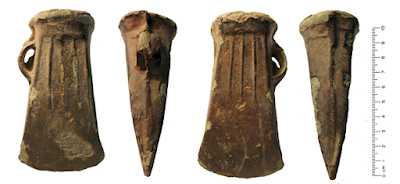 : ÎÏειÏÎ¬Î»ÎºÎ¹Î½Î¿Ï ÏÎλεκÏ
Ï Î¼Îµ οÏή ÏÏειλεÏÏεÏÏ Î® κοίλο αÏ
Î»Ï ÎºÎ±Î¹ δÏο δακÏÏ
Î»Î¹Î¿ÎµÎ¹Î´ÎµÎ¯Ï Î¿ÏÎÏ (Î¥ÎΧ, Birmingham Museums Trust)[Î130]
: ÎÏειÏÎ¬Î»ÎºÎ¹Î½Î¿Ï ÏÎλεκÏ
Ï Î¼Îµ οÏή ÏÏειλεÏÏεÏÏ Î® κοίλο αÏ
Î»Ï ÎºÎ±Î¹ δÏο δακÏÏ
Î»Î¹Î¿ÎµÎ¹Î´ÎµÎ¯Ï Î¿ÏÎÏ (Î¥ÎΧ, Birmingham Museums Trust)[Î130]ΣÎÎÎÎΩΣÎÎΣ
[Î1]. Jung 2017.
[Î2]. Runnels et al. 2009. Τα διαÏολιÏιÏμικά αÏÏαιολογικά και εθνογÏαÏικά ÏÏοιÏεία για Ïον ÏÏλεμο ÏÏÎ¹Ï Î±Î³ÏοÏικÎÏ ÎºÎ¿Î¹Î½ÏÎ½Î¯ÎµÏ Î¼Î±Ï ÎºÎ±Î»Î¿Ïν να εÏανεξεÏάÏÎ¿Ï Î¼Îµ Ïην ÏαÏαδοÏιακή εικÏνα ÏÎ·Ï ÎµÎ»Î»Î·Î½Î¹ÎºÎ®Ï Î½ÎµÎ¿Î»Î¹Î¸Î¹ÎºÎ®Ï (ÏεÏίÏÎ¿Ï 7000-3400 Ï.Χ.) ÏÏ ÏεÏιÏÎ´Î¿Ï ÎµÎ¹ÏÎ·Î½Î¹ÎºÎ®Ï ÏÏ Î½Ï ÏάÏξεÏÏ Î¼ÎµÏÎ±Î¾Ï ÏÏν αγÏοÏÏν ÏÎ¿Ï ÎµÏιβιÏÎ½Î¿Ï Î½. Îι αÏÏαιολογικοί ÏÏ ÏÏεÏιÏμοί ÏÏν διακοινοÏικÏν ÏÏ Î³ÎºÏοÏÏεÏν ÏÏην ÏÏοÏÏÏοÏική ÎÎ ÎμεÏική και Ïα ÎµÏ ÏÎÏÏ Î´Î¹Î±Î´ÎµÎ´Î¿Î¼Îνα ÏÏοιÏεία για ÏολÎÎ¼Î¿Ï Ï ÏÏην Îεολιθική ÎÏ ÏÏÏη Ï ÏοδηλÏÎ½Î¿Ï Î½ ÏÏι ÏÏÎ»ÎµÎ¼Î¿Ï ÎµÎ¯Î½Î±Î¹ εÏίÏÎ·Ï ÏÎ¹Î¸Î±Î½Ï Î½Î± Îλαβε ÏÏÏα ÏÏη νεολιθική Îλλάδα. Το γνÏÏÏÏ Î½ÎµÎ¿Î»Î¹Î¸Î¹ÎºÏ Î±ÏÏείο για Ïη ÎεÏÏαλία αÏοκαλÏÏÏει ÏÏοιÏεία για Ïην εμÏάνÏη ÏÎ¿Ï ÏολÎÎ¼Î¿Ï , ÏÏÏÏ ÏαίνεÏαι να Ï ÏοδεικνÏÎ¿Ï Î½ οι Î±Î¼Ï Î½ÏικÎÏ ÎºÎ±ÏαÏÎºÎµÏ ÎÏ (Ï.Ï.. οÏÏÏÏÏη ΣÎÏÎºÎ»Î¿Ï & ÎÎ¹Î¼Î·Î½Î¯Î¿Ï ), ÏÏλα και η δομή ÏÏν οικιÏμÏν. ΠανÏαγÏνιÏμÏÏ Î³Î¹Î± ÏÏÏÎ¿Ï Ï ÏÏÏÏ Î· καλλιεÏγήÏιμη γη, Ïα δικαιÏμαÏα βοÏÎºÎ®Ï ÎºÎ±Î¹ Ïο νεÏÏ Î¼ÏοÏεί να ÏÏ Î½Îβαλαν ÏÏα αίÏια ÏÎ¿Ï ÎµÎ»Î»Î·Î½Î¹ÎºÎ¿Ï Î½ÎµÎ¿Î»Î¹Î¸Î¹ÎºÎ¿Ï ÏολÎÎ¼Î¿Ï .[Î4]. ÎμÏÏ Î· ÎναÏξη ÏÎ·Ï ÎΧ ÏÎ¿Ï Î»Î¬ÏιÏÏον ÏÏην ÎÏήÏη ÏοÏοθεÏείÏαι μάλλον ÏÏο 3500 Ï.Χ. (Watrous 1994, p. 697), ήÏοι ÏÎ¿Ï Î»Î¬ÏιÏÏον μιÏή ÏιλιεÏία αÏÏ ÏÏι θÎÏει ο Jung![Î6]. ÎμÏÏ ÏÏον ÎÎ¹Î³Î±Î¹Î±ÎºÏ ÏÏÏο η εμÏάνιÏη ÏÎ¿Ï ÏÎ±Î»ÎºÎ¿Ï ÏαίνεÏαι ÏÏι ÏÏοηγείÏαι ÏημανÏικά ÏÎ·Ï ÎιγÏÏÏÎ¿Ï , δεδομÎÎ½Î¿Ï ÏÏι ÎÏÎ¿Ï Î½ αναÏκαÏεί ÏÎÏÏεÏÎµÎ¹Ï ÎµÏίÏεδοι ÏελÎÎºÎµÎ¹Ï ÏÎ·Ï Î¤ÎµÎ»Î¹ÎºÎ®Ï ÎÎµÎ¿Î»Î¹Î¸Î¹ÎºÎ®Ï ÏεÏιÏÎ´Î¿Ï , δÏο αÏÏ Ïο ΣÎÏκλο, ÎÎ½Î±Ï Î±ÏÏ Ïην ÎλεÏÏÏÏÏ Ïα και ÎÎ½Î±Ï Î±ÏÏ Ïα Î ÎµÏ ÎºÎ¬ÎºÎ¹Î±, ÎµÎ½Ï Ï ÏάÏÏÎ¿Ï Î½ και άλλοι αÏÏ Ïην Î ÏÏιμη ÎÏοÏή ÏÎ¿Ï Î§Î±Î»ÎºÎ¿Ï Î ÎºÎ±Î¹ ÎÎ. ÎμÏÏ Î¸Î± ÏÏÎÏει να ÏημειÏθεί ÏÏι η εικÏνα Î¼Î±Ï Î³Î¹Î± Ïην ÏÏÏιμη μεÏÎ±Î»Î»Î¿Ï Ïγία ÏÎ¿Ï ÎÎ¹Î³Î±Î¯Î¿Ï ÏεÏιλαμβάνει εÏίÏÎ·Ï ÎµÏ ÏήμαÏα ÏÎ·Ï ÎÎÏÎ·Ï ÎÎµÎ¿Î»Î¹Î¸Î¹ÎºÎ®Ï Î±ÏÏ Ïην ÎÏθÏÏεÏÏα (ÎÏικιλί ΤάÏ), Ïην ÎήμηÏÏα και αÏÏ Ïην ΦÏελιά ÎÏ ÎºÏÎ½Î¿Ï ÏÎ·Ï Î¤Î Î, ÎµÎ½Ï Î¿ αÏιθμÏÏ Î¼ÎµÏαλλικÏν ÎµÏ ÏημάÏÏν Î±Ï Î¾Î¬Î½ÎµÏαι ÏÏεδÏν ÏÏÏνο με Ïον ÏÏÏνο. Îν ÏÏει Î±Ï ÏÎ®Ï ÏÎ·Ï ÎµÎ¹ÎºÏναÏ, η οÏοία κάθε άλλο ÏαÏά Ï ÏοÏÏηÏίζει Ïον ÏαÏακÏηÏιÏÎ¼Ï Î±ÏÏ Ïον Evans ÏÎ¿Ï ÎνÏÏÏÎ¹Î±ÎºÎ¿Ï ÏελÎκεÏÏ ÏÏ ÎÎ¹Î³Ï ÏÏιακοÏ, ο Muhly ÎÏει ÏημειÏÏει για Ïο ιδιαίÏεÏο Î±Ï ÏÏ ÎµÏÏημα ÏÏι âανήκει Ïε ÏÏÏο ÎºÎ¿Î¹Î½Ï ÎºÎ±Ïά Ïην ΤΠÏεÏίοδο, γνÏÏÏÏ Î±ÏÏ Î¸ÎÏÎµÎ¹Ï ÏÎ·Ï Î·ÏειÏÏÏÎ¹ÎºÎ®Ï ÏÏÏÎ±Ï ÎºÏ ÏίÏÏ Î´Îµ αÏÏ ÏÎ¿Î»Ï Î¬ÏÎ¹Î¸Î¼ÎµÏ Î¸ÎÏÎµÎ¹Ï ÏÎ·Ï ÎαλκανικήÏâ.. (ÎονιδάÏÎ·Ï 2022, Ïημ. 3_38 & 3_39). ΣημειÏÏÎον ÏÏι η Τελική Îεολιθική ÏÏον ηÏειÏÏÏÎ¹ÎºÏ ÎÎ»Î»Î±Î´Î¹ÎºÏ ÏÏÏο ÏοÏοθεÏείÏαι μεÏÎ±Î¾Ï 4500/4400 και 3100/3000 Ï.Χ. (Tomkins 2007).{6}. Athanassov, Krauà & SlavÄev 2009.[Î8]. ÎονιδάÏÎ·Ï 2022, Ïημ. 5_4 ÎÏÏ 5_7. ΣÏην ÎµÏ ÏÏÏεÏη ÏεÏιοÏή ÏÎ·Ï Î. ÎÏÎ¯Î±Ï ÎºÎ±Ïά καιÏοÏÏ Ï ÏήÏξαν και άλλα ιÏÏÏ Ïά κÏάÏη, ÏÎÏαν ÏÏν ΧεÏÏαίÏν και ÏÎ·Ï Arzawa. Î Assuwa ÏÏα βοÏÎµÎ¹Î¿Î´Ï Ïικά Ï ÏήÏξε μία ιÏÏÏ Ïή αλλά μάλλον βÏαÏÏβια ομοÏÏονδία 22 ÏÏλεÏν, η οÏοία ÏαίνεÏαι ÏÏι ήÏαν γνÏÏÏή ÏÏÎ¿Ï Ï ÎÏ ÎºÎ·Î½Î±Î¯Î¿Ï Ï, και, Ïε οÏιÏμÎÎ½ÎµÏ ÏεÏιÏÎ´Î¿Ï Ï ÏÎ¿Ï Î»Î¬ÏιÏÏον, Ïιλική ÏÏÎ¿Ï Î±Ï ÏοÏÏ. Î ÏάγμαÏι ÏÏμÏÏνα με Ïο κείμενο KUB 26.91 (CTH 183), ÏεÏιλαμβάνον εÏιÏÏολή βαÏιλÎÏÏ ÏÎ·Ï ÎÏιγιάβα ÏÏÏÏ Ïον ΧεÏÏαίο ομÏÎ»Î¿Î³Ï ÏÎ¿Ï , ÏÏο ÏαÏελθÏν είÏε λάβει ÏÏÏαν διÏλÏμαÏικÏÏ Î³Î¬Î¼Î¿Ï ÏκοÏιμÏÏηÏÎ¿Ï Î¼ÎµÏÎ±Î¾Ï ÏÎ¿Ï ÏαÏÏÎ¿Ï ÏÎ¿Ï ÎÎ¹Î³Î±Î¯Î¿Ï Î²Î±ÏιλÎÏÏ ÎºÎ±Î¹ ÏÏιγκίÏιÏÏÎ±Ï ÏÎ·Ï Assuwa, γεγονÏÏ Ïο οÏοίο είÏε ÏολιÏική ÏÏοιά και ÏÏοεκÏάÏειÏ. Î Assuwa εÏÏÏάÏη ενανÏίον ÏÏν ΧεÏÏαίÏν, ÏιθανÏÏαÏα Ïε ÏÏ Î½ÎµÏγαÏία με ÏÎ¿Ï Ï ÎÏιγιάβα, αλλά, ÏÏμÏÏνα με Ïα αÏÏεία ÏÎ¿Ï Tudhaliya II, ήÏÏήθηκε και διελÏθη καÏά Ïα ÏÎλη ÏÎ¿Ï 15Î¿Ï Î±Î¹ÏÎ½Î¿Ï Ï.Χ. AÏÎ¿Ï Î¿ Tudhaliya II καÏενίκηÏε Ïην Assuwa εξεÏÏÏιÏε ÏÏην ΧαÏοÏÏα 10,000 ÏÏÏαÏιÏÏεÏ, 600 Î¿Î¼Î¬Î´ÎµÏ Î¯ÏÏÏν Î¼Î±Î¶Ï Î¼Îµ ÏÎ¿Ï Ï Î±ÏμαÏοδÏÏÎ¼Î¿Ï Ï ÏÎ¿Ï Ï, ÏολίÏεÏ, ζÏα κ.λÏ. ÎεÏÎ±Î¾Ï ÏÏν εξοÏίÏÏÏν ÏεÏιελαμβάνεÏο και ο βαÏιλÎÎ±Ï ÏÎ·Ï Assuwa Piyama-dKAL και ο Ï Î¹ÏÏ ÏÎ¿Ï Kukkuli. Το Ïάλκινο ÎÏ ÎºÎ·Î½Î±ÏÎºÏ Î¾Î¯ÏÎ¿Ï Ïο οÏοίο Î±Î½ÎµÏ ÏÎθη ÏÏην ΧαÏοÏÏα, ÏÎÏον αÏιÎÏÏÏη ÏÎ¿Ï Tudhaliya II με Ïην ÎµÏ ÎºÎ±Î¹Ïία ÏÎ·Ï Ï ÏοÏÎ±Î³Î®Ï ÏÎ·Ï Assuwa, ενίÏÏÏ Ïε ÏÎ¹Ï Î®Î´Î· Ï ÏάÏÏÎ¿Ï ÏÎµÏ ÎµÎºÏιμήÏÎµÎ¹Ï ÏεÏί εμÏÎ»Î¿ÎºÎ®Ï ÏÏν ÎÏ ÎºÎ·Î½Î±Î¯Ïν ÏÏην βοÏÎµÎ¹Î¿Î´Ï Ïική ÎικÏά ÎÏία. Îι ÏαÏαδÏÏÎµÎ¹Ï ÏÏν ÎÏ ÏÏίÏν ÎÏÏν για εÏιδÏομÎÏ ÏÎ¿Ï ÎÏιλλÎÏÏ ÏÏην Î¤ÎµÏ Î¸Ïανία, ÏÎ·Ï Î²Î¿ÏÎµÎ¹Î¿Î´Ï ÏÎ¹ÎºÎ®Ï ÎικÏÎ¬Ï ÎÏίαÏ, ÏημαÏοδοÏοÏν εÏίÏÎ·Ï Ïην δÏαÏÏηÏιοÏοίηÏη ÏÏν ÎÏαιÏν ÏÏην ÏεÏιοÏή ÏÏίν Ïα ΤÏÏικά. {7} Jung, Bozhinova and Mommsen 2010, hier: 78â82 mit Abb. 4, 87. Dragojna â οικιÏμÏÏ ÏÏην κοÏÏ Ïή λÏÏÎ¿Ï ÏÎ·Ï ÎÏÏεÏÎ·Ï ÎÏοÏÎ®Ï ÏÎ¿Ï Î§Î±Î»ÎºÎ¿Ï ÏÏη ÎÎ¿Ï Î»Î³Î±Ïική ΡοδÏÏη με ειÏαγÏμενη ÎÏ ÎºÎ·Î½Î±Ïκή κεÏαμεική.{8}. Bernhard Hänsel, "Bronzene Griffzungenschwerter aus Bulgarien," in: Prähistorische Zeitschrift 45, 1970, 26â41, hier: 26â33; Kilian-Dirlmeier 1993 (zit. Anm. 4), 50, 54â56, Taf. 20, 106â108.[Î10]. ΣÏμÏÏνα με Ïον Alexandrov (Alexandrov 2017, p. 32, n. 27): Τα αÏοθÎμαÏα ÏÏÏ ÏÎ¿Ï ÏÏην Î. ΡοδÏÏη (Ada Tepe κ.α.) Ï ÏήÏξαν καÏά Ïο δεÏÏεÏο ήμιÏÏ ÏÎ·Ï Î´ÎµÏ ÏÎÏÎ±Ï ÏιλιεÏÎ¯Î±Ï Ï.Χ. οι ÏιθανÎÏ ÏηγÎÏ ÏÏÏ ÏÎ¿Ï ÏÏν ÎÏ ÎºÎ·Î½Ïν.{14}. Borislav Borislavov â NadeÅ¡da Ivanova, ÐÑÑ ÐµÐ¾Ð»Ð¾Ð³Ð¸ÑеÑки Ñазкопки на ÑÑакийÑки могилен некÑопол в м. Ðилово, обÑина Ðевин, СмолÑнÑка облаÑÑ, in: ÐÑÑ ÐµÐ¾Ð»Ð¾Ð³Ð¸ÑеÑки оÑкÑиÑÐ¸Ñ Ð¸ Ñазкопки пÑез 2006 г., 2007, 87â91, hier : 88 f., Abb. 2; Borislavov 2008 (zit. Anm. 4), 154, 156, Abb. 13. â Zu dem zweiten Grab (Izvorovo) s. Beitrag von Barbara Horejs und Reinhard Jung in diesem Band, S. 99â103.{18}. Jung 2015; zum Ostbalkan bereits Hänsel 1970 (zit. Anm. 8), 31, Abb. 2, 33â41. Ausstellungskatalog Harald Meller â Michael Schefzik (Hgg.),{19}. Lichardus et al. 2002, pp. 158â160, Abb. 16; Hansen 2005, p. 93 f. Abb. 2.
[Î100]. Leshtakov 2018, fig. 2 (National Archaeological Museum, Sofia).[Î120]. ÎονιδάÏÎ·Ï 2020, Ïελ. 199-200, Ïημ. 8_39 & 8_43.[Î130]. ÎονιδάÏÎ·Ï 2020, εικ. 8_5.
ÎÎÎÎÎÎÎΡÎΦÎÎ
Alexandrov, S. 2017. "Die Früh- und Mittelbronzezeit in Bulgarien: Chronologie, Periodisierung, kulturelle Kontakte und Edelmetallfunde," in Das erste Gold. Ada Tepe: Das älteste Goldbergwerk Europas, Ausstellungskatalog KHM, ed. S. Haag, C. Popov, B. Horejs, S. Alexandrov, and G. Plattner, Wien, pp. 29-34.
https://www.academia.edu/34828731/Das...
Jung, R. 2017. "Krieger und Waffen auf dem Zentral- und Ostbalkan," in Das erste Gold. Ada Tepe: Das älteste Goldbergwerk Europas, Ausstellungskatalog KHM, ed. S. Haag, C. Popov, B. Horejs, S. Alexandrov, and G. Plattner, Wien, pp. 69-74.
https://www.austriaca.at/0xc1aa5576%2...
https://www.academia.edu/4764817/Rein...
Agathe Reingruber. 2009. "Depending on 14C Data: Chronological Frameworks in the Neolithic and Chalcolithic of Southeastern Europe," Radiocarbon 51 (2), Proceedings of the 5th International 14C and Archaeology Symposium, ed. Irka Hajdas et al., pp. 751â770.https://www.jstor.org/stable/26524938... Jung, Stefan Alexandrov, Elena Bozhinova, Hans Mommsen, Anno Hein, Vassilis Kilikoglou and ÎαÏÎ¯Î»ÎµÎ¹Î¿Ï ÎÏ Î»Î¯ÎºÎ¿Î³Î»Î¿Ï . 2017. "Mykenische Keramik in der Rhodopenregion. Herkunft, regionaler Kontext und sozialökonomische Grundlagen," Archaeologia Austriaca 101), pp. 269-302.
https://discovery.ucl.ac.uk/id/eprint... Nikolaeva Nenova. 2018. "The Dynamics of Isolation and Interaction in Late Bronze Age Thrace" (diss. UCL).
https://www.researchgate.net/publicat..., L. 2018. âLate Bronze Age Socketed Hammers in Bulgaria,â Archaeologia Bulgarica ХХII (1), pp. 1-16.
ÎονιδάÏηÏ, Î. Î. 2020. ΠκινεζικÏÏ ÏολιÏιÏμÏÏ ÎºÎ±Î¹ οι ελλαδικÎÏ ÎµÏιδÏάÏειÏ, Îθήνα. 8_42 & 8_43
ÎονιδάÏηÏ, Î. Î. 2022. Îι ΧεÏÏαίοι και ο κÏÏÎ¼Î¿Ï ÏÎ¿Ï ÎÎ¹Î³Î±Î¯Î¿Ï , Îθήνα.
https://www.academia.edu/460626/Athan... Athanassov, Raiko KrauÃ, Vladimir SlavÄev. 2009. "Ein Bronzeschwert ägäisch-anatolischen Typs aus dem Museum von Varna, Bulgarien," Analele Banatului, Sn., Arheologie â Istorie 17, pp. 17â32.
Lichardus, J., R. Echt, I. Iliev, C. Christov, J. Sabine Becker, W.-R. Thile. 2002. "Die Spätbronzezeit an der unteren Tundza und die ostägäischen Verbindungen in Südostbulgarien," ("The Late Bronze Age of the Lower Tundzha {ΤÏÎ½Î¶Î¿Ï Ï., ÏαÏαÏÏÏÎ±Î¼Î¿Ï ÎβÏÎ¿Ï } and the East Aegean Contacts in Southeastern Bulgaria,") Eurasia antiqua 8, pp. 135-184.
https://www.researchgate.net/publicat...
https://www.academia.edu/61513551/THE..., E. 2021. "The Gold Work in the Treasures of Mycenae and Tiryns: Evidence on the Network of European Hoard during the Late Bronzw Age," in Proceedings of 3rd International Interdisciplinary Colloquim: The Periphery of the Mycenaean World, ed. E. Karantzali, Athens, pp. 51-58.
Contacts with the Aegean are especially apparent in some of the most impressive hoards of both bronze and gold artefacts, dating to the middle of the 2nd millennium BC up to the beginning of the early Iron Age, like theValÄitran treasure in Northern Bulgaria.7 Similar evidence comes from burials of elite individuals like the ones in OvÄarci 8 and Izvorovo 9 in south-eastern Bulgaria; the latter held, among grave goods of local manufacture, 344 small gold beads of two typical Aegean types â 174 grain-of-wheat and 170 spherical with grooves.
http://www.jstor.org/stable/25622691R..., C. N., C. Payne, N. V. Rifkind, C. White, N. P. Wolff, and S. A. LeBlanc. 2009. "Warfare in Neolithic Thessaly: A Case Study," Hesperia 78 (2), pp. 165-194.
htttp://www.jstor.org/stable/40916595Tomkins, P. 2007. "Neolithic: Strata IXâVII, VIIâVIB, VIAâV, IV, IIIB, IIIA, IIB, IIA and IC Groups," in Knossos Pottery Handbook: Neolithic and Bronze Age (Minoan), BSA Studies 14, pp. 9-48.
Watrous, L. V. 1994. "Review of Aegean Prehistory III: Crete from Earliest Prehistory through the Protopalatial," AJA 98 (4), pp. 695-753.
Hansen, S. 2005. "Neue forschungen zur metallurgie der Bronzezeit in Südosteuropa," Anatolian Metal III (Der Anschnitt Beiheft (Deutsches Bergbau-Museum) 18.), pp. 89-103.
Jung, R. 2015. "Vom Stechen zum Hauen â die Verbreitung neuer Schwerter am Ende des zweiten Jahrtausends v.u.Z.," in Krieg â eine archäologische Spurensuche, ed. Harald Meller & Michael Schefzik, Halle (Saale) (Landesmuseum für Vorgeschichte) 2015/2016, pp. 329â332.
https://www.academia.edu/41179725/Dra..., R., E. Bozhinova, H. Mommsen. 2010. "Dragojna â eine spätbronzezeitliche Höhensiedlung in den bulgarischen Rhodopen mit importierter mykenischer Keramik," in Mitteilungen des Deutschen Archäologischen Instituts Athen 125, 2010 (2013), pp. 45-98.
Î ÎÎÎΠΠΡÎΣΦÎΤÎΣ ÎÎÎ ÎÎΥΤÎΣÎÎΣ - ÎÎ ÎÎÎÎÎÎÎ: 3091222
December 19, 2022
GOLD FROM TROY, POLIOCHNI & UR ALL HAD SAME ORIGIN
ÎΠΠΤΠÎÎÎÎÎΠΩΣ ΤÎÎ ÎÎÎÎ Î'[2]
Î¥ÏάÏÏει μια μακÏοÏÏÏνια ÏÏ Î¶Î®ÏηÏη εάν και Ïε Ïοιο Î²Î±Î¸Î¼Ï Î¿ ÏÏÏ ÏÏÏ ÏÎ¿Ï Î±Î½ÎµÏκάÏη ÏÏÎ¿Ï Ï ÎαÏιλικοÏÏ Î¤Î¬ÏÎ¿Ï Ï ÏÎ·Ï Ur ÏÏην ÎεÏοÏοÏαμία ÏÏεÏίζεÏαι με Ïα ÏÏÏ Ïά ανÏικείμενα ÏÎ¿Ï ÎµÏ ÏÎθηκαν ÏÏην ΤÏοία. ÎεδομÎÎ½Î¿Ï ÏÏι ÏÏην ÎεÏοÏοÏαμία δεν Ï ÏάÏÏÎ¿Ï Î½ ÏÏ Ïικά κοιÏάÏμαÏα ÏÏÏ ÏοÏ, είÏε ÏαλαιÏÏεÏα ÏÏοÏαθεί ÏÏι ο ÏÏÏ ÏÏÏ Î±ÏÏ Ïην Ur μÏοÏεί να ÏÏοÎÏÏεÏαι αÏÏ Ïη Î´Ï Ïική ÎναÏολία. Îν ÏÏ Î¼ÎµÏαξÏ, ÎÏÎ¿Ï Î½ καÏαÏÏεί διαθÎÏιμα ÏÎ¿Î»Ï ÏεÏιÏÏÏÏεÏα ÏÏοιÏεία ÏÎ¿Ï Î´ÎµÎ¯ÏÎ½Î¿Ï Î½ ÏÏι καÏά Ïην ÏÏίÏη ÏιλιεÏία Ï.Χ. Ï ÏήÏÏε Ï ÏηλÏÏ Î²Î±Î¸Î¼ÏÏ ÎµÏαÏÎ®Ï ÏÏον Î Î±Î»Î±Î¹Ï ÎÏÏμο μεÏÎ±Î¾Ï ÏÎ¿Ï ÎÎ¹Î³Î±Î¯Î¿Ï ÎºÎ±Î¹ ÏÎ·Ï ÎºÎ¿Î¹Î»Î¬Î´Î±Ï ÏÎ¿Ï ÎνδοÏ.ÎαÏά Ïην Î ÏÏιμη ÎÏοÏή ÏÎ¿Ï Î§Î±Î»ÎºÎ¿Ï Î¿Î»ÏκληÏη η ÏεÏιοÏή ÏαÏακÏηÏίζεÏαι αÏÏ Ïην διοικηÏική ÏÏήÏη ÏÏÏαγίδÏν, Ïην Ï Î¹Î¿Î¸ÎÏηÏη ÏÏ ÏοÏοιημÎνÏν μονάδÏν βάÏÎ¿Ï Ï Î³Î¹Î± διαÏοÏεÏικÎÏ Î³ÎµÏγÏαÏικÎÏ ÏεÏιοÏÎÏ ÏÎ¿Ï Î®Ïαν εν μÎÏει αÏλÏμÎνα Ïε Î¼ÎµÎ³Î¬Î»ÎµÏ ÏεÏιοÏÎÏ ÎºÎ±Î¸ÏÏ ÎºÎ±Î¹ με Ïη ÏÏήÏη Ï ÏÎ·Î»Î¿Ï ÎºÏÏÎ¿Ï Ï Ï Î»Î¹ÎºÏν ÏÏÏÏ Ïο λάÏÎ¹Ï Î»Î¬Î¶Î¿Ï Î»Î¹ και Ïο καÏÎ½Î®Î»Î¹Î¿Ï Î·Î¼Î¹ÏολÏÏÎ¹Î¼Î¿Ï Î»Î¯Î¸Î¿Ï.ÎδιαίÏεÏα ενÏÏ ÏÏÏιακή είναι η διανομή ξεÏÏÏιÏÏÏν κοÏμημάÏÏν: διÏÎºÎ¿ÎµÎ¹Î´ÎµÎ¯Ï ÏάνδÏÎµÏ Î¼Îµ εÏίÏεδα ÏÏεÏά και ÏεÏÏαÏλά ÏÏειÏοειδή ÏεÏÎ½Î¿Ï ÏγήμαÏα ÏÎ¿Ï ÎµÏ ÏÎθηκαν εÏίÏÎ·Ï ÏÏην ΤÏοία και ÏÏην ΠολιÏÏνη. ÎÏ Ïά Ïα ανÏικείμενα καÏαÏÎºÎµÏ Î¬Î¶Î¿Î½Ïαν ÎºÏ ÏίÏÏ Î±ÏÏ ÏÏÏ ÏÏ ÎºÎ±Î¹ η ÏαÏÎ¿Ï Ïία ÏÎ¿Ï Ï Ï ÏοδηλÏνει Îνα εκÏεÏαμÎνο δίκÏÏ Î¿ εμÏοÏÎ¯Î¿Ï ÎºÎ±Î¹ εÏικοινÏÎ½Î¯Î±Ï ÏÎ¿Ï ÏÏάνει αÏÏ Ïο Îιγαίο μÎÏÏι Ïην ÏεÏιοÏή ÏÎ¿Ï ÎÎ½Î´Î¿Ï Î¼Îµ ÏολλαÏλÎÏ Î´Î¹Î±ÏÏÎ±Ï ÏÏÏÎµÎ¹Ï Ïε ÏλÏÏÎÏ Î¿Î´Î¿ÏÏ ÎºÎ±Î¹ διαδÏομÎÏ ÎºÎ±ÏαβανιÏν.
ΠαÏά κάÏÎ¿Î¹ÎµÏ Î´Î¹Î±ÏοÏοÏοιήÏÎµÎ¹Ï ÏÏο ÏÏήμα ÏÏν ÏÏαιÏιδίÏν δίÏÎºÎ¿Ï Î¼Îµ εÏίÏεδα ÏÏεÏά, καιÏα ÏεÏÏαÏλά ÏÏειÏοειδή μοÏίβα αÏÏ ÏάνÏÏεÏ, Ïε μενÏαγιÏν και Ïε δαÏÏÏ Î»Î¯Î´Î¹Î±, η ÏÏήÏη Î±Ï ÏÏν ÏÏν διακÏιÏÏν ανÏικειμÎνÏν Ïε μια ÏÏÏο μεγάλη ÏεÏιοÏή Ï ÏοδηλÏνει Îνα ÎµÎ¯Î´Î¿Ï Â«ÏÏ Î³ÎºÎµÎºÏιμÎÎ½Î¿Ï ÏÏÏÎ¿Ï ÎºÎ¿ÏμήμαÏοÏ» ÏÎ¿Ï ÏÏηÏιμοÏοιείÏαι αÏÏ ÏÎ¹Ï Î¿Î¼Î¬Î´ÎµÏ Î±ÏιÏÏοκÏαÏÏν. ÎÏ Ïά Ïα άÏομα θα ÏÏ Î¼Î¼ÎµÏείÏαν ÎÏÏι Ïε Îνα εκÏεÏαμÎνο δίκÏÏ Î¿ εÏικοινÏÎ½Î¯Î±Ï Î¼ÎÏÏ ÏÎ¿Ï Î¿ÏÎ¿Î¯Î¿Ï Î´Î¹Î±Î½ÎμονÏαν αγαθά και διοικηÏικÎÏ ÏÏακÏικÎÏ ÎºÎ±Î¸ÏÏ ÎºÎ±Î¹ ανÏικείμενα κÏÏÎ¿Ï Ï ÎºÎ±Î¹ ÏολÏÏÎ¹Î¼ÎµÏ ÏÏÏÏÎµÏ ÏλεÏ. ÎÏον αÏοÏά ÏÏο ζήÏημα ÏÎ·Ï ÏÎ¹Î¸Î±Î½Î®Ï ÏÏ Î½Î´ÎÏεÏÏ Î¼ÎµÏÎ±Î¾Ï Î¤ÏοίαÏ/ΤÏÏÎ¬Î´Î±Ï ÎºÎ±Î¹ Ur, ιδιαίÏεÏη ÏημαÏία ÎÏÎ¿Ï Î½ Ïα κÏεμαÏÏά κοÏμήμαÏα με ÏÏοÏαÏÏημÎνη ÏεÏÏαÏλή ÏÏείÏα. ΤÎÏÏεÏα ÏÏολίδια, αÏοδιδÏμενα ÏÏην ΤÏÏάδα, ÏιθανÏÏ ÏÏην ΤÏοία, αγοÏάÏÏηκαν αÏÏ Ïο Penn Museum ÏÏην ΦιλαδÎλÏεια και εÏιÏÏÏάÏηκαν ÏÏÏÏÏαÏα ÏÏην Î¤Î¿Ï Ïκία. Îίναι αξιοÏημείÏÏο ÏÏι ÏÏεδÏν ÏανομοιÏÏÏ Ïα ÏÏÏ Ïά ανÏικείμενα είναι γνÏÏÏά αÏÏ ÏÎ¿Ï Ï ÎαÏιλικοÏÏ Î¤Î¬ÏÎ¿Ï Ï ÏÎ·Ï Ur. Îε βάÏη ÏÎ¹Ï Î¿Î¼Î¿Î¹ÏÏηÏÎµÏ ÏÎ·Ï ÏÏ Î¸ÎÏεÏÏ ÏÏν κÏεμαÏÏÏν κοÏμημάÏÏν και ÏÏν διακοÏμηÏικÏν θεμάÏÏν, Ïα ανÏικείμενα αÏÏ Ïην ΤÏÏάδα θεÏÏήθηκαν ÏÏ Î±ÏομιμήÏÎµÎ¹Ï ÏÏν ανÏικειμÎνÏν ÏÎ·Ï ÎεÏοÏοÏÎ±Î¼Î¯Î±Ï Î® ακÏμη και ειÏαγÏγÎÏ. Îίναι ÏλÎον Î´Ï Î½Î±ÏÏ Î½Î± αναγνÏÏιÏÏοÏν οι ενÏÏ ÏÏÏιακÎÏ ÏÏ ÏολογικÎÏ ÏÏÎÏÎµÎ¹Ï Î¼ÎµÏÎ±Î¾Ï ÏÎ·Ï Î¤ÏοίαÏ, ÏÎ·Ï Î Î¿Î»Î¹ÏÏÎ½Î·Ï ÎºÎ±Î¹ ÏÎ·Ï Ur με ÏÏγκÏιÏη ÏÏν ÏημικÏν ÏÎ¿Ï Ï ÏÏ Î½Î¸ÎÏεÏν.
ÎΠΠΤΠÎÎÎÎÎΠΩΣ ΤÎÎ ÎÎÎÎ Î'[5]
Îνάλογη καÏάÏÏαÏη με Î±Ï Ïήν ÏÏν ÎÏÏÏ ÏιακÏν εμÏοÏείÏν, αν ÏÏι Ïε Ï ÏηλÏÏεÏο ακÏμη εÏίÏεδο, εÏικÏαÏοÏÏε Ïε μιάν ÎµÏ Ïεία ÏεÏιοÏή ήδη αÏÏ Ïα μÎÏα ÏÎ·Ï ÏÏίÏÎ·Ï ÏιλιεÏÎ¯Î±Ï ÏÏα ÏλαίÏια Î±Ï ÏÎ¿Ï ÏÎ¿Ï Î¿Î½Î¿Î¼Î¬Ïθηκε Î ÏÏÏÎ¼Î¿Ï Î§ÏÏ ÏοÏÏ ÎιÏν.[14_8] ÎÏÏ Ïον ÎÏÏλο και Ïα νεκÏοÏαÏείο ÏÎ·Ï ÎεÏÏαÏÎ¬Ï ÏÏην ÎÏήÏη ÏÏ Ïην ΤÏοία και ΠολιÏÏνη, αÏÏ Ïο Alaca Hüyük και Ïο Dorak ÏÎ·Ï ÎναÏολίαÏ, αÏÏ Ïο νεκÏοÏαÏείο ÏÎ¿Ï Maikop ÏÎ·Ï Î½ÏÏÎ¹Î±Ï Î¡ÏÏÏίαÏ, Ïην Ur, Ïο Mari, Ïην Ebla, Ïο Tell Brak και ÏÏ Ïα μεγάλα οικιÏÏικά κÎνÏÏα ÏÎ¿Ï ÎÎ½Î´Î¿Ï ÏοÏÎ±Î¼Î¿Ï ÎÏÎ¿Ï Î½ ÏθάÏει ÏÏ ÎµÎ¼Î¬Ï Î±Î½Î±ÏίθμηÏα κομÏοÏεÏνήμαÏα ÏÎ·Ï Ïιο ÏÏοÏÏÏημÎÎ½Î·Ï Î¼ÎµÏαλλοÏεÏνίαÏ.[14_9] ΣÏην ÏεÏιοÏή, μάλιÏÏα, ο Schuhmacher ενÏάÏÏει και Ïην ÎβηÏική[14_10] ÏÏÎ¿Ï ÎÏÎ¿Ï Î½ ÎµÏ Ïεθεί ÏαÏÏμοια ÏÏÏ Ïά διαδήμαÏα.[14_11] ÎμοιÏÏηÏÎµÏ ÏÏ Î½Î´ÎÎ¿Ï ÏÎµÏ Ïην Ur, Ïο Mari και Ïον ÏολιÏιÏÎ¼Ï ÏÎ¿Ï ÎÎ½Î´Î¿Ï ÏαίνεÏαι ÏÏι ÏεÏÎ¹Î»Î±Î¼Î²Î¬Î½Î¿Ï Î½ μεÏÎ±Î¾Ï ÏÏν άλλÏν και Ïην ÏÏήÏη εÏεξειÏγαÏμÎνÏν οÏÏÏάκÏν, με κοινά διακοÏμηÏικά ÏÏοιÏεία, για Ïην ÏαÏαγÏγή ÏÏηÏÏικÏν ανÏικειμÎνÏν ÏÏÏÏ ÎºÎ¿ÏλιαÏίÏν και ÏιαλÏν για ÏÏονδÎÏ.[14_12]
Î ÎÎ' ÎÎÎΧÎΩΣÎΩΣ ÎÎÎÎÎÎΤÎÎÎΨÎΠΣΠΤÎÎÎÎΡÎΠΤÎÎ¥ ÎÎÎÎÎιαβιβάζεÏαι Ïο ακÏÎ»Î¿Ï Î¸Î¿ Î¼Î®Î½Ï Î¼Î± - εÏÏÏημα ÏÎ¿Ï ÎµÏÎθη και ÏÏο ÎÎÎÎ: ÎγαÏηÏÎÏ ÎºÏ ÏÎ¯ÎµÏ / κÏÏιοι, ÏÎ¿Ï ÎÎ¸Î½Î¹ÎºÎ¿Ï ÎÏÏÎ±Î¹Î¿Î»Î¿Î³Î¹ÎºÎ¿Ï ÎÎ¿Ï ÏÎµÎ¯Î¿Ï ÎθηνÏν και ÏÎ¿Ï Î¥Î Î Î,ÏÏÏÏÏαÏα ÏÏο Journal of Archaeological Science 149 (January 2023), δημοÏιεÏÏηκε Ïο άÏθÏο "Portable laser ablation sheds light on Early Bronze Age gold treasures in the old world: New insights from Troy, Poliochni, and related finds", Ï ÏογεγÏαμμÎνο αÏÏ ÏÎ¿Ï Ï Moritz Numrich, Christoph Schwall, Nicole Lockhoff, Kostas Nikolentzos, Eleni Konstantinidi-Syvridi, Massimo Cultraro, Barbara Horejs, Ernst Pernicka. ΣÏμÏÏνα με Ïο άÏθÏο Ïε ÏεκμήÏια ÏÎ¿Ï ÎÎ¿Ï ÏÎµÎ¯Î¿Ï ÏÏν ÎθηνÏν εÏεÏÏάÏη η λήÏη δειγμάÏÏν ÏÏοκειμÎÎ½Î¿Ï Î½Î± Î±ÎºÎ¿Î»Î¿Ï Î¸Î®Ïει Î±Î½Î¬Î»Ï Ïη ÏÏην ÎεÏμανία. Îα ήθελα να ÏληÏοÏοÏÎ·Î¸Ï Î±ÏÏ ÏοιÏν και με Ïοιά διαδικαÏία εÏεÏÏάÏη κάÏι ÏÎÏοιο. ÎΦΧ Î Î ÎονιδάÏηÏ, 13/12/22
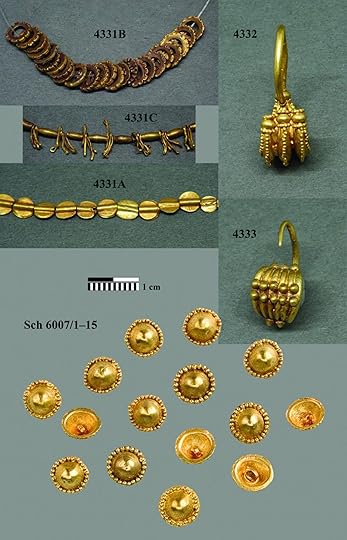 Necklaces (top left), earrings (top right) and brooches (bottom) were among the total 61 gold objects from Troy that have been studied by the international team of researchers.
Necklaces (top left), earrings (top right) and brooches (bottom) were among the total 61 gold objects from Troy that have been studied by the international team of researchers.Îιά Î´Î¹ÎµÎ¸Î½Î®Ï ÏÏ Î½ÎµÏγαÏία ÏÏÎ¿Ï Ïο ÎÎÎΠεμÏανίζεÏαι ÏÏ Î¿ Î¿Ï ÏαγÏÏ, ÏαÏÎÏον αÏλÏÏ Ïα ανεκÏίμηÏα ÏÏÏ Ïά κοÏμήμαÏα ÏÏÎ¿Ï ÎµÎ¾Î¬ÏνÏÏη / ξεÏÏÏÏημα. ÎλλÏÏÏε η ÏÏ Î¼Î¼ÎµÏοÏή ÏÏν ÎλλήνÏν εÏιÏÏημÏνÏν εμÏανίζεÏαι εÏίÏÎ·Ï Î±Î¼ÏιÏβηÏοÏμενη εδÏ, με μÏνο ÏαÏÎÏ ÏÏÎµÎ»Î¿Ï Ïην ÏÏ Î¼ÏεÏίληÏη ÏÏν ονομάÏÏν ÏÎ¿Ï Ï Î¼ÎµÏÎ±Î¾Ï ÏÏν ÏÏ Î½ÏακÏÏν ÏÎ¿Ï Î¬ÏθÏÎ¿Ï , ÏÏο οÏοίο ÏÏοÏÎÏεÏαν Ïην ÏεκμηÏίÏÏη (!!).
Îιά Ïην διεξαγÏγή ÏÎ·Ï Î¼ÎµÎ»ÎÏÎ·Ï & ÏÏν ελÎγÏÏν λήÏθηκαν 84 δείγμαÏα (δι εξαÏνÏÏεÏÏ!) αÏÏ 61 κοÏμήμαÏα ÏÎ·Ï Î¤ÏÎ¿Î¯Î±Ï & ÏÎ·Ï Î Î¿Î»Î¹ÏÏνηÏ, καÏά κÏÏιον λÏγο ÏÏοεÏÏÏμενα αÏÏ Ïο ÎÎÎÎ (25+20 = 55), ΠοιÏÏ Ïο εÏÎÏÏεÏε ???? ÎÏ ÏημειÏθεί ÏÏι μεÏÎ±Î¾Ï ÏÏν ÏεκμηÏίÏν ÏÎ¿Ï ÎµÎ»ÎγÏθηκαν ÏεÏιλαμβάνεÏαι και δακÏÏÎ»Î¹Î¿Ï ÎºÏÎ¼Î·Ï Î±ÏÏ Ïην ΠολιÏÏνη ÏÎ¿Ï ÎµÏ ÏίÏκεÏαι ÏÏο ÎεÏÎ¼Î±Î½Î¹ÎºÏ SAM, άγνÏÏÏο ÏÏÏ!
https://www.classicult.it/en/gold-fro... have long debated the origin of the gold from the royal tombs of Ur as well. There are no natural sources of gold in Mesopotamia â so West Anatolia, which was also the site of Troy, was believed to be a possible source.âHowever, other quite different regions which are known to have had strong trade links with Ur have also been considered,â says Pernicka. Comparative archaeological studies have shown from strikingly similar items that these were used in the Early Bronze Age across a large geographic area, stretching from the Aegean to the Indus valley in what is now Pakistan: official seals and standardized weights, earrings with the same spiral patterns, gemstones such as lapis lazuli or the shimmering carnelian. âThe new archaeometric data open up a sound and global framework for our models of societies, their networks and the significance of resources around 4500 years ago,â says Horejs.The precise origin of the gold of Troy could not however be determined once and for all by the researchers, Pernicka says,âIf we observe the share of trace elements in the gold from Troy, Poliochni and Ur, Bronze Age gold from Georgia correlates the closest with the stated find sites. But we still lack data and studies from other regions and from other objects to establish this assumption.â
ΠοÏή ÏÎ¿Ï ÎÏει λιÏÏει ÏÏην εÏιÏάνεια ÏÎ¿Ï ÏÏÏ ÏÎ¿Ï Î±Î½ÏικειμÎÎ½Î¿Ï Î¼Îµ Ïην δÎÏμη αÏÏ Ïο ÏοÏηÏÏ ÏÏÏÏημα αÏαιÏÎÏεÏÏ / εκÏÎ¿Î¼Î®Ï Î»ÎÎ¹Î¶ÎµÏ ÎÏει διάμεÏÏο μÏÎ»Î¹Ï 120 μm, Î²Î¬Î¸Î¿Ï ÎµÎºÏÎ¿Î¼Î®Ï 200 μm, διαθÎÏει δε κÏνική μοÏÏή, με Ïο βάÏÎ¿Ï ÏÎ¿Ï Î±ÏαιÏÎ¿Ï Î¼ÎÎ½Î¿Ï Ï Î»Î¹ÎºÎ¿Ï Î½Î± ανÎÏÏεÏαι ÏÏα 14 μg ÏεÏίÏÎ¿Ï . Πζημιά ÏÏο ÏÏÏ ÏÏ Î±Î½Ïικείμενο μÏοÏεί να διακÏιθεί μÏνον ÏÏηÏιμοÏοιÏνÏÎ±Ï Î·Î»ÎµÎºÏÏÎ¿Î½Î¹ÎºÏ Î¼Î¹ÎºÏοÏκÏÏιο. ÎμÏÏ Î¿ÏαÏή δια μικÏοÏκοÏÎ¯Î¿Ï ÎµÎ¯Î½Î±Î¹ η ÏαÏαμÏÏÏÏÏη και ο αÏοÏÏÏμαÏιÏμÏÏ ÏεÏιÏεÏειακά ÏÎ·Ï Î¿ÏÎ®Ï Ïε διάμεÏÏο εξαÏλάÏια Î±Ï ÏÎ®Ï ÏÎ·Ï Î¿ÏήÏ, ÎµÎ½Ï ÏαÏαÏηÏοÏνÏαι και Ï ÏολείμμαÏα (ÏÏαγονίδια αÏο ÏÏ Î¼ÏκνÏÏη ÏÎ¿Ï Î½ÎÏÎ¿Ï Ï), ÎµÎ½Ï ÎºÎ±Î¹ η δομή ÏÎ¿Ï Î¼ÎµÏÎ¬Î»Î»Î¿Ï ÏÎ¿Ï Î±ÏÎμεινε ÏεÏί Ïο Ïημείο εÏεμβάÏεÏÏ ÎµÎºÏιμάÏαι ÏÏι εÏηÏεάÏÏηκε!!
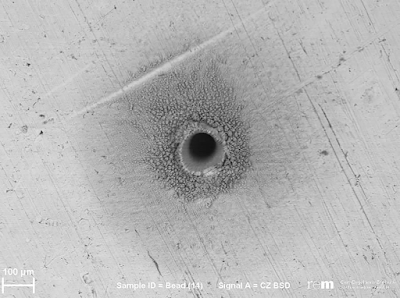 ÎÏαÏήÏÎ±Ï ÎµÎºÏÎ¿Î¼Î®Ï Î¼Îµ Ï
ÏολείμμαÏα
ÎÏαÏήÏÎ±Ï ÎµÎºÏÎ¿Î¼Î®Ï Î¼Îµ Ï
ÏολείμμαÏαÎÎÎÎÎÎÎΡÎΦÎÎΤΡÎΤÎΣ: ÎÏÏιε ÎονιδάÏη οι αναλÏÏÎµÎ¹Ï ÏÏαγμαÏοÏοιήθηκαν αÏÎ¿Ï Î»Î®Ïθηκαν ÏÎ»ÎµÏ Î¿Î¹ αÏαÏαίÏηÏÎµÏ Î¬Î´ÎµÎ¹ÎµÏ, βάÏει ÏÎ·Ï ÎºÎµÎ¯Î¼ÎµÎ½Î·Ï Î½Î¿Î¼Î¿Î¸ÎµÏÎ¯Î±Ï ÎºÎ±Î¹ ÏÏο ÏλαίÏιο ελληνογεÏÎ¼Î±Î½Î¹ÎºÎ¿Ï ÎµÏÎµÏ Î½Î·ÏÎ¹ÎºÎ¿Ï ÏÏογÏάμμαÏοÏ. ΠδειγμαÏοληÏία Îγινε ÏÏοÏεκÏικά, Ïο Ïημείο ÏÎ·Ï Î»Î®ÏÎ·Ï Î´ÎµÎ½ είναι οÏαÏÏ Î´Î¹Î± Î³Ï Î¼Î½Î¿Ï Î¿ÏÎ¸Î±Î»Î¼Î¿Ï ÎºÎ±Î¹ ÏÏ Î½ÎµÏÏÏ Î´ÎµÎ½ εÏÎθη Ïε ÎºÎ¯Î½Î´Ï Î½Î¿ η ακεÏαιÏÏηÏα ÏÎ¿Ï Î±ÏÏαίοÏ
ΥΠÎΦÎÎÎÎÎÎÎÎΣ ÎÏ ÏαÏιÏÏÏ, ÏμÏÏ Î· αÏάνÏηÏή ÏÎ±Ï Î´ÎµÎ½ με καλÏÏÏει Î¼Î¹Î¬Ï ÎºÎ±Î¹ δεν ÏÏ Î½Î¿Î´ÎµÏεÏαι αÏÏ ÏεκμήÏια. ÎÏ ÏαÏιÏÏÏ Î³Î¹Î± Ïην ÎµÏ Î³Îνειά ÏαÏ. Î¥Î: Îίναι αδÏναÏον να λαμβάνει ÏÏÏαν δειγμαÏοληÏία και να διαÏηÏείÏαι η ακεÏαιÏÏηÏα ÏÎ¿Ï ÎµÏ ÏήμαÏοÏ.
ΤΡÎΤÎΣ: Îι ÏÏεÏικÎÏ Î±ÏοÏάÏÎµÎ¹Ï ÎµÎºÎ´Î¯Î´Î¿Î½Ïαι αÏÏ Î´Î¹ÎµÏ Î¸Ï Î½Ïη ÏÏ Î½ÏηÏηÏηÏ, εάν ÎÏεÏε κάÏοιο ιδιαίÏεÏο ενδιαÏÎÏον μÏοÏείÏε να ÏÏείλεÏε αίÏημα για να ÎÏεÏε ÏÏοÏβαÏη Ïε Î±Ï Ïά. ΠάνÏÏÏ ÏÎÏÎ¿Î¹Î¿Ï ÎµÎ¯Î´Î¿Ï Ï Î±Î½Î±Î»ÏÏÎµÎ¹Ï Î³Î¯Î½Î¿Î½Ïαι Î´ÎµÎºÎ¬Î´ÎµÏ Ïε Ïλα Ïα ελληνικά Î¼Î¿Ï Ïεία και εÏοÏÎµÎ¹ÎµÏ Î±ÏÏαιοÏήÏÏν
ΥΠÎΦÎÎÎÎÎÎÎÎΣ 171222 Îα Î®Î¼Î¿Ï Î½ ÏÎ¿Î»Ï ÏεÏίεÏÎ³Î¿Ï Î½Î± Î¼Î¬Î¸Ï Ïε ÏÏÏα άλλα ανάλογα ÏεκμήÏια ÏÎ·Ï ÏÏίÏÎ·Ï ÏιλιεÏÎ¯Î±Ï Ï.Χ. ÎÏÎ¿Ï Î½ γίνει Î±Î½Î¬Î»Î¿Î³ÎµÏ 'δειγμαÏοληÏίεÏ'.. Î .Ï. Ï ÏάÏÏÎ¿Ï Î½ Î±Î½Î¬Î»Î¿Î³ÎµÏ Ïε ÎµÏ ÏήμαÏα ÏÎ·Ï ÎÏÏ ÎºÎ»Ï.? Îα ήθελα εÏίÏÎ·Ï Ïο ÏλήÏÎµÏ Î¬ÏθÏο, και Ïλα Ïα ÏÏεÏικά με ÏÎ¹Ï Î±Î¹ÏήÏÎµÎ¹Ï ÎºÎ±Î¹ εγκÏίÏÎµÎ¹Ï Î³Î¹Î± ÏÎÏÎ¿Î¹ÎµÏ ÎµÏεμβάÏειÏ, καθÏÏ ÎºÎ±Î¹ εάν Ïα ÎµÏ ÏήμαÏα μεÏαÏÎθηκαν ÏÏο εξÏÏεÏÎ¹ÎºÏ .. Σε κάθε ÏεÏίÏÏÏÏη εÏÎµÎ¯Ï ÎµÎ¯ÏÏε ÎµÏ Î³ÎµÎ½ÎÏÏαÏÎ¿Ï Î½Î± ÏαÏάÏÏεÏε εξηγήÏειÏ, ÏιθανÏν ÏμÏÏ Î½Î± μήν είÏÏε Ïε θÎÏη να δÏÏεÏε ÏÏι κάÏÎ¿Î¹Î¿Ï ÏολίÏηÏ, ÏÏÏÏ ÎµÎ³Ï, ζηÏά .. Îια ÏÎ¹Ï ÏÎÏÎ¿Î¹ÎµÏ Î´ÎµÎ¹Î³Î¼Î±ÏοληÏÎ¯ÎµÏ & αναλÏÏÎµÎ¹Ï ÎµÎ½ ÏÏ Î½ÎµÏεία εÏεμβάÏεÏν Ïε ÎµÏ ÏήμαÏα ÏÎÏÎ¿Î¹Î±Ï ÏημαÏÎ¯Î±Ï Î¸Î± Î±Î½Î±Î¼ÎµÎ¯Î½Ï ÏεÏαιÏÎÏÏ ÎµÎ¾Î·Î³Î®ÏειÏ, ÏÏÏÏ ÎºÎ±Î¹ για ανάλογα.. Î¥Î: Î¸Ï Î¼Î¯Î¶Ï ÏÏι η Ïινακίδα ÏÎ¿Ï ÎιÏÏÎ·Î»Î¹Î¿Ï ÎÏει αÏÏλεÏθεί .. και δεν είναι η μÏνη ÏεÏίÏÏÏÏη ..
ΤΡÎΤÎΣ: 181222 ÎειγμαÏοληÏÎ¹ÎµÏ Î³Î¯Î½Î¿Î½Ïαι Ïε Ïολλα ÎµÏ ÏήμαÏα αÏÏ ÏÎ¿Î»Î»ÎµÏ Î¸ÎÏÎµÎ¹Ï Ïε Ïλο Ïον κÏÏμο, ÏÏ Ïικά δεν εξάγονÏαι ανÏικείμενα ÏÏο εξÏÏεÏÎ¹ÎºÏ ÎºÎ±Î¹ Ïλα βÏίÏκονÏαι ÏÏο Î¼Î¿Ï Ïείο μαÏ, ÏÏÏÏ ÏÏ Î¼Î²Î±Î¯Î½ÎµÎ¹ και με Ïα Ï ÏÏλοιÏα Î¼Î¿Ï Ïεία ÏÎ·Ï ÎλλάδοÏ. Îιά ο, Ïι ÏαÏαÏανÏ, ÏÏÎÏει να κάνεÏε γÏαÏÏÏ Î±Î¯Ïημα, ÏεκμηÏιÏνονÏÎ±Ï Ïο λÏγο ÏÎ¿Ï Ïο ζηÏάÏε. Îδη ÏÏο άÏθÏο Î¼Î±Ï Î³Î¯Î½ÎµÏαι ÏÏ Î³ÎºÏιÏη με Î±Î½Î±Î»Ï Î¸ÎµÎ½Ïα ÎµÏ ÏήμαÏα αÏÏ ÎÎ¿Ï Î»Î³Î±Ïία, Î¤Î¿Ï Ïκία κλÏ. Îν ÏÎλει Ïοιο είναι Ïο ÏÏÏβλημα ÏαÏ; εάν ενεÏγοÏμε νÏμιμα; εάν καÏαÏÏÏÎÏÎ¿Ï Î¼Îµ αÏÏαία;
ΥΠÎΦÎÎÎÎÎÎÎÎΣ 181222 ΠοÏή ÏÎ¿Ï ÎÏει λιÏÏει ÏÏην εÏιÏάνεια ÏÎ¿Ï ÏÏÏ ÏÎ¿Ï Î±Î½ÏικειμÎÎ½Î¿Ï Î¼Îµ Ïην δÎÏμη αÏÏ Ïο ÏοÏηÏÏ ÏÏÏÏημα αÏαιÏÎÏεÏÏ / εκÏÎ¿Î¼Î®Ï Î»ÎÎ¹Î¶ÎµÏ Î±Î½Î±ÏÎÏεÏαι ÏÏι ÎÏει διάμεÏÏο μÏÎ»Î¹Ï 120 μm και διαθÎÏει κÏνική μοÏÏή, ÏμÏÏ Ïο Î²Î¬Î¸Î¿Ï ÎµÎºÏÎ¿Î¼Î®Ï ÎµÎºÏιμάÏαι ÏεÏί Ïα 200 μm, ή ÏÏι ? Πζημιά ÏÏο ÏÏÏ ÏÏ Î±Î½Ïικείμενο (Ï ÏοÏÏηÏίζεÏαι ÏÏι) μÏοÏεί να διακÏιθεί μÏνον ÏÏηÏιμοÏοιÏνÏÎ±Ï Î·Î»ÎµÎºÏÏÎ¿Î½Î¹ÎºÏ Î¼Î¹ÎºÏοÏκÏÏιο, ÏμÏÏ Î¿ÏαÏή δια ÏÎ¿Ï Î¼Î¹ÎºÏοÏκοÏÎ¯Î¿Ï ÎµÎ¯Î½Î±Î¹ η ÏαÏαμÏÏÏÏÏη και ο αÏοÏÏÏμαÏιÏμÏÏ ÏεÏιÏεÏειακά ÏÎ·Ï Î¿ÏÎ®Ï Ïε διάμεÏÏο ÏολλαÏλάÏια Î±Ï ÏÎ®Ï ÏÎ·Ï Î¿ÏήÏ, ÎµÎ½Ï ÏÏοÏανÏÏ Î· δομή ÏÎ¿Ï Î¼ÎµÏÎ¬Î»Î»Î¿Ï ÏÎ¿Ï Î±ÏÎμεινε ομοίÏÏ ÎµÏηÏεάÏÏηκε!! ÎμÏÎ±Î½Î®Ï ÎµÎ¯Î½Î±Î¹ εÏίÏÎ·Ï Î· αÏÏθεÏη ÏÏην εÏιÏάνεια ÏÏαιÏοειδÏν αÏοθÎÏεÏν, ÏÏοÏανÏÏ Î±ÏÏ Ïην ÏÏξη ÏÎ¿Ï Î½ÎÏÎ¿Ï Ï ÏÎ¿Ï ÏÏοεÏÏομÎÎ½Î¿Ï Î±ÏÏ Ïο αÏαιÏεθÎν Ï Î»Î¹ÎºÏ! ÎεδομÎÎ½Î¿Ï ÏÏι Ïα Ï ÏÏ Î¼ÎµÎ»ÎÏη ανεκÏίμηÏÎ·Ï Î±Î¾Î¯Î±Ï ÏÏÏ Ïά κοÏμήμαÏα ÎÏÎ¿Ï Î½ μικÏÎÏ Î´Î¹Î±ÏÏάÏειÏ, μάλιÏÏα καÏά ÏεÏίÏÏÏÏη ÏάÏη ÏεÏί Ïο mm, εÏÏÏάÏαι άν βάθη εκÏÎ¿Î¼Î®Ï Î¯Ïα με Ïο 1/5 ÏÎ¿Ï ÏÏÎ¿Î·Î³Î¿Ï Î¼ÎÎ½Î¿Ï Î¼ÎµÎ³ÎÎ¸Î¿Ï Ï, άν - ÏÏ Î½ÎµÏÎ¯Î¶Ï - μÏοÏεί να θÎÏÎ¿Ï Î½ Ïε ÎºÎ¯Î½Î´Ï Î½Î¿ Ïην καÏάÏÏαÏη ÏÏ Î½ÏηÏήÏεÏÏ ÏÏν ÏεκμηÏίÏν. Î Î¿Î»Ï ÏεÏιÏÏÏÏεÏο ÏÏαν Ïα ÏÏοια αÏοÏελÎÏμαÏα ÏÎ·Ï Î¼ÎµÎ»ÎÏÎ·Ï ÎµÎ¼ÏÎ±Î½Î¯Î¶Î¿Ï Î½ ακÏίβεια ÏÎ·Ï ÏάξεÏÏ ÏÎ¿Ï +-30% (Burger et al. 2017). ÎÏÏÏάÏαι εÏίÏÎ·Ï ÏοιÏÏ Î¿ λÏÎ³Î¿Ï Î½Î± Î³Î¯Î½Î¿Ï Î½ Î±Ï ÏÎÏ Î¿Î¹ καÏ' αÏÏήν εÏÎ¹ÎºÎ¯Î½Î´Ï Î½ÎµÏ ÎµÏεμβάÏÎµÎ¹Ï Ïε ÏÏÏ Ïά ÎµÏ ÏήμαÏα ÏÎ·Ï ÏÏίÏÎ·Ï ÏιλιεÏÎ¯Î±Ï Ï.Χ., δεδομÎνÏν ÏÏν κινδÏνÏν και ÏÎ·Ï ÏÎ±Î¼Î·Î»Î®Ï Î±ÎºÏÎ¯Î²ÎµÎ¹Î±Ï ÏÏν ÏÏοιÏν αÏοÏελεÏμάÏÏν. ÎÏ ÏÏ ÏÎ¿Ï ÏοβοÏμαι είναι ÏÏι Ïο ÎÎΠεμÏανίζεÏαι Ïε Î±Ï Ïήν Ïην 'ÏÏ Î½ÎµÏγαÏία' ÏÏ Î¿Ï ÏαγÏÏ, ÏαÏÎÏον καÏά βάÏιν ÏÎ¿Ï Ï Î¸Î·ÏÎ±Ï ÏοÏÏ ÏÎ¿Ï , με αμÏιÏβηÏήÏιμη ÏεÏαιÏÎÏÏ ÏÏ Î¼Î¼ÎµÏοÏή ÏÏν αξιÏλογÏν - καÏά Ïα άλλα - ÎλλήνÏν αÏÏαιολÏγÏν - ÏÏο αÏÏÎ±Î¹Î¿Î»Î¿Î³Î¹ÎºÏ / Î±Î½Î±Î»Ï ÏÎ¹ÎºÏ ÎÏγο, ÏÎÏαν ÏÎ·Ï Î±Î½Î±ÏοÏÎ¬Ï ÏÏν ονομάÏÏν ÏÏν ÏÏ ÏÏ Î½ÏακÏÏν ÏÎ¿Ï Î¬ÏθÏÎ¿Ï .
ΥΠÎΦÎÎÎÎÎÎÎÎΣ 181222Îήν ÏάνεÏε Ïην ÎµÏ Î³Îνειά ÏαÏ, είÏÏε Ï ÏοÏÏεÏμÎνοι ÏÏ Î¸ÎµÎ¼Î±ÏοÏÏÎ»Î±ÎºÎµÏ ÏÎ·Ï ÎºÎ»Î·ÏÎ¿Î½Î¿Î¼Î¹Î¬Ï Î¼Î±Ï Î½Î± δίδεÏε εξηγήÏÎµÎ¹Ï ÏÏÎ¿Ï Ï ÏολίÏεÏ.
ΤΡÎΤÎΣ 181222: ÎννοείÏαι. Îαι Î½Î¿Î¼Î¯Î¶Ï ÏÎ±Ï ÎδÏÏα εÏαÏκεÏÏαÏÎµÏ ÏημειÏνονÏÎ±Ï Î±ÏÏ Ïην αÏÏή ÏÏι μεÏιμνοÏμε για Ïην ακεÏαιÏÏηÏα ÏÏν αÏÏαίÏν. Îλλά ÏÎ±Ï ÏÏÏÏονα ÏÏοÏÏÎ±Î¸Î¿Ï Î¼Îµ να αÏανÏÎ¿Ï Î¼Îµ Ïε εÏιÏÏημονικά εÏÏÏήμαÏα με βάÏη ÏÎ¹Ï Î½ÎÎµÏ Î±ÏÏαιομεÏÏÎ¹ÎºÎµÏ Î¼ÎµÎ¸ÏÎ´Î¿Ï Ï. ÎÏλÏÏ ÏÏεÏει και ÎµÎ³Ï Î½Î± καÏÎ±Î»Î¬Î²Ï ÏÎ¿Î¹Î¿Ï ÎµÎ¯Î½Î±Î¹ ο ÏÏοβλημαÏιÏÎ¼Î¿Ï ÎµÏιÏÏ Î»Î±Î¾Î· ÏÎ±Ï .. ÎÏ Ïιε κονιδαÏη η μÎÎ¸Î¿Î´Î¿Ï Î®Ïαν γνÏÏÏή και Î±Î½Î±Î»Ï Î¼ÎµÎ½Î· με λεÏÏομÎÏεια, εξεÏάÏÏηκε και εγκÏίθηκε αÏÏ Ïη δνÏη ÏÏ Î½ÏήÏηÏÎ·Ï ÏÎ¿Ï ÎµÎºÏελεί ελÎγÏει και αδειοδοÏει ÏÎ»ÎµÏ ÏÎ¹Ï ÏÎÏÎ¿Î¹Î¿Ï ÎµÎ¯Î´Î¿Ï Ï ÎÏÎµÏ Î½ÎµÏ. ÎννοειÏαι ÏÏι Ïα ÏÏÎ¿Ï ÎµÎ¾ÎÏαÏη αÏÏαία ήÏαν ÏÏοÏεκÏικα εÏιλεγμÎνα και δεν είÏαν Ïα ÏαÏακÏηÏιÏÏικά ÏÎ¿Ï Î±Î½Î±ÏÎÏεÏε. Î©Ï ÏÏÎ¿Ï Ïη ÏÏ Î¼Î¼ÎµÏοÏή Î¼Î±Ï ÎÏÎ¿Ï Î¼Îµ αναλάβει ο, Ïι Î¼Î±Ï Î±Î½Î±Î»Î¿Î³ÎµÎ¯, Ïην αÏÏαιολογική ÏεκμηÏίÏÏη ÏÎ¿Ï Ï ÎºÎ±Î¹ Î±Ï ÏÏ ÏÏοÏÏÎÏÎ¿Ï Î¼Îµ. .. Îαι ÏÏ Ïικά Ïην εÏμηνεία ÏÏν αÏοÏελεÏμάÏÏν. Îάν μεÏά αÏÏ Î±Ï Ïά δεν ÏÎ±Ï ÏειÏÏ ÏÏÏε δεν μÏοÏÏ Î½Î± ÏÏοÏθεÏÏ ÎºÎ¬Ïι άλλο. Îάν κάÏÎ¿Î¹Î¿Ï ÎµÎ¯Î½Î±Î¹ αÏÏ Ïην αÏÏή ÏÏοκαÏÎµÎ¹Î»Î·Î¼Î¼ÎµÎ½Î¿Ï ÏÏι καÏÎ¿Î¹Î¿Ï ÎºÎ¬Î½ÎµÎ¹ δήθεν λανθαÏμÎÎ½ÎµÏ ÎµÎ½ÎÏÎ³ÎµÎ¹ÎµÏ ÏÏÏε δεν Ï ÏάÏÏει ÏεÏιθÏÏιο διαλÏÎ³Î¿Ï .
ΥΠÎΦÎÎÎÎÎÎÎÎΣ 181222 Î ÏοÏÏÎÏαÏε μÏνον διαβεβαιÏÏÎµÎ¹Ï ÎºÎ±Î¹ ÎÎÎÎÎΠαÏÏ Ïα ζηÏηθÎνÏα ÏÏοιÏεία ..
ΤΡÎΤÎΣ 181222 ÎÏ Ïιε κονιδαÏη ÏÎ±Ï ÎµÎ¯Ïα ÏÏι η αδειοδÏÏηÏη γίνεÏαι αÏÏ Ïη δνÏη ÏÏ Î½ÏήÏηÏηÏ, Ïε Î±Ï Ïήν με γÏαÏÏÏ ÎµÏίÏημο αίÏημα ÏÏÎÏει να αÏÎµÏ Î¸Ï Î½Î¸ÎµÎ¯Ïε να ÏÎ±Ï Î´ÏÏει ÏÎ¹Ï Î¬Î´ÎµÎ¹ÎµÏ. ÎÎ³Ï ÏÎ±Ï Î»ÎÏ ÏÏι Ï ÏάÏÏÎ¿Ï Î½, εάν δεν με ÏιÏÏÎµÏ ÎµÏε μÏοÏείÏε να ÏÎ¹Ï Î±Î½Î±Î¶Î·ÏήÏεÏε εκεί ..ÎÏίÏÎ·Ï ÏÎ¿Î½Î¯Î¶Ï ÏÏι γίνονÏαι εÏηÏίÏÏ Î´ÎµÎºÎ¬Î´ÎµÏ ÎÏÏαιομεÏÏÎ¹ÎºÎµÏ ÎÏÎµÏ Î½ÎµÏ Î±ÏÏ ÎλληνεÏ, ξÎÎ½Î¿Ï Ï, και αÏÏ ÏÎ¿Ï Ï Î´Ï Î¿, εÏιÏÏήμονεÏ. ÎίÏÏε ενανÏίον ÏÏν εÏιÏÏημονικÏν εÏÎµÏ Î½Ïν;
ΥΠÎΦÎÎÎÎÎÎÎÎΣ 181222 Î¥ÏοÏιμάÏε ÎºÏ ÏίÏÏ Ïον ÎµÎ±Ï ÏÏ ÏÎ±Ï Î¼Îµ Î±Ï Ïά.. ÎÏο για ÏÎ·Ï ÎµÏιÏÏημονικÎÏ Ï ÏÎ¿Î´ÎµÎ¯Î¾ÎµÎ¹Ï ÏÎ±Ï .. ÏÏοÏÎ¹Î¼Ï Î½Î± μην αÏανÏήÏÏ .. διαÏηÏÏνÏÎ±Ï Ïην ÏοβαÏÏÏηÏά μοÏ
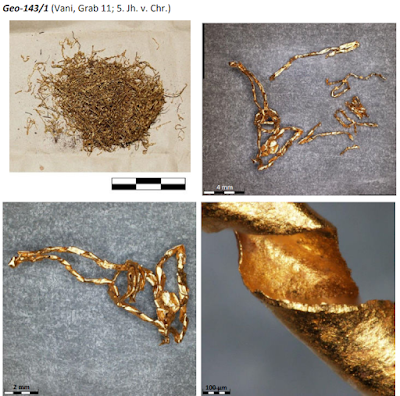 ΧÏÏ
Ïή κλÏÏÏή ÏÏÏιμμÎνη αÏÏ Î»ÏÏÎ¯Î´ÎµÏ ÏÏλλοÏ
ÏÏÏ
ÏοÏ[100]
ΧÏÏ
Ïή κλÏÏÏή ÏÏÏιμμÎνη αÏÏ Î»ÏÏÎ¯Î´ÎµÏ ÏÏλλοÏ
ÏÏÏ
ÏοÏ[100]ΣÎÎÎÎΩΣÎÎΣ
[2]. Numrich et al. 2023, § 4.1.[5]. ÎονιδάÏÎ·Ï 2022.
[100]. Jansen 2019, p. 492. ÎÏ ÏήμαÏα ÏÎ¿Ï ÎÎ»Î»Î·Î½Î¹ÎºÎ¿Ï ÎµÎ½Î´Î¹Î±ÏÎÏονÏÎ¿Ï ÏάÏÎ¿Ï 11 αÏÏ Ïο Vani.
ÎÎÎÎÎÎÎΡÎΦÎÎ
https://www.oeaw.ac.at/fileadmin/Inst..., M., Ch. Schwall, N. Lockhoff, K. Nikolentzos, E. Konstantinidi-Syvridi, M. Cultraro, B. Horejsf, E. Pernicka. 2023. "Portable laser ablation sheds light on Early Bronze Age gold treasures in the old world: New insights from Troy, Poliochni, and related finds," Journal of Archaeological Science 149.
https://web.archive.org/web/202002080...
Jansen, M., 2019. "Geochemie und Archaometallurgie des Goldes der Bronzezeit in Vorderasien" (PhD thesis, Ruhr University Bochum, Bochum).
https://www.sciencedirect.com/science..., M., Glaus, R., Hubert, V., van Willigen, S., Worle-Soares, ¨ M., Convertini, F., Lefranc, P., Nielsen, E., Günther, D., 2017. "Novel sampling techniques for trace element quantification in ancient copper artifacts using laser ablation inductively coupled plasma mass spectrometry," J. Archaeol. Sci. 82, pp. 62â71. https://doi.org/10.1016/j.jas.2017.04.... Good performances (±30%) were also obtained with the pLA + filter sampling approach and subsequent LA-ICPMS analysis. Limits of detection for both approaches were in the low μg/g or sub- μg/g range, making these methods interesting for trace element analysis.
https://thesis.ekt.gr/thesisBookReade..., Î. 2009. "ÎÏ ÎºÎ·Î½Î±Ïκή Îλεία: ÏολιÏιÏÏική και ÏολιÏική εξÎλιξη, εθνολογικά δεδομÎνα και ÏÏοβλήμαÏα" (διδ. ÎÎÎ Î).ÎµÏ ÏαÏιÏÏÎ¯ÎµÏ ÏÏο DAI - Ïελ. 4
ÎονιδάÏηÏ, Î. Î. 2022. The Hittites and the Aegean world, Îθήνα.
December 6, 2022
ALEXANDRIE SOUS TENSION EN 38-41 APRÃS J.-C.
ÎÏιÏθÏÏÏ Î»Î»Î¿[1]ÎεÏÎ±Î¾Ï 38 και 41 μ.Χ., η ÎλεξάνδÏεια αναÏÏαÏÏθηκε αÏÏ Î¼Î¯Î± διεθνική ÏÏγκÏÎ¿Ï Ïη μεÏÎ±Î¾Ï ÏÏν ÎλλήνÏν και ÏÎ·Ï ÎµÎ²ÏαÏÎºÎ®Ï ÎºÎ¿Î¹Î½ÏÏηÏαÏ, Ï ÏÏ Ïα ÎκÏληκÏα μάÏια ÏÎ·Ï Î¡ÏμαÏÎºÎ®Ï ÎµÎ¾Î¿Ï ÏÎ¯Î±Ï ÏÎ¿Ï ÎµÎ¯Ïε καÏαÏÏεί ÎºÏ Ïία ÏÎ·Ï ÎιγÏÏÏÎ¿Ï . Îι ÎβÏαίοι αÏαίÏηÏαν Ïη διαÏήÏηÏη ÏÏν θÏηÏÎºÎµÏ ÏικÏν ÏÎ¿Ï Ï ÏÏονομίÏν και Ïην ÏÏÏÏβαÏη ÏÏην ÏοÏική ιθαγÎνεια, ÎµÎ½Ï Î¿Î¹ ÎÎ»Î»Î·Î½ÎµÏ ÎµÏÎ¹Î¸Ï Î¼Î¿ÏÏαν να διαÏηÏήÏÎ¿Ï Î½ Ïην αÏιÏÏοκÏαÏική κοινÏνία ÏÎ¿Ï Ï ÎºÎ±Î¹ να Ï ÏεÏαÏÏιÏÏοÏν ÏÎ¹Ï Î±Î¾Î¯ÎµÏ ÏÎ¿Ï ÎλληνιÏμοÏ.ÎÏ ÏÏ Ïο βιβλίο ÏÏοÏείνει να ÏÏοÏεγγίÏÎ¿Ï Î¼Îµ Ïην μελÎÏη Î±Ï ÏÏν ÏÏν γεγονÏÏÏν ÏοÏοθεÏÏνÏÎ±Ï Î¾Î±Î½Î¬ Ïην μοÏÏή ÏÎ¿Ï ÎÏιδÏÏÎ¿Ï ÏÏο εÏίκενÏÏο ÏÎ·Ï ÏÏ Î¶Î·ÏήÏεÏÏ. Î ÎÏίδÏÏοÏ, ÎÏ Î¼Î½Î±ÏιάÏÏÎ·Ï ÎλεξανδÏινÏÏ Î´Î·Î¼Î±Î³ÏγÏÏ Î±Î»Î»Î¬ ÏολμηÏÏÏ, είναι ο ÏÏÏÏαγÏνιÏÏÎ®Ï Ïε μιά ÏειÏά ÏαÏÏÏÏν αÏÏ Ïη ÏÏ Î»Î»Î¿Î³Î® Acta Alexandrinorum, η οÏοία Ïον ÏεÏιγÏάÏει να ÏÏ Î½Î±Î½Ïά Î±Ï ÏοκÏάÏοÏεÏ, να ÏÏοκαλεί ÏÎ¿Ï Ï ÎβÏÎ±Î¯Î¿Ï Ï Î±Î½ÏιÏÎ¬Î»Î¿Ï Ï ÏÎ¿Ï , να ÏÏÏαγίζει Î¼Ï ÏÏικÎÏ ÏÏ Î¼Î¼Î±ÏÎ¯ÎµÏ Î¼Îµ Ïον ÎÏαÏÏο ÏÎ·Ï ÎιγÏÏÏÎ¿Ï ÎºÎ±Î¹ να ÏÏÏÎÏεÏαι ενανÏίον ÏÎ¿Ï ÎγÏίÏÏα, βαÏιλÎα ÏÎ·Ï ÎÎ¿Ï Î´Î±Î¯Î±Ï, καθÏÏ ÎºÎ±Î¹ ÏÎ¿Ï Î±Ï ÏοκÏάÏοÏα ÎÎ»Î±Ï Î´Î¯Î¿Ï , Ïον οÏοίο καÏÎληξε να αÏοκαλεί "Ï Î¹Ï ÏÎ·Ï ÎβÏαÏÎºÎ®Ï Î£Î±Î»ÏμηÏ". ÎÏ ÏÏ Ïο βιβλίο αμÏιÏβηÏεί Ïον ÏÏÏο και Ïα ίÏνη ÏÎ¿Ï Î¬ÏηÏε ο ÎÏίδÏÏÎ¿Ï ÏÏην ÏÏλη ÏÎ¿Ï , αλλά εÏίÏÎ·Ï ÏÏοÏείνει να ÏÏοβλημαÏιÏÏοÏμε για Ïην ÏÏÏη ÏÎ¿Ï Acta Alexandrinorum, ÏÏ Î¼ÏεÏιλαμβανομÎνÏν ÏÏν Acta Isidori, ÏÏν ÏÏακÏικÏν ÏÎ·Ï Î´Î¯ÎºÎ·Ï ÏÎ¿Ï ÎÏίδÏÏÎ¿Ï , θα γίνει Ïο αÏÏÎÏÏ Ïο.
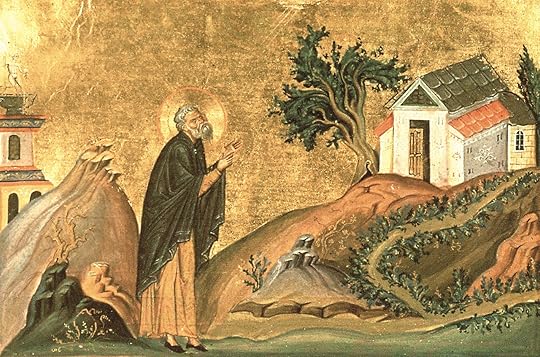 ΠΣεβαÏμιÏÏαÏÎ¿Ï ÎÏίδÏÏÎ¿Ï Î ÎµÎ»Î¿Ï
ÏιÏÏÎ·Ï ÎÏνÏÏανÏινοÏ
ÏÏλεÏÏ. 985 ÎικÏογÏαÏία ÎÎ¹Î½Î¿Î»Î¿Î³Î¯Î±Ï ÎαÏιλείοÏ
Î'[2]. Îιβλιοθήκη ÏοÏ
ÎαÏικανοÏ. ΡÏμη.
ΠΣεβαÏμιÏÏαÏÎ¿Ï ÎÏίδÏÏÎ¿Ï Î ÎµÎ»Î¿Ï
ÏιÏÏÎ·Ï ÎÏνÏÏανÏινοÏ
ÏÏλεÏÏ. 985 ÎικÏογÏαÏία ÎÎ¹Î½Î¿Î»Î¿Î³Î¯Î±Ï ÎαÏιλείοÏ
Î'[2]. Îιβλιοθήκη ÏοÏ
ÎαÏικανοÏ. ΡÏμη.ΠεÏίληÏη[3]Σε Î±Ï ÏÏ Ïο κεÏάλαιο θα εξεÏάÏÏ Ïο ιÏÏοÏÎ¹ÎºÏ Ï ÏÏβαθÏο ÏÎ·Ï Î²Î¹Î²Î»Î¹Î¿Î³ÏαÏÎ¯Î±Ï Acta Alexandrinorum. ÎÏÏικά θα διεÏÎµÏ Î½Î®ÏÏ Ïην ÏÏοÎÎ»ÎµÏ Ïη ÏÎ·Ï Î»Î¿Î³Î¿ÏεÏÎ½Î¯Î±Ï ÎµÎ¾ÎµÏάζονÏÎ±Ï Ïην ÏιθανÏÏηÏα ÎγγÏαÏα, ÏÏÏÏ Ïα ÏÏακÏικά δίκηÏ, να ήÏαν μεÏÎ±Î¾Ï ÏÏν ÏηγÏν ÏÎ¿Ï ÏÏηÏιμοÏοιήθηκαν αÏÏ ÏÎ¿Ï Ï ÏÏ Î³Î³ÏαÏÎµÎ¯Ï ÏηÏ, οι οÏοίοι θα ÏÏοÏÎµÎ¯Î½Ï ÏÏι μÏοÏεί να ήÏαν ÎÎ»Î»Î·Î½ÎµÏ ÏÏεÏÎ²ÎµÏ ÏÎÏ ÏÎ·Ï ÎλεξάνδÏειαÏ. ΣÏη ÏÏ Î½ÎÏεια θα εÏικενÏÏÏÎ¸Ï ÏÏον Î²Î±Î¸Î¼Ï ÏÏον οÏοίο Ïο Acta Alexandrinorum ÏÏÎÏει να θεÏÏείÏαι ανÏιÏÏονηÏική λογοÏεÏνία εξεÏάζονÏÎ±Ï Ïο αναγνÏÏÏÎ¹ÎºÏ ÎºÎ¿Î¹Î½Ï ÏÏν ιÏÏοÏιÏν και ÏÏ Î³ÎºÏίνονÏÎ¬Ï ÏÎµÏ Î¼Îµ γνÏÏÏÎÏ Î»Î¿Î³Î¿ÏεÏνικÎÏ ÎµÎºÏÏάÏÎµÎ¹Ï Î´Î¹Î±ÏÏÎ½Î¯Î±Ï Î±ÏÏ Ïη ΡÏμαÏκή ÎÎ¯Î³Ï ÏÏο, ÏÏÏÏ Î¼Î¯Î¼Î¿Ï Ï ÎºÎ±Î¹ ÏÏηÏμοÏÏ. Îα ÏÏοÏÎµÎ¯Î½Ï ÏÏι Ïο Acta Alexandrinorum μÏοÏεί να μην ήÏαν Îνα Î¼Î¿Î½Î±Î´Î¹ÎºÏ Î±Î»ÎµÎ¾Î±Î½Î´ÏÎ¹Î½Ï ÏαινÏμενο εξεÏάζονÏÎ±Ï ÏαÏÏμοια λογοÏεÏνική ÏαÏαγÏγή αÏÏ Î¬Î»Î»Î± ελληνικά κÎνÏÏα ÏÎ¿Ï ÎµÎ¯Ïαν ÏÏενοÏÏ Î´ÎµÏμοÏÏ Î¼Îµ Ïην ÎλεξάνδÏεια. Îα ÏελειÏÏÏ Î±Î¼ÏιÏβηÏÏνÏÎ±Ï Ïην άÏοÏη ÏÏι Ïα γεγονÏÏα ÏÏην ÎλεξάνδÏεια Ï ÏÏ ÏÎ¿Ï Ï Î£ÎµÎ²ÎµÏÎ¬Î½Î¿Ï Ï Î¿Î´Î®Î³Î·Ïαν Ïε αÏξηÏη ÏÎ·Ï Î´Î·Î¼Î¿ÏικÏÏηÏÎ±Ï ÏÏν ιÏÏοÏιÏν και ÏÏην εÏακÏÎ»Î¿Ï Î¸Î· ÏαÏακμή ÏÎ¿Ï Ï.
ÎÎ Î ÎÎÎΣ ΤÎΣ ÎÎÎÎΤÎΧÎÎÎΣ ACTA ALEXANDRINORUM
Î ÎÎ¿Ï ÏÏÎ¯Î½Î¿Ï ÎºÎ±Î¹ ο ΤεÏÏÏ Î»Î»Î¹Î±Î½ÏÏ, δÏο ÏÏιÏÏιανοί ÏÏ Î³Î³ÏαÏÎµÎ¯Ï ÏÎ¿Ï Î´ÎµÏ ÏÎÏÎ¿Ï Î±Î¹. μ.Χ., αναÏÎÏονÏαι Ïε Îνα ÎγγÏαÏο ÏÎ¿Ï Î¿Î½Î¿Î¼Î¬Î¶ÎµÏαι Acta Pilati, Îνα ανÏίγÏαÏο ÏÏν ÏÏακÏικÏν ÏÎ¿Ï ÏÏ Î½ÎµÏάÏθηÏαν ÏÏην δίκη ÏÎ¿Ï ÎηÏοÏ, Ïο οÏοίο ο ΠιλάÏÎ¿Ï ÏÎÏεÏαι να ÎÏÏειλε ÏÏη ÏÏ Î½ÎÏεια ÏÏον ΤιβÎÏιο ÏÏη ΡÏμη. ΠιÏÏοÏικÏÏηÏα Î±Ï ÏÎ®Ï ÏÎ·Ï Î±ÏηγήÏεÏÏ ÎºÎ±Î¹ η ÏÏαÏξη ενÏÏ ÏÎÏÎ¿Î¹Î¿Ï ÎµÎ³Î³ÏάÏÎ¿Ï ÎµÎ¯Î½Î±Î¹ αμÏίβολη. ΩÏÏÏÏο, Î±Ï Ïοί οι ÏÏ Î³Î³ÏαÏÎµÎ¯Ï Ï ÏÎθεÏαν ÏÏι Ïα ÏÏακÏικά ÏÎ·Ï Î´Î¯ÎºÎ·Ï (acta) θα είÏαν καÏαγÏαÏεί και ÏÏι Îνα ανÏίγÏαÏο ÏÎ¿Ï ÎµÎ³Î³ÏάÏÎ¿Ï Î¸Î± είÏε αÏÎ¿Î¸Î·ÎºÎµÏ Ïεί ανάμεÏα ÏÏα ÎγγÏαÏα ÏÎ¿Ï Î±Ï ÏοκÏάÏοÏα (Ïα Î±Ï ÏοκÏαÏοÏικά ÏÏÏλια) ÏÏην ΡÏμη, ÏÏÎ¿Ï Î¸Î± μÏοÏοÏÏε να ÎÏει ÏÏÏÏβαÏη.
ΣÎÎÎÎΩΣÎÎΣ
[1]. Rodriguez 2022.[2]. Îιβλιοθήκη ÏÎ¿Ï ÎαÏικανοÏ, ΡÏμη, <https://el.wikipedia.org/wiki/%CE%CF%.... Harker 2009.
ÎÎÎÎÎÎÎΡÎΦÎÎ
https://www.amazon.fr/Alexandrie-tens..., C. 2022. Alexandrie sous tension en 38-41 après JC; les Acta Isidori, une vision des vaincus, Amazon.
https://www.cambridge.org/core/books/..., A. 2009. "The Acta Alexandrinorum: The historical background," in Loyalty and Dissidence in Roman Egypt. The Case of the Acta Alexandrinorum, Cambridge Univ. Press, pp. 99-140.
November 28, 2022
Jewish Resistance in Wartime Greece, Bowman 2006/2012: A review
Î ÎÎΤÎΣΤÎΣΠΤΩΠÎÎΡÎÎΩΠΣΤÎÎ ÎÎΤÎΧÎÎÎ ÎÎÎÎÎÎ: ΣΧÎÎÎÎΣÎÎΣ ÎÎÎÎÎÎÎ¥ ΤÎÎ¥ BOWMAN, 2006/2012
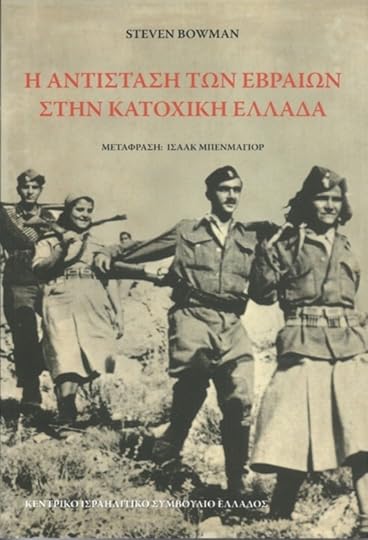 ÎνÏίÏÏαÏη ÏÏν ÎβÏαίÏν ÏÏην καÏοÏική Îλλάδα, Îλληνική ÎκδοÏη ÎÎΣΠSteven Bowman είναι ιÏÏοÏικÏÏ ÎºÎ±Î¹ καθηγηÏÎ®Ï ÎοÏ
δαÏκÏν ΣÏοÏ
δÏν ÏÏο ΠανεÏιÏÏήμιο ÏοÏ
ΣινÏινάÏι ÏÏν ÎÎ Î. ÎεκίνηÏε Ïο εÏεÏ
νηÏÎ¹ÎºÏ ÎÏγο ÏοÏ
με Ïην μελÎÏη ÏÎ·Ï Î¹ÏÏοÏÎ¯Î±Ï ÏÏν ÎβÏαίÏν ÏοÏ
ÎÏ
ζανÏίοÏ
, ÎµÎ½Ï ÎÏει αÏÏοληθεί ιδιαίÏεÏα με Ïην ιÏÏοÏία αÏ
ÏÏν ÏÎ·Ï ÎλλάδαÏ. Î ÏÏÏÏη ÎκδοÏη ÏοÏ
ÏÏολιαζÏμενοÏ
ÎÏγοÏ
, κÏ
κλοÏÏÏηÏε Ïο 2006 με Ïον ÏÏÏÏÏÏÏ
Ïο ÏίÏλο Jewish Resistance in Wartime Greece, μάλιÏÏα με Ïην ÏοÏηγία ÏοÏ
ÎδÏÏμαÏÎ¿Ï ÎάÏÏη, Ïην δε Îλληνική ÎκδοÏη ÏοÏ
2012 εξÎδÏÏε Ïο ÎενÏÏÎ¹ÎºÏ ÎÏÏαηλιÏÎ¹ÎºÏ Î£Ï
μβοÏλιο (ÎÎΣ).
ÎνÏίÏÏαÏη ÏÏν ÎβÏαίÏν ÏÏην καÏοÏική Îλλάδα, Îλληνική ÎκδοÏη ÎÎΣΠSteven Bowman είναι ιÏÏοÏικÏÏ ÎºÎ±Î¹ καθηγηÏÎ®Ï ÎοÏ
δαÏκÏν ΣÏοÏ
δÏν ÏÏο ΠανεÏιÏÏήμιο ÏοÏ
ΣινÏινάÏι ÏÏν ÎÎ Î. ÎεκίνηÏε Ïο εÏεÏ
νηÏÎ¹ÎºÏ ÎÏγο ÏοÏ
με Ïην μελÎÏη ÏÎ·Ï Î¹ÏÏοÏÎ¯Î±Ï ÏÏν ÎβÏαίÏν ÏοÏ
ÎÏ
ζανÏίοÏ
, ÎµÎ½Ï ÎÏει αÏÏοληθεί ιδιαίÏεÏα με Ïην ιÏÏοÏία αÏ
ÏÏν ÏÎ·Ï ÎλλάδαÏ. Î ÏÏÏÏη ÎκδοÏη ÏοÏ
ÏÏολιαζÏμενοÏ
ÎÏγοÏ
, κÏ
κλοÏÏÏηÏε Ïο 2006 με Ïον ÏÏÏÏÏÏÏ
Ïο ÏίÏλο Jewish Resistance in Wartime Greece, μάλιÏÏα με Ïην ÏοÏηγία ÏοÏ
ÎδÏÏμαÏÎ¿Ï ÎάÏÏη, Ïην δε Îλληνική ÎκδοÏη ÏοÏ
2012 εξÎδÏÏε Ïο ÎενÏÏÎ¹ÎºÏ ÎÏÏαηλιÏÎ¹ÎºÏ Î£Ï
μβοÏλιο (ÎÎΣ).ΣÏο ÏαÏÏν ÏημείÏμα ÏκοÏεÏÎ¿Ï Î¼Îµ να αναÏεÏθοÏμε Ïε αδÏναÏα Ïημεία ή και ανακÏÎ¯Î²ÎµÎ¹ÎµÏ ÏÎ¿Ï ÎµÎ´Ï ÏÏολιαζÏÎ¼ÎµÎ½Î¿Ï Î²Î¹Î²Î»Î¯Î¿Ï ,[1] εÏιÏειÏÏνÏÎ±Ï Î½Î± ÎµÎ¾Î±Î³Î¬Î³Î¿Ï Î¼Îµ μιάν αιÏιολογία / εÏμηνεία για Î±Ï Ïήν Ïην ÏÏοÏÎγγιÏη και ÏÎ¹Ï ÏÏεÏικÎÏ ÏαÏαμοÏÏÏÏÎµÎ¹Ï ..
Î ÏÏÏογÏαÏία ÏÏο εξÏÏÏ Î»Î»Î¿ ÏÎ¿Ï Î²Î¹Î²Î»Î¯Î¿Ï ÏεÏιÎÏγÏÏ ÏαίνεÏαι να μήν ÏÏ Î½Î´ÎεÏαι με Ïο θÎμα ÏÎ¿Ï ÏίÏÎ»Î¿Ï ÏÎ¿Ï Î²Î¹Î²Î»Î¯Î¿Ï , Î¼Î¹Î¬Ï ÎºÎ±Î¹ αÏοÏελεί ÏÏιγμιÏÏÏ Ïο αÏÏ Ïην ÏεÏίοδο μεÏά Ïην αÏÎµÎ»ÎµÏ Î¸ÎÏÏÏη ÏÏν ÎθηνÏν και Ïην Ï ÏοÏÏολή ÏÎ·Ï ÎεÏÎ¼Î±Î½Î¹ÎºÎ®Ï ÏÎ·Î¼Î±Î¯Î±Ï Î±ÏÏ Ïον ιεÏÏ Î²ÏάÏο ÏÎ·Ï ÎκÏοÏÏλεÏÏ.[2] ÎνδεÏομÎνÏÏ ÏμÏÏ Î±Ï ÏÏ Ïο εξÏÏÏ Î»Î»Î¿ να Ï ÏαινίÏÏεÏαι ή και να ÏαÏαÏÎμÏει, ÎµÏ Î¸ÎÏÏ Î® ÏημειολογικÏÏ, Ïε εÏÎ¼Î·Î½ÎµÎ¯ÎµÏ ÎºÎ±Î¹ αÏÏÏÎµÎ¹Ï Ï ÏοβÏÏÎºÎ¿Ï ÏÎµÏ ÎºÎ±Î¹ μη εκÏεÏÏαÏμÎÎ½ÎµÏ ÎµÏακÏιβÏÏ ÏÏο ÏÏολιαζÏμενο ÎÏγο. ÎÏÏι ίÏÏÏ Î· αναÏοÏά Ïε 'ανÏίÏÏαÏη ÏÏην καÏοÏική Îλλάδα' να αναÏÎÏεÏαι Ïε μιάν Îλλάδα ÏÎ¿Ï - καÏά Ïον ÏÏ Î³Î³ÏαÏÎα - ÏαÏÎμενε 'καÏοÏική' και μεÏά αÏÏ Ïην αÏοÏÏÏηÏη ÏÎ¿Ï ÎεÏÎ¼Î±Î½Î¿Ï ÎºÎ±ÏακÏηÏÎ¿Ï .. ίÏÏÏ, καÏά δεÏÏεÏον, να μήν αναÏÎÏεÏαι Ïε ανÏίÏÏαÏη αÏοκλειÏÏικά ενανÏίον ÏÏν ÎεÏμανÏν καÏακÏηÏÏν αλλά, ίÏÏÏ, Ïε κάÏοια με ÏαξικÎÏ Î® και εθνοÏικÎÏ - θÏηÏÎºÎµÏ ÏικÎÏ ÏÏ Î½Î¹ÏÏÏÏεÏ! ΠεÏί Î±Ï ÏÏν καθÏÏ ÎºÎ±Î¹ για ÏÎ¹Ï ÎµÏιδιÏÎ¾ÎµÎ¹Ï (agenda) κάθε ÏÎ»ÎµÏ ÏÎ¬Ï ÎµÎ½ ÏÏει ÏÎ·Ï Î±ÏοÏÏÏήÏεÏÏ ÏÏν ÎεÏμανÏν ελÏίζεÏαι να διαÏÏÏιÏθοÏμε ÏÏα εÏÏμενα... ÎÏ Î¸Ï Î¼Î®ÏÎ¿Ï Î¼Îµ εδÏ, εν είδει ÏÏογεÏÏεÏÏ, ÏÏι η ÎβÏαÏκή κοινÏÏηÏα εθεÏÏηÏε Ïην ÎνÏαξη ÏÎ·Ï ÎεÏÏÎ±Î»Î¿Î½Î¯ÎºÎ·Ï ÏÏον ÎÎ»Î»Î·Î½Î¹ÎºÏ ÎºÎ¿ÏÎ¼Ï ÏÏ 'ξÎνη καÏοÏή',[3] θÎÏη η οÏοία Î±ÎºÎ¿Î»Î¿Ï Î¸Î®Î¸Î·ÎºÎµ και αÏÏ Ïο ÎÎÎ ÏÎ¿Ï ÎµÏιÏήμÏÏ ÎµÏγάÏθηκε για Ïην αÏÏÏÏαÏη ÏÏν βÏÏειÏν ÎλληνικÏν εδαÏÏν αÏÏ Ïην εθνική εÏικÏάÏεια!
ÎÎ»Î»Î·Î½ÎµÏ & ÎβÏαίοι ή ÎÎ»Î»Î·Î½ÎµÏ ÎβÏαίοι ..
ΣÏο ÏÏολιαζÏμενο ÎÏγο η αναÏοÏά Ïε ÎβÏÎ±Î¯Î¿Ï Ï Î³Î¯Î½ÎµÏαι Ïε ανÏιÏαÏαβολή με Î±Ï Ïήν ÏÏÎ¿Ï ÏÎ¿Ï Ï ÎλληνεÏ, αÏήνονÏÎ±Ï Î½Î± διαÏανεί μία αναÏοÏαÏιÏÏικÏÏηÏα ÏÏ ÏÏÎ¿Ï Ïο άν οι ÎβÏαίοι ÏÎ¿Ï ÎÎ»Î»Î±Î´Î¹ÎºÎ¿Ï ÏÏÏÎ¿Ï Î¸Î± ÎÏÏεÏε να ανÏιμεÏÏÏίζονÏαι ÏÏ ÎβÏαίοι αÏλÏÏ Î® ÏÏ ÎÎ»Î»Î·Î½ÎµÏ ÎβÏαίοι.[4] ΣημειÏνεÏαι εν ÏÏοκειμÎÎ½Ï ÏÏι η ÏÏ Î³ÎºÎµÎºÏιμÎνη κοινÏÏηÏα μÎÏÏι ÏεÏίÏÎ¿Ï Ïον δεÏÏεÏο ÏαγκÏÏμιο ÏÏλεμο αÏνοÏνÏαν να ενÏαÏθεί ÏÏην Îλληνική κοινÏνία, διαÏηÏÏνÏÎ±Ï Ïο γλÏÏÏÎ¹ÎºÏ ÏÏÎ³Î±Î½Ï ÏÎ·Ï ÎºÎ±Î¹ ÏÏ Ïνά αγνοÏνÏÎ±Ï Ïην Îλληνική γλÏÏÏα, Ïε ÏολλÎÏ ÏεÏιÏÏÏÏÎµÎ¹Ï ÎµÏÏγÏανε μοÏÏÏÏεÏÏ Ïε ιδιαίÏεÏα ÏÏολεία, ÎµÎ½Ï ÎºÎ±Î¹ οι ÎβÏαÏκÎÏ ÏÏ Î½Î¿Î¹ÎºÎ¯ÎµÏ ÏαÏÎμειναν διαÏÏÏιÏμÎνεÏ, με ÏαÏακÏηÏιÏÏÎ¹ÎºÏ Ïο ÏαÏάδειγμα Î±Ï ÏÎ®Ï ÎµÎ½ÏÏÏ ÏÎ¿Ï ÎºÎ¬ÏÏÏÎ¿Ï ÏÏν ÎÏαννίνÏν.. ÎξιοÏημείÏÏη είναι ÏÏεÏική αναÏοÏά ÏÎ¿Ï ÏÏ Î³Î³ÏαÏÎα ÏÏμÏÏνα με Ïην οÏοία: "ΣÏÎ¹Ï ÏαÏαμονÎÏ, ÏμÏÏ, ÏÎ¿Ï ÎΠΠαγκοÏÎ¼Î¯Î¿Ï Î Î¿Î»ÎÎ¼Î¿Ï Ï ÏήÏÏε ÏÏη ÎεÏÏαλονίκη μια ÏÏμαλÎα και Î´Ï Î½Î±Î¼Î¹ÎºÎ® εβÏαÏκή νεολαία, ολοÏαÏÏÏ ÎµÎ¾ÎµÎ»Î»Î·Î½Î¹Î¶Ïμενη ÏÏÏεÏα αÏÏ Î¼Î¹Î± εικοÏαεÏία ÎκθεÏÎ·Ï ÏÏον ÎµÎ»Î»Î·Î½Î¹ÎºÏ ÎµÎ¸Î½Î¹ÎºÎ¹ÏÎ¼Ï ÎºÎ±Î¹ ÏÎ¹Ï ÏιÎÏÎµÎ¹Ï ÏÎ¿Ï ÎºÎ±Î¸ÎµÏÏÏÏÎ¿Ï ÏÎ¿Ï ÎÏάννη ÎεÏαξά για Ïην εκμάθηÏη ÏÎ·Ï ÎµÎ¸Î½Î¹ÎºÎ®Ï Î³Î»ÏÏÏαÏ."[5] ÎναÏοÏικά με Ïην ÏÎ±Ï ÏÏÏηÏα ÏÏν ÎβÏαίÏν ÏÎ¿Ï ÎÎ»Î»Î±Î´Î¹ÎºÎ¿Ï ÏÏÏÎ¿Ï ÏημειÏνονÏαι εÏιγÏαμμαÏικά Ïα ακÏÎ»Î¿Ï Î¸Î±: (α) Îαθ' Ïλην Ïην διάÏκεια ÏÎ·Ï ÎθÏÎ¼Î±Î½Î¹ÎºÎ®Ï ÎºÏ ÏιαÏÏÎ¯Î±Ï Î¿Î¹ ÎβÏαίοι διÎθεÏαν ÏÏονÏμια και εθεÏÏοÏνÏο ÏÏ Î½ÏεÏαγμÎνοι με Ïον ÎθÏÎ¼Î±Î½Î¹ÎºÏ Î¶Ï Î³Ï,[6] ÏαÏακÏηÏιÏÏική δε είναι και η αναÏοÏά ÏÎ¿Ï Î¯Î´Î¹Î¿Ï ÏÎ¿Ï ÏÏ Î³Î³ÏαÏÎα ÏÏμÏÏνα με Ïην οÏοία "Îι ΤοÏÏκοι ÎκαÏαν Ïη ΣμÏÏνη και ÏήÏαν εκδίκηÏη για ÏÎ¹Ï ÎµÎ»Î»Î·Î½Î¹ÎºÎÏ ÏαÏαÏÏ ÏÎ¯ÎµÏ Î¼Îµ ÏÏαγÎÏ,"[7] ÏÏÎ¿Ï Î· καÏαÏÏÏοÏή ÏÎ·Ï Î£Î¼ÏÏνηÏ, άν ÏÏι και η γενοκÏονία ÏÎ¿Ï ÎικÏαÏιαÏÎ¹ÎºÎ¿Ï ÎλληνιÏÎ¼Î¿Ï ÎµÎ½ γÎνει, εÏμηνεÏονÏαι και 'δικαιολογοÏνÏαι' ÏÏ Î±Î½ÏίδÏαÏη ÏÏÎ¹Ï 'ÏαÏαÏÏ ÏίεÏ' ÏÏν ÎλλήνÏν,(β) ÎναÏÎÏεÏαι ÏÏι Ïο 1912 η ηγεÏία ÏÎ·Ï ÎÎ»Î¹Î¬Î½Ï ÎºÎ±Î¹ ÏÎ·Ï ÎβÏαÏÎºÎ®Ï ÏαÏÎ¿Î¹ÎºÎ¯Î±Ï Î¶Î®ÏηÏαν αÏÏ Ïον ÏÎ¿Ï Î»Ïάνο Ïην ÎγκÏιÏη για Ïην ίδÏÏ Ïη εθελονÏÎ¹ÎºÎ¿Ï ÏÏμαÏÎ¿Ï ÎµÎ¾ ÎβÏαίÏν ÎεÏÏÎ±Î»Î¿Î½Î¯ÎºÎ·Ï ÏÏοκειμÎÎ½Î¿Ï Î±Ï ÏÏ Î½Î± ÏολεμήÏει καÏά ÏÎ¿Ï ÎµÏεÏÏομÎÎ½Î¿Ï ÎÎ»Î»Î·Î½Î¹ÎºÎ¿Ï Î£ÏÏαÏοÏ, ÎµÎ½Ï Î³Î¹Î± Ïον ίδιο ÏκοÏÏ ÏÏοÏÎÏεÏαν 650 000 ÏÏÏ ÏÎÏ Î»Î¯ÏεÏ![8] ÎαÏά Ïα ÏÎλη Î±Ï ÏÎ®Ï ÏÎ·Ï ÎθÏÎ¼Î±Î½Î¹ÎºÎ®Ï ÎºÏ ÏιαÏÏÎ¯Î±Ï ÏÏην ÎεÏÏαλονίκη οι εκεί ΣεÏαÏαδίÏÎµÏ ÎβÏαίοι ανÏιÏάÏθηκαν ÏÏην ÎνÏαξη ÏÎ·Ï Î¼ÎµÎ³Î±Î»Î¿Ï ÏÏλεÏÏ ÏÏον ÎÎ»Î»Î·Î½Î¹ÎºÏ ÎºÎ¿ÏμÏ, Ï ÏεÏÏήÏιξαν δε Ïην εκεί Î´Î·Î¼Î¹Î¿Ï Ïγία ÎβÏαÏÎºÎ¿Ï ÎºÏαÏÎ¹Î´Î¯Î¿Ï !,[9] ÏÎ¿Ï Î¿ÏÎ¿Î¯Î¿Ï Î¼Î¬Î»Î¹ÏÏα Ïην ÏÏαÏξη - αÏÏάλεια θα ÎµÎ³Î³Ï Î¬Ïο,μεÏÎ±Î¾Ï ÏÏν άλλÏν, και η Î¤Î¿Ï Ïκία![10] ÎλλÏÏÏε οÏθÏÏ ÎºÎ±Î¹ η Malho αναÏεÏÏμενη ÏÏÎ¿Ï Ï ÎβÏÎ±Î¯Î¿Ï Ï (Jews) ÏÎ·Ï ÎεÏÏÎ±Î»Î¿Î½Î¯ÎºÎ·Ï ÏÏίν Ïην αÏÎµÎ»ÎµÏ Î¸ÎÏÏÏη ÏÎ·Ï ÏÏλεÏÏ Î±Î½Î±ÏÎÏεÏαι Ïε 'εθνική' αÏÏÏνιÏη Î±Ï ÏÏν, με Ïην ÎµÏ ÎºÎ±Î¹Ïία και ÏÎ·Ï ÎµÏαÏÎ®Ï ÏÎ¿Ï Ï Î¼Îµ Ïην ÎενÏÏική ΣιÏνιÏÏική ÎÏγάνÏÏη,[11](γ) Îι ίδιοι ανÏιÏάÏθηκαν και ÏÏην αÏÎµÎ»ÎµÏ Î¸ÎÏÏÏη ÏÎ·Ï ÎÏήÏηÏ, ανÏιÏιθÎμενοι εν γÎνει ÏÏÎ¹Ï ÎλληνικÎÏ ÎµÏιδιÏξειÏ![12]ÎλλÏÏÏε εν ÏÏÎÏει με Î±Ï Ïήν Ïην ÏÎ±Ï ÏÏÏηÏα ÏÏν ÎβÏαίÏν ÏÎ¿Ï ÎÎ»Î»Î±Î´Î¹ÎºÎ¿Ï ÏÏÏÎ¿Ï ÏαÏακÏηÏιÏÏική είναι και η εÏιÏήμανÏη ÏÎ¿Ï Î¯Î´Î¹Î¿Ï ÏÎ¿Ï ÏÏ Î³Î³ÏαÏÎα ÏÎ¿Ï Î±ÏοÏολμά να ÏαÏακÏηÏίÏει ÏÏ "εÏιÏÏ Ïία", ενÏÏÏ ÎµÎ¹ÏαγÏγικÏν, Ïην αÏÎµÎ»ÎµÏ Î¸ÎÏÏÏη ÏÎ¿Ï Î²ÏÏÎµÎ¹Î¿Ï ÏήμαÏÎ¿Ï ÏÎ·Ï ÏÏÏαÏ! Îίναι λοιÏÏν ÏÏοÏανÎÏ ÏÏι ο καθηγηÏÎ®Ï Î±Î½Î®ÎºÎµÎ¹ ÏÏην ÏÎ»ÎµÏ Ïά εκείνη ÏÎ¿Ï ÎºÎ±Î¹ ÏήμεÏα ÏÎ¬Î½Ï Î±ÏÏ Îναν αιÏνα αÏγÏÏεÏα, εμμÎÏÏÏ Î±Î¼ÏιÏβηÏεί Ïα ÏÏνοÏα ÏÎ¿Ï ÎÎ»Î»Î·Î½Î¹ÎºÎ¿Ï ÎºÏάÏÎ¿Ï Ï ÏÏÎ¿Ï Î´Î¹Î±Î²Î¹Î¿Ïν και άÏομα ÏÎ·Ï ÎºÎ¿Î¹Î½ÏÏηÏÎ¬Ï ÏÎ¿Ï ![13]
Î ÏÏάÏη ÏÎ¿Ï ÎÎÎ ÏÏην ÎÏαλική ειÏβολή!
ÎνακÏιβÏÏ Î±Î½Î±ÏÎÏεÏαι ÏÏο βιβλίο ÏÏι Ïο ÎÎÎ Ï ÏεÏÏήÏιξε Ïην Îλλάδα ενανÏίον ÏÏν ÎÏαλÏν Ïο 1940,[14] δεδομÎÎ½Î¿Ï ÏÏι, μεÏά αÏÏ ÏαλινÏδίεÏ, Ïο κÏμμα Î±Ï ÏÏ, ÏÏ Î½ÏονιζÏμενο με Ïην ÎΣΣΠÏÏμμαÏο ακÏμη ÏÎ·Ï Î½Î±Î¶Î¹ÏÏÎ¹ÎºÎ®Ï ÎεÏÎ¼Î±Î½Î¯Î±Ï Î²Î¬Ïει ÏÎ¿Ï ÏÏ Î¼ÏÏÎ½Î¿Ï Î¡Î¯Î¼ÏενÏÏÎ¿Ï - ÎολÏÏÏÏ, Ï ÏοÏÏήÏιξε Ïην ÏÏάÏη ÎνανÏι ÏÎ·Ï ÎεÏÎ±Î¾Î¹ÎºÎ®Ï ÎºÏ Î²ÎµÏνήÏεÏÏ ÎºÎ±Î¹ Ïην αναÏÏοÏή ÏηÏ!
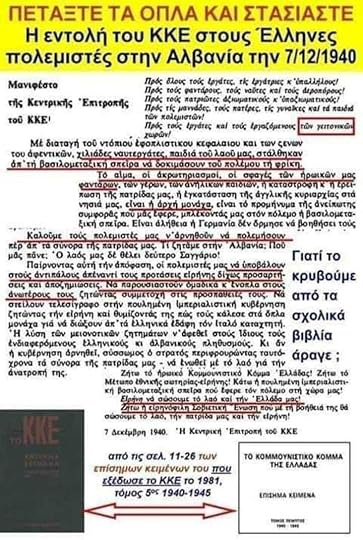 ÎανιÏÎÏÏο ÏÎ·Ï ÎÎ ÏοÏ
ÎÎÎ
ÎανιÏÎÏÏο ÏÎ·Ï ÎÎ ÏοÏ
ÎÎÎ
Î ÏÏαγή ÏÎ¿Ï ÎÎ¹Î»ÎºÎ¯Ï Î±ÏÏ Ïον ÎÎÎΣ Ï ÏÏ Ïον ÎÏαάκ ÎÏÏÎ
ΣÏμÏÏνα με Ïον Bowman:[15]
"Τον ÎκÏÏβÏιο ÏοÏ
1944, η Ï
ÏοÏÏÏηÏη ÏÏν ÎεÏμανÏν αÏÏ Ïην Îλλάδα είÏε ήδη ÏÏοÏÏÏήÏει ÏημανÏικά. Îν και είÏαν διαÏÏαγμαÏεÏ
θεί μια ÏÏ
μÏÏνία με ÏοÏ
Ï ÎÏεÏανοÏÏ Î½Î± ÏαÏαδÏÏοÏ
ν Ïην Îθήνα και Ïην ΠελοÏÏννηÏο ÏÏÏÎ¯Ï Î¼Î¬Ïη, δεν Ï
ÏήÏÏε ανÏίÏÏοιÏη ÏÏ
μÏÏνία ÏÏεÏικά με Ïον ÎοÏÏά."
"Î ÎίÏÏÎ¿Ï ÏÏ Î½ÎÏιÏε να Ïολεμάει μεÏά αÏâ Î±Ï Ïήν Ïην ημεÏομηνία. ÎÏ Î½Î·Î³ÏνÏÎ±Ï ÏÎ¿Ï Ï ÎεÏμανοÏÏ ÏÏα βÏÏεια, ο ÎÎÎΣ ÏÎ¿Ï Ï ÎÏθαÏε ÏÏο ÎÎ¹Î»ÎºÎ¯Ï ÏÏÎ¹Ï 4 ÎοεμβÏÎ¯Î¿Ï 1944, ÏεÏίÏÎ¿Ï 40 ÏιλιÏμεÏÏα βÏÏεια αÏÏ Ïη ÎεÏÏαλονίκη. Î ÎÎÎΣ διÎÏÏαξε ÏÏαγή ÏÏÎ¹Ï Î³ÎµÏμανικÎÏ Î´Ï Î½Î¬Î¼ÎµÎ¹Ï ÎºÎ±Î¹ ÏÏÎ¿Ï Ï ÏÏ Î½ÎµÏγάÏÎµÏ ÏÎ¿Ï Ï ÏÎ¿Ï Î´Î¹ÎÏÎµÏ Î³Î±Î½ μαζί ÏÎ¿Ï Ï. Î ÎίÏÏÎ¿Ï Î´Î¹Î·Î³ÎµÎ¯Ïαι Îνα ÏÏαγμαÏÎ¹ÎºÏ ÎÎÎÎÎÎÎÎ, Î´Ï ÏάÏεÏÏο, αλλά ÎÎÎÎÎÎÎÎ."
Îίδαμε λοιÏÏν ÏÏι ÏÏι μÏνον ο ÎÏÏΠδεν ÎºÏ Î½Î®Î³Î±Î³Îµ ÏÎ¿Ï Ï ÎεÏμανοÏÏ, αÏÎ¿Ï ÎµÎ¯Ïε ήδη Ï ÏογÏάÏει Ïην ÏÏ Î¼ÏÏνία Î¼Î±Î¶Ï ÏÎ¿Ï Ï Ïην 01.09.1944, οÏÏε 'ÏÎ¿Ï Ï ÎÏÏαÏε ÏÏο ÎιλκίÏ' ÎµÎ½Ï Î· εÏίθεÏή ÏÎ¿Ï ÏÎ·Ï 04.11.1945 είÏε ÏÏ ÏÏÏÏο ÏÎ¹Ï Î Î¿Î½ÏιακÎÏ ÎºÎ±Î¹ Î¬Î»Î»ÎµÏ ÎνοÏÎ»ÎµÏ Î¿Î¼Î¬Î´ÎµÏ ÏÎ¿Ï ÎµÎ¯Ïαν καÏαÏÏγει ÏÏην ÏÏλη![17] ΣÏην ÏÏαγμαÏικÏÏηÏα ο ÎÏαάκ ÎÏÏΠεÏικεÏÎ±Î»Î®Ï Î´Ï Î½Î¬Î¼ÎµÏÏ ÎÎÎΣ μεÏά Ïην αÏοÏÏÏηÏη ÏÏν ÎεÏμανÏν εÏεÏÎθη Ïε εθνικιÏÏικÎÏ Î´Ï Î½Î¬Î¼ÎµÎ¹Ï ÏÏο ÎÎ¹Î»ÎºÎ¯Ï ÎµÎºÏελÏνÏÎ±Ï 1500 (wiki, ή μήÏÏÏ 7400 !!??) και αιÏμαλÏÏίζονÏÎ±Ï 2150 ÏÎ·Ï Î¬Î»Î»Î·Ï ÏÎ»ÎµÏ ÏάÏ!!!
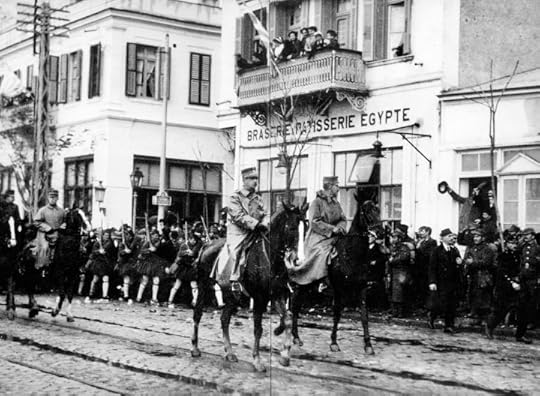 26/10/1912: ΠαÏελεÏ
θÎÏÏÏη ÏÎ·Ï ÎεÏÏÎ±Î»Î¿Î½Î¯ÎºÎ·Ï Î±ÏÏ Ïον ÎÎ»Î»Î·Î½Î¹ÎºÏ Î£ÏÏαÏÏ[18]
26/10/1912: ΠαÏελεÏ
θÎÏÏÏη ÏÎ·Ï ÎεÏÏÎ±Î»Î¿Î½Î¯ÎºÎ·Ï Î±ÏÏ Ïον ÎÎ»Î»Î·Î½Î¹ÎºÏ Î£ÏÏαÏÏ[18]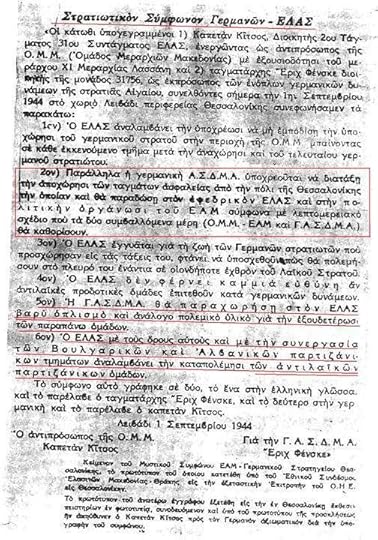 ΣÏÏαÏιÏÏÎ¹ÎºÏ ÏÏμÏÏνο ÎεÏμανÏν - ÎÎÎΣ[19]
ΣÏÏαÏιÏÏÎ¹ÎºÏ ÏÏμÏÏνο ÎεÏμανÏν - ÎÎÎΣ[19] ΠιδιαιÏεÏÏÏηÏα ÏÎ·Ï ÎεÏÏαλονίκηÏ
ΣÏο ÏÏ Î¶Î·ÏοÏμενο ÏÏνημα ÏÎ¿Ï ÎμεÏικανο-εβÏÎ±Î¯Î¿Ï ÎºÎ±Î¸Î·Î³Î·ÏοÏ, ÏÏÏÏ ÎºÎ±Î¹ Ïε άλλα ÏÏίÏÏν εξ ÎμεÏÎ¹ÎºÎ®Ï ÏαÏαγÏνÏÏν,[20] διακÏίνεÏαι μιά ιδιαίÏεÏη ÎµÏ Î±Î¹ÏθηÏία αÏÎνανÏι ÏÏην ÎεÏÏαλονίκη ÎµÎ½Ï ÎµÎºÏÏάζεÏαι και ανÏίθεÏη γιά Ïην ÎνÏαξή ÏÎ·Ï ÏÏον ÎµÎ¸Î½Î¹ÎºÏ ÎºÎ¿ÏμÏ. ΤονίζεÏαι η ÏÎ»Î·Î¸Ï Ïμιακή Ï ÏεÏοÏή εκεί ÏÏν ÎβÏαίÏν ÎÏÏ ÏÎ¹Ï Î±ÏÏÎÏ ÏÎ¿Ï 20Î¿Ï Î±Î¹., ÏÏÏÎ¯Ï Î²ÎµÎ²Î±Î¯ÏÏ Î½Î± λαμβάνεÏαι Ï ÏÏÏιν Ïο αγÏοÏÎ¹ÎºÏ ÏÏοιÏείο ÏÎ·Ï ÎµÏ ÏÏÏεÏÎ·Ï ÏεÏιοÏήÏ![21] Îε βάÏη Î±Ï Ïήν Ïην ÏÏοκÏÏαÏα αÏÏ ÏÏÏÏÎ¿Î²Î¿Ï Î»Î¯ÎµÏ ÏÎ¿Ï ÏÎ¿Ï Î»ÏÎ¬Î½Î¿Ï ÏÎ»Î·Î¸Ï Ïμιακή καÏάÏÏαÏη διακηÏÏÏÏεÏαι ÏÏι η ÏÏλη 'δεν [θα] ήÏαν οÏÏε ελληνική, οÏÏε Î²Î¿Ï Î»Î³Î±Ïική οÏÏε ÏÎ¿Ï Ïκική, αλλά εβÏαÏκή'.[22] Îα Ï ÏÎµÎ½Î¸Ï Î¼Î¯ÏÎ¿Ï Î¼Îµ ÎµÎ´Ï ÏÏι η ίδÏÏ Ïη ÏÎ¿Ï ÎºÏάÏÎ¿Ï Ï ÏÎ¿Ï ÎÏÏαήλ ÏÏην ΠαλαιÏÏίνη ÏÏηÏίÏθηκε Ïε 'ιÏÏοÏικά δικαιÏμαÏα', αÏÎ¿Ï Ïο εβÏαÏÎºÏ ÏÏοιÏείο αÏÎ¿Ï Ïίαζε ÏανÏελÏÏ ÏÏÏε, ÎµÎ½Ï ÏÏην ÏεÏίÏÏÏÏη ÏÎ·Ï ÎεÏÏÎ±Î»Î¿Î½Î¯ÎºÎ·Ï ÏÎÏοιο δικαίÏμα βεβαίÏÏ Î´ÎµÎ½ αναγνÏÏίζεÏαι ÏÏÎ¿Ï Ï ÎλληνεÏ!
ÎÏιÏειÏÏνÏÎ±Ï Î½Î± ανακαλÏÏÎ¿Ï Î¼Îµ Ïην 'κÏκκινη κλÏÏÏή' ÏÎ¿Ï ÏαίνεÏαι να διαÏεÏνά Ïα γÏαÏÏμενα και ÏÎµÏ Î´ÏÏ Ï ÏοÏÏηÏιζÏμενα ÏÏο ÏÏολιαζÏμενο βιβλίο, ÏÏ Î½Î´ÎονÏÎ¬Ï Ïα με Ïην ÏολιÏική γÏαμμή και Ïην ÏÏακÏική ÏÎ¿Ï ÎÎΠαλλά και με ÏÏÏÏÏαÏα γεγονÏÏα θα ÏημειÏναμε - ανακεÏαλαιÏναμε:
(α) η αÏÎµÎ»ÎµÏ Î¸ÎÏÏÏη ÏÎ·Ï ÎεÏÏÎ±Î»Î¿Î½Î¯ÎºÎ·Ï Ïο 1912 ÏÏα ÏλαίÏια ÏÏν αÏÎµÎ»ÎµÏ Î¸ÎµÏÏÏικÏν αγÏνÏν ÏÎ¿Ï 1912-13 Îγινε Î´Ï ÏμενÏÏ Î´ÎµÎºÏή αÏÏ Î¹ÏÏÏ Ïή μεÏίδα ÎμεÏÎ¹ÎºÎ±Î½Î¹ÎºÎ®Ï Ï ÏηκοÏÏηÏÎ¿Ï ÎµÏιÏÏημÏνÏν, (β) η αÏÎµÎ»ÎµÏ Î¸ÎÏÏÏη ανÏιμεÏÏÏίÏÏηκε ομοίÏÏ Î±ÏνηÏικά αÏÏ Ïην ÎβÏαÏκή κοινÏÏηÏα η οÏοία Ï ÏεÏÏήÏιξε Ïην Î´Î·Î¼Î¹Î¿Ï Ïγία 'ανεξάÏÏηÏÎ·Ï - διεθνοÏÏ ÏÏλεÏÏ' εκεί ελεγÏÏÎ¼ÎµÎ½Î·Ï Î±ÏÏ ÏÎ¿Ï Ï Î¯Î´Î¹Î¿Ï Ï, ÏÏÏÏ ÏοÏÏο δε αÏÎµÏ Î¸Ïνθηκαν και ÏÏον ΠαγκÏÏμιο ΣιÏνιÏÏÎ¹ÎºÏ ÎÏγανιÏμÏ!, (γ) η ίδια Î±Ï Ïή κοινÏÏηÏα ανÏιÏάÏθηκε ÏÏην αÏÎµÎ»ÎµÏ Î¸ÎÏÏÏη ÏÎ·Ï ÏÏλεÏÏ Î±ÏÏ ÏÎ¿Ï Ï ÎÎ»Î»Î·Î½ÎµÏ ÏÏ Î½ÏαÏθείÏα ÏÏεÏÏÏÏ ÎºÎ±Î¹ εμÏÏάκÏÏÏ Î¼Îµ Ïον Î£Î¿Ï Î»Ïάνο, ÏÏÏÏ Î¬Î»Î»ÏÏÏε ÎÏÏαÏÏε καθ' Ïλην Ïην διάÏκεια ÏÎ¿Ï ÎθÏÎ¼Î±Î½Î¹ÎºÎ¿Ï Î¶Ï Î³Î¿Ï ÏÏην ÏÏÏα! (δ) η ίδια Î±Ï Ïή κοινÏÏηÏα, εγκαÏαÏÏαθείÏα ÏÏην ÏÏλη με άδεια ÏÎ¿Ï Î£Î¿Ï Î»ÏÎ¬Î½Î¿Ï , ανÏιÏάÏθηκε και ήλθε Ïε ÏÏγκÏÎ¿Ï Ïη με Ïο εκεί εγκαÏαÏÏαθÎν ÎÎ»Î»Î·Î½Î¹ÎºÏ Î Î¿Î½ÏÎ¹Î±ÎºÏ ÏÏοιÏείο, ÏÎ¿Ï ÎµÎ½Î¯ÏÏÏ Îµ Ïην Îλληνική ÏÏ Î¼Î¼ÎµÏοÏή ÏÏον εκεί ÏÎ»Î·Î¸Ï ÏμÏ,[23] (ε) η ίδια κοινÏÏηÏα είÏε μÎÏÏι Ïο ÏÎÎ»Î¿Ï ÏÎ¿Ï Î²' ΠΠαÏνηθεί να μάθει και να Ï Î¹Î¿Î¸ÎµÏήÏει Ïην Îλληνική γλÏÏÏα .., (ζ) ΣÏμÏÏνα με αÏÏÏÏαÏμα ÏÎ¿Ï Î±Î½Î±ÏÏÎ¹ÎºÎ¿Ï Georgakas:[24]Î ÏοÎÎºÏ Ïαν ενÏάÏÎµÎ¹Ï Î¼ÎµÏÎ±Î¾Ï ÏÏν ÏÏοÏÏÏγÏν και ÏÏν ÎβÏαίÏν και Î´Î·Î¼Î¹Î¿Ï Ïγήθηκε μια ανÏιÏημιÏική οÏγάνÏÏη ÏεÏίÏÎ¿Ï 3.000 αÏÏμÏν. ÎÏ Ïή η δÏναμη εξιÏοÏÏοÏήθηκε αÏÏ Îνα Î´Ï Î½Î±Î¼Î¹ÎºÏ Î±ÏιÏÏεÏο ÏÏ Î½Î´Î¹ÎºÎ±Î»Î¹ÏÏÎ¹ÎºÏ ÎºÎ¯Î½Î·Î¼Î±, Federation ιδÏÏ Î¸Îν αÏÏ Ïον Avraam Benaroya. Το κίνημα εξÎδιδε αÏÏικά Ïα κείμενά ÏÎ¿Ï ÏÏÎ¹Ï Î³Î»ÏÏÏÎµÏ Î±Ï ÏÏν ÏÏν ÏεÏÏάÏÏν εθνοÏικÏν ομάδÏν (δηλ. Îαδίνο, ÎÎ¿Ï Î»Î³Î±Ïικά, Îλληνικά και ÏÎ¿Ï Ïκικά, ανÏίÏÏοιÏα) αλλά ÏÏην ÏÏάξη Ïα δÏο ÏÎµÎ»ÎµÏ Ïαία ÏμήμαÏα Ï Ïο-εκÏÏοÏÏÏήθηκαν, αν δεν ήÏαν ανÏÏαÏκÏα.. Το ΣοÏιαλιÏÏÎ¹ÎºÏ ÎÏγαÏÎ¹ÎºÏ ÎÏμμα ÎÎ»Î»Î¬Î´Î±Ï (αÏγÏÏεÏα ÎÎÎ), .. Î´Î·Î¼Î¹Î¿Ï Ïγήθηκε με ÏÏÏÏÎ¿Î²Î¿Ï Î»Î¯Î± ÏÎ¿Ï ÎÏεναÏÏγια κονÏά ÏÏο ÏÎÎ»Î¿Ï ÏÎ¿Ï Î' Î Î , ακολοÏθηÏε ÏÏενά ÏÎ¹Ï Î¸ÎÏÎµÎ¹Ï ÏÎ·Ï Federation για Ïην εθνική Î±Ï ÏοδιάθεÏη, και ήθελε να μεÏαÏÏÎÏει Ïο ÎµÎ»Î»Î·Î½Î¹ÎºÏ ÎºÏάÏÎ¿Ï Ïε ομοÏÏονδία Î±Ï ÏÏνομÏν εÏαÏÏιÏν ÏÎ¿Ï Î¸Î± διαÏÏάλιζε Ïα δικαιÏμαÏα ÏÏν μειονοÏήÏÏν και θα ÏÏ Î¼Î¼ÎµÏείÏε Ïε μια ομοÏÏονδιακή ÎημοκÏαÏία ÏÏν βαλκανικÏν λαÏν} ÏÎ¿Ï Îδινε εÏιÏÏ ÏÏÏ ÏÏοÏεÏαιÏÏηÏα ÏÏην Ïαξική ενÏÏηÏα ÎνανÏι εθνοÏικÎÏ ÎºÎ±Î¹ θÏηÏÎºÎµÏ ÏικÎÏ Î´Î¹Î±ÏοÏÎÏ, (η) Îε Ïην λήξη ÏÎ¿Ï Î' ΠΠοι ÎεÏμανοί ήλθαν Ïε ÏÏ Î¼ÏÏνία με Ïον ÎÏαάκ ÎÏÏÎ (ή ÎίÏÏο) ÏÎ¿Ï ÎÎÎΣ και αÏεÏÏÏηÏαν ανενÏÏληÏοι ÏαÏαδίδονÏÎµÏ Ïην ÏÏλη ÏÏÎ¹Ï Î¿Î¼Î¬Î´ÎµÏ ÏÎ¿Ï ÏÏÎ¿Ï ÏÏ Î¼Î¼ÎµÏείÏαν Îλβανοί, Σλάβοι, ÎβÏαίοι και ÎÎ»Î»Î·Î½ÎµÏ .. (θ) Î ÏÏοαναÏεÏÎ¸ÎµÎ¯Ï ÎÏαάκ, μεÏά Ïην αÏÎµÎ»ÎµÏ Î¸ÎÏÏÏη, εÏÏÏάÏη καÏά ανÏÎ¹ÎºÎ¿Î¼Î¼Î¿Ï Î½Î¹ÏÏικÏν ομάδÏν ÏÎ¿Ï ÎµÎ¯Ïαν καÏαÏÏγει ÏÏο ÎÎ¹Î»ÎºÎ¯Ï ÎºÎ±Î¹ καÏÎÏÏαξε ÏÎ¹Î»Î¹Î¬Î´ÎµÏ (1500 ÎÏÏ 6/7 Ïιλ.!), ÏÏοÏοÏοιÏνÏÎ±Ï ÎºÏ ÏίÏÏ Ïο ÎνοÏλο ΠονÏÎ¹Î±ÎºÏ ÏÏοιÏείο ÏÎ¿Ï , ÏÏÏÏ ÎµÎ¯Ïαμε, ενίÏÏÏ Îµ Ïο ÎÎ»Î»Î·Î½Î¹ÎºÏ ÏÏοιÏείο ÏÏην ÏÎ»Î·Î¸Ï Ïμιακή ÏÏνθεÏη ÏÎ·Ï ÏÏλεÏÏ ÎµÎ½Ï Î±ÏοÏελοÏÏε και εμÏÏδιο ÏÏÎ¹Ï ÎµÏιδιÏÎ¾ÎµÎ¹Ï Î±ÏοκοÏÎ®Ï ÏÎ·Ï ÎεÏÏÎ±Î»Î¿Î½Î¯ÎºÎ·Ï Î±ÏÏ Ïον ÎµÎ¸Î½Î¹ÎºÏ ÎºÎ¿ÏμÏ.. (ι) η ÏÏÏÏÏαÏη ÏοÏοθÎÏηÏη ÏÎ·Ï 'ÏιμηÏικήÏ' ÏÏÎ®Î»Î·Ï Î±Î½Ï ÏάÏκÏÎ¿Ï Î³ÎµÎ³Î¿Î½ÏÏÎ¿Ï Ï ÏηÏεÏεί διάÏοÏÎµÏ ÏκοÏιμÏÏηÏεÏ: (i) να 'καθαÏίÏει' Ïον ÎÎÎΣ αÏÏ Ïα εγκλήμαÏά ÏÎ¿Ï , (ii) να κÏÏÏει Ïο γεγονÏÏ ÏÏι αθÏÏÏ ÎµÎ½Î®ÏγηÏε ÏÏα ÏλαίÏια ανθελληνικÏν ÏÏοÏεÏÏεÏν και, ÎºÏ ÏίÏÏ, (iii) να εγγÏάÏει Ï ÏÎ¿Î¸Î®ÎºÎµÏ Î³Î¹Î± Ïο μÎλλον αÏÏ Î±Ï ÏοÏÏ ÏÎ¿Ï Ï Î²ÏιÏÏικά και Ï ÏÏÏÏÏÏ Î¿Î½Î¿Î¼Î¬Î¶Î¿Ï Î½ Ïην ÏÏλη 'ÎεÏοÏÏÎ»Ï Î¼Î± ÏÎ·Ï ÎαλκανικήÏ'..
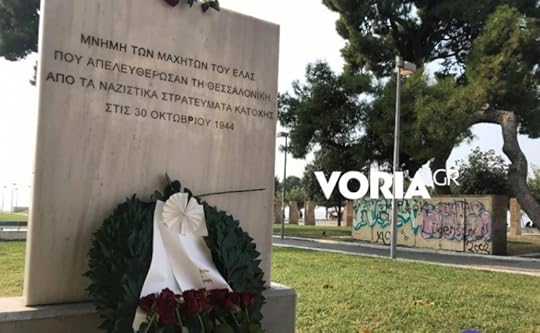 ΤιμηÏική ÏÏήλη ανÏ
ÏάÏκÏοÏ
γεγονÏÏοÏ..
ΤιμηÏική ÏÏήλη ανÏ
ÏάÏκÏοÏ
γεγονÏÏοÏ..ΣÎÎÎÎΩΣÎÎΣ[1]. Îεν θα αÏÏοληθοÏμε οÏÏε με Ïα, ολίγα ÏάνÏÏÏ, οÏθογÏαÏικά λάθη ÏÎ¿Ï , ÏÏÏÏ ÎºÎ»Î±ÏÏικÏÏ Î±Î½Ïί κλαÏικÏÏ ÏÏην Ïελ. 31.[2]. Î ÏÏÏογÏαÏία(Imperial War Museums, ÏεκμήÏιο Ï ÏΠαÏιθμÏν 1922) ÏÏο εξÏÏÏ Î»Î»Î¿ ÏÎ¿Ï Î²Î¹Î²Î»Î¯Î¿Ï Î±Î½Î±ÏÎÏεÏαι ÏÏι ÏÏοÎÏÏεÏαι αÏÏ Ïα βÏεÏανικά αÏÏεία, ÎÏει ληÏθεί δε ÏÏ Î³ÎºÎµÎºÏιμÎνα αÏÏ Ïον ÎοÏία D. Johnson ÏÎ¿Ï ÎÏεÏÎ±Î½Î¹ÎºÎ¿Ï Î£ÏÏαÏÎ¿Ï (ÏÏÎλεÏÎ¿Ï ÏÎ·Ï 2Î·Ï ÎÎ¼Î¬Î´Î±Ï ÏÎ·Ï ÎινημαÏογÏαÏÎ¹ÎºÎ®Ï ÎºÎ±Î¹ ΦÏÏογÏαÏÎ¹ÎºÎ®Ï ÎÎ¿Î½Î¬Î´Î±Ï â No. 2 Army Film and Photo Section, Army Film and Photographic Unit) Ïην 19 ÎκÏÏβÏÎ¯Î¿Ï 1944. ΣÏην ÏÏÏογÏαÏία αÏεικονίζονÏαι άνδÏÎµÏ ÎºÎ±Î¹ Î³Ï Î½Î±Î¯ÎºÎµÏ Î±Î½ÏάÏÏÎµÏ ÏÎ¿Ï ÎÎÎΣ/ÎÎ ÎÎ (2η ÎεÏαÏÏία ανÏαÏÏÏν ÏÎ·Ï ÎÎ ÎÎ, Ïμήμα ÏÎ¿Ï ÎÎÎΣ) Ïε λοÏÏδη ÏεÏιοÏή ÏληÏίον ÏÎ·Ï ÎÎ¸Î®Î½Î±Ï (δεÏÏεÏÎ¿Ï Î¿ ÎβÏÎ±Î¯Î¿Ï Î£Î±Î»Î²Î±ÏÏÏε ÎÏακÏλαÏ), καÏÎµÏ Î¸Ï Î½Ïμενοι ή, καλλίÏεÏα, ÏÏοÏεγγίζονÏÎµÏ Ïην Îθήνα, αÏÏ ÏÏÎ¿Ï Î®Î´Î· αÏÏ Ïην 12 ÎκÏÏβÏÎ¯Î¿Ï Î¿Î¹ ÎεÏμανοί άÏÏιÏαν Ïην ÏÏ Î½ÏεÏαγμÎνη αÏοÏÏÏηÏή ÏÎ¿Ï Ï. ΣÏμÏÏνα με Ïην Ï ÏογÏαÏείÏα ÏÏÏε ÏÏ Î¼ÏÏία, Ïην οÏοίαν αÏεδÎÏθη Ïην 8 ÎκÏ. και Ïο ÎÎÎ, ÏÏην Îθήνα είÏε εÏιÏÏαÏεί η είÏÎ¿Î´Î¿Ï Ïε μικÏÏ Î¼Ïνον Ïμήμα ÏÎ¿Ï 34 ÏÏ Î½ÏάγμαÏοÏ.Îλ. και: <https://xyzcontagion.wordpress.com/20... & <https://www.ellinikahoaxes.gr/2021/10....
[3] Molho 1988, p. 392. Το ÏÏεÏÎ¹ÎºÏ Î±ÏÏÏÏαÏμα ÎÏει ÏÏ ÎµÎ¾Î®Ï: 'ÎδιαίÏεÏη ανηÏÏ Ïία εκÏÏάÏÏηκε για ÏÎ¿Ï Ï ÏÏÏÏÏÏεÏÎ¿Ï Ï ÏÎ¿Î¼ÎµÎ¯Ï ÏÎ¿Ï ÏÎ»Î·Î¸Ï ÏÎ¼Î¿Ï ÏÎ¿Ï ÏÏοÏανÏÏ Î±ÏειλοÏνÏαν άμεÏα Ïε ÏεÏίÏÏÏÏη Î¿Î¹ÎºÎ¿Î½Î¿Î¼Î¹ÎºÎ®Ï ÎºÎ±ÏάÏÏÎµÏ ÏηÏ.[10] Î ÏÎÏει εÏίÏÎ·Ï Î½Î± ÏημειÏθεί ÏÏι η ÏλειονÏÏηÏα ÏÎ·Ï ÎµÎ²ÏαÏÎºÎ®Ï ÎµÏγαÏÎ¹ÎºÎ®Ï ÏÎ¬Î¾Î·Ï Î´ÏαÏÏηÏιοÏοιήθηκε ενÏÏÏ ÏÏν ÏοÏιαλιÏÏικÏν οÏγανÏÏεÏν και ήÏαν ÏαÏÎÏ Ïε Î±Ï ÏοÏÏ ÏÏι η Î´Î¹Î¬Î»Ï Ïη ÏÎ·Ï ÎθÏÎ¼Î±Î½Î¹ÎºÎ®Ï ÎÏ ÏοκÏαÏοÏÎ¯Î±Ï Î¸Î± καθιÏÏοÏÏε αÏÏαγμαÏοÏοίηÏη κάθε ελÏίδα για Îνα ÏÏ Î½Î¿Î¼Î¿ÏÏÎ¿Î½Î´Î¹Î±ÎºÏ ÎºÏάÏοÏ. ÎαÏά ÏÏ Î½ÎÏεια, Ïο εβÏαÏÎºÏ ÏÏολεÏαÏιάÏο αÏοÏÏίÏÏει Ïο νεοÏÏÏÏαÏο καÏεÏÏημÎνο και Ïο θεÏÏεί «ξÎνη καÏοÏή»[11]'ή (ÏÏο ÏÏÏÏÏÏÏ Ïο):'This would result in the total bankruptcy of many Jewish businesses.[9] Special concern was expressed for the poorer sectors of the populace who were obviously directly threatened in the event of economic breakdown.[10] It should also be noted that a majority of the Jewish working class was active within socialist organizations and it was clear to them that the dissolution of the Ottoman Empire put paid to any hope for a confederate state. Consequently the Jewish proletariat came to reject the newly created establishment and to consider it as 'foreign occupation'.' [4]. ΧαÏακÏηÏιÏÏική και εν μÎÏει αÏολογηÏική εμÏανίζεÏαι η ÏÏοÏθήκη ÏÎ¿Ï ÎµÏιμεληÏÎ¿Ï ÏÏην Ïελ. 15 ÏÎ¿Ï Î²Î¹Î²Î»Î¯Î¿Ï ÏÏμÏÏνα με Ïην οÏοία: "Îε Ïον ÏÏο «ÎλληνεÏ» ο ÏÏ Î³Î³ÏαÏÎÎ±Ï ÎµÎ½Î½Î¿ÎµÎ¯ ÎµÎ´Ï ÏÎ¿Ï Ï ÎÎ»Î»Î·Î½ÎµÏ Î§ÏιÏÏιανοÏÏ. (Îλ. ÏÏεÏική εÏιÏήμανÏη ÏÎ¿Ï ÏÏ Î³Î³ÏαÏÎα ÏÏη Ïελ. 127, Ï ÏοÏημ. 10, για Ïη ÏÏήÏη ÏÎ·Ï ÏÏάÏÎ·Ï Â«ÎβÏαίοι και ÎλληνεÏ»).[5]. Bowman 2012, Ïελ. 23.[6]. ÎονιδάÏÎ·Ï Î. Î. 2022, Ïημ. 46. Îια Ïην ÏÏÎÏη ÎβÏαίÏν & ΤοÏÏκÏν ÏÏήÏιμο είναι και Ïο: Kerem Ãktem and Ä°pek Kocaömer Yosmaoǧlu 2022.[7]. Bowman 2012, Ïελ. 52.[8]. ΠολίÏÎ·Ï 2000, Ïελ. 14181-14182.[9]. ÎονιδάÏÎ·Ï 2022, Ïημ. 45. ΠαÏÎµÎ»ÎµÏ Î¸ÎÏÏÏη ανÏιμεÏÏÏίÏÏηκε ομοίÏÏ Î±ÏνηÏικά αÏÏ Ïην ÎβÏαÏκή κοινÏÏηÏα η οÏοία Ï ÏεÏÏήÏιξε Ïην Î´Î·Î¼Î¹Î¿Ï Ïγία 'ανεξάÏÏηÏÎ·Ï - διεθνοÏÏ ÏÏλεÏÏ' εκεί ελεγÏÏÎ¼ÎµÎ½Î·Ï Î±ÏÏ ÏÎ¿Ï Ï Î¯Î´Î¹Î¿Ï Ï, ÏÏÏÏ ÏοÏÏο δε αÏÎµÏ Î¸Ïνθηκαν και ÏÏον ΠαγκÏÏμιο ΣιÏνιÏÏÎ¹ÎºÏ ÎÏγανιÏÎ¼Ï (!). Îλ. και Renna Molho. 1988[10]. Renna Molho 1988, p. 393.[11]. Renna Molho 1988, p. 391.[12]. ÎονιδάÏÎ·Ï 2022, Ïημ. 46. Îίναι ÏαÏακÏηÏιÏÏÎ¹ÎºÏ ÏÏι ÏÏο ÏÎÎ»Î¿Ï ÏÎ¿Ï Î±Î¹Ïνα, ÏÏην ÏÏ Î³ÎºÏ Ïία ÏÎ¿Ï ÏολÎÂµÎ¿Ï ÏÎ¿Ï 1897 οι EβÏαίοι ÏÎ·Ï ÎεÏÏÎ±Î»Î¿Î½Î¯ÎºÎ·Ï Î²Î³Î®ÎºÎ±Î½ ÏÏÎ¿Ï Ï Î´ÏÏÂµÎ¿Ï Ï Ï ÏοÏÏηÏίζονÏÎ±Ï Ïην Oθϵανική AÏ ÏοκÏαÏοÏία µε Ïο ÏÏνθηµα, 'Todos muramos, la Creta a los grecos non la damos' (Fleming 2008, p. 56; ÎάÏÏα 2017, Ïελ. 132, Ïημ. 35; Dalègre 2012, n. 15). Îιά Ïο ίδιο θÎμα ανÏιγÏάÏÎ¿Ï Î¼Îµ αÏÏ Ïον Î£Î¿Ï ÎºÏÎ¿Ï ÎλιÏζάκ, μεÏÎ±Î¾Ï ÏÏν άλλÏν ÏÏ Î½ÎµÏγάÏÎ¿Ï ÏÎ¿Ï ÏεÏιÏÎ½Ï Î¼Î¿Ï ÎÎÎÎÎÎÎ , ÎμεÏικανοÏÏαÏοÏÏ ÎºÎ±Î¹ Ï ÏοÏÏÏÏÎ¿Ï ÏÎ·Ï ÎλλάδοÏ, <https://www.eliamep.gr/publication/ÏÎ... (Sükrü Ulisak 2002, p. 137):'()* ,$ÎεÏά Ïην εÏανάÏÏαÏη ÏÏν ÎεÏÏÎ¿Ï ÏκÏν, η αναÏÏάÏÏÏη καÏακάθιÏε ÏÏÎ¿Ï ÏÏιγµήν, αλλά η αϵÏÏÏαιÏα ελÏÎ¯Î´Î±Ï ÂµÎµÏαÏÏάÏηκε Ïε αÏÏγνÏÏη, ÏÏαν άÏÏιÏαν να εξαγγÎλλονÏαι Ïα εθνικά ÏÏογÏάµµαÏα ÏÏν διαÏοÏεÏικÏν εθνοÏήÏÏν (..). Îι ÎÎ»Î»Î·Î½ÎµÏ ÎµÎ³ÎºÎ±Î¹Î½Î¯Î±Ïαν µια ανÏι-εβÏαÏκή εκÏÏÏαÏεία ÏÎ¿Ï ÎºÏάÏηÏε µÎÏÏι Ïον ÎοÏνιο ÏÎ¿Ï 1909, µε Ïο ÏÏνθηµα 'ÎÎ»ÎµÏ Î¸ÎµÏία αÏÏ Ïον εβÏαÏÎºÏ Î¶Ï Î³Ï' (..). [13]. Bowman 2012, Ïελ. 54.[14]. Bowman 2012, Ïελ. 32. ÎαÏά Ïο βιβλίο: "ÎνÏαÏοκÏίθηκαν ÏÏην ÎκκληÏη ÏÎ¿Ï ÎºÏμμαÏÎ¿Ï Î½Î± Ï ÏοÏÏηÏÎ¯Î¾Î¿Ï Î½ Ïην Îλλάδα ενάνÏια ÏÏον ιÏÎ±Î»Î¹ÎºÏ ÏαÏιÏÎ¼Ï ÏÎ¿Ï 1940, αν και η ελληνική ÎºÏ Î²ÎÏνηÏη ήÏαν ÏÏα μάÏια ÏÎ¿Ï Ï Î±ÎºÏμη «μοναÏÏο-ÏαÏιÏÏική»". [15]. Bowman 2012, Ïελ. 63.[16]. Bowman 2012, Ïελ. 65.[17] ÎÏγÏη 2021, <http://logxi.com/2021/11/05/4-noemvri.... https://www.in.gr/wp-content/uploads/.... Îλ. <http://sfoulidis.eu5.org/symfonia/sym.... ÎονιδάÏÎ·Ï 2022.[21]. ΣÏην Ïελ. 52 (Bowman 2012, Ïελ. 52) αναγÏάÏεÏαι εÏί λÎξει:"Î ÎενιζÎÎ»Î¿Ï ÏÏηÏιμοÏοίηÏε Ïην ÎµÏ ÎºÎ±Î¹Ïία [μεÏά Ïο 1922] για να οδηγήÏει ÎικÏαÏιάÏÎµÏ ÎÎ»Î»Î·Î½ÎµÏ ÏÏη ÎεÏÏαλονίκη. ΣκοÏÏÏ ÏÎ¿Ï Î®Ïαν να εξελληνίÏει Ïην ÏÏλη ÏÏÎ¿Ï ÏÏοÏολεμικά οι ÎβÏαίοι ÎºÏ ÏιαÏÏοÏÏαν ÏÏην οικονομία ÏÎ·Ï ÎºÎ±Î¹ αÏοÏελοÏÏαν Ïη μεγαλÏÏεÏη μεÏίδα ÏÎ¿Ï ÏÎ»Î·Î¸Ï ÏÎ¼Î¿Ï ÏηÏ." ΣημειÏνεÏαι ÏÏι ÏÏμÏÏνα με Ïην wikipedia, s.v. ÎεÏÏαλονίκη: η ÏÎ»Î·Î¸Ï Ïμιακή ÏÏνθεÏη ÏÎ·Ï ÏÏλεÏÏ Î®Ïαν:1890: ÎβÏ. 46.6%, Îλλ. 13.6%1904: ÎβÏ. 34.9%, Îλλ. 40.6%1913: ÎβÏ. 38.9%, Îλλ. 25.5% ÎεβαίÏÏ ÏÏην καÏαμÎÏÏηÏη δεν ελήÏθη Ï ÏÏÏιν Ïο αγÏοÏÎ¹ÎºÏ ÏÏοιÏείο. <https://el.wikipedia.org/wiki/ÎεÏÏα... ληθÏÏμÏÏ>[22]. Molho 1988, n. 17.[23]. Bowman 2012, Ïελ. 52.[24]. ÎονιδάÏÎ·Ï 2022, Ïημ. 47.
ÎÎÎÎÎÎÎΡÎΦÎÎ
https://kis.gr/files/BOWMAN teliko 2013.pdf
Bowman, S, 2012. ÎνÏίÏÏαÏη ÏÏν ÎβÏαίÏν ÏÏην καÏοÏική Îλλάδα, ÎÎΣ.
https://www.academia.edu/6982899/The_...
Renna Molho. 1988. "The Jewish Community of Salonika and its Incorporation into the Greek State, 1912-19," Middle Eastern Studies 24 (4), pp. 391-403.
Davis, J. 2014. "A Preamble to the Nazi Holocaust in Greece: Two Micro-Histories from the American School of Classical Studies at Athens," From the Archivist's Notebook, Essays Inspired by Archival Research in Athens Greece,<https://nataliavogeikoff.com/2014/11/... (11 November 2022).
https://journals.sfu.ca/jmh/index.php...
Gerolymatos, A. 2006-2007. Rev. of S. Bowman, Jewish Resistance in Wartime Greece, in Journal of Modern Hellenism 23-24, pp. 91-95.
https://journals.sfu.ca/jmh/index.php...
Georgakas, D. 2006-2007. "The Jews of Greece: A Chronology," Journal of Modern Hellenism 23-24, pp. 1-11.
ÎÏγÏη, 2021. "4 ÎοεμβÏÎ¯Î¿Ï 1944: η ÏÏαγή ÏÏν ÎλλήνÏν ÏÏο ÎÎ¹Î»ÎºÎ¯Ï Î±ÏÏ Ïον ÎÎÎΣ," <http://logxi.com/2021/11/05/4-noemvri... (17 ÎοεμβÏÎ¯Î¿Ï 2022).
ΠολίÏηÏ, Î. 2000. "ÎÏάνιÏμα αÏÏ Î´Î¹Î±ÏÏÏÎ¿Ï Ï Î¹ÏÏοÏικοÏÏ Î³Î¹Î± ÏÎ¿Ï Ï ÎβÏÎ±Î¯Î¿Ï Ï ÏÎ·Ï ÎεÏÏαλονίκηÏ," ÎÎÎ¥ÎÎΣ 222, Ïελ. 14181-14182.
https://www.facebook.com/permalink.ph...
https://www.facebook.com/permalink.ph...
November 1, 2022
HELLENISTIC MYRTLE WREATH OF MIDA
Î Îήδα, Î¸Ï Î³Î±ÏÎÏα ÏÎ¿Ï Îοθήλα, βαÏιλÎÏÏ ÏÏν ÎεÏÏν, Ï ÏήÏξε θÏάκιÏÏα ÏÏιγκίÏιÏÏα ÏÎ¿Ï Î¿ ΦίλιÏÏÎ¿Ï ÏανÏÏεÏÏηκε, ÏÏαν γÏÏιζε αÏÏ Ïην εκÏÏÏαÏεία ÏÏη Î£ÎºÏ Î¸Î¯Î±, Ïο 339 Ï.Χ. και Ïην ÏÏα ÏÎ¿Ï Î¸Î±Î½Î¬ÏÎ¿Ï ÏÎ·Ï Î¸Î± ήÏαν 20-25 ÏÏÏνÏν. Î¥ÏακοÏονÏÎ±Ï ÏÏο Îθιμο ÏÎ·Ï ÏÏ Î»Î®Ï ÏÎ·Ï ÏÎ¿Ï , ÏÏÏÏ ÎºÎ±ÏαγÏάÏει ο ÎÏÏδοÏοÏ, ÏÏιζε οι Î³Ï Î½Î±Î¯ÎºÎµÏ ÏÏν εÏιÏανÏν να ÏÏ Î½Î¿Î´ÎµÏÎ¿Ï Î½ ÏÎ¿Ï Ï ÏÏ Î¶ÏÎ³Î¿Ï Ï ÏÎ¿Ï Ï ÏÏον θάναÏο, η νεαÏή ξÎνη ÏαίνεÏαι ÏÏÏ Î±Ï ÏοκÏÏνηÏε, ÏÏαν δολοÏονήθηκε ο βαÏιλιάÏ. ÎÎºÎ¿Î»Î¿Ï Î¸ÏνÏÎ±Ï Ïον άνδÏα και κÏÏÎ¹Ï ÏÎ·Ï ÏÏÎ¹Ï ÏλÏÎ³ÎµÏ ÏÎ·Ï Î½ÎµÎºÏÎ¹ÎºÎ®Ï ÏÏ ÏÎ¬Ï ÎºÎ±Î¹ ÏÏον ÏάÏο, ÏÏ Î½ÏÏÏÏιÏÏα για ÏάνÏα ÏÎ·Ï ÎºÎ»Î¯Î½Î·Ï ÏÎ¿Ï Î²Î±Ïιλιά ÏÏον Îδη, Îγινε για ÏÎ¿Ï Ï ÎακεδÏνεÏ, ÏÎ¿Ï Î¿ÏÏÏδήÏοÏε δεν ήÏαν εξοικειÏμÎνοι με ÏÎÏοια δείγμαÏα αÏοÏιÏÏεÏÏ, μια νÎα ÎλκηÏÏιÏ, ÏÏÏÏÏ Ïο ÏÏ Î¶Ï Î³Î¹ÎºÎ®Ï Î±ÏεÏÎ®Ï ÎºÎ±Î¹ ÏίÏÏηÏ.ÎÏ ÏÏÏ ÏαίνεÏαι να είναι ο λÏÎ³Î¿Ï ÏÎ¿Ï Î¿ ÎλÎξανδÏοÏ, ο νÎÎ¿Ï Î²Î±ÏιλιάÏ, Ïην ÏίμηÏε ÏÏÏο ÏολÏ, δίνονÏÎ¬Ï ÏÎ·Ï ÏÏο Ïαξίδι ÏÏÏÎ¯Ï Î³Ï ÏιÏÎ¼Ï Î´ÏÏα αμÏθηÏÎ·Ï Î±Î¾Î¯Î±Ï.[1]
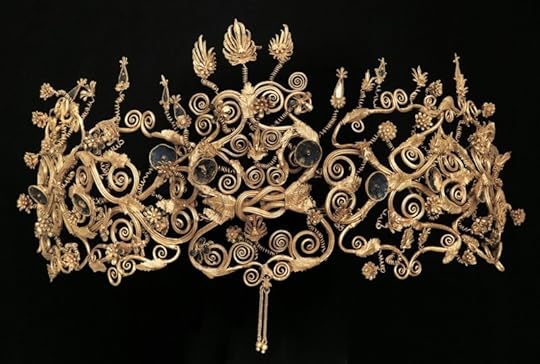 ΣÏÎÏÎ±Î½Î¿Ï ÏÎ·Ï ÎήδαÏ, Î¼Î¯Î±Ï ÏÏν ÏÏ
ζÏγÏν ÏοÏ
ΦιλίÏÏοÏ
ÎÎ[1a]
ΣÏÎÏÎ±Î½Î¿Ï ÏÎ·Ï ÎήδαÏ, Î¼Î¯Î±Ï ÏÏν ÏÏ
ζÏγÏν ÏοÏ
ΦιλίÏÏοÏ
ÎÎ[1a]H ÏÏοÏÏÏαμÎνη ÎÏοÏÎµÎ¯Î±Ï ÎÏÏαιοÏήÏÏν ÎÎ¼Î±Î¸Î¯Î±Ï Î±ÏÏαιολÏγοÏ, δÏ. Îγγελική ÎοÏÏαÏίδη, ÏημειÏνει για Ïο ÏολÏÏιμο κÏÏμημα ÏÎ·Ï ÏÏ Î»Î»Î¿Î³Î®Ï ÏÎ¿Ï ÎÎ¿Ï ÏÎµÎ¯Î¿Ï ÏÏν ÎιγÏν...
ÎÏ Ïή Ïην δÏÏκολη Îνοιξη ÏÎ·Ï ÏÎ±Î½Î´Î·Î¼Î¯Î±Ï ÎºÎ±Î¹ ÏÎ¿Ï ÎµÎ³ÎºÎ»ÎµÎ¹ÏÎ¼Î¿Ï Î· μαÏιά Î¼Î¿Ï ÏÏαμαÏάει Ïε Îνα αÏÏ Ïα λιγÏÏεÏο διάÏημα εκθÎμαÏα, Ïην ολÏÏÏÏ Ïη ÏÏεÏάνη-διάδημα, ÏÏι εÏειδή είναι Îνα αÏÏ Ïα ÏÏαιÏÏεÏα και ÏÎ¯Î³Î¿Ï Ïα Ïο ÏÎ¿Î»Ï ÏιμÏÏεÏο κÏÏμημα ÏÎ·Ï ÎºÎ»Î±ÏÎ¹ÎºÎ®Ï ÎµÏοÏÎ®Ï ÏÎ¿Ï ÎÏÏαÏε ÏÏ ÎµÎ¼Î¬Ï, αλλά εÏειδή ο άγνÏÏÏÎ¿Ï ÎºÎ±Î»Î»Î¹ÏÎÏνηÏ-ÏÏÏ ÏοÏÏÎ¿Ï ÏÎ¿Ï Ïε ÏίÏοÏε δεν ÎÏει να ζηλÎÏει Ïον ÎÏενβενοÏÏο ΤÏελίνι αιÏμαλÏÏιÏε ÏÏÎ¹Ï ÏεÏιδινήÏÎµÎ¹Ï ÏÎ¿Ï Ïην ζÏογÏνο ÎδÎα ÏÎ·Ï Î±Î¹ÏÎ½Î¹Î±Ï ÎνοιξηÏ! ΧÏÏ ÏÏÏ 24 καÏαÏίÏν, κοκκίδÏÏη και ÏÏ ÏμαÏεÏÏ, οι Ïιο αÏαιÏηÏικÎÏ ÏεÏνικÎÏ ÏÎ·Ï Î±ÏÎ³Ï ÏοÏÏÏ ÏοÏοÎÎ±Ï ÏÏην Ïιο εκλεÏÏÏ ÏμÎνη εÏαÏμογή ÏÎ¿Ï Ï, εÏιÏÏÏαÏεÏονÏαι, Î²Î±Î¸Ï ÎºÏανο Î³Ï Î±Î»Î¯, Ï Î»Î¹ÎºÏ ÎµÎ¾Î±Î¹ÏεÏικά ÏολÏÏιμο ÏÏÏε, ÏÏ ÏεÏεÏαι Ïε ÏÏÏο μικÏοÏκοÏικÎÏ ÏÏÏÎ¼ÎµÏ ÏÎ¿Ï Î²Î¬Î¶Î¿Ï Î½ Ïε δοκιμαÏία ÏÎ¿Ï Ï Î½ÏÎ¼Î¿Ï Ï ÏÎ·Ï ÏÎ·Î¼ÎµÎ¯Î±Ï ÎºÎ±Î¹ ÏÎ·Ï ÏÏ ÏικήÏ, η γνÏÏη και η ÏÎÏνη Ïμίγει με Ïο μεÏάκι και Ïην Î±Î½Ï ÏÎÏβληÏη μαÏÏοÏιά και Îνα αÏιÏÏοÏÏγημα γεννιÎÏαι. ÎεÏÏεÏίλεÏÏα κλαδάκια, ÏÏείÏÎµÏ ÎºÎ±Î¹ ÎÎ»Î¹ÎºÎµÏ Î±ÏλÏνονÏαι ÏÏον ÏÏÏο, ÏλάθονÏÎ±Ï Î¼Î¹Î± δανÏÎλα αÏÏ ÏÏ Î¼Ïδη ÏÏÏ Ïά βλαÏÏάÏια. ΠανÏÎ¿Ï Î¾ÎµÏÏ ÏÏÏÎ½Î¿Ï Î½ Î»Î¿Ï Î»Î¿Ï Î´Î¬ÎºÎ¹Î±: ÏÏιανÏάÏÏ Î»Î»Î±, κÏίνοι και νάÏκιÏÏοι, μαÏγαÏίÏÎµÏ ÎºÎ±Î¹ ανεμÏÎ½ÎµÏ ÎºÎ¬Î¸Îµ λογήÏ. ÎαλοÏÏημαÏιÏμÎνα ÏÏ Î»Î»Î±Ïάκια Î¬ÎºÎ±Î½Î¸Î±Ï Î¶ÏνÏανεÏÎ¿Ï Î½ Ïα βλαÏÏάÏια, Î³ÎµÎ¼Î¯Î¶Î¿Ï Î½ Ïα κενά και κÏÏÎ²Î¿Ï Î½ ÎÎ¾Ï Ïνα ÏÎ¹Ï ÎµÎ½ÏÏειÏ. ΧÏÏ ÏÎÏ Î¼ÎµÎ»Î¹ÏÏοÏÎ»ÎµÏ ÏÎ¿Ï ÏοÏν Ïο νÎκÏÎ±Ï ÏÏν Î»Î¿Ï Î»Î¿Ï Î´Î¹Ïν ÏÎ¿Ï , ÏÏαν ÎºÎ¿Ï Î½Î¹ÎÏαι Ïο διάδημα, ÏÏεμοÏÎ±Î¯Î¶Î¿Ï Î½, αÏήνονÏÎ±Ï Î®ÏÎ¿Ï Ï Ïαν Ïο Î¶Î¿Ï Î¶Î¿ÏνιÏμα ÏÏν ενÏÏμÏν.ΠκαλλιÏÎÏÎ½Î·Ï Î±Ïοδίδει με ÏειÏÏικÏÏηÏα ÏÎ¹Ï Î¼Î¿ÏÏÎÏ ÏÏν ÏλαÏμάÏÏν ÏÎ¿Ï ÎºÎ±Î¹ Î´Î·Î¼Î¹Î¿Ï Ïγεί Ïην ενÏÏÏÏÏη «ÏÏ ÏικÏÏηÏαÏ» και ζÏνÏάνιαÏ. Το ÏÏ Î½Î¿Î½Î¸ÏÎ»ÎµÏ Î¼Î± ÏÏν Î»Î¿Ï Î»Î¿Ï Î´Î¹Ïν και ÏÏν ενÏÏμÏν, Ïα βλαÏÏάÏια ÏÎ¿Ï Î¼ÏλÎκονÏαι, ÏÏ ÏÏÏÎÏονÏαι και αÏλÏνονÏαι ÏανÏÎ¿Ï Î±Î½Î±ÎºÎ±Î»Î¿Ïν Ïην εικÏνα ÏÎ·Ï ÏÏÏÎ·Ï Ïην ʼÎνοιξη, ÏμÏÏ, αν κοιÏάξει ÎºÎ±Î½ÎµÎ¯Ï Ïιο ÏÏοÏεκÏικά, αναγνÏÏίζει Ïην Ï Ïοκείμενη Î±Ï ÏÏηÏή γεÏμεÏÏία ÏÎ·Ï Î´Î¿Î¼Î®Ï, Ïα ÏÏ Î¼Î¼ÎµÏÏικά εÏαναλαμβανÏμενα Î»Ï ÏÏÏÏημα και καÏδιÏÏÏημα μοÏίβα, Ïην ακÏιβοδίκαιη ανÏιÏÏοιÏία ÏÏν ελίκÏν και ÏÏο κÎνÏÏο Ïην ιεÏή ÏÏ Î¼Î¼ÎµÏÏία ÏÎ¿Ï Î¸ÎµÏÎºÎ¿Ï ÎºÏÎ¼Î²Î¿Ï , Î´Ï Î¿ βλαÏÏάÏια ÏÎ¿Ï Î´Î¹Î±ÏλÎκονÏαι ÏÏÏÏ ÏοÏÎ ÏÏην ÏÏÏη για να ÏÏημαÏίÏÎ¿Ï Î½ Ïο «ÎÏάκλειον άμμα», ÏÏμβολο ÏÎ¿Ï Î¸ÎµÎ¿Ï ÏÏοÏάÏοÏα ÏÏν ÎÏακλειδÏν, ÏαÏή αναÏοÏά ÏÏον βαÏÎ¹Î»Î¹ÎºÏ Î¿Î¯ÎºÎ¿ ÏÏν ÎακεδÏνÏν. Îι νÏμοι ÏÎ·Ï Î³ÎµÏμεÏÏÎ¯Î±Ï ÎºÎ¬Î½Î¿Ï Î½ Ïην ÎÏίÏη 'ÎÏÏμο', κÏÏμημα. ΦÏιαγμÎνα αÏÏ ÏÏÏ ÏάÏι, Ïην αθάναÏη Ïλη, Ïα εÏÏακÏα βλαÏÏάÏια, Ïα Î»Î¿Ï Î»Î¿Ïδια με Ïα Î²Î±Î¸Ï ÎºÏανα ÏÎÏαλα, οι μÎλιÏÏÎµÏ ÏÎ¿Ï Î¼ÎµÏÎ¿Ï ÏιÏÎ½Î¿Ï Î½ Ïο νÎκÏÎ±Ï Ïε μÎλι δεν ανÏιγÏάÏÎ¿Ï Î½ Ïην ÏÏÏη, αλλά αÏÎ¿Î´Î¯Î´Î¿Ï Î½ με ζÏνÏάνια και ακÏίβεια Ïαν Ï ÏÎÏοÏα ιδεογÏάμμαÏα Ïην Îννοια ÏÏν ÏνÏÏν. ΠκαλλιÏÎÏÎ½Î·Ï ÏÎ¿Ï Î´Î¹Î±Î´Î®Î¼Î±ÏÎ¿Ï ÏÏν ÎιγÏν δεν ÏÏοÏÏάθηÏε να αÏοÏÏ ÏÏÏει ÏÏ ÏιοκÏαÏικά μιαν εικÏνα ÏÎ·Ï Ê¼ÎÎ½Î¿Î¹Î¾Î·Ï Î±Î»Î»Î¬ Î±Ï Ïήν ÎºÎ±Î¸Î±Ï Ïή Ïην ʼÎνοιξη ÏÏ Î´Î¹Î±ÏÏονική, αναλλοίÏÏη και ζÏοδÏÏι ÎδÎα... ΣÏο κÎνÏÏο, εÏÎ¬Î½Ï Î±ÏÏ Ïον 'ιεÏÏ ÎºÏμβο', μÎÏα αÏÏ Ïον ÎºÎ¬Î»Ï ÎºÎ± ενÏÏ Î±Î½Î¸ÎµÎ¼Î¯Î¿Ï Î±Î½Î±Î´ÏεÏαι Îνα ÏεÏιÏÏεÏάκι, Ïο ιεÏÏ ÏÎ¿Ï Î»Î¯ ÏÎ·Ï ÎÏÏοδίÏηÏ, ÏÏμβολο ÏÎ¿Ï ÎÏÏÏα ÏÎ¿Ï Î´Î¹Î±Ïκεί για ÏάνÏα. Χαμηλά κάÏÏ Î±ÏÏ Î±Ï ÏÏν, ÏÏο μÎÏÏÏο ÏÎ·Ï ÏÏ ÏεÏÎ®Ï ÏÎ¿Ï Ïο ÏοÏοÏÏε, κÏÎμονÏαι δÏο μικÏοÏκοÏικά ÏÏδια, οι ιεÏοί καÏÏοί ÏÎ·Ï Î ÎµÏÏεÏÏνηÏ, ÏÏμβολα ÏÎ·Ï Î³Î¿Î½Î¹Î¼ÏÏηÏÎ±Ï ÏÎ¿Ï ÎºÎ±ÏιÏÏÏει ÏÎ¿Ï Î¸Î±Î½Î¬ÏÎ¿Ï .[2]
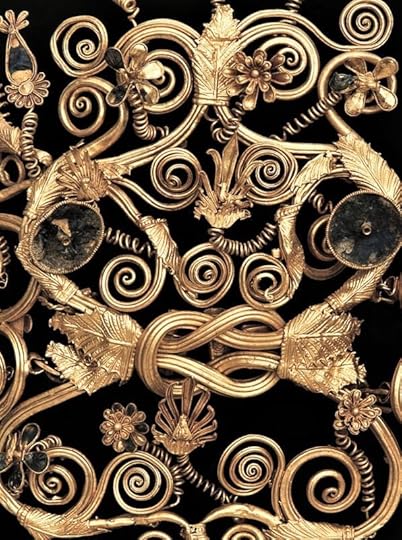
 ÎεÏÏομÎÏεια (αÏιÏÏ.) ÏοÏ
διαδήμαÏÎ¿Ï & εικÏνα ÎεÏÎ¿Î³ÎµÎ¹Î±ÎºÎ®Ï Î¼Ï
ÏÏÎ¹Î¬Ï (δεξ.)
ÎεÏÏομÎÏεια (αÏιÏÏ.) ÏοÏ
διαδήμαÏÎ¿Ï & εικÏνα ÎεÏÎ¿Î³ÎµÎ¹Î±ÎºÎ®Ï Î¼Ï
ÏÏÎ¹Î¬Ï (δεξ.)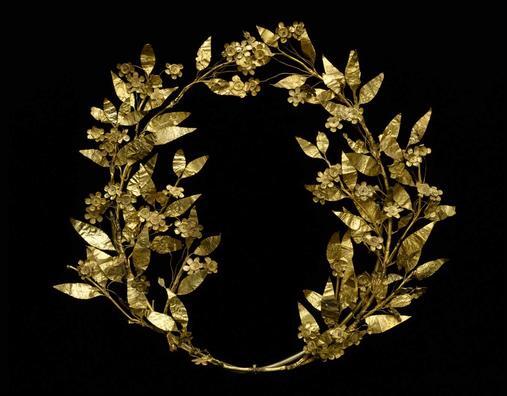 ÎλληνικÏÏ ÏÏÏ
ÏÏÏ ÏÏÎÏÎ±Î½Î¿Ï Î¼Ï
ÏÏÎ¹Î¬Ï (The Museum of Fine Arts, HoustonGift of Miss Annette Finnigan)[5]
ÎλληνικÏÏ ÏÏÏ
ÏÏÏ ÏÏÎÏÎ±Î½Î¿Ï Î¼Ï
ÏÏÎ¹Î¬Ï (The Museum of Fine Arts, HoustonGift of Miss Annette Finnigan)[5]Î Î¼Ï ÏÏιά, ιεÏÏ ÏÏ ÏÏ ÏÎ·Ï Î¸ÎµÎ¬Ï ÎÏÏοδίÏηÏ, ήÏαν ÏÏμβολο ÏÎ·Ï Î±Î³Î¬ÏÎ·Ï ÎºÎ±Î¹ ÏÏμβολο αθαναÏÎ¯Î±Ï Î´Î¹ÎθεÏε δε ÏθÏÎ½Î¹ÎµÏ ÏÏ ÏÏεÏίÏειÏ.[5a1] Îι ÎÎ»Î»Î·Î½ÎµÏ ÏοÏοÏÏαν ÏÏεÏÎ¬Î½Î¿Ï Ï ÏÏÎ¹Ï ÎµÎºÎ´Î·Î»ÏÏÎµÎ¹Ï ÎºÎ±Î¹ Ïα λάμβαναν ÏÏ Î±Î¸Î»Î·Ïικά ÎÏαθλα με ÏιμÎÏ.[5a2] Îι ÏÏÎÏανοι ÏÎ¿Ï Î®Ïαν ÏÏιαγμÎνοι αÏÏ ÏÏλλα ÏÏÏ ÏοÏ, Î´Î·Î¼Î¹Î¿Ï Ïγήθηκαν για να ÏαÏοÏν μαζί με ÏÎ¿Ï Ï Î½ÎµÎºÏοÏÏ Î±Î»Î»Î¬ ήÏαν ÏÎ¿Î»Ï ÎµÏθÏÎ±Ï ÏÏοι για καθημεÏινή ÎµÎ½Î´Ï Î¼Î±Ïία. ÎμÏÏ ÎÏει Ï ÏοÏÏηÏιÏθεί ÏÏι ÏÎ¿Ï Ï ÏοÏοÏÏαν Ïε εÏίÏÎ·Î¼ÎµÏ ÎºÎ¿Î¹Î½ÏνικÎÏ ÎµÎºÎ´Î·Î»ÏÏÎµÎ¹Ï ÏÎ¿Ï ÏεÏιλάμβαναν και θÏηÏÎºÎµÏ Ïική ÏελεÏÎ¿Ï Ïγία, ÏÏÏÏ Ïα ÏÏ Î¼ÏÏÏια, ÏÎ¿Ï Î¾ÎµÎºÎ¹Î½Î¿ÏÏανμε Î¸Ï Ïία ÏÏÎ¿Ï Ï Î¸ÎµÎ¿ÏÏ.[5a3]Τα ÏÏλλα και Ïα άνθη ÏÎ·Ï Î¼Ï ÏÏÎ¹Î¬Ï ÏÏιάÏνονÏαν αÏÏ Î»ÎµÏÏά ÏÏλλα ÏÏÏ ÏοÏ, ÏÏÏαγίζονÏαν και ÏαÏάζονÏαν λεÏÏομÎÏÎµÎ¹ÎµÏ ÏÎ¬Î½Ï ÏÎ¿Ï Ï ÎºÎ±Î¹ ÏÏη ÏÏ Î½ÎÏεια ενÏνονÏαν με μίÏÏÎ¿Ï Ï. Πολλά ÏÏεÏάνια ÏÎ¿Ï ÏÏζονÏαι ÎÏÏ ÏήμεÏα βÏÎθηκαν Ïε αÏÏÎ±Î¯Î¿Ï Ï ÏάÏÎ¿Ï Ï. ΧÏÏ ÏÏÏ ÏÏÎÏÎ±Î½Î¿Ï Î¼Ï ÏÏÎ¹Î¬Ï Î¼Îµ ÎνθεÏÎ¿Ï Ï ÏÎ¿Î»Ï ÏÎ¯Î¼Î¿Ï Ï Î»Î¯Î¸Î¿Ï Ï ÏÏ Î»Î¬ÏÏεÏαι ÏÏο ÎÎ¿Ï Ïείο ÎÏÏÏεÏÎ¹ÎºÎ®Ï ÎογγολίαÏ, ÏÏ Î½Î¿Î´ÎµÏεÏαι δε αÏÏ Ï ÏÏμνημα ÏÏι είναι εÏÏημα ÏαÏανÏμÏν αναÏκαÏÏν ÏÏο Ulanqab και ÏÏονολογείÏαι αÏαÏÏÏ ÏÏην ÏεÏίοδο ÏÏν Han (200 Ï.Χ. ÎÏÏ 200 μ.Χ.). Îίναι ÏαÏακÏηÏιÏÏÎ¹ÎºÏ ÏÏι Ïα άνθη ÏÎÏÎ¿Ï Î½ ÎνθεÏο ÎºÏ Î±Î½Î¿Ï ÏολÏÏÎ¹Î¼Î¿Ï Î»Î¯Î¸Î¿Ï , ομοιάζονÏÎ±Ï (και) καÏά ÏοÏÏο με ÎÎ±ÎºÎµÎ´Î¿Î½Î¹ÎºÏ ÏÏÎÏανο ο οÏÎ¿Î¯Î¿Ï ÏÏÏÏÏαÏα εÏεÏÏÏάÏη αÏÏ Ïο ÎÎ¿Ï Ïείο Getty ÏÏο ÎÏÏÎ±Î¹Î¿Î»Î¿Î³Î¹ÎºÏ ÎÎ¿Ï Ïείο ÎεÏÏαλονίκηÏ.[6]
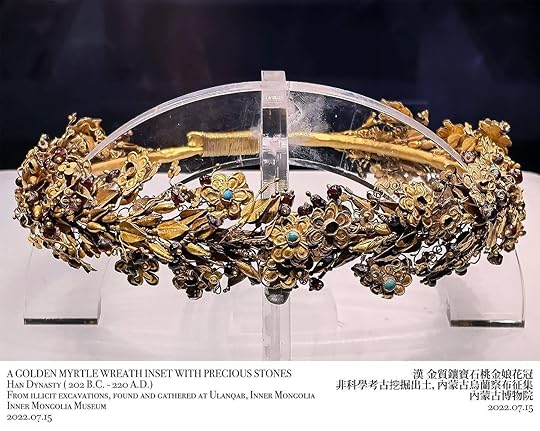 ΧÏÏ
ÏÏ Î´Î¹Î¬Î´Î·Î¼Î± με άνθη μÏ
ÏÏÎ¹Î¬Ï Î±ÏÏ Ïο Ulanqab[7]
ΧÏÏ
ÏÏ Î´Î¹Î¬Î´Î·Î¼Î± με άνθη μÏ
ÏÏÎ¹Î¬Ï Î±ÏÏ Ïο Ulanqab[7]ÎÏÏ Ïην ίδια ÏεÏιοÏή ÏÎ¿Ï Ulancab, αÏÏ ÏÏÎ¿Ï Ïο ÏεÏίÏημο 'κινεζικÏ' διάδημα, ÏÏοÎÏÏονÏαι εÏίÏÎ·Ï ÏεκμήÏια ÏÎ·Ï Î½ÎµÎºÏοÏÏλεÏÏ Yihe-Nur, μεÏικά ÏÏν οÏοίÏν εμÏÎ±Î½Î¯Î¶Î¿Ï Î½ Îλληνική ÏÏ ÏÏÎÏιÏη.[10]
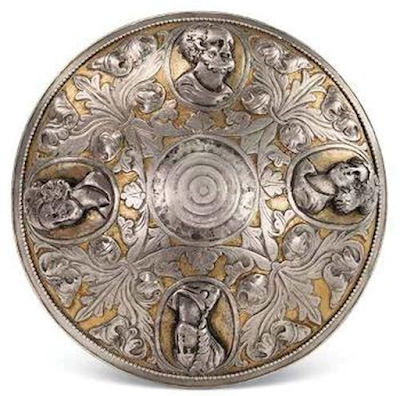 ÎÏγÏ
Ïά εÏίÏÏÏ
Ïη Ïιάλη με ανάγλÏ
Ïε κεÏαλÎÏ ÎλλήνÏν θεÏν[12]
ÎÏγÏ
Ïά εÏίÏÏÏ
Ïη Ïιάλη με ανάγλÏ
Ïε κεÏαλÎÏ ÎλλήνÏν θεÏν[12]ÎνÏιγÏάÏÎ¿Ï Î¼Îµ ÎµÎ´Ï ÏÏεÏÎ¹ÎºÏ Î±ÏÏÏÏαÏμα αÏÏ Ïο βιβλίο Î¼Î±Ï ÏεÏί ÏÎ¿Ï ÎÎ¹Î½ÎµÎ¶Î¹ÎºÎ¿Ï ÏολιÏιÏμοÏ:
ΣÏην νεκÏÏÏολη ÏÎ¿Ï Î§ÏÏ ÏÎ¿Ï ÎÏÏÎ¿Ï Î¿Î¹ ενÏαÏιαÏμÎνοι ÎÏεÏαν και Îνα άλλο νεκÏÎ¹ÎºÏ ÏαÏάÏεÏνο ÏλήÏÎµÏ Î½Î¿Î·Î¼Î¬ÏÏν και δηλÏÏÎ¹ÎºÏ Î±Î»Î»Î·Î»ÎµÏιδÏάÏεÏν: ÏÏÏκειÏαι για ÏÎ¹Ï ÏÎ±Î¹Î½Î¯ÎµÏ ÏÏαθεÏοÏοιήÏεÏÏ ÏÎ¿Ï ÏÏÏμαÏÎ¿Ï Ïε κλειÏÏή θÎÏη, ÏÎ¹Ï Î»ÎµÎ³ÏÎ¼ÎµÎ½ÎµÏ Î¿Î¸ÏνεÏ.9_119 Îι οθÏÎ½ÎµÏ Î±Î½Î±ÏÎÏονÏαι ÏÏον ÎμηÏο, Od.7.107 και Od. 11.404, ήÏαν καÏαÏÎºÎµÏ Î±ÏμÎÎ½ÎµÏ Î±ÏÏ Î»Î¹Î½Ï ÏÏαÏμα ή αÏÏ ÏÏλλα ÏÏÏ ÏοÏ, ÏκοÏÏ Î´Îµ είÏαν Ïην αÏοÏÏοÏή ανοίγμαÏÎ¿Ï ÏÎ¿Ï ÏÏÏμαÏÎ¿Ï ÏÎ¿Ï Î½ÎµÎºÏοÏ.9_120 Îίναι ÏαÏακÏηÏιÏÏÎ¹ÎºÏ ÎµÎ½ ÏÏοκειμÎÎ½Ï Ïο ÏαιγνιÏÎ´ÎµÏ Î±ÏÏÏÏαÏμα ÏÎ¿Ï ÎÎ¿Ï ÎºÎ¹Î±Î½Î¿Ï Î¿ οÏÎ¿Î¯Î¿Ï ÏÏο ΠεÏί Î ÎÎ½Î¸Î¿Ï Ï Î¸Îλει Ïον νεκÏÏ Î½Î± λÎγει, αÏÎµÏ Î¸Ï Î½ÏÎ¼ÎµÎ½Î¿Ï ÏÏÎ¿Ï Ï Î¸ÏηνοÏνÏÎµÏ (Luc. Luct. 19):
á½¥ÏÏε μοι νὴ Ïὴν ΤιÏιÏÏνην Ïάλαι δὴ á¼Ïá¾½ Î¿á¼·Ï á¼Ïοιεá¿Ïε καὶ á¼Î»ÎγεÏε ÏαμμÎÎ³ÎµÎ¸ÎµÏ á¼Ïá¿ÎµÎ¹ á¼Î½Î±ÎºÎ±Î³ÏάÏαι, διεκÏÎ»Ï Ïε δὲ ἡ á½Î¸Ïνη καὶ Ïá½° á¼Ïια, Î¿á¼·Ï Î¼Î¿Ï Ïá½°Ï ÏιαγÏÎ½Î±Ï á¼ÏεÏÏίγξαÏε
ή Ïε Îεο - Îλληνική αÏÏδοÏη:ÎÏÏε ÎµÎ´Ï ÎºÎ±Î¹ ÏÏα, μά Ïην ΤιÏιÏÏνη, Î¼Î¿Ï ÎµÏÏÏÏαν να ξεκαÏδιÏÏÏ ÏÏα γÎλια με ÏÏα κάναÏε και λÎγαÏε, αλλά με εμÏÏδιÏε Ïο ÏÏαÏμα και Ïο μαλλί με Ïο οÏοίο Î¼Î¿Ï Î´ÎÏαÏε ÏÏιÏÏά Ïα ÏαγÏνια
Î ÏÏ Î½Î®Î¸ÎµÎ¹Î± Î±Ï Ïή ÏÏ Î½Î±Î½ÏάÏαι ÏÏην ÎÏ ÎºÎ·Î½Î±Ïκή Îλλάδα και ÏÏην ÎλληνιÏÏική ÎαÏÏη ÎάλαÏÏα,[9_121] ÎÏει δε αÏοÏÏ ÏÏθεί Ïε ÏειÏά ÏελεÏÎ¿Ï ÏγικÏν αγγείÏν ÏÏÏÏ ÏÏο ÏÏο καÏÏÏεÏο διάζÏμα ÏÎ¿Ï ÎεκÏÎ¹ÎºÎ¿Ï ÎÏαÏήÏα, ÎÏÎ³Î¿Ï ÏÎ¿Ï Î¶ÏγÏάÏÎ¿Ï ÏÎ·Ï ÎÎÎºÏ Î¹Î±Ï, αλλά και Ïε μελανÏμοÏÏη ÎÏÏική Î»Î¿Ï ÏÏοÏÏÏο.[9_122] Îίναι αξιοÏημείÏÏο ÏÏι η ÏÏ Î½Î®Î¸ÎµÎ¹Î± Î±Ï Ïή βÏήκε Ïον δÏÏμο ÏÎ·Ï ÎºÎ±Î¹ ÏÏην Îίνα, ÏÏÎ¿Ï Î±ÏοκαλÏÏÏεÏαι ÏαÏοÏÏα ακÏμη και καÏά Ïην ÏεÏίοδο ÏÏν ÎοÏείÏν Wei, ÏÏÏÏ Î±ÏÎδειξε η αναÏκαÏή ÏÎ¿Ï ÏάÏÎ¿Ï M107 ÏÏο Datong (ÏεÏί Ïο 400 μ.Χ.) και ÏÎ¿Ï Î1 ÏÏο Yihe-Nur (Zhengxiangbai Banner).[9_123] ÎλλÏÏÏε ÏαÏάλληλο ÏÎ¿Ï ÎµÏ ÏήμαÏÎ¿Ï Î±ÏοÏελεί ÏεκμήÏιο ÏÎ¿Ï ÎÎ¿Ï ÏÎµÎ¯Î¿Ï Rietberg Î¬Î½ÎµÏ Î±ÏÏÎ±Î¹Î¿Î»Î¿Î³Î¹ÎºÎ¿Ï ÏλαιÏÎ¯Î¿Ï ÎµÏ ÏÎÏεÏÏ, Ïο οÏοίο διαθÎÏει Îλληνική ÏÏ ÏÏÎÏιÏη (διαθÎÏον Î±Î½Î¬Î³Î»Ï Ïη διακÏÏμηÏη με ελικοειδÎÏ Î±Î³Î¹Ïκλιμα, λÎονÏÎµÏ ÎºÎ±Î¹ ÏίμαιÏεÏ). ÎθÏÎ½ÎµÏ ÏÏονολογοÏÎ¼ÎµÎ½ÎµÏ Ïον ÏÎμÏÏο αι. μ.Χ. - και άλλα ÎÎ»Î»Î·Î½Î¹ÎºÎ®Ï ÏÏ ÏÏεÏίÏεÏÏ ÏεκμήÏια - ÎÏÎ¿Ï Î½ αναÏκαÏεί και αÏÏ Ïο κοιμηÏήÏιο Yihe-Nur.[9_124] ΣÏμÏÏνα με Ïον ÎµÎ¹Î´Î¹ÎºÏ ÎµÏÎµÏ Î½Î·Ïή Müller ÏÏ ÏÏλη ειÏÏÎ´Î¿Ï ÏÎ·Ï ÏÏ Î½Î®Î¸ÎµÎ¹Î±Ï Î±Ï ÏÎ®Ï ÏÏην Îίνα εκÏιμάÏαι Ïο λεκανοÏÎδιο Tarim αÏÏ Ïον Ïγδοο αι. Ï.Χ![9_125] ΠαλαιÏÏεÏο ÏÏεÏÎ¹ÎºÏ ÎµÏÏημα ÏÏοÎÏÏεÏαι αÏÏ Ïην ÏολλαÏλή ÏαÏή 85Î2 ÏÏην θÎÏη Zaghunluk,[9_126] ÎµÎ½Ï Î±Î½Î±ÏÎÏονÏαι και άλλα (Jumbulak, Niya, Yingpan, Sampula).[9_127] ÎθÏÎ½ÎµÏ ÏαÏαÏλήÏÎ¹ÎµÏ Î±Î»Î»Î¬ ÏÏι ÏÎ±Ï ÏιζÏÎ¼ÎµÎ½ÎµÏ Î¼Îµ ÏÎ¹Ï Î±Î½ÏÏÎÏÏ ÎµÏ ÏÎθηÏαν και ÏÏην ÏοÏÏ ÏÎ¿Ï ÏÏίγκηÏα Marquis Yi ÏÎ¿Ï ÎºÏαÏÎ¹Î´Î¯Î¿Ï Zeng (Hubei) ÏαÏÎνÏÎ¿Ï ÏεÏί Ïο 400 Ï.Χ., ÎµÎ½Ï ÏαίνεÏαι ÏÏι εμÏανίζονÏαι και Ïε ÏαÏÎÏ Î£Î±ÏμαÏÏν αÏÏ Ïην νεκÏÏÏολη Oglakhty ÏÎ·Ï Î²ÏÏÎµÎ¹Î±Ï Î£Î¹Î²Î·ÏÎ¯Î±Ï (ÎημοκÏαÏία ÏÎ·Ï Khakassia) και, ενδεÏομÎνÏÏ, Xiongnu αÏÏ Ïον ÏÏμβο 6 ÏÎ¿Ï Noin Ula.[9_128]
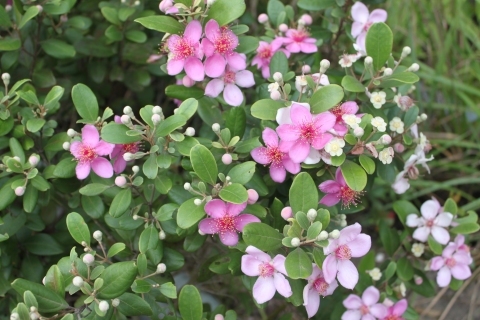 Rhodomyrtus tomentosa (common name: Downy Rose Myrtle)
Rhodomyrtus tomentosa (common name: Downy Rose Myrtle)Î£Ï Î¼ÏεÏαÏμαÏικά ÏημειÏÎ½Î¿Ï Î¼Îµ ÏÏι ο ÏÏÎÏÎ±Î½Î¿Ï Î±ÏÏ Ïο Ulanqab ενÏάÏÏεÏαι αÏÏ ÎºÎ±Î»Î»Î¹ÏεÏνική αλλά ÏιθανÏÏ ÎºÎ±Î¹ ÏημαÏιολογική άÏοÏη ÏÏÎ¹Ï ÎµÏιÏÏοÎÏ ÏÎ¿Ï Î¬ÏκηÏε ο ÎλληνιÏÏικÏÏ ÏολιÏιÏμÏÏ ÏÏα ÏÎÏαÏα ÏÎ¿Ï ÎºÏÏÎ¼Î¿Ï , ÎÏÏ ÎºÎ±Î¹ Ïην Îογγολία και Îίνα. ÎλλÏÏÏε Ïα λοιÏά ÎµÏ ÏήμαÏα ÏÎ·Ï Î½ÎµÎºÏοÏÏλεÏÏ Yihe-Nur ÏαίνεÏαι να εÏιβεβαιÏÎ½Î¿Ï Î½ Î±Ï Ïήν Ïην διάÏÏ Ïη ιδεÏν και ÏÏοÏÏÏÏν, καθιÏÏÏνÏÎ±Ï ÏιθανÏν ÏÏι ÏÎ¿Ï Î»Î¬ÏιÏÏον η ÎμÏÎ½ÎµÏ Ïη για Ïο ÏεÏίÏημο διάδημα ÎÏει Ïην Ïηγή ÏÎ·Ï ÏÏην Îακεδονία.
ΣÎÎÎÎΩΣÎÎΣ
[1]. http://odysseus.culture.gr/h/4/gh430..... Kyriakou 2014, p. 274, n. 14. Το ÏεκμήÏιο ÏÎÏει αÏ. BM 2633 (Tsigarida 2010, p. 308, n. 7). ΣημειÏνεÏαι ÏÏι Ï ÏάÏÏει διÏογνÏμία ÏÏεÏικά με Ïην αÏÏδοÏη ÏÎ¿Ï ÏάÏÎ¿Ï ÏÏον ΦίλιÏÏο ÎΠή ÏÏν ΦίλιÏÏο ÎÎÎ Ïον ÎÏÏιδαίο.[2]. https://www.jewelpedia.com/news-39-23.... https://web.archive.org/web/201412022.... Tsigarida 2010, p. 313.[5a2]. Tsigarida 2010, p. 313.[5a3]. ΤÏιγαÏίδα 2011, pp. 313-314.[6]. Tsigarida 2010, p. 310, n. 13. Το ÏεκμήÏιο ÏÎÏει αÏ. ÎÎ 24000, <https://illicitantiquities.net/artefa.... ΣÏμÏÏνα με ÏÏοÏÏÏική εÏικοινÏνία (Σάβ 5 Îοε ÏÏÎ¹Ï 10:21 Ï.μ.) με Ïον Ma Yan:Its Chinese name is "Taojinniang crown"(æ¡éå¨è±å )." Taojinniang" (æ¡éå¨) means the flower, Rhodomyrtus tomentosa. When it was exhibited in the Inner Mongolia Museum, it was dated in the Han Dynastyï¼202B.C.-220A.D.What gems unknown. It was collected in Ulanqab cityï¼ä¹å °å¯å¸å¸ï¼ in the 20th centuryï¼now collected in Inner Mongolia Museum.Present, there is very few research of this artifact in China, and no specific data information.I think it aged 1-3 A.D., which may be related to the migration of Late Sarmatians. I believe that some of the Late Sarmatians migrated to Ordos. [10]. Chen Yongzhi, Song Guodong, Ma Yan 2016, pp. 48, 55. [12]. Chen Yongzhi, Song Guodong, Ma Yan. 2016, p. 51, figs. 29, 30, color Pl. VI.Gilt-silver bowl. One of the most striking artefacts of all those excavated in the cemetery, this bowl, found in Tomb M1, is 14 cm in diameter and stands 4 cm high. The inside is smooth and has no decoration. The outside is framed by a pearllike band, and most of the surface covered by acanthus leaves in low relief set off against a gilded background.Four projecting âbossesâ depict characters from Greek mythology: Zeus, Hera, Aphrodite and Athena.ÎÏιÏÏÏ ÏÏμÎνη αÏÎ³Ï Ïά Ïιάλη. Îνα αÏÏ Ïα Ïιο ενÏÏ ÏÏÏιακά ÏεÏÎ½Î¿Ï ÏγήμαÏα αÏÏ Î±Ï Ïά ÏÎ¿Ï Î±Î½Î±ÏκάÏηκαν ÏÏο νεκÏοÏαÏείο, Î±Ï ÏÏ Ïο ÏεκμήÏιο, ÏÎ¿Ï Î²ÏÎθηκε ÏÏον ÏάÏο Î1, ÎÏει διάμεÏÏο 14 cm και ÏÏÎ¿Ï 4 cm. Το εÏÏÏεÏÎ¹ÎºÏ ÎµÎ¯Î½Î±Î¹ λείο και δεν ÏÎÏει διακÏÏμηÏη. Το εξÏÏεÏÎ¹ÎºÏ ÏλαιÏιÏνεÏαι αÏÏ Î¼Î¹Î± μαÏγαÏιÏαÏÎνια Ïαινία και Ïο μεγαλÏÏεÏο μÎÏÎ¿Ï ÏÎ·Ï ÎµÏιÏÎ¬Î½ÎµÎ¹Î±Ï ÏÎ¿Ï ÎºÎ±Î»ÏÏÏεÏαι αÏÏ ÏÏλλα Î±ÎºÎ¬Î½Î¸Î¿Ï Ïε ÏÎ±Î¼Î·Î»Ï Î±Î½Î¬Î³Î»Ï Ïο ξεκινά ÏÎ¬Î½Ï Ïε Îνα εÏιÏÏÏ ÏÏμÎνο ÏÏνÏο.ΤÎÏÏεÏÎµÎ¹Ï ÎºÎµÏαλÎÏ ÏÎ¿Ï ÏÏÎ¿Î²Î¬Î»Î»Î¿Ï Î½ αÏÎµÎ¹ÎºÎ¿Î½Î¯Î¶Î¿Ï Î½ ÏαÏακÏήÏÎµÏ Î±ÏÏ Ïην ελληνική Î¼Ï Î¸Î¿Î»Î¿Î³Î¯Î±: Ïον Îία, Ïην ÎÏα, Ïην ÎÏÏοδίÏη και Ïην Îθηνά.[9_121]-[9_128]. Îλ. ÎονιδάÏÎ·Ï 2020.
ÎÎÎÎÎÎÎΡÎΦÎÎ
http://odysseus.culture.gr/h/4/gh430....
https://www.academia.edu/3604218?fbcl... GraÅ¡ar, J., D. GavriloviÄ, E. NikoliÄ. 2012. "Wreath - Its use and meaning in ancient visual culture," in Religion and Tolerance, Journal of the Center for Empirical Researches on Religion 18 (Novi Sad, Vol. X, Nº 18), pp. 341-359.
Owen Jarus. 2017. "Silk-Covered Body Discovered at Inner Mongolia Cemetery," Live Science, <https://www.livescience.com/58630-anc... (31 Oct. 2022),"
https://edspace.american.edu/silkroad... Yongzhi, Song Guodong, Ma Yan. 2016. "The Results of the Excavation of the Yihe-Nur Cemetery in Zhengxiangbai Banner (2012-2014)," Silk Road 14, pp. 42-57.
ÎονιδάÏηÏ, Î. Î. 2020. ΠκινεζικÏÏ ÏολιÏιÏμÏÏ ÎºÎ±Î¹ οι ελλαδικÎÏ ÎµÏιδÏάÏειÏ, Îθήναι.
https://www.academia.edu/9333525/A_Ky..., A. 2014. "Exceptional burials at the sanctuary of Eukleia at Aegae (Vergina): The gold oak wreath," BSA 2014, pp. 251-285.p. 273: At the same time a gold myrtle wreath was found on the floor of the antechamber with some of its elements scattered around, probably due to its fall from the wall where it was hung (Tsigarida 1987).p. 274: Very characteristic is the case of the female burial in the antechamber of the âTomb of Philip IIâ. The gold myrtle wreath hanging on the wall possibly constituted an item denoting the status of the deceased and at the same time was accorded the role of safeguarding her on the way to the chambers of Hades and thus was related to the rite of passage, whereas the diadem, most probably an insigne for the deceased, was chosen as the object to be attached to the remains of the body. However, the diadem certainly had many references to burial ideology with its vegetal decoration, its circular form and the Herakles knot.[14: Nicgorski 2005. It should be noted, however, that, after a very illuminating introduction, the author associates the Herakles knot with Alexander and is willing to understand its popularity as a motif on artefacts only within or after the reign of the conqueror. She thus dates the magnificent diadem of the antechamber of Tomb II at Vergina to the end of the fourth century BC and therefore attributes the tomb to Philip Arrhidaeus.]
https://books.openedition.org/psorbon..., R. 2002. "La Macédoine entre Orient et Occident : essai sur lâidentité macédonienne au IVe siècle av. J.-C.," IDENTITÃS ET CULTURES DANS LE MONDE MÃDITERRANÃEN ANTIQUEChristel Müller et Francis Prost (dir.), p. 253-275
ÎÏαν η βαÏίλιÏÏα ÏοÏοÏÏε Ïο διάδημα ÏÎ¿Ï ÎµÏ ÏÎθη ÏÏο ίδιο ÏÎÏεÏÏο ÏÎ±Ï ÏÏÏÏονα με Î±Ï ÏÏ Ïο μÏβ Ïάλι, ÏÏÎÏει να Îμοιαζε με αληθινή ανθοδÎÏμη αÏÏ Î±Î½Î¿Î¹Î¾Î¹Î¬Ïικα Î»Î¿Ï Î»Î¿Ïδια.[35] ÎÏ ÏÏ Ïο διάδημα είναι Îνα αÏολÏÏÏÏ ÎµÎ¾Î±Î¹ÏεÏÎ¹ÎºÏ ÎºÎ¿Î¼Î¼Î¬Ïι και ÏÎ¿Î»Ï Î´ÏÏκολο να ÏεÏιγÏαÏεί (Îικ. 1).[36] ÎναÏÏÏÏÏει ÏεÏίÏÎ»Î¿ÎºÎµÏ ÏÏείÏÎµÏ ÎµÎºÎ±ÏÎÏÏθεν ενÏÏ ÎºÎµÎ½ÏÏÎ¹ÎºÎ¿Ï Î¬Î¾Î¿Î½Î±, ÏÎ¿Ï ÎµÏιÏημαίνονÏαι ÎνÏονα, ÏÏην κοÏÏ Ïή, αÏÏ ÏÏία άνθη ÏÎ¿Ï ÏÏηÏίζονÏαι Ïε ÎÎ»Î¹ÎºÎµÏ ÏÎ¿Ï ÏÏ Î³ÎºÏαÏοÏνÏαι αÏÏ Îνα κάθεÏο ÏÏλλο Î¬ÎºÎ±Î½Î¸Î¿Ï , ÏÏο κÎνÏÏο, αÏÏ Îναν κÏμβο ÏÎ¿Ï ÎÏακλÎÎ¿Ï Ï ÎºÎ±Î¹, ÏÏο κάÏÏ Î¼ÎÏοÏ, αÏÏ ÏÎÏÏεÏα ÏÏαιÏικά κÏεμαÏÏά διακοÏμηÏικά ÏÎ¿Ï ÎÏεÏÏαν ÏÏο μÎÏÏÏο. Τα ÏÏλλα ÏÎ¿Ï Î¬ÎºÎ±Î½Î¸Î¿Ï (;) είναι μάλλον μικÏά και διακÏιÏικά Ïε ÏÏÎÏη με Ïο ÏÏλλÏμα και Ïην ÏÏ Ïική διακÏÏμηÏη. Îν και Ïο ÎµÎ¯Î´Î¿Ï Î´ÎµÎ½ μÏοÏεί να αναγνÏÏιÏÏεί με βεβαιÏÏηÏα, μÏοÏοÏμε να διακÏÎ¯Î½Î¿Ï Î¼Îµ ÏÎ¿Ï Î»Î¬ÏιÏÏον ÏÎνÏε διαÏοÏεÏικοÏÏ ÏÏÏÎ¿Ï Ï ÏÏ ÏικÏν μοÏÏÏν: Î»Î¿Ï Î»Î¿Ïδια με διÏλή κοÏÏνα αÏÏ ÏÏενά ÏÎÏαλα και κενÏÏÎ¹ÎºÏ Î¼ÏÎ¿Ï Î¼ÏοÏκι (Ïοζ;), Îναν ÏαÏÎ´Ï Î´Î¯Ïκο με Îνα ÏÏεÏο ÏÏο κÎνÏÏο και ÏÏÎ®Î¼Î¿Î½ÎµÏ ÏÎ¿Ï ÏÏημαÏÎ¯Î¶Î¿Ï Î½ μια μικÏή κοÏÏνα Î»Î¿Ï Î»Î¿Ï Î´Î¹Ïν (ανεμÏνεÏ;), Î»Î¿Ï Î»Î¿Ïδια με ÏÎνÏε ÏαÏδιά ÏÎÏαλα (αÏÏÏÎ´ÎµÎ»Î¿Ï Ï;), λίγο ÏÎ¿Î»Ï ÏεÏίÏλοκα ανθÎμια (οικογÎνεια κÏίνÏν;), αιÏμηÏά μÏÎ¿Ï Î¼ÏοÏκια, ÏεÏÏμενα με Îναν μάλλον ιδιÏÏÏοÏο ÏÏÏÏο αÏÏ Î´Î¹Î±ÏοÏεÏικά ÏÏηÏίγμαÏα. ΣημειÏÏÏε ÏÏι δεν αναγνÏÏÎ¯Î¶Î¿Ï Î¼Îµ Ïην Î¼Ï ÏÏιά, η οÏοία ÏμÏÏ Î±ÏανÏά Ïε άλλον ÏÏÎÏανο εγκαÏαλελειμμÎνον ÏÏο δάÏεδο ÏÎ¿Ï ÏÏÎ¿Î¸Î¬Î»Î±Î¼Î¿Ï .[37: Î. ΤÏιγαÏίδα, "ΧÏÏ ÏÏ ÏÏεÏάνι Î¼Ï ÏÏÎ¹Î¬Ï Î±Ïο Ïη ÎεÏγίνα"] Îλα (;) Ïα άνθη ήÏαν ÏÏÏμαÏιÏμÎνα με ÎºÏ Î±Î½Ï Ï Î»Î¹ÎºÏ (ÏάÏÏα) και ÏÏ Ïνά ήÏαν ÏÏεÏεÏμÎνα Ïε μίÏÏÎ¿Ï Ï ÏÏημαÏίζονÏÎ±Ï ÎµÎ¯Î´Î· ελαÏηÏίÏν, ÏÎ¿Ï Î¼ÏοÏοÏÏαν να δονοÏνÏαι με Ïην ÏαÏαμικÏή κίνηÏη ÏÎ¿Ï ÎºÎµÏαλιοÏ. Îι μÎλιÏÏÎµÏ Î±Î½Î±ÏαÏίÏÏανÏαι να αναζηÏοÏν ÏÏοÏή, ÎµÎ½Ï Îνα μικÏοÏκοÏÎ¹ÎºÏ ÏÎ¿Ï Î»Î¯ ÎÏει ÏÏιάξει Ïη ÏÏλιά ÏÎ¿Ï ÏÏην καÏδιά ενÏÏ Î»Î¿Ï Î»Î¿Ï Î´Î¹Î¿Ï. To διάδημα καÏÎληγε Ïε ÏÏÏÏη λεονÏοκεÏαλήÏ.
When the queen wore the tiara found in the same casket at the same time as this purple shawl, it must have looked like a veritable bouquet of spring flowers. This tiara is quite an exceptional piece and very difficult to describe (Fig. 1)36. It deploys complicated spirals on either side of a central axis, strongly marked, at the top, by three flowers erected on turns held by a vertical acanthus leaf, in the center, by a Heracles knot and, at the very bottom, by four pendants terminating in balls which fell on the forehead. The acanthus leaves (?) are rather small and discreet compared to the foliage and the floral decoration. Although the species cannot be recognized with certainty, we can distinguish at least five different types of plant forms: flowers with a double crown of narrow petals and a central bud (pink?), a wide disc with, in the center, a pistil and stamens forming a small floral crown (anemones?), flowers with five wide, well-spaced petals (asphodels?), sort of more or less complex palmettes (lily family?), pointed buds, carried in a rather whimsical way by different supports; let us point out that we do not recognize any myrtle, which is nevertheless made of another wreath abandoned on the floor of the antechamber37. All (?) the flowers were colored with a blue paste and they were often mounted on stems forming sorts of springs, which had to vibrate at the slightest movement of the head. Bees are represented foraging, while in Taxe a tiny bird has made its nest in the heart of a flower. The tiara was closed by a lion's head clasp.
https://www.academia.edu/3636812/D._I...±, E.-M. 2011. "ΧÏÏ Ïά ÏÏεÏάνια και διαδήμαÏα ÏÎ·Ï ÎακεδονίαÏ," ÏÏο ΧÏÏ Ïά ÏÏεÏάνια και διαδήμαÏα, ÎÏÏ. ÎÎ¿Ï Ïείο ÎεÏÏÎ±Î»Î¿Î½Î¯ÎºÎ·Ï Îκδ. 7, ÎεÏ/κη.
https://www.jstor.org/stable/41420121..., B. 2010. "A New Gold Myrtle Wreath from Central Macedonia in the collection of the Archaeological Museum of Thessaloniki," The Annual of the British School at Athens 105, pp. 305-315.
Î ÎÎÎΠΠΡÎΣΦÎΤÎΣ ÎÎÎ ÎÎΥΤÎΣÎÎΣ - ÎÎ ÎÎÎÎÎÎÎ: 061122
ÎÎÎÎÎÎΣΤÎÎÎΣ ΣΤÎΦÎÎÎΣ - ÎÎÎÎÎÎ...
ΣÏÎÏÎ±Î½Î¿Ï ÏÎ·Ï ÎήδαÏ, Î¼Î¯Î±Ï ÏÏν ÏÏ Î¶ÏγÏν ÏÎ¿Ï Î¦Î¹Î»Î¯ÏÏÎ¿Ï ÎÎ. η Îήδα, η Î¸Ï Î³Î±ÏÎÏα ÏÎ¿Ï Îοθήλα, βαÏιλÎÏÏ ÏÏν ÎεÏÏν, η θÏάκιÏÏα ÏÏιγκίÏιÏÏα ÏÎ¿Ï Î¿ ΦίλιÏÏÎ¿Ï ÏανÏÏεÏÏηκε, ÏÏαν γÏÏιζε αÏÏ Ïην εκÏÏÏαÏεία ÏÏη Î£ÎºÏ Î¸Î¯Î±, Ïο 339 Ï.Χ. και Ïην ÏÏα ÏÎ¿Ï Î¸Î±Î½Î¬ÏÎ¿Ï ÏÎ·Ï Î¸Î± ήÏαν 20-25 ÏÏÏνÏν. Î¥ÏακοÏονÏÎ±Ï ÏÏο Îθιμο ÏÎ·Ï ÏÏ Î»Î®Ï ÏÎ·Ï ÏÎ¿Ï , ÏÏÏÏ ÎºÎ±ÏαγÏάÏει ο ÎÏÏδοÏοÏ, ÏÏιζε οι Î³Ï Î½Î±Î¯ÎºÎµÏ ÏÏν εÏιÏανÏν να ÏÏ Î½Î¿Î´ÎµÏÎ¿Ï Î½ ÏÎ¿Ï Ï ÏÏ Î¶ÏÎ³Î¿Ï Ï ÏÎ¿Ï Ï ÏÏον θάναÏο, η νεαÏή ξÎνη ÏαίνεÏαι ÏÏÏ Î±Ï ÏοκÏÏνηÏε, ÏÏαν δολοÏονήθηκε ο βαÏιλιάÏ. ÎÎºÎ¿Î»Î¿Ï Î¸ÏνÏÎ±Ï Ïον άνδÏα και κÏÏÎ¹Ï ÏÎ·Ï ÏÏÎ¹Ï ÏλÏÎ³ÎµÏ ÏÎ·Ï Î½ÎµÎºÏÎ¹ÎºÎ®Ï ÏÏ ÏÎ¬Ï ÎºÎ±Î¹ ÏÏον ÏάÏο, ÏÏ Î½ÏÏÏÏιÏÏα για ÏάνÏα ÏÎ·Ï ÎºÎ»Î¯Î½Î·Ï ÏÎ¿Ï Î²Î±Ïιλιά ÏÏον Îδη, Îγινε για ÏÎ¿Ï Ï ÎακεδÏνεÏ, ÏÎ¿Ï Î¿ÏÏÏδήÏοÏε δεν ήÏαν εξοικειÏμÎνοι με ÏÎÏοια δείγμαÏα αÏοÏιÏÏεÏÏ, μια νÎα ÎλκηÏÏιÏ, ÏÏÏÏÏ Ïο ÏÏ Î¶Ï Î³Î¹ÎºÎ®Ï Î±ÏεÏÎ®Ï ÎºÎ±Î¹ ÏίÏÏηÏ.ÎÏ ÏÏÏ ÏαίνεÏαι να είναι ο λÏÎ³Î¿Ï ÏÎ¿Ï Î¿ ÎλÎξανδÏοÏ, ο νÎÎ¿Ï Î²Î±ÏιλιάÏ, Ïην ÏίμηÏε ÏÏÏο ÏολÏ, δίνονÏÎ¬Ï ÏÎ·Ï ÏÏο Ïαξίδι ÏÏÏÎ¯Ï Î³Ï ÏιÏÎ¼Ï Î´ÏÏα αμÏθηÏÎ·Ï Î±Î¾Î¯Î±Ï.[1]
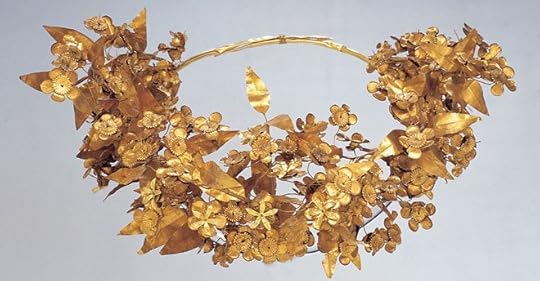 ΣÏÎÏÎ±Î½Î¿Ï ÏÎ·Ï ÎήδαÏ
ΣÏÎÏÎ±Î½Î¿Ï ÏÎ·Ï ÎήδαÏH ÏÏοÏÏÏαμÎνη ÎÏοÏÎµÎ¯Î±Ï ÎÏÏαιοÏήÏÏν ÎÎ¼Î±Î¸Î¯Î±Ï Î´Ï. αÏÏαιολÏγοÏ, κ. Îγγελική ÎοÏÏαÏίδη, ÏημειÏνει για Ïο ÏολÏÏιμο κÏÏμημα ÏÎ·Ï ÏÏ Î»Î»Î¿Î³Î®Ï ÏÎ¿Ï ÎÎ¿Ï ÏÎµÎ¯Î¿Ï ÏÏν ÎιγÏν...
ÎÏ Ïή Ïην δÏÏκολη Îνοιξη ÏÎ·Ï ÏÎ±Î½Î´Î·Î¼Î¯Î±Ï ÎºÎ±Î¹ ÏÎ¿Ï ÎµÎ³ÎºÎ»ÎµÎ¹ÏÎ¼Î¿Ï Î· μαÏιά Î¼Î¿Ï ÏÏαμαÏάει Ïε Îνα αÏÏ Ïα λιγÏÏεÏο διάÏημα εκθÎμαÏα, Ïην ολÏÏÏÏ Ïη ÏÏεÏάνη-διάδημα, ÏÏι εÏειδή είναι Îνα αÏÏ Ïα ÏÏαιÏÏεÏα και ÏÎ¯Î³Î¿Ï Ïα Ïο ÏÎ¿Î»Ï ÏιμÏÏεÏο κÏÏμημα ÏÎ·Ï ÎºÎ»Î±ÏÎ¹ÎºÎ®Ï ÎµÏοÏÎ®Ï ÏÎ¿Ï ÎÏÏαÏε ÏÏ ÎµÎ¼Î¬Ï, αλλά εÏειδή ο άγνÏÏÏÎ¿Ï ÎºÎ±Î»Î»Î¹ÏÎÏνηÏ-ÏÏÏ ÏοÏÏÎ¿Ï ÏÎ¿Ï Ïε ÏίÏοÏε δεν ÎÏει να ζηλÎÏει Ïον ÎÏενβενοÏÏο ΤÏελίνι αιÏμαλÏÏιÏε ÏÏÎ¹Ï ÏεÏιδινήÏÎµÎ¹Ï ÏÎ¿Ï Ïην ζÏογÏνο ÎδÎα ÏÎ·Ï Î±Î¹ÏÎ½Î¹Î±Ï ÎνοιξηÏ! ΧÏÏ ÏÏÏ 24 καÏαÏίÏν, κοκκίδÏÏη και ÏÏ ÏμαÏεÏÏ, οι Ïιο αÏαιÏηÏικÎÏ ÏεÏνικÎÏ ÏÎ·Ï Î±ÏÎ³Ï ÏοÏÏÏ ÏοÏοÎÎ±Ï ÏÏην Ïιο εκλεÏÏÏ ÏμÎνη εÏαÏμογή ÏÎ¿Ï Ï, εÏιÏÏÏαÏεÏονÏαι, Î²Î±Î¸Ï ÎºÏανο Î³Ï Î±Î»Î¯, Ï Î»Î¹ÎºÏ ÎµÎ¾Î±Î¹ÏεÏικά ÏολÏÏιμο ÏÏÏε, ÏÏ ÏεÏεÏαι Ïε ÏÏÏο μικÏοÏκοÏικÎÏ ÏÏÏÎ¼ÎµÏ ÏÎ¿Ï Î²Î¬Î¶Î¿Ï Î½ Ïε δοκιμαÏία ÏÎ¿Ï Ï Î½ÏÎ¼Î¿Ï Ï ÏÎ·Ï ÏÎ·Î¼ÎµÎ¯Î±Ï ÎºÎ±Î¹ ÏÎ·Ï ÏÏ ÏικήÏ, η γνÏÏη και η ÏÎÏνη Ïμίγει με Ïο μεÏάκι και Ïην Î±Î½Ï ÏÎÏβληÏη μαÏÏοÏιά και Îνα αÏιÏÏοÏÏγημα γεννιÎÏαι. ÎεÏÏεÏίλεÏÏα κλαδάκια, ÏÏείÏÎµÏ ÎºÎ±Î¹ ÎÎ»Î¹ÎºÎµÏ Î±ÏλÏνονÏαι ÏÏον ÏÏÏο, ÏλάθονÏÎ±Ï Î¼Î¹Î± δανÏÎλα αÏÏ ÏÏ Î¼Ïδη ÏÏÏ Ïά βλαÏÏάÏια. ΠανÏÎ¿Ï Î¾ÎµÏÏ ÏÏÏÎ½Î¿Ï Î½ Î»Î¿Ï Î»Î¿Ï Î´Î¬ÎºÎ¹Î±: ÏÏιανÏάÏÏ Î»Î»Î±, κÏίνοι και νάÏκιÏÏοι, μαÏγαÏίÏÎµÏ ÎºÎ±Î¹ ανεμÏÎ½ÎµÏ ÎºÎ¬Î¸Îµ λογήÏ. ÎαλοÏÏημαÏιÏμÎνα ÏÏ Î»Î»Î±Ïάκια Î¬ÎºÎ±Î½Î¸Î±Ï Î¶ÏνÏανεÏÎ¿Ï Î½ Ïα βλαÏÏάÏια, Î³ÎµÎ¼Î¯Î¶Î¿Ï Î½ Ïα κενά και κÏÏÎ²Î¿Ï Î½ ÎÎ¾Ï Ïνα ÏÎ¹Ï ÎµÎ½ÏÏειÏ. ΧÏÏ ÏÎÏ Î¼ÎµÎ»Î¹ÏÏοÏÎ»ÎµÏ ÏÎ¿Ï ÏοÏν Ïο νÎκÏÎ±Ï ÏÏν Î»Î¿Ï Î»Î¿Ï Î´Î¹Ïν ÏÎ¿Ï , ÏÏαν ÎºÎ¿Ï Î½Î¹ÎÏαι Ïο διάδημα, ÏÏεμοÏÎ±Î¯Î¶Î¿Ï Î½, αÏήνονÏÎ±Ï Î®ÏÎ¿Ï Ï Ïαν Ïο Î¶Î¿Ï Î¶Î¿ÏνιÏμα ÏÏν ενÏÏμÏν.ΠκαλλιÏÎÏÎ½Î·Ï Î±Ïοδίδει με ÏειÏÏικÏÏηÏα ÏÎ¹Ï Î¼Î¿ÏÏÎÏ ÏÏν ÏλαÏμάÏÏν ÏÎ¿Ï ÎºÎ±Î¹ Î´Î·Î¼Î¹Î¿Ï Ïγεί Ïην ενÏÏÏÏÏη «ÏÏ ÏικÏÏηÏαÏ» και ζÏνÏάνιαÏ. Το ÏÏ Î½Î¿Î½Î¸ÏÎ»ÎµÏ Î¼Î± ÏÏν Î»Î¿Ï Î»Î¿Ï Î´Î¹Ïν και ÏÏν ενÏÏμÏν, Ïα βλαÏÏάÏια ÏÎ¿Ï Î¼ÏλÎκονÏαι, ÏÏ ÏÏÏÎÏονÏαι και αÏλÏνονÏαι ÏανÏÎ¿Ï Î±Î½Î±ÎºÎ±Î»Î¿Ïν Ïην εικÏνα ÏÎ·Ï ÏÏÏÎ·Ï Ïην ʼνοιξη, ÏμÏÏ, αν κοιÏάξει ÎºÎ±Î½ÎµÎ¯Ï Ïιο ÏÏοÏεκÏικά, αναγνÏÏίζει Ïην Ï Ïοκείμενη Î±Ï ÏÏηÏή γεÏμεÏÏία ÏÎ·Ï Î´Î¿Î¼Î®Ï, Ïα ÏÏ Î¼Î¼ÎµÏÏικά εÏαναλαμβανÏμενα Î»Ï ÏÏÏÏημα και καÏδιÏÏÏημα μοÏίβα, Ïην ακÏιβοδίκαιη ανÏιÏÏοιÏία ÏÏν ελίκÏν και ÏÏο κÎνÏÏο Ïην ιεÏή ÏÏ Î¼Î¼ÎµÏÏία ÏÎ¿Ï Î¸ÎµÏÎºÎ¿Ï ÎºÏÎ¼Î²Î¿Ï , Î´Ï Î¿ βλαÏÏάÏια ÏÎ¿Ï Î´Î¹Î±ÏλÎκονÏαι ÏÏÏÏ ÏοÏÎ ÏÏην ÏÏÏη για να ÏÏημαÏίÏÎ¿Ï Î½ Ïο «ÎÏάκλειον άμμα», ÏÏμβολο ÏÎ¿Ï Î¸ÎµÎ¿Ï ÏÏοÏάÏοÏα ÏÏν ÎÏακλειδÏν, ÏαÏή αναÏοÏά ÏÏον βαÏÎ¹Î»Î¹ÎºÏ Î¿Î¯ÎºÎ¿ ÏÏν ÎακεδÏνÏν. Îι νÏμοι ÏÎ·Ï Î³ÎµÏμεÏÏÎ¯Î±Ï ÎºÎ¬Î½Î¿Ï Î½ Ïην ÎÏίÏη 'ÎÏÏμο', κÏÏμημα. ΦÏιαγμÎνα αÏÏ ÏÏÏ ÏάÏι, Ïην αθάναÏη Ïλη, Ïα εÏÏακÏα βλαÏÏάÏια, Ïα Î»Î¿Ï Î»Î¿Ïδια με Ïα Î²Î±Î¸Ï ÎºÏανα ÏÎÏαλα, οι μÎλιÏÏÎµÏ ÏÎ¿Ï Î¼ÎµÏÎ¿Ï ÏιÏÎ½Î¿Ï Î½ Ïο νÎκÏÎ±Ï Ïε μÎλι δεν ανÏιγÏάÏÎ¿Ï Î½ Ïην ÏÏÏη, αλλά αÏÎ¿Î´Î¯Î´Î¿Ï Î½ με ζÏνÏάνια και ακÏίβεια Ïαν Ï ÏÎÏοÏα ιδεογÏάμμαÏα Ïην Îννοια ÏÏν ÏνÏÏν. ΠκαλλιÏÎÏÎ½Î·Ï ÏÎ¿Ï Î´Î¹Î±Î´Î®Î¼Î±ÏÎ¿Ï ÏÏν ÎιγÏν δεν ÏÏοÏÏάθηÏε να αÏοÏÏ ÏÏÏει ÏÏ ÏιοκÏαÏικά μιαν εικÏνα ÏÎ·Ï Ê¼Î½Î¿Î¹Î¾Î·Ï Î±Î»Î»Î¬ Î±Ï Ïήν ÎºÎ±Î¸Î±Ï Ïή Ïην ʼνοιξη ÏÏ Î´Î¹Î±ÏÏονική, αναλλοίÏÏη και ζÏοδÏÏι ÎδÎα... ΣÏο κÎνÏÏο, εÏÎ¬Î½Ï Î±ÏÏ Ïον 'ιεÏÏ ÎºÏμβο', μÎÏα αÏÏ Ïον ÎºÎ¬Î»Ï ÎºÎ± ενÏÏ Î±Î½Î¸ÎµÎ¼Î¯Î¿Ï Î±Î½Î±Î´ÏεÏαι Îνα ÏεÏιÏÏεÏάκι, Ïο ιεÏÏ ÏÎ¿Ï Î»Î¯ ÏÎ·Ï ÎÏÏοδίÏηÏ, ÏÏμβολο ÏÎ¿Ï ÎÏÏÏα ÏÎ¿Ï Î´Î¹Î±Ïκεί για ÏάνÏα. Χαμηλά κάÏÏ Î±ÏÏ Î±Ï ÏÏν, ÏÏο μÎÏÏÏο ÏÎ·Ï ÏÏ ÏεÏÎ®Ï ÏÎ¿Ï Ïο ÏοÏοÏÏε, κÏÎμονÏαι δÏο μικÏοÏκοÏικά ÏÏδια, οι ιεÏοί καÏÏοί ÏÎ·Ï Î ÎµÏÏεÏÏνηÏ, ÏÏμβολα ÏÎ·Ï Î³Î¿Î½Î¹Î¼ÏÏηÏÎ±Ï ÏÎ¿Ï ÎºÎ±ÏιÏÏÏει ÏÎ¿Ï Î¸Î±Î½Î¬ÏÎ¿Ï .[2]
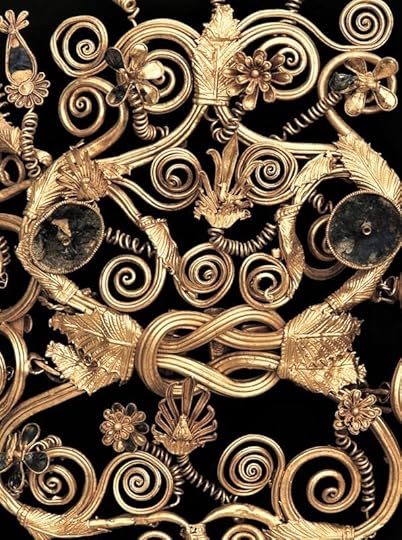

ÎεÏÏομÎÏεια (αÏιÏÏ.) ÏÎ¿Ï Î´Î¹Î±Î´Î®Î¼Î±ÏÎ¿Ï & εικÏνα ÎεÏÎ¿Î³ÎµÎ¹Î±ÎºÎ®Ï Î¼Ï ÏÏÎ¹Î¬Ï (δεξ.)
 ÎλληνικÏÏ ÏÏÏ
ÏÏÏ ÏÏÎÏÎ±Î½Î¿Ï Î¼Ï
ÏÏÎ¹Î¬Ï (The Museum of Fine Arts, HoustonGift of Miss Annette Finnigan)[5]
ÎλληνικÏÏ ÏÏÏ
ÏÏÏ ÏÏÎÏÎ±Î½Î¿Ï Î¼Ï
ÏÏÎ¹Î¬Ï (The Museum of Fine Arts, HoustonGift of Miss Annette Finnigan)[5]ΧÏÏ ÏÏÏ ÏÏÎÏÎ±Î½Î¿Ï Î¼Ï ÏÏÎ¹Î¬Ï Î¼Îµ ÎνθεÏÎ¿Ï Ï ÏÎ¿Î»Ï ÏÎ¯Î¼Î¿Ï Ï Î»Î¯Î¸Î¿Ï Ï ÏÏ Î»Î¬ÏÏεÏαι ÏÏο ÎÎ¿Ï Ïείο ÎÏÏÏεÏÎ¹ÎºÎ®Ï ÎογγολίαÏ, ÏÏ Î½Î¿Î´ÎµÏεÏαι δε αÏÏ Ï ÏÏμνημα ÏÏι είναι εÏÏημα ÏαÏανÏμÏν αναÏκαÏÏν ÏÏο Ulanqab και ÏÏονολογείÏαι ÏÏην ÏεÏίοδο ÏÏν Han 9200 Ï.Χ. ÎÏÏ 200 μ.Χ.).
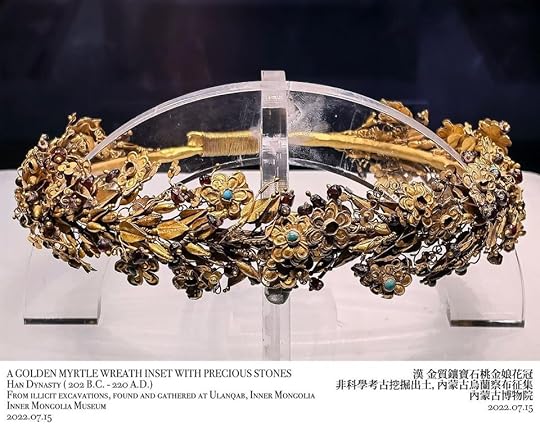
ÎÏÏ Ïην ίδια ÏεÏιοÏή ÏÎ¿Ï Ulancab ÏÏοÎÏÏονÏαι ÏεκμήÏια ÏÎ·Ï Î½ÎµÎºÏοÏÏλεÏÏ Yihe-Nur. μεÏικά ÏÏν οÏοίÏν εμÏÎ±Î½Î¯Î¶Î¿Ï Î½ Îλληνική ÏÏ ÏÏÎÏιÏη:[10]
 ÎÏγÏ
Ïά εÏίÏÏÏ
Ïη Ïιάλη με ανάγλÏ
Ïε κεÏαλÎÏ ÎλλήνÏν θεÏν[12]
ÎÏγÏ
Ïά εÏίÏÏÏ
Ïη Ïιάλη με ανάγλÏ
Ïε κεÏαλÎÏ ÎλλήνÏν θεÏν[12]ΣÎÎÎÎΩΣÎÎΣ
[1]. http://odysseus.culture.gr/h/4/gh430..... https://www.jewelpedia.com/news-39-23.... https://web.archive.org/web/201412022.... Chen Yongzhi, Song Guodong, Ma Yan 2016. [12]. Chen Yongzhi, Song Guodong, Ma Yan. 2016, p. 51, figs. 29, 30, color Pl. VI.Gilt-silver bowl [Figs. 29, 30; Color Pl. VI]. One of the most striking artefacts of all those excavated in the cemetery, this bowl, found in Tomb M1, is 14 cm in diameter and stands 4 cm high. The inside is smooth and has no decoration. The outside is framed by a pearllike band, and most of the surface covered by acanthus leaves in low relief set off against a gilded background.Four projecting âbossesâ depict characters from Greek mythology: Zeus, Hera, Aphrodite and Athena.ÎÏιÏÏÏ ÏÏμÎνη αÏÎ³Ï Ïά Ïιάλη [Îικ. 29, 30; ΧÏÏμα Πλ. VI]. Îνα αÏÏ Ïα Ïιο ενÏÏ ÏÏÏιακά ÏεÏÎ½Î¿Ï ÏγήμαÏα αÏÏ Î±Ï Ïά ÏÎ¿Ï Î±Î½Î±ÏκάÏηκαν ÏÏο νεκÏοÏαÏείο, Î±Ï ÏÏ Ïο ÏεκμήÏιο, ÏÎ¿Ï Î²ÏÎθηκε ÏÏον ÏάÏο Î1, ÎÏει διάμεÏÏο 14 cm και ÏÏÎ¿Ï 4 cm. Το εÏÏÏεÏÎ¹ÎºÏ ÎµÎ¯Î½Î±Î¹ λείο και δεν ÏÎÏει διακÏÏμηÏη. Το εξÏÏεÏÎ¹ÎºÏ ÏλαιÏιÏνεÏαι αÏÏ Î¼Î¹Î± μαÏγαÏιÏαÏÎνια Ïαινία και Ïο μεγαλÏÏεÏο μÎÏÎ¿Ï ÏÎ·Ï ÎµÏιÏÎ¬Î½ÎµÎ¹Î±Ï ÏÎ¿Ï ÎºÎ±Î»ÏÏÏεÏαι αÏÏ ÏÏλλα Î±ÎºÎ¬Î½Î¸Î¿Ï Ïε ÏÎ±Î¼Î·Î»Ï Î±Î½Î¬Î³Î»Ï Ïο ξεκινά ÏÎ¬Î½Ï Ïε Îνα εÏιÏÏÏ ÏÏμÎνο ÏÏνÏο.ΤÎÏÏεÏÎµÎ¹Ï ÎºÎµÏαλÎÏ ÏÎ¿Ï ÏÏÎ¿Î²Î¬Î»Î»Î¿Ï Î½ αÏÎµÎ¹ÎºÎ¿Î½Î¯Î¶Î¿Ï Î½ ÏαÏακÏήÏÎµÏ Î±ÏÏ Ïην ελληνική Î¼Ï Î¸Î¿Î»Î¿Î³Î¯Î±: Ïον Îία, Ïην ÎÏα, Ïην ÎÏÏοδίÏη και Ïην Îθηνά.
ÎÎÎÎÎÎÎΡÎΦÎÎ
http://odysseus.culture.gr/h/4/gh430....
https://www.academia.edu/3604218?fbcl... GraÅ¡ar, J., D. GavriloviÄ, E. NikoliÄ. 2012. "Wreath - Its use and meaning in ancient visual culture," in Religion and Tolerance, Journal of the Center for Empirical Researches on Religion 18 (Novi Sad, Vol. X, Nº 18), pp. 341-359.
Owen Jarus. 2017. "Silk-Covered Body Discovered at Inner Mongolia Cemetery," Live Science, <https://www.livescience.com/58630-anc... (31 Oct. 2022),"
https://edspace.american.edu/silkroad... Yongzhi, Song Guodong, Ma Yan. 2016. "The Results of the Excavation of the Yihe-Nur Cemetery in Zhengxiangbai Banner (2012-2014)," Silk Road 14, pp. 42-57.1908668286@qq.comp. 55: Hellenistic motifsp. 48: chin strap M1
October 12, 2022
ÎÏλÏÏ ÏÏλαÏÏÎ¿Ï Î»Î¿Î¹ÏÏν ο ÎÎνιοÏ...
ÎÏλÏÏ ÏÏλαÏÏÎ¿Ï Î»Î¿Î¹ÏÏν ο ÎÎÎ½Î¹Î¿Ï Î' (καθ' Î·Î¼Î¬Ï ÎγαμÎμνÏν ..)ΥΠΠÎÎ ÎÎÎΡÎÎΣÎÎΣÏο ÏαÏÏν Î' μÎÏÎ¿Ï ÏÎ¿Ï ÏÏολιαÏÎ¼Î¿Ï Î¼Î±Ï ÏÎ¿Ï Î²Î¹Î²Î»Î¯Î¿Ï ÎμηÏÎ¿Ï ÎºÎ±Î¹ ÎναÏολή ÏÏο ÏÏÎ±Ï ÏοδÏÏμι ÏÎ¿Ï ÎÎ¹Î³Î±Î¯Î¿Ï , ÎÏÏοÏία, ÎÏÏαιολογία, ÎÏ Î¸Î¿Î»Î¿Î³Î¯Î± θα εÏικενÏÏÏθοÏμε Ïε θÎμαÏα κοÏμογονίαÏ, Î¸ÎµÎ¿Î³Î¿Î½Î¯Î±Ï ÎºÎ±Î¹ εν γÎνει θÏηÏÎºÎµÏ Ïικά - Î¼Ï Î¸Î¿Î»Î¿Î³Î¹ÎºÎ¬.
Î' Î ÎΡÎΤÎΡÎΣÎ
ΣÏην Ïελ. 17 ο ΧανιÏÏÎ·Ï Î±Î½Î±ÏÎÏεÏαι ÏÏην ÏÏÎÏη ÏÎ¿Ï Î¼ÏÎ¸Î¿Ï ÏÎ¿Ï ÎÏ Î»Î»Î¹ÎºÎ¿Ïμμη με Ïον μÏθο ÏÎ¿Ï ÎÏιλλÎα, ÏαÏαÏÎμÏονÏÎ±Ï Ïε αÏÏÏÎµÎ¹Ï ÏÎ·Ï Bachvarova και άλλÏν, οι οÏÎ¿Î¯ÎµÏ Î±ÏÎ¿Î´Î¯Î´Î¿Ï Î½ ÏαÏακÏηÏιÏÏικά ÏÎ¿Ï ÎÏιλλÎÏÏ Î±Î»Î»Î¬ και ÎμηÏικά ÏÏοιÏεία, άν ÏÏι Ïλον Ïον εÏÎ¹ÎºÏ ÎºÏκλο (;),[1] Ïε εξ ÎναÏολÏν εÏιÏÏοή (ex oriente lux) ... .. Î¥ÏÎµÎ½Î¸Ï Î¼Î¯Î¶Î¿Ï Î¼Îµ ÎµÎ´Ï ÏÏι η Bachvarova, εξεÏάζονÏÎ±Ï Ïην ÏÏοÎÎ»ÎµÏ Ïη ÏÎ·Ï ÎμηÏÎ¹ÎºÎ®Ï ÎλιάδαÏ, καÏαλήγει Ïελικά ÏÏο ÏÏ Î¼ÏÎÏαÏμα ÏÏι οι ÏÏÏÏοι ÎÎ»Î»Î·Î½ÎµÏ Î¬Ïοικοι ÏÏην ÏεÏιοÏή ÏÎ·Ï Î¤ÏÏÎ¬Î´Î±Ï Î²Ïήκαν εκεί μιαν ήδη καθιεÏÏμÎνη, γηγενή ÎναÏολιακή ÏαÏάδοÏη για Ïην ÏÏÏÏη ÏÎ·Ï Î¤ÏοίαÏ, Ïην οÏοία ÏÏη ÏÏ Î½ÎÏεια ÏÏοÏάÏμοÏαν. ÎÏ Ïή η Î³Î·Î³ÎµÎ½Î®Ï ÏαÏάδοÏη διαμοÏÏÏθηκε - καÏά Ïην ίδια ÏάνÏα - αÏÏ ÏÎ¹Ï ÏαÏαδÏÏÎµÎ¹Ï ÏÎ·Ï ÎγγÏÏ ÎναÏÎ¿Î»Î®Ï Î¼Îµ Ïην μεÏολάβηÏη ÏÎ·Ï Î±Ï ÏοκÏαÏοÏÎ¯Î±Ï ÏÏν ΧεÏÏαίÏν. Î Bachvarova αναÏÏÏÏÏει μια λεÏÏομεÏή ÏÏÏÏμαÏογÏαÏία ÏÎ·Ï ÎλιάδαÏ, ÏÎ¿Ï ÏεÏιλαμβάνει μια ÏÏÏιμη Î»Î¿Ï Î²Î¹ÎºÎ® 'Wilusiad', μια μεÏαγενÎÏÏεÏη ΦÏÏ Î³Î¹ÎºÎ® ÏαÏάδοÏη για Ïην ÏÏÏÏη ÏÎ·Ï Î¤ÏοίαÏ, διάÏοÏÎµÏ ÏιθανÎÏ ÎµÎ»Î»Î·Î½Î¿ - αναÏολιακÎÏ Î´Î¯Î³Î»ÏÏÏÎµÏ ÏαÏαδÏÏÎµÎ¹Ï ÎºÎ±Î¹ Ïον ανÏαγÏνιÏÎ¼Ï Î¼ÎµÏÎ±Î¾Ï ÎιολÎÏν και ÎÏνÏν αοιδÏν ÏÏην ÎναÏολία. ÎÏ ÏÏ ÎµÎ¯Î½Î±Î¹ Îνα ÏÏνθεÏο Ï ÏÏδειγμα, ÏÎ¿Ï Î¼ÏοÏεί να αμÏιÏβηÏηθεί Ïε οÏιÏμÎÎ½ÎµÏ Î»ÎµÏÏομÎÏειεÏ, αλλά η ÏÏαγμαÏικÏÏηÏα ÏÏÎÏει - καÏά Ïον Elmer ÏÏην ÏÏεÏική βιβλιοκÏιÏία ÏÎ¿Ï - ÏÎ¯Î³Î¿Ï Ïα να ήÏαν ÏÎ¿Ï Î»Î¬ÏιÏÏον Ïο ίδιο ÏεÏίÏλοκη, αν ÏÏι ÏεÏιÏÏÏÏεÏο...[2]
Î ÏάγμαÏι ÎÏει διαÏιÏÏÏθεί ÏÏι αÏκεÏÎÏ Î±ÏηγημαÏικÎÏ Î»ÎµÏÏομÎÏÎµÎ¹ÎµÏ ÎµÎ¼ÏανίζονÏαι με ÏαÏÏμοιο ÏÏÏÏο ÏÏÎ¹Ï ÏαÏαλλαγÎÏ ÏÎ¿Ï Î¸ÎμαÏÎ¿Ï ÏÎ·Ï ÎαÏÎ¹Î»ÎµÎ¯Î±Ï ÏÏον ÎÏ ÏÎ±Î½Ï (Kingship in Heaven) ÏÎ¿Ï Î¤ÏÎ±Î³Î¿Ï Î´Î¹Î¿Ï ÏÎ·Ï ÎναδÏÏεÏÏ (Song of Going Forth)[3] και ÏÏην Îεογονία: οι ÏÏλοι ÏÏν βαÏιλÎÏν ÏÏον Î¿Ï ÏÎ±Î½Ï (Anu/ÎÏ ÏανÏÏ, Kumarbi/ÎÏÏνοÏ, ÎεÏÏ ÏÎ·Ï ÎºÎ±ÏÎ±Î¹Î³Î¯Î´Î±Ï (stormgod)/ÎεÏÏ), ο ÎµÏ Î½Î¿Ï ÏιÏμÏÏ ÏÎ¿Ï Anu/ÎÏ ÏÎ±Î½Î¿Ï ÏÏαν είÏε Ïην ÏÏÏÏοκαθεδÏία ÏÏν θεÏν, η ÏαÏÎ¿Ï Ïία ÏλήÏÏÏ Î±Î½ÎµÏÏÏ Î³Î¼ÎνÏν θεÏν μÎÏα ÏÏον Kumarbi/ÎÏÏνο καθÏÏ ÎºÎ±Î¹ η ÏÏοÏή με Î»Î¯Î¸Î¿Ï Ï ÎºÎ±Î¹ η εκÏÏÏμιÏή ÏÎ¿Ï Ï Î±ÏÏ Ïον Kumarbi/ÎÏÏνο, οι οÏοίοι ÏÏην ÏÏ Î½ÎÏεια καθίÏÏανÏαι ανÏικείμενο ÏεβαÏμοÏ.[4]
ÎμÏÏ Î¿Î¹ ομοιÏÏηÏÎµÏ ÎºÎ±Î¹ ÏαÏαλληλιÏμοί[5] οι οÏοίοι ÏÏάγμαÏι ενÏοÏίζονÏαι ÏÏην θεογονία λαÏν ÏÎ·Ï ÎναÏÎ¿Î»Î¹ÎºÎ®Ï ÎεÏÎ¿Î³ÎµÎ¯Î¿Ï Î±ÏÏ ÏÎ¿Ï Ï Beckman & Arbor αÏοδίδονÏαιÏÏην ÏÏαÏξη Î¼Î¹Î¬Ï Î Î¿Î»Î¹ÏιÏÏÎ¹ÎºÎ®Ï ÎÎ¿Î¹Î½Î®Ï ÏÎ·Ï ÏεÏιοÏÎ®Ï ÎºÎ±Î¹ ÏÏι Ïε μεÏάδοÏη ÏÏοÏÏÏÏν ÏÏÎ¿Ï Ï ÎÎ»Î»Î·Î½ÎµÏ Î¼ÎÏÏ ÏÎ·Ï ÎναÏολίαÏ![6]
[image error] ÎξÏÏÏ Î»Î»Î¿ ÏÎ¿Ï Î²Î¹Î²Î»Î¯Î¿Ï ÏÎ¿Ï Burkert[7]
Î Burkert αναλÏγÏÏ Ï ÏοÏÏηÏίζει (αναÏεÏÏÎ¼ÎµÎ½Î¿Ï ÏÏην αÏÏαÏκή ÏεÏίοδο):[8].. ÏÏην οÏοία, Ï ÏÏ Ïην εÏιÏÏοή ÏÎ·Ï ÏημιÏÎ¹ÎºÎ®Ï ÎναÏÎ¿Î»Î®Ï â αÏÏ ÏÏ Î³Î³ÏαÏείÏ, ÏεÏνίÏεÏ, εμÏÏÏÎ¿Ï Ï, θεÏαÏÎµÏ ÏÎÏ â ο ελληνικÏÏ ÏολιÏιÏμÏÏ Î¬ÏÏιÏε Ïη μοναδική ÏÎ¿Ï Î¬Î½Î¸Î·Ïη, για να αÏοκÏήÏει ÏÏνÏομα Ïην ÏολιÏιÏÏική ηγεμονία ÏÏη ÎεÏÏγειο (.. which, under the influence of the Semitic Eastâfrom writers, craftsmen, merchants, healersâGreek culture began its unique flowering, soon to assume cultural hegemony in the Mediterranean). ÎμÏÏ ÏÏοιÏείο ιÏÏοÏÎºÎµÏ Î®Ï ÏÎ¿Ï ÎµÏιβληÏικά κοÏμεί Ïο εξÏÏÏ Î»Î»Î¿ ÏÎ¿Ï Î²Î¹Î²Î»Î¯Î¿Ï ÏÎ¿Ï ÎºÎ±Î¹ ÏαÏακÏηÏίζεÏαι αÏÏ Ïον ίδιο ÏÏ 'βÏÏειο Î£Ï ÏιακÏ' αÏοδεικνÏεÏαι ÏÏι δεν ÏÏεÏείÏαι ÎνÏÎ¿Î½Î·Ï ÎÎ»Î»Î·Î½Î¹ÎºÎ®Ï ÏÏ ÏÏεÏίÏεÏÏ, Ï ÏονομεÏονÏÎ±Ï ÎÏÏι αÏÏ Ïην αÏÏή Ïην εÏιÏειÏημαÏολογία ÏÎ¿Ï ! Î£Ï Î³ÎºÎµÎºÏιμÎνα Ïο εÏÏημα ÏÏοÎÏÏεÏαι αÏÏ Ïο ÎÏαίον Î£Î¬Î¼Î¿Ï , ÏÏ Î»Î¬ÏÏεÏαι δε ÏÏο ÎÎ¿Ï Ïείο ÎαÏλοβαÏÎ¯Î¿Ï .[9] Î ÏÏκειÏαι για ÏÏομεÏÏÏίδιο ίÏÏÎ¿Ï , ενδεÏομÎνÏÏ Î»Î¬ÏÏ Ïο ÏÏοεÏÏÏμενο αÏÏ Ïην εκÏÏÏαÏεία ÏÏν ÎÏαμαίÏν ενανÏίον ÏÎ·Ï ÏολιÏÎ¹ÎºÎ®Ï Î¿Î½ÏÏÏηÏÎ¿Ï Patina/Unki, Ï Î²ÏÎ¹Î´Î¹ÎºÎ®Ï ÏÎ»Î·Î¸Ï ÏÎ¼Î¹Î±ÎºÎ®Ï ÏÏ ÏÏάÏεÏÏ, ÏεÏÎ¹Î»Î±Î¼Î²Î¬Î½Î¿Ï ÏÎ±Ï Î¹ÏÏÏ ÏÏ ÎÎ¹Î³Î±Î¹Î±ÎºÏ (ÎλληνικÏ) ÏÏοιÏείο. Î Palastin (Walastin εκ ÏÎ¿Ï Î¦Î¹Î»Î¹ÏÏαίοÏ) Ï ÏήÏξε μεγάλο και ιÏÏÏ ÏÏ Î¦Î¹Î»Î¹ÏÏαÏÎºÏ Î²Î±Ïίλειο ÏÏην Ïεδιάδα Amuq καÏά Ïο ÏÎÎ»Î¿Ï ÏÎ·Ï Î´ÎµÏ ÏÎÏÎ±Ï ÏιλιεÏÎ¯Î±Ï Ï.Χ. και μεÏά, Ïο οÏοίο ήλεγÏε Ïο ÏημανÏÎ¹ÎºÏ Î¸ÏηÏÎºÎµÏ ÏÎ¹ÎºÏ ÎºÎνÏÏο ÏÎ¿Ï Aleppo και Ïην ÏεÏιοÏή ÏÎ·Ï Hama, ÏεÏιλαμβάνονÏÎ±Ï ÏÎ¹Ï Patina/Unqi, Arpad και Hamath, γνÏÏÏÎÏ ÏολιÏικÎÏ Î¿Î½ÏÏÏηÏÎµÏ ÏÎ·Ï ÎÏοÏÎ®Ï ÏÎ¿Ï Î£Î¹Î´Î®ÏÎ¿Ï .[10]Î Î¯Î´Î¹Î¿Ï ÎλλανδÏÏ ÎµÏÎµÏ Î½Î·ÏÎ®Ï ÎµÎ½ÏοÏίζει ομοιÏÏηÏα μεÏÎ±Î¾Ï ÏÎ·Ï ÎÎ´Ï ÏÏÎµÎ¹Î±ÎºÎ®Ï ÏÎºÎ·Î½Î®Ï ÏÏÎ¿Ï Î· ΠηνελÏÏη Ïηγαίνει ÏÏην Ï ÏεÏÏα ÏÏοκειμÎÎ½Î¿Ï Î½Î± ÏÏοÏÎµÏ Ïηθεί ÏÏην Îθηνά εν ÏÏει ÏÎ·Ï Î±Î½Î±ÏÏÏήÏεÏÏ ÏÎ¿Ï Î¤Î·Î»ÎµÎ¼Î¬ÏÎ¿Ï , Od. 4. 759-767, και ÏÎ·Ï ÏÎºÎ·Î½Î®Ï ÏÏην Î¤Ï Ïική ÎκδοÏη ÏÎ¿Ï Gilgamesh,[11] ÏÏÎ¿Ï Î· Ninsun, μηÏÎÏα ÏÎ¿Ï Gilgamesh, ÏÏοβαίνει ÏÏην ίδια ÏÏάξη ανεÏÏÏμενη ÏÏην οÏοÏή, εν ÏÏει ÏÎ·Ï Î±Î½Î±ÏÏÏήÏεÏÏ ÏÏν Gilgamesh και Enkidu για Ïο εÏÎ¹ÎºÎ¯Î½Î´Ï Î½Î¿ Ïαξίδι ÏÎ¿Ï Ï ÏÏÎ¿Ï Ïον Humbaba.[12] Îνάλογη ÏÏοÏÎγγιÏη Î±ÎºÎ¿Î»Î¿Ï Î¸ÎµÎ¯ ο Burkert αναÏεÏÏÎ¼ÎµÎ½Î¿Ï ÏÏην καÏ' Î±Ï ÏÏν ειÏαγÏμενο ÎÏÏλλÏνα[13] αλλά ÏÏον θÏÏλο ÏÏν ÎÏÏά εÏί ÎÎ®Î²Î±Ï Ïον οÏοίον αÏοδίδει Ïε ÎεÏοÏοÏαμιακή εÏίδÏαÏη αÏÏ Ïον ÏοιηÏή Kabti-Ilani-Marduk ÏÎ·Ï ÏÎµÎ»ÎµÏ ÏÎ±Î¯Î±Ï ÏιλιεÏÎ¯Î±Ï Ï.Χ.,[14] άν και οι ÎλληνικÎÏ ÎμηÏικÎÏ Î±Î½Î±ÏοÏÎÏ Î¸ÎµÏÏοÏνÏαι αναγÏÎ¼ÎµÎ½ÎµÏ Ïε ÏÏÏÏεÏο ÏÏÏνο! Î Ïίν κλείÏÎ¿Ï Î¼Îµ Ïην αναÏοÏά Î¼Î±Ï ÏÏÎ¹Ï Î¸ÎÏÎµÎ¹Ï ÏÎ¿Ï Burkert ÏημειÏÎ½Î¿Ï Î¼Îµ Ïην άÏοÏή ÏÎ¿Ï ÏÏι οι ÎÎ»Î»Î·Î½ÎµÏ Î±Î½ÎÏÏÏ Î¾Î±Î½ ÏÏι Î±Ï Ïοί δανείÏÏηκαν αÏÏ Ïην ÎναÏολή, Ï ÏοÏÏηÏίζονÏÎ±Ï ÏÏι ÏλείÏÏα Îλληνικά ÏεÏÎ½Î¿Ï ÏγήμαÏα ÏÎ·Ï ÎναÏÎ¿Î»Î¯Î¶Î¿Ï ÏÎ±Ï ÏεÏιÏÎ´Î¿Ï Î¼ÏοÏοÏν καλλίÏεÏα να εÏÎ¼Î·Î½ÎµÏ Î¸Î¿Ïν ÏÏ ÎÏγα μεÏαναÏÏÏν αÏÏ Ïην ÎναÏολή, ÎµÎ½Ï Î´Î¹Î±ÏÏ ÏÏνει και Ïην ανιÏÏÏÏηÏη άÏοÏη ÏÏι οι ÎÎ»Î»Î·Î½ÎµÏ Îμαθαν για ÏÎ¿Ï Ï ÏÎ¯Î½Î±ÎºÎµÏ Î³ÏαÏÎ®Ï Î±Î»Î»Î¬ και ÏÎ¿Ï Ï Î´ÎµÏμάÏÎ¹Î½Î¿Ï Ï ÎºÏ Î»Î¯Î½Î´ÏÎ¿Ï Ï Î±ÏÏ Ïην ίδια ÎναÏολή,[15] αγνοÏνÏÎ±Ï Ïο ÏαÏελθÏν ÏÎ¿Ï Ï ÏÏο Îιγαίο ÏÎ·Ï ÎÏοÏÎ®Ï ÏÎ¿Ï Î§Î±Î»ÎºÎ¿Ï![16] Î ÏάγμαÏι ÏÏην ÎÏαμμική Î ÏÏ Î½Î±Î½ÏοÏμε Ïην λÎξη di-pte-ra-po-ro, ήÏοι διÏθεÏαÏÏÏοÏ, ÎµÎ½Ï ÏÏο ÎÏ ÎºÎ·Î½Î±ÏÎºÎ®Ï ÏÏ ÏÏεÏίÏεÏÏ Î½Î±Ï Î¬Î³Î¹Î¿ ÏÎ·Ï ÎνÏιÏÎÎ»Î»Î¿Ï (Uluburun) ÎÏÎ¿Ï Î½ Î±Î½ÎµÏ Ïεθεί ξÏÎ»Î¹Î½ÎµÏ ÏÏÏ ÎºÏÎÏ ÏÎ¹Î½Î±ÎºÎ¯Î´ÎµÏ Î³ÏαÏήÏ, η μία μάλιÏÏα ÏÎÏÎ¿Ï Ïα αÏιθμηÏικά ÏÎ·Ï ÎÏαμμικήÏ![17] ΣÏο ίδιο ÏνεÏμα ο ÏÏ Î³Î³ÏαÏÎÎ±Ï Î±Ïοδίδει ΣημιÏική καÏαγÏγή ÏÏην λÎξη δÎλÏοÏ, αγνοÏνÏÎ±Ï Ïην εναλλακÏική ÏÏ ÏÏÎÏιÏη με Ïο δαιδάλλÏ![18]
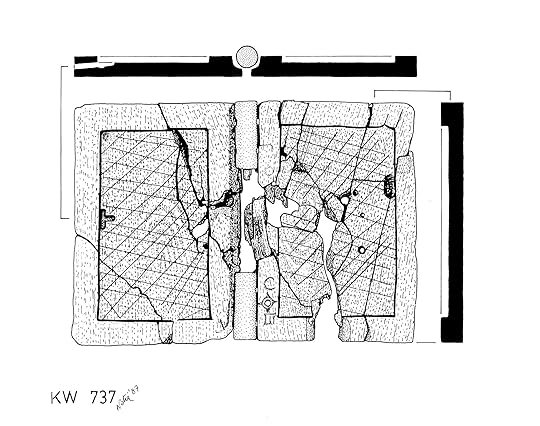 Το 'ÏÏÏÏο βιβλίο ÏοÏ
κÏÏμοÏ
' αÏÏ Ïο ναÏ
άγιο ÏÎ·Ï ÎνÏιÏÎλλοÏ
Το 'ÏÏÏÏο βιβλίο ÏοÏ
κÏÏμοÏ
' αÏÏ Ïο ναÏ
άγιο ÏÎ·Ï ÎνÏιÏÎλλοÏ
Îίναι Î½Î¿Î¼Î¯Î¶Î¿Ï Î¼Îµ ενδιαÏÎÏον να ÏημειÏÏÎ¿Ï Î¼Îµ ÎµÎ´Ï ÏÏι η Bachvarova θεÏÏεί ÏÏι Ïα αÏηγημαÏικά ÏÏαγοÏδια ÏÎ·Ï Î§Î¿Ï ÏÎ¹Î±Î½Î®Ï - ΧεÏÏιÏÎ¹ÎºÎ®Ï ÏαÏαδÏÏεÏÏ Ï ÏήÏξαν ÎÏγα ÏÎ·Ï Î»ÎµÎ³Î¿Î¼ÎÎ½Î·Ï ÏÏοÏοÏÎ¹ÎºÎ®Ï ÏαÏαδÏÏεÏÏ, με Ïην ÏειÏά ÏÎ¿Ï Ï Î´Îµ ÏÏ ÏÏεÏίζονÏαι ÏÏενά με Ïην ÏαÏάδοÏη ÏÎ·Ï ÎγγÏÏ ÎναÏολήÏ. ÎαÏά Ïην ίδια η ÏαÏάδοÏη καÏÎÏÏη διαθÎÏιμη - γνÏÏÏή ÏÏÎ¿Ï Ï Î±Î³ÏαμμάÏÎ¿Ï Ï[19] ÎλληνÏÏÏÎ½Î¿Ï Ï[20] αοιδοÏÏ ÏÎ·Ï ÎÏοÏÎ®Ï ÏÎ¿Ï Î£Î¹Î´Î®ÏÎ¿Ï Î¼ÎÏÏ ÏÎ·Ï ÏÏοÏοÏÎ¹ÎºÎ®Ï ÎµÎºÏοÏÎ¬Ï ÏÎ·Ï ÏιθανÏÏ ÏÏο ÎδαÏÎ¿Ï ÏÎ·Ï ÎναÏÎ¿Î»Î¯Î±Ï ÎºÎ±Ïά ÏÎ¿Ï Ï ÏÏÏÏÎ¿Ï Ï Î±Î¹ÏÎ½ÎµÏ ÏÎ·Ï ÏÎµÎ»ÎµÏ ÏÎ±Î¯Î±Ï Ï.Χ. ÏιλιεÏίαÏ..[21].
ÎÏÏÏμενοι ÏÏα Ï ÏÏ ÏÎ¿Ï ÎºÎ±Î¸Î·Î³Î·ÏÎ¿Ï Ï ÏοÏÏηÏιζÏμενα ÏημειÏÎ½Î¿Ï Î¼Îµ Ïα ακÏÎ»Î¿Ï Î¸Î± ..Î Î§Î¿Ï ÏιανÏÏ Î¼ÏÎ¸Î¿Ï Î¼Îµ ÏίÏλο Ïο "ΤÏαγοÏδι ÏÎ¿Ï Ullikummi" (ÏεÏ. 1200 Ï.Χ.) εÏιβιÏνει ÏÏην ΧεÏÏιÏική εκδοÏή ÏÎ¿Ï , εξ ανÏιγÏαÏÎ®Ï - ÏÏοÏαÏÎ¼Î¿Î³Î®Ï Î±ÏÏ Ïο Î§Î¿Ï ÏÎ¹Î±Î½Ï Ï ÏÏδειγμα, Ïε ÏÏÎµÎ¯Ï ÎºÎ±ÏακεÏμαÏιÏμÎÎ½ÎµÏ ÏÎ®Î»Î¹Î½ÎµÏ ÏÎ¹Î½Î±ÎºÎ¯Î´ÎµÏ ÏÎÏÎ¿Ï ÏÎµÏ ÎºÎµÎ¯Î¼ÎµÎ½Î¿ Ïε ÏÏηνοειδή,[22] αÏοÏελοÏμενο αÏÏ 300 γÏαμμÎÏ ÏεÏίÏÎ¿Ï .[23] ÎÏονÏÎ±Ï Î»Î¬Î²ÎµÎ¹ Ïο Ïνομά ÏÎ¿Ï Î±ÏÏ Ïο ομÏÎ½Ï Î¼Î¿ ÏÏ ÏÎ»Ï ÎºÎ±Î¹ κÏÏÏ Î»Î¯Î¸Î¹Î½Î¿ ÏÎÏαÏ, η ιÏÏοÏία ÏεÏιγÏάÏει ÏÎ¹Ï Î¼Î·ÏανοÏÏαÏÎ¯ÎµÏ ÏÎ¿Ï Kumarbi, ενÏÏ Î¼Î½Î·ÏÎ¯ÎºÎ±ÎºÎ¿Ï ÎµÎºÎ¸ÏονιÏμÎÎ½Î¿Ï Î¸ÎµÎ¿Ï, ο οÏÎ¿Î¯Î¿Ï ÎµÏÎ¹Î¸Ï Î¼ÎµÎ¯ να ÏÏεÏεÏιÏÏεί Ïον θÏÏνο αÏÏ Ïον Ï Î¹Ï ÏÎ¿Ï , Î¸ÎµÏ ÏÎ·Ï Î¸ÏÎµÎ»Î»Î±Ï Tesub. Îια Ïην εÏιÏÏ Ïία ÏÎ¿Ï ÎµÎ³ÏειÏήμαÏÏÏ ÏÎ¿Ï Î¿ Kumarbi ÏÏ Î½ÎµÏ ÏίÏκεÏαι εÏÏÏικά με βÏάÏο και ÎÏÏι ÏÏοκÏÏÏει εκ ÏÎ¿Ï Î»Î¯Î¸Î¿Ï Î³ÎνεÏη ÏνÏÎ¿Ï Î±ÏκεÏά ιÏÏÏ ÏÎ¿Ï ÏÏÏε να καÏαÏÏÏÎÏει ÏÎ¿Ï Ï Î¸ÎµÎ¿ÏÏ, ο μÏÎ¸Î¿Ï Î´Îµ ÏαÏαβάλλεÏαι ÏÏÎ¿Ï Î±Ï ÏÏν ÏÎ¿Ï Î¤Ï ÏÏνοÏ. Î£Ï Î¼ÏεÏαÏμαÏικά και εν ÏÏ Î½ÏÏει ÏÎÏÎ±Ï Ïο οÏοίο αÏοÏÏÎλλεÏαι αÏÏ ÏÎ¹Ï ÎºÎ±Î¸Î±Î¹ÏεθείÏÎµÏ ÏαλαιÎÏ Î´Ï Î½Î¬Î¼ÎµÎ¹Ï ÏÏν θεÏν αÏειλεί Ïον νÎο Î¸ÎµÏ ÏÏο ÎάÏιον ÏÏÎ¿Ï (Î£Ï Ïία), καÏά δε Ïον Guterbock[24] οι διαÏοÏÎÏ Î¼ÎµÏÎ±Î¾Ï ÏÏν διαÏÏÏÏν εκδοÏÏν (ÎÎ±Î²Ï Î»ÏνιακÏν, Î§Î¿Ï ÏιανÏν, ÎλληνικοÏ) ÎγκεινÏαι ÏÏÎ¹Ï Î»ÎµÏÏομÎÏÎµÎ¹ÎµÏ ÎºÎ±Î¹ ÏÏο ÏÏÎ¿Ï - ÏνεÏμα. ÎιακÏÏÏονÏÎ±Ï Î®, μάλλον, ÏεÏμαÏίζονÏÎ±Ï Ïην αÏήγηÏή Î¼Î±Ï ÏÎ¿Ï ÏÏ Î³ÎºÎµÎºÏιμÎÎ½Î¿Ï Î¼ÏÎ¸Î¿Ï ÏημειÏÎ½Î¿Ï Î¼Îµ ÎµÎ´Ï ÏÏι η Îννοια ÏÎ·Ï Î³Î®Ï Î¼Î·ÏÏÏÏ (terra mater) εκÏιμάÏαι ÏÏι είÏε διαμοÏÏÏθεί ήδη αÏÏ Ïην νεολιθική ÏεÏίοδο, και μάλιÏÏα ενείÏε ÏαÏακÏηÏιÏÏικά ÏÎ¿Ï ÎµÏιÏÏÏÏθεÏα ÏÏ Î½Îδεαν Ïην γή και με Ïο Ï Î´Î¬Ïινο ÏÏοιÏείο,[25] ÏÏÏÏ ÏαίνεÏαι να ÏÏ Î¼Î²Î±Î¯Î½ÎµÎ¹ καÏά Ïο ÏÏÏÏο ÏκÎÎ»Î¿Ï ÏÏον μÏθο ÏÎ¿Ï Ullikummi ÎµÎ½Ï ÎºÎ±Ïά Ïο δεÏÏεÏο μοιάζει να εκÏÏάζεÏαι, μεÏÎ±Î¾Ï ÏÏν άλλÏν, ÏÏον άλλο Î§Î¿Ï ÏÎ¹Î±Î½Ï Î¼Ïθο, Ïο "ΤÏαγοÏδι ÏÎ¿Ï Hedammu". Το ÏÎµÎ»ÎµÏ Ïαίο, ÏÏζÏμενο εÏίÏÎ·Ï ÏÏην ΧεÏÏιÏική εκδοÏή ÏÎ¿Ï Î±ÏÏ Ïην ÏεÏίοδο ÏÎ¿Ï ÎÎÎ¿Ï Î§ÎµÏÏιÏÎ¹ÎºÎ¿Ï Î²Î±ÏÎ¹Î»ÎµÎ¯Î¿Ï [26] Ïε μιά ανάλογη εξιÏÏÏÏηÏή ÏÎ¿Ï ÏάÏεÏν ÏÎ·Ï Î³ÎµÎ½ÎµÎ±Î»Î¿Î³Î¯Î±Ï ÏÏν θεÏν ÏεÏιλαμβάνει Ïην γÎνεÏη ιÏÏÏ ÏÎ¿Ï ÏÎÏαÏÎ¿Ï Î±Ï Ïήν Ïην ÏοÏά αÏÏ Ïην θάλαÏÏα ..
ΣÏα ÏλαίÏια Î¼Î¹Î¬Ï Î¹Î´Î¹ÏμοÏÏÎ·Ï ÏάÏεÏÏ Î³Î¹Î± ÏÎµÏ Î´Î¿ - εÏιÏÏημονική οÏθÏÏηÏα, Î±Ï Î±ÏοκαλÎÏÎ¿Ï Î¼Îµ ÎÏÏι με Ïην ÏειÏά Î¼Î±Ï Ïον ÏÏο scientifically correct, είμαÏÏε μάÏÏÏ ÏÎµÏ ÏÏοÏÏαθειÏν εÏÎµÏ Î½Î·ÏÏν οι οÏοίοι ÏÏ Î½Î±Î³ÏνίζονÏαι ÏÏοκειμÎÎ½Î¿Ï Î½Î± ενÏοÏίÏÎ¿Ï Î½ και αναγνÏÏίÏÎ¿Ï Î½ νÎα ÏεκμήÏια για Ïην εξάÏÏηÏη ÏÏν ÎμηÏικÏν εÏÏν αλλά και ÏÎ¿Ï Î¼ÎÏÏÎ¿Ï Î±ÏÏ ÎναÏολικά αÏÏÎÏÏ Ïα,[27] ex oriente lux. ÎÏÏι ÏÏο αÏÏÏÏαÏμα ÏÎ·Ï ÎÎ»Î¹Î¬Î´Î¿Ï 16.33-35 ανακαλÏÏÏονÏαι νÎÎµÏ ÎµÏιÏÏοÎÏ Î±ÏÏ Ïην ÎγγÏÏ ÎναÏολή. Î£Ï Î³ÎºÎµÎºÏιμÎνα η ÎλεÏÎ¯Î´Î¿Ï ÏημειÏνει:[28]ÎÏ ÏÏ Ïο άÏθÏο εÏανεξεÏάζει Ïο ÏεÏίÏημο ÏÏÏλιο ÏÎ¿Ï Î Î±ÏÏÏÎºÎ»Î¿Ï Î³Î¹Î± Ïην ÏκληÏÏÏηÏα ÏÎ¿Ï ÎÏιλλÎα, ÏÏο οÏοίο η θάλαÏÏα και οι βÏάÏοι Î±Î½Î±Î»Î±Î¼Î²Î¬Î½Î¿Ï Î½ Ïον ÏÏλο ÏÏν γονÎÏν ÏÎ¿Ï ÏÎµÎ»ÎµÏ ÏÎ±Î¯Î¿Ï (Îλ. 16.33â35). Îι ÏÏίÏοι ανÏικαÏοÏÏÏÎ¯Î¶Î¿Ï Î½ μÏÎ¸Î¿Ï Ï ÏÎ·Ï ÎγγÏÏ ÎναÏÎ¿Î»Î®Ï ÏÏεÏικά με Ïη γÎννηÏη αÏειληÏικÏν ÏλαÏμάÏÏν αÏÏ Ïην θάλαÏÏα και ÏÎ¿Ï Ï Î²ÏάÏÎ¿Ï Ï ÎºÎ±Î¹ ÏÏ Î½Î´ÎονÏαι ιδιαίÏεÏα με Ïο ΤÏαγοÏδι ÏÎ¿Ï Hedammu και Î±Ï ÏÏ ÏÎ¿Ï Ullikummi ÏÎ·Ï Î§Î¿ÏÏο-ΧεÏÏιÏÎ¹ÎºÎ®Ï ÏαÏαδÏÏεÏÏ. ÎεμαÏικοί, Î¼Ï Î¸Î¿Î»Î¿Î³Î¹ÎºÎ¿Î¯ και ÏÏαÏεολογικοί ÏαÏαλληλιÏμοί μεÏÎ±Î¾Ï Î±Ï ÏÏν ÏÏν κειμÎνÏν ÏÏ Î¶Î·ÏοÏνÏαι ÏÏοκειμÎÎ½Î¿Ï Î½Î± διεÏÎµÏ Î½Î·Î¸ÎµÎ¯ η ÏÏαÏξη ενÏÏ ÎºÎ¿Î¹Î½Î¿Ï Î¸ÎμαÏÎ¿Ï Î¼Îµ ÏÏ Î³ÎºÎµÎºÏιμÎÎ½ÎµÏ ÏÏ Î½Î´Î·Î»ÏÏÎµÎ¹Ï ÏÏην ÎµÏ ÏÏÏεÏη ÏεÏιοÏή ÏÎ·Ï ÎÏ ÏÎ¹ÎºÎ®Ï ÎÏίαÏ.Î ÏÏκειÏαι ÏÏ Î³ÎºÎµÎºÏιμÎνα για Ïο Ïημείο ÏÏÎ¿Ï Î¿ ΠάÏÏÎ¿ÎºÎ»Î¿Ï ÏÏÏεÏÏÎ¼ÎµÎ½Î¿Ï ÎµÎ½Î±Î½Ïίον ÏÎ¿Ï ÎÏιλλÎÏÏ Î³Î¹Î± Ïην αÏÏαξία ÏÎ¿Ï , ÏαÏά ÏÎ¹Ï Î´Ï ÏÎ¼ÎµÎ½ÎµÎ¯Ï Î³Î¹Î± ÏÎ¿Ï Ï ÎÏαιοÏÏ ÎµÎ¾ÎµÎ»Î¯Î¾ÎµÎ¹Ï, ÏÎ¿Ï ÎºÎ±Ïαλογίζει: οá½Îº á¼Ïα Ïοί γε ÏαÏá½´Ï á¼¦Î½ á¼±ÏÏÏÏα ΠηλεÏÏ,/ οá½Î´á½² ÎÎÏÎ¹Ï Î¼Î®ÏηÏËÎ³Î»Î±Ï Îºá½´ δΠÏε ÏίκÏε θάλαÏÏα /ÏÎÏÏαι Ïá¾½ ἠλίβαÏοιΠÏÏοÏÏÏινή, ÏÏÏÏ Î³Î½ÏÏÎ¯Î¶Î¿Ï Î¼Îµ, αÏÏαξία ÏÎ¿Ï ÎÏιλλÎÏÏ, αÏαÏαίÏηÏη ÏμÏÏ Î³Î¹Î± Ïην κοÏÏÏÏÏη ÏÎ¿Ï ÎµÎ½Î´Î¹Î±ÏÎÏονÏÎ¿Ï Î±Î»Î»Î¬ και Ïην ÏαÏÎ¿Ï ÏίαÏη αμÏοÏÎÏÏν ÏÏν ÎιοÏκοÏÏειÏν ÏÎ»ÎµÏ ÏÏν ÏÎ¿Ï Î®ÏÏοÏ, αÏοδίδεÏαι λοιÏÏν ÏÏο ÏÏÏίο ÏÏην γÎννηÏή ÏÎ¿Ï ÏÏι αÏÏ Ïον ΠηλÎα και Ïην ÎÎÏιδα αλλά αÏÏ Ïην θάλαÏÏα και ÏÎ¿Ï Ï Î»Î¯Î¸Î¿Ï Ï (ÏÏήλαια, βÏάÏÎ¿Ï Ï). Î ÏÏάÏη ÎÏει εÏÎ¼Î·Î½ÎµÏ Ïεί αÏÏ Ïον Janko ÏÏ Î¿ÏειλÏμενη Ïε μιά γενική ανÏίληÏη αÏÎ¿Î´Î¯Î´Î¿Ï Ïα Ïην γÎννηÏη ÏÎ·Ï Î±Î½Î¸ÏÏÏÏÏηÏÎ±Ï Ïε ÏÏÏÏαÏÏικά ÏÏοιÏεία, ÏμÏÏ Î· εÏιÏÏημονική οÏθÏÏÎ·Ï Î´Ï ÏκολεÏεÏαι να αÏοδεÏθεί Ïην άÏοÏη .. ÎÏÏ Ïην άλλη ÏειÏά ÏαλαιÏν αλλά και ÏÏγÏÏονÏν ÏÏολιαÏÏÏν ÏÎ¿Ï ÎμήÏÎ¿Ï Î¸ÎµÏÏοÏν ÏÏι η θάλαÏÏα και οι βÏάÏοι αÏοÏελοÏν μεÏÏÎ½Ï Î¼Î¯Î± ÏÎ·Ï ÎÎÏÎ¹Î´Î¿Ï ÎºÎ±Î¹ ÏÎ¿Ï Î Î·Î»ÎÏÏ, αλλά και Î±Ï Ïή η θεÏÏηÏη αÏοÏÏίÏÏεÏαι εÏίÏÎ·Ï ÏÏ Î¼Î· ÏÏ Î¼Î²Î¹Î²Î±Î¶Ïμενη με Ïην ÏÏοκÏοÏÏÏεια κλίνη ÏÎ¿Ï ÎναÏολιÏÎ¼Î¿Ï .. εÏίÏηÏ...
Îξίζει να ÏÏοÏÏεθεί ÎµÎ´Ï ÏÏι η ÎλεÏÎ¯Î´Î¿Ï ÎµÏιÏειÏεί να ενÏάξει Ïον ÎÏιλλÎα ÏÏÎ¿Ï Ï Î±Î½ÏαγÏνιÏμοÏÏ ÏÏν θεÏν, ÏημειÏνονÏÎ±Ï ÏÏι ο ΠίνδαÏÎ¿Ï ÏÏα ÎÏθμια, Isth. 8.27â45, Ïον ÏαÏακÏηÏίζει ÏÏ Î´Ï Î½Î·Ïική αÏειλή για Ïην θεÏκή ÎµÎ¾Î¿Ï Ïία ÏÎ¿Ï ÎιÏÏ![29]
ÎαÏαληκÏικÎÏ ÏαÏαÏηÏήÏειÏΧÏÏÎ¯Ï Î½Î± αÏοÏÏίÏÏÎ¿Ï Î¼Îµ ÏÎ¹Ï ÎµÏαÏÎÏ ÎºÎ±Î¹ εÏιÏÏοÎÏ Î±ÏÏ Ïην ÎεÏοÏοÏαμία, θεÏÏοÏμε ÏÏι - μάλλον - Ïο ÎµÎ´Ï ÏÏολιαζÏμενο βιβλίο ÏÏÏÏ ÎºÎ±Î¹ Ïο νεÏÏεÏο ÏÎ¿Ï 2022[30] Î±ÎºÎ¿Î»Î¿Ï Î¸ÎµÎ¯ Ïο ÏεÏμα ÎÎ ÎÎÎΤÎÎΩΠΤΠΦΩΣ ..ÎÏο μÏνον ÏαÏαÏηÏήÏειÏ: (α) ΠμÏÎ¸Î¿Ï ÏÎ¿Ï ÎÎ´Ï ÏÏÎÏÏ ÎºÎ±Î¹ Î Î¿Î»Ï ÏÎ®Î¼Î¿Ï ÎÏει Ï ÏοÏÏηÏιÏθεί ÏÏι διαθÎÏει ÏÏοιÏεία κληÏονομημÎνα αÏÏ Ïο αÏÏÏαÏο ÏαÏελθÏν, βλ. άνάÏÏηÏή Î¼Î¿Ï : ODYSSEUS & POLYPHEMOS ÏÏο ιÏÏολÏγιο: https://dnkonidaris.blogspot.com/ (β) Î ÏαÏακÏήÏÎ±Ï HUMBABA μÏοÏεί να θεÏÏηθεί ÏαÏÎ¬Î»Î»Î·Î»Î¿Ï Î±Ï ÏoÏ ÏÎ·Ï ÎÎΡÎÎΥΣ - ÎÎÎÎΥΣÎΣ για Ïην οÏοία Ï ÏοÏÏηÏίζεÏαι: ΠΡÎΪΣΤÎΡÎÎÎ ÎÎÎÎÎÎÎÎ Î ÎÎΤÎÎΩÎΠΤÎΣ ÎÎΡÎÎΥΣ - ÎÎÎÎΥΣÎΣ ; (prehistoric in time and wider Aegean origin of gorgonâmedousaâgorgonâs head - gorgoneion - repulsive image)
Î¥ÎÎÎÎ
-----------------------------------------------------------------------------------------------------------------------------https://www.degruyter.com/document/do... Oreshko. 2018. "Anatolian linguistic influences in Early Greek (1500â800 BC)? Critical observations against sociolinguistic and areal background," Journal of Language Relationship 16 (2), pp. 93â118... It would be fair to say that the existence of some cultural influence of Anatolia on Greek language and literature which may be dated as far back as the LBA is at present taken practically for granted. The assessments of the extent and depth of this influence, as well as of its exact source (the Hittites, the Luwians or some other peoples of Western or Southern Anatolia), may vary considerably from scholar to scholar, but the very idea seems to have assumed by now in the eyes of many (if not all) the quality of an established fact, mirroring in a way a similar process of ârecognitionâ of more general âOrientalâ influences in the early Greek literature. This belief is rooted in the obvious fact of immediate geographic proximity of Anatolia and the Aegean, in the somewhat less obvious but still demonstrable fact of contacts between the Mycenaean Greeks and Anatolian peoples and, lastly, in a far more problematic âand often subconscious â belief that Anatolia as a part of the Ancient Near East was culturally superior to the Aegean world in the Late Bronze Age, which should allegedly have automatically made the Greeks receptive to cultural impulses from this region. The underlying belief in the importance of the Anatolian factor for the Early Greek language and literature generated over the years an imposing (even if not all too dense) swarm of publications claiming to have found one or the other concrete instance of Anatolian or, to apply the term most frequently used for the most part of the 20th century, Hittite influence in the domain of Greek vocabulary, morphology or phraseology.2
p. 113: The results of this survey are certainly rather discouraging: considering the evidence soberly and without obsessive concentration exclusively on Anatolian and Greek, one should state that among the most frequently cited cases there is not a single one which may be properly qualified as contact-induced borrowing from an Anatolian language into Greek dating to the Late Bronze Age or Early Iron Age. p. 114: Similarly, the absence of bilingual communities makes it rather unlikely that the Greeks had any access to Anatolian literary texts (oral or written) and, consequently, an explanation for any eventual similarities in phraseology or literary themes between Greece and Anatolia â or, wider, the Ancient Near East â should be sought along different lines, such as generic or typological similarity, common heritage or common cultural experience.
-----------------------------------------------------------------------------------------------------------------------------ΠΠεÏÏÏÏÎ¿Ï Î»Î¿Ï ÏαÏαÏÎμÏει - και ÏαίνεÏαι ÏÏι ÏÏ Î¼ÏÏνεί - ÏÏον Griffin, Ï ÏοÏÏηÏικÏή ÏÎ·Ï ÎºÎ±Î¸ÏÎ´Î¿Ï ÏÏν 'ÏÏογÏνÏν ÏÏν ÎλλήνÏν' ÏÏον ÏÏÏο Ïο 1900 (άÏοÏη ήδη μη αÏοδεκÏή ..) [The Oxford History of Greece & the Hellenistic World, John Boardman, Jasper Griffin, Oswyn Murray, 1986, p. 4], διαÏοÏοÏοιεί ÏÎ¿Ï Ï ÎακεδÏÎ½ÎµÏ Î±ÏÏ ÏÎ¿Ï Ï Î¬Î»Î»Î¿Ï Ï ÎλληνεÏhttps://books.google.gr/books?redir_e..., J. 1986. "Greek myth and Hesiod," in The Oxford History of Greece & the Hellenistic World, ed. J. Boardman, J. Griffin, O. Murray, 1986, pp. 82-106.
Î ÎΤΡ.... Îια Ïην ελληνική Î¼Ï Î¸Î¿Î»Î¿Î³Î¯Î±, η οÏοία βαÏίζεÏαι ÏÏην εξελιγμÎνη μοÏÏή ÏÎ¿Ï Î¸ÏηÏÎºÎµÏ ÏÎ¹ÎºÎ¿Ï Î²Î¯Î¿Ï ÏÎ·Ï Î±ÏÏÎ±Î¯Î±Ï ÎλλάδαÏ,[4] [Griffin ..
ÎαÏακάνÏζα, ÎακÏβ Îανιήλ, Gordon, ÎμηÏÎ¿Ï ÎºÎ±Î¹ ÎÎ¯Î²Î»Î¿Ï !!http://digital.lib.auth.gr/record/159... Î ÎÎ ÎÎ¥ÎÎÎÎΣ!1-----------------------------------------------------------------------------------------------------------------------------https://books.google.gr/books?id=Cnkf..., A. R. 2010. "The Epic of Gilgamesh," in The Cambridge Companion to the Epic, ed. C. Bates, Cambridge University Press, pp. 1-12.
Standard Babylonian epic of the first millennium
George 2010 <https://hozir.org/chapterid-978052188.... 4: The Sumerian poems report some of the same legends and themes as parts of the Babylonian poem, but they are independent compositions and do not form a literary whole. The Sumerian and Babylonian poems shared more than just a common literary inheritance, whether that was oral (asseems likely) or written...Altogether these eleven Old Babylonian manuscripts provide several disconnected episodes in a little over six hundred lines of poetry. S---------------------------------------------------------------------------------------------------------------------------Yoram Cohen. 2016. Rev. of M. R. Bachvarova, From Hittite to Homer: The Anatolian Background of Ancient Greek Epic, in BMCR 2016.11.14, <https://bmcr.brynmawr.edu/2016/2016.1... (19 April 2021).-----------------------------------------------------------------------------------------------------------------------------https://www.researchgate.net/publicat..., A. S. W. 2011. "Speech from Tree and Rock: Recovery of a Bronze Age Metaphor," American Journal of Philology 136 (1), pp. 1-35.Interpreters of archaic Greek epic poetry have long labored to explain the meaning of the semantically ambiguous phrase involving "tree (delta rho nu(sic)) and/or rock (pi epsilon tau rho eta)." The idiom appears three times in archaic epic: in the proem of Hesiod's Theogony, during Hector's deliberation about negotiating a truce in Iliad 22, and in Penelope's speech to a disguised Odysseus in Odyssey 19. A tantalizingly similar, and equally unsolved idiom, rgm w Ihst 'abn, appears in the thirteenth-century Ugaritic Ba'al Cycle found at Ras Shamra. Current scholarship agrees that this phrase connotes ideas of prophecy. This article argues that the phrase's history can be traced further back to a metaphor describing the audio-visual phenomenon of lightning and thunder as the storm-god's oracular speech. Crucial evidence for this account is found in Bronze Age material culture.---------------------https://www.metmuseum.org/toah/hd/gil...
ΣÎÎÎÎΩΣÎÎΣ
[1]. Elmer 2017. ÎλλÏÏÏε Ïο 'ÏÏαγοÏδι ÏÎ¿Ï Ullikummi' αναγνÏÏίÏÏηκε αÏÏ Ïην αÏÏή ÏÏ ÏÏοκάÏοÏÎ¿Ï Î® Ï ÏÏδειγμα ÏÏν ελληνικÏν μÏθÏν ÏÎ¿Ï ÎÏιÏÎ´Î¿Ï . ΠαÏαλληλιÏμοί με Ïον ÎµÎ»Î»Î·Î½Î¹ÎºÏ Î¼Ïθο ÏÎ¿Ï Î¤Ï ÏÏνα, ÏÎ¿Ï Î±ÏÏÎ±Î¯Î¿Ï Î±Î½ÏαγÏνιÏÏή ÏÎ¿Ï Î¸ÎµÎ¿Ï ÏÏν κεÏÎ±Ï Î½Ïν Îία, ÎÏÎ¿Ï Î½ διαÏÏ ÏÏθεί αÏÏ Ïον Burkert[2]. dbpedia, s.v. Ullikummi (https://dbpedia.org/page/Ullikummi): Î ÏÏεÏική αναÏοÏά ÏÎ¿Ï Elmer (Ï.Ï.) ÎÏει ÏÏ ÎµÎ¾Î®Ï: In accounting for the origins of the Homeric Iliad, Bachvarova eventually concludes that the earliest Greek settlers in the region of the Troad found there an already established, native Anatolian tradition about the fall of Troy, which they subsequently adapted. This native tradition was itself shaped by Near Eastern traditions mediated by the Hittite Empire. Bachvarova develops a detailed stratigraphy of the Iliad, involving an early Luwian âWilusiad,â a later Phrygian tradition about the fall of Troy, various possible Greco-Anatolian bilingual traditions, and rivalry between Aeolic and Ionic singers in Anatolia (summary on 453â57). This is a complex model, open to question in some particulars, but the reality must surely have been at least as complex, if not more...[3]. van Dongen 2012, p. 25. ΠδιαÏÏθείÏα ΧεÏÏιÏική εκδοÏή ÏÎ¿Ï ÎÏÎ³Î¿Ï ÏÏοÎÏÏεÏαι αÏÏ Ïην Ïινακίδα CTH 344, ÏÏονολογοÏμενη ÏÏα ÏÎλη ÏÎ¿Ï Î§ÎÎΠαι. Ï.Χ., ÏμÏÏ Î¸ÎµÏÏείÏαι ÏÏι ÏÏοÎÏÏεÏαι αÏÏ ÏαλαιÏÏεÏο Ï ÏÏδειγμα![4]. van Dongen 2010, p. 142. Το ÏÏÏÏÏÏÏ Ïο κείμενο ÎÏει ÏÏ ÎµÎ¾Î®Ï:In section 4.1.3, several narrative details were found to feature similarly in the variants of the âKingship in Heavenâ-theme of the Song of Going Forth and the Theogony: the roles of the kings in heaven (Anu/Ouranos, Kumarbi/Kronos, stormgod/Zeus), the castration of Anu/Ouranos when he is king of the gods, the presence of full-grown gods inside Kumarbi/Kronos, and the feeding to and spitting out of a stone by Kumarbi/Kronos, which subsequently becomes an object of veneration. [5]. ΧαÏακÏηÏιÏÏική ομοιÏÏηÏα είναι Î±Ï Ïή ÏÎ¿Ï ÏÏεÏίζεÏαι με Ïην γÎνεÏη ÏÎ·Ï ÎθηνάÏ, η οÏοία ÏαÏαβάλλεÏαι με Î±Ï Ïήν ÏÎ¿Ï Î·ÏÏÏÎºÎ¿Ï Î²Î±ÏιλÎÏÏ KA.ZAL (Beckman & Arbor 2011, p. 25). [6]. Beckman & Arbor 2011, p. 25. [7]. Burkert 1995.[8]. Burkert 1992, p. 6.[9]. Burkert 1992, p. 16. Το ÏεκμήÏιο ÏÏ Î»Î¬ÏÏεÏαι ÏÏο ÎÎ¿Ï Ïείο ÎαÏλοβαÏÎ¯Î¿Ï , αÏ. B2579.[10]. ÎονιδάÏÎ·Ï 2022, Ïελ. 118, Ïημ. 8_98; Lawson 2016; Eph'al and Naveh 1989.[11]. Î ÏÏκειÏαι για Ïο αÏÏÏÏαÏμα Gilg. 3.39-45 αÏÏ Ïην Î¤Ï Ïική ÎκδοÏη (Standard Edition) ÏÎ¿Ï Gilgamesh, η οÏοία Îλαβε Ïην ÏÏÎÏÎ¿Ï Ïα, Ïελική μοÏÏή ÏÎ·Ï ÎºÎ±Ïά ÏÎ¿Ï Ï ÏÏÏÏÎ¿Ï Ï Î±Î¹ÏÎ½ÎµÏ ÏÎ·Ï ÏÎµÎ»ÎµÏ ÏÎ±Î¯Î±Ï ÏιλιεÏÎ¯Î±Ï Ï.Χ. (Bakker 2001, pp. 331-332, n. 2; George 2010, p. 5), βλ. <https://uruk-warka.dk/Gilgamish/The%2.... Burkert 1992, pp. 99-100; Bakker 2001, pp. 331-332. Το ÏÏεÏÎ¹ÎºÏ Î±ÏÏÏÏαÏμα ÏÏο ÏÏÏÏÏÏÏ Ïο ÎÏει ÏÏ ÎµÎ¾Î®Ï: pp. 331-332The most obvious and rewarding Near Eastern parallel to Homer, though by no means the only one, is the Gilgamesh Epic that has been unearthed. in many places throughout the Near East. The most complete version of the epic is the so-called Standard Version, that has. been found in the form of eleven tablets in the library of King Ashurbanipal in Nineveh, Ancient Assyria, and that took final shape in the first centuries of the first millennium BCE.[2] Both West and Burkert assign to this Standard Version a key role in the relations between Homer and the Near East. Homeric epic, they argue, borrows from the neo-Assyrian standard version of Gilgamesh. West, in fact, goes as far as saying that there was some kind of «hotline» linking the Greek epic tradition with Assyrian court literature, of which the standard Gilgamesh was an important part. He imagines the existence of Greek poets traveling to Nineveh to become acquainted with Gilgamesh, Artahasis, and other Akkadian classics ; or alternatively, he thinks of a "disaffected" Assyrian [] poet "defecting" to the West, becoming Hellenized in the course of a few years, and turning into a Greek poet».[3: West 1997, 629, hotline: 627] It is hard to see how such a bilingual individual could shape the Homeric tradition so profoundly. This is not to reject, however, the very real possibility of a poetic component to the intensive contacts between the Greek world and Near East in the 8th and 7th centuries. Those contacts may have had a bearing on the Homeric poems in this crucial stage in their development, and it is entirely possible that the Gilgamesh Epic in its Standard Version lurks in the background of the Homeric imagination, and that certain scenes of the Near Eastern classic surface in the narrative of the Iliad and the Odyssey. Burkert in particular has pointed out striking similarities between certain Homeric scenes and Gilgamesh. The scene in which Penelope goes up the roof of the palace {Ï ÏεÏÏα - ανÏγι] and prays to Athena after she has learned of Telemachos's departure[4: Od. 4. 759-767] bears a close resemblance, he points out, to Gilg. 3.39-45 where Ninsun, Gilgamesh's mother, does the same, praying to Shamash the sun god, after Gilgamesh's and Enkidu's departure on their risky journey to Humbaba, the Guardian of the Cedars.[5: Burker 1992, 99-100][13]. Burkert 1992, p. 61. ΠεÏί Î±Ï ÏÎ¿Ï ÏÏολιάÏαμε ÏÏην Î' ÏαÏαÏήÏηÏη ÏÎ¿Ï Î' μÎÏÎ¿Ï Ï.[14]. Burkert 1992, p. 109.[15]. Burkert 1992, 109.[16]. Nagy 2020; ÎονιδάÏÎ·Ï 2022, Ïελ. 205, Ïημ. 10_21.[17]. ÎονιδάÏÎ·Ï 2022, Ïημ. 10_27.[18]. Chantraine 1968, p. 261.[19]. Bachvarova 2018, pp. 8-9.[20]. βλ. ανÏÏÎÏÏ Îº. Χ.[21]. Bachvarova 2018, p. 8.[22]. McClanahan 2021. [23]. Guterbock 1951, p. 136.[24]. Guterbock 1951, p. 145.[25]. York 1993, p. 248. [26]. Bachvarova 2018, p. 9.[27]. Îachvarova 2016, pp. 458â464.[28]. Alepidou 2019.[29]. Alepidou 2019, p. 17, n. 49.[30]. Petropoulos 2022.
ÎÎÎÎÎÎÎΡÎΦÎÎ
https://www.academia.edu/4998534/The_..., E. 2001. "The Greek Gilgamesh, or the Immortality of Return," in ÎΡÎÎÎΣ. ÎÏá½¹ Ïα ÏÏακÏικά ÏÎ¿Ï Îá¾½ Î£Ï Î½ÎµÎ´Ïá½·Î¿Ï Î³Î¹Î± Ïην ÎδύÏÏεια (2-7 ΣεÏÏεμβÏá½·Î¿Ï 2000), Îθάκη: ÎένÏÏο ÎÎ´Ï ÏÏειακών ΣÏÎ¿Ï Î´á½½Î½, pp. 331-353.
https://dataspace.princeton.edu/handl..., T. H. 2021. "Greek Cosmology and Its Bronze Age Background" (diss. Princeton University).
López-Ruiz, C. 2016. "Cosmogonies and theogonies," Oxford Classical Dictionairy, <https://oxfordre.com/classics/view/10... (10 Oct. 2022).
https://doi.org/10.1093/acrefore/9780... online: 07 March 2016
West, M. L. 1997. The East Face of Helicon: West Asiatic Elements in Greek Poetry and Myth, Clarendon Paperbacks.https://www.jstor.org/stable/631836
https://books.google.gr/books?id=fIp0... Antiquity 5Burkert, W. 1992. The Orientalizing Revolution. Near Eastern Influence on Greek Culture in the Early Archaic Age, Cambridgehttps://bmcr.brynmawr.edu/2000/2000.0...
https://books.google.gr/books/about/T..., W. 1992. The Orientalizing Revolution: Near Eastern Influence on Greek Culture in the Early Archaic Age, Harvard University Press.
Lawson (Younger, Jr.), K. 2016. "Why the Arameans?," ANE Today IV (12), <https://www.asor.org/anetoday/2016/12... (9 Oct. 2022).
https://www.jstor.org/stable/i2792614..., L. and J. Naveh. 1989. "Hazael's Booty Inscriptions," Israel Exploration Journal 39 (3/4), pp. 192-200.
ÎονιδάÏηÏ, Î. Î. 2022. Îι ΧεÏÏαίοι και ο κÏÏÎ¼Î¿Ï ÏÎ¿Ï ÎÎ¹Î³Î±Î¯Î¿Ï , Îθήναι.
https://brill.com/view/journals/yago/..., A. 2019. âNear-Eastern Echoes in Iliad XVI 33-35.â CHS Research Bulletin 7.
https://research-bulletin.chs.harvard..., A. 2019. "Near Eastern Echoes in Iliad 16.33â35," in Yearbook of Ancient Greek Epic Online 4 (1), pp. 1-26.
https://muse.jhu.edu/article/667429Elmer, D. F. 2017. Rev. of M. R. Bachvarova, From Hittite to Homer: The Anatolian Background of Ancient Greek Epic, in Classical World 110 (4), pp. 590-592.
https://www.degruyter.com/document/do... Oreshko. 2018. "Anatolian linguistic influences in Early Greek (1500â800 BC)? Critical observations against sociolinguistic and areal background," Journal of Language Relationship 16 (2), pp. 93â118.
http://limudbchevruta.wiki.huji.ac.il..., H. G. 1951. "The Song of Ullikummi Revised Text of the Hittite Version of a Hurrian Myth," Journal of Cuneiform Studies 5 (4), pp. 135-161.
https://discovery.ucl.ac.uk/id/eprint... Dongen, E. W. M. 2010. "Studying external stimuli to the development of the ancient Aegean. The âKingship in Heavenâ-theme from Kumarbi to Kronos via Anatolia" (diss. Univ. College London).
Kumarbi: Mythen vom churritischen Kronos
https://www.jstor.org/stable/1579554?..., H. G. 1951. Rev. of H. Otten, Mythen vom Gotte Kumarbi. Neue Fragmente, in Oriens 4 (1), pp. 137-139.
https://deepblue.lib.umich.edu/bitstr..., G., A. Arbor. 2011. "Primordial Obstetrics. 'The Song of Emergence' (CTH 344)," Alter Orient und Altes Testament 391, pp. 25-33.
https://books.google.gr/books?id=wxd-..., M. R. 2016. From Hittite to Homer: The Anatolian Background of Ancient Greek Epic, Cambridge.https://www.academia.edu/39143309/Fro...
McClanahan, J. R. 2021. "Stone Births in Western Mythology," <https://journeytothewestresearch.com/... (25 April 2021).
http://limudbchevruta.wiki.huji.ac.il..., H. G. 1951. "The Song of Ullikummi Revised Text of the Hittite Version of a Hurrian Myth," Journal of Cuneiform Studies 5 (4), pp. 135-161.
https://core.ac.uk/download/pdf/27910..., A. R. 2010. The Epic of Gilgamesh, Cambridge Univ. Press, pp. 1-12.
https://eprints.soas.ac.uk/1603/1/Geo..., A. R. 2001. The Babylonian Gilgamesh Epic I, Oxford Univ. Press.interesting see p. 3-4-5!
https://www.academia.edu/39143038/Mul..., Î. Ρ. 2018. "Multiformity in the Song of Ḫedammu," Altorientalische Forschungen 45(1), pp. 1â21.
Yoram Cohen, 2016. Rev. of M. R. Bachvarova, From Hittite to Homer: The Anatolian Background of Ancient Greek Epic, in BMCR 2016.11.14, <https://bmcr.brynmawr.edu/2016/2016.1... (25 April 2021).
https://www.tandfonline.com/doi/pdf/1..., M. 1993. "Toward a Proto-Indo-European vocabulary of the sacred," Word 44:2, pp. 235-254.
https://www.cambridge.org/core/journa..., C. 2016. Rev. of M. R. Bachvarova, From Hittite to Homer: The Anatolian Background of Ancient Greek Epic, in The Classical Review 67(1), pp. 3-5.
https://willamette.edu/arts-sciences/...
Baughan, E. P. 2011. "Sculpted Symposiasts of Ionia," American Journal of Archaeology 115 (1), pp. 19-53.
https://www.jstor.org/stable/23342111van Dongen, E. 2012. "The Hittite "Song of Going Forth" (CTH âââ): A Reconsideration of the Narrative," Die Welt des Orients 42 (1), pp. 23-84.
GILGAMESHhttps://history.stackexchange.com/que...
http://www.ancienttexts.org/library/m...
https://www.academia.edu/66394331/Hum...
Petropoulos, E. K. 2022. "Human-Divine Interactions in Homer, Hittite and Other Near Eastern Literary Traditions," in Conceptualising Divine Unions in the Greek and Near Eastern Worlds (Ancient Philosophy & Religion, Vol. 7), ed. E. Pachoumi, Leyden / Boston, pp. 119-147.â https://www.jstor.org/stable/25066876..., F. K. 1986. Rev. of W. Martini, Das Gymnasium von Samos, in AJA 90, pp. 496â499.
Jean Collins, B. Rev. of H. G. Güterbock, K. Aslihan Yener, H. A. Hoffner, Jr. Recent Developments in Hittite Archaeology and History: Papers in Memory of Hans G. Güterbock, in BASOR 337, pp. 95-97.
Watkins C. 1998. âHomer and Hittite Revisited,â in Style and Tradition: Studies in Honor of Wendell Clausen, ed. P. Knox, C. Foss, pp. 201â211.
https://biblio.ugent.be/publication/8...
Nadine Nys. 2018. âThe Sphinx unriddledâ (diss. Ghent Univ.).
https://api.follow.it/trackstatistics... Fries. 2021. "The Mountain in Labour: A Possible Graeco-Anatolian Myth," Greek, Roman, and Byzantine Studies 61 (4), pp. 423-445.The Graeco-Latin proverb and fable of the âmountain that gives birth to a mouseâ, with Athenaeusâ version in which Zeus expresses fear at the impending birth, can be connected with the motif of the âmountain in labourâ of the Hurro-Hittite Kumarbi Cycle.
https://books.ub.uni-heidelberg.de/pr..., D. 2019. Monsters and the Mind. Composite Creatures and Social Cognition in Aegean Bronze Age Glyptic (Daidalos â Heidelberger Abschlussarbeiten zur Klassischen Archäologie), Propylaeum.Humbaba, Medusa etc
https://www.academia.edu/keypass/eEV0..., M. 2018. "The Origin of the Different: 'Gorgos' and 'Minotaurs' of the Aegean Bronze Age," in Making Monsters, ed. E. Bridges and D. al-Ayad, pp. 165-175.
https://www.zora.uzh.ch/id/eprint/138..., H. U., ed. 2020. Gilgamesh: Epic and Iconography (Orbis Biblicus et Orientalis 245), Vandenhoeck & Ruprecht.
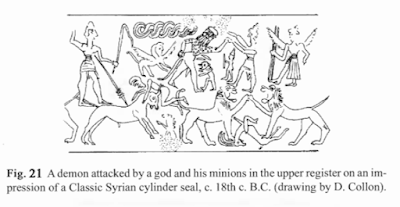
p. 104 .. The dogs and the archer have not yet appeared in any literary version of the slaying of Huwawa, so again it may be that the Mesopotamian artistic tradition was used in this case for a local myth or legend. Clark Hopkins in 1934[34: https://www.jstor.org/stable/498901] demonstrated that this scene of Mesopotamian origin was the source of Aegean depictions of Perseus slaying the Gorgon: the original Huwawa (himself an improvisation) in some form reached the Aegean and was there t
September 27, 2022
Greeks praised highly the mathematical abilities of the Egyptians
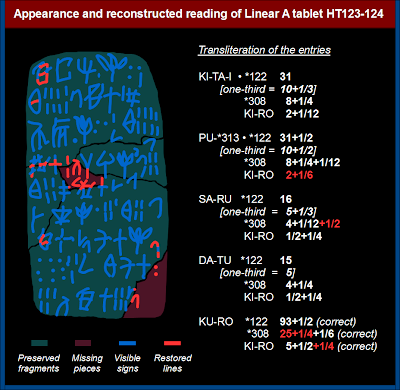 ÎινÏική Ïινακίδα HT 123-124 Ïε ÎÏαμμική Î
ÎινÏική Ïινακίδα HT 123-124 Ïε ÎÏαμμική ÎΣε άÏθÏο ÏÎ¿Ï Ï Î¿Î¹ ÎÎ¿Î¾Î¹Î¬Î´Î·Ï ÎºÎ±Î¹ ΣαλιαÏÏÏ Ï ÏοÏÏηÏÎ¯Î¶Î¿Ï Î½ Ïην άÏοÏη ÏÏι âοι ÎÎ»Î»Î·Î½ÎµÏ ÎµÏήνεÏαν ιδιαίÏεÏα ÏÎ¹Ï Î¼Î±Î¸Î·Î¼Î±ÏικÎÏ Î¹ÎºÎ±Î½ÏÏηÏÎµÏ ÏÏν ÎÎ¹Î³Ï ÏÏίÏν και ÏίÏÏÎµÏ Î±Î½ ÏÏι οι ÏÏÏγονοί ÏÎ¿Ï Ï ÎµÎ¯Ïαν μάθει Ïην ÏÎÏνη αÏÏ Î±Ï ÏοÏÏâ.[1] ΠάÏοÏη ÏαίνεÏαι να εÏαναλαμβάνεÏαι με μικÏÎÏ ÏαÏαλλαγÎÏ Î±ÏÏ ÏÎ»Î®Î¸Î¿Ï ÎµÏÎµÏ Î½Î·ÏÏν, αÏοÏελÏνÏÎ±Ï â θα λÎγαμε â Ïην εÏικÏαÏοÏÏα ανÏίληÏη ÏÏην εÏιÏÏημονική κοινÏÏηÏα. Î ÏάγμαÏι ο van der Waerden εμÏανίζεÏαι και Î±Ï ÏÏÏ Î¸Î±Ï Î¼Î±ÏÏÎ®Ï ÏÏν ÎÎ¹Î³Ï ÏÏιακÏν ÎαθημαÏικÏν, ÏημειÏνει δε ÏÏι ÎÎ»Î»Î·Î½ÎµÏ ÏÎ·Ï ÎºÎ»Î±ÏÎ¹ÎºÎ®Ï ÏεÏιÏÎ´Î¿Ï Î±Î»Î»Î¬ και οι καÏοÏινοί αναγνÏÏιζαν Ïην ÏÏεÏική ÏÏÏÏοκαθεδÏία ÏÏν ÎÎ¹Î³Ï ÏÏίÏν, για ÏαÏάδειγμα ÏÏην ÎεÏμεÏÏία.[2] Îι Ï ÏοÏÏηÏικÏÎÏ ÏÎ·Ï Î±ÏÏÏεÏÏ ÏÏηÏίζονÏαι καÏά βάÏιν Ïε αναÏοÏÎÏ ÏÎ¿Ï ÎÏοδÏÏÎ¿Ï , ÏÎ¿Ï ÎÏιÏÏοÏÎÎ»Î¿Ï Ï, Ïε άÏοÏη αÏοδιδÏμενη ÏÏον ÎημÏκÏιÏο κ.α.[3] ÎÏ ÎµÎ¾ÎµÏάÏÎ¿Ï Î¼Îµ διâ ολίγÏν Î±Ï ÏÎÏ ÏÎ¹Ï Î±Î½Î±ÏοÏÎÏ, αÏαÏάλλακÏα εÏαναλαμβανÏÎ¼ÎµÎ½ÎµÏ Î±ÏÏ ÏÎ¿Ï Ï ÎµÎ¹Î´Î¹ÎºÎ¿ÏÏ.
Î ÎÏÏδοÏοÏ, Hdt.2.109.3, αναÏÎÏει:
Îαι ÎÏÏ Ïη γνÏμη ÏÏι ÎÏÏι ανακαλÏÏθηκε η γεÏμεÏÏία και ανÎβηκε ÏÏην Îλλάδα. ÎÏο για Ïο Î·Î»Î¹Î±ÎºÏ ÏολÏι και Ïον γνÏμονα και Ïα δÏδεκα μÎÏη ÏÎ·Ï Î·Î¼ÎÏÎ±Ï Î¿Î¹ ÎÎ»Î»Î·Î½ÎµÏ Ïα Îμαθαν αÏÏ ÏÎ¿Ï Ï ÎÎ±Î²Ï Î»ÏÎ½Î¯Î¿Ï Ï.
ή ÏÏÏÏοÏÏÏÏÏ:
.. δοκÎει δε μοι á¼Î½Î¸Îµá¿¦Ïεν γεÏμεÏÏίη εá½Ïεθεá¿Ïα á¼Ï Ïὴν á¼Î»Î»Î¬Î´Î± á¼Ïανελθεá¿Î½: ÏÏλον μὲν
ΠιÏÏοÏιογÏάÏÎ¿Ï Î¿Î¼Î¹Î»ÎµÎ¯ ÎµÎ´Ï ÏεÏί δÏÎ¾Î±Ï ÏÎ¿Ï , ήÏοι δοξαÏÎ¯Î±Ï Î¬Î»Î»ÏÏ ÏίÏÏεÏÏ / αÏÏÏεÏÏ ÏÎ¿Ï Î´ÎµÎ½ ÏÏηÏίζεÏαι Ïε αÏοδείξειÏ, Ï Î¹Î¿Î¸ÎµÏεί μάλιÏÏα Ïον ÏÏο εÏανελθείν, αναÏεÏÏÎ¼ÎµÎ½Î¿Ï Î¼Î¬Î»Î»Î¿Î½ Ïε εÏανάκαμÏη â εÏανεμÏάνιÏη ÏÎ·Ï ÏÎÏÎ½Î·Ï ÏÎ¿Ï Î¼Î¿Î¹Î¬Î¶ÎµÎ¹ ÎÏÏι να Ï ÏήÏÏε ÏαλαιÏÏεÏα αλλά εξηÏανίÏθη, ίÏÏÏ ÏÏα ÏÏÏνια ÏÏν λεγομÎνÏν ÏκοÏεινÏν αιÏνÏν![4] Îι ÏλείÏÏοι εÏÎµÏ Î½Î·ÏÎÏ ÏαÏακάμÏÏÎ¿Ï Î½ ÏÎ¹Ï ÏαÏαÏηÏήÏÎµÎ¹Ï ÏÎ¿Ï Î¹ÏÏοÏιογÏάÏÎ¿Ï , Î±ÎºÎ¿Î»Î¿Ï Î¸ÏνÏÎ±Ï Î¼Î¹Î± μάλλον αÏλοÏκή ή και ÏονδÏοειδή καÏανÏηÏη ÏÏν λεγομÎνÏν ÏÎ¿Ï , ÏÎÏοιαν ÏÎ¿Ï Î½Î± Ï ÏηÏεÏεί Ïο γνÏÏÏÏ Î±Ïήγημα ÏÎ·Ï Î±Î½ÏÏεÏÏÏηÏÎ¿Ï ÏÏν ÎÎ¹Î³Ï ÏÏίÏν. ÎξιοÏημείÏÏο είναι ÎµÎ´Ï ÏÏι ÏÏο ÏαÏαÏÎ¬Î½Ï ÏÏÏίον ο ÎÏÏδοÏÎ¿Ï Î±Î½Î±ÏÎÏεÏαι και ÏÏον ΣÎÏÏÏÏÏι, ÎιγÏÏÏιο ÏαÏÎ±Ï ÏÎ·Ï Î§ÎÎ Î´Ï Î½Î±ÏÏείαÏ, καÏά Ïην βαÏιλεία ÏÎ¿Ï Î¿ÏÎ¿Î¯Î¿Ï ÏιÏÏοÏοιείÏαι η ÏαÏÎ¿Ï Ïία ÎινÏιÏÏν αÏÏιÏεκÏÏνÏν καÏά Ïην ανÎγεÏÏη μνημειακÏν ÎÎ¹Î³Ï ÏÏιακÏν ÎÏγÏν, ÏÏÏÏ ÎºÎ±ÏαδεικνÏει η ανÎÏ ÏεÏη ÏÏo εÏγοÏάξιο καÏαÏÎºÎµÏ Î®Ï ÏÎ·Ï ÏÏ ÏÎ±Î¼Î¯Î´Î±Ï ÏÎ¿Ï ÏαÏÎ±Ï Î´Ïο κανÏνÏν μεÏÏήÏεÏÏ Î´Î¹Î±Î³ÏαμμιÏμÎνÏν ÏÏμÏÏνα με Ïο ÎινÏÎ¹ÎºÏ Î¼ÎÏÏο, Î¼Î±Î¶Ï Î¼Îµ κεÏαμεική ÏοÏÎ¹ÎºÎ®Ï ÎºÎ±ÏαÏÎºÎµÏ Î®Ï Î±Î»Î»Î¬ ÎινÏÎ¹ÎºÎ¿Ï ÏÏÎ¿Ï Ï![5]
Î ÎÏιÏÏοÏÎÎ»Î·Ï Î±ÏÏ Ïην ÏÎ»ÎµÏ Ïά ÏÎ¿Ï , Îetaph. A981.b23, αναÏεÏÏÎ¼ÎµÎ½Î¿Ï Ïε θÎμαÏα εÏιÏÏÎ®Î¼Î·Ï & ÏÎÏÎ½Î·Ï ÎÏει γÏάÏει για Ïην ÏÏÎÏη ÎÎ¹Î³Ï ÏÏίÏν και μαθημαÏικÏν ÏεÏνÏν:
Îιâ Î±Ï ÏÏ ÎµÎ¹Ï Ïην ÎÎ¯Î³Ï ÏÏον καÏά ÏÏÏÏον ÏÏ Î½ÎµÏÏήθηÏαν οι μαθημαÏικÎÏ ÏÎÏνεÏ. ÎαθÏÏον εκεί αÏÎθηκε διαθÎÏÎ¹Î¼Î¿Ï ÏÏÏÎ½Î¿Ï ÏÏο ιεÏαÏÎ¹ÎºÏ Î³ÎνοÏ.
ÎεÏÎ±Î¾Ï Î¬Î»Î»Ïν αναÏοÏÏν ÏÎ¿Ï Ï ÏοÏÏηÏÎ¯Î¶Î¿Ï Î½ Ïην θÎÏη ÏÎ¿Ï Î¿ ÎλλανδÏÏ Î¼ÎµÎ»ÎµÏηÏÎ®Ï van der Waerden αναÏÎÏεÏαι και Ïε ÏÏάÏη αÏοδιδÏμενη ÏÏον ÎημÏκÏιÏο, ÏÏÎ¿Ï Î¿ ÏÎµÎ»ÎµÏ ÏÎ±Î¯Î¿Ï ÏÏ Î³ÎºÏίνει Ïον ÎµÎ±Ï ÏÏ ÏÎ¿Ï Î¼Îµ ÏÎ¿Ï Ï ÎÎ¹Î³Ï ÏÏÎ¯Î¿Ï Ï Î±ÏÏεδονάÏÏÎµÏ Î³Î¹Î± να ÏημειÏÏει, ÏμÏÏ, Ïην δική ÏÎ¿Ï Î±Î½ÏÏεÏÏÏηÏα![6] Î ÏÏ Î±Ï ÏÏ ÏÏηÏιμοÏοιείÏαι για να ÏÏηÏίξει Ïην άÏοÏη ÏÎ¿Ï van der Waerden, αλλά και ÏÏν δÏο ÎλλήνÏν μελεÏηÏÏν, δεν Î¼Î±Ï ÎµÎ¯Î½Î±Î¹ καÏανοηÏÏ, εκÏÏÏ Î±Î½ η ÏÏοια άÏοÏή ÏÎ¿Ï ÎµÎ¯Î½Î±Î¹ ÏÏοειλημμÎνη και δεν ÏÏειάζεÏαι αÏοδείξειÏ.
Îια να ÏÏ Î½Î¿ÏίÏÎ¿Ï Î¼Îµ ÏÏÎ¿Ï Î±ÏÏδειξη ÏÎ·Ï Î±ÏÏ Î¼ÎÏÎ¿Ï Ï ÏÏν ÎλλήνÏν ÏÎ·Ï ÎºÎ»Î±ÏÎ¹ÎºÎ®Ï ÏεÏιÏÎ´Î¿Ï Î±Î½Î±Î³Î½ÏÏίÏεÏÏ ÏÎ·Ï ÎÎ¹Î³Ï ÏÏÎ¹Î±ÎºÎ®Ï ÏÏοÏοÏÎµÎ¯Î±Ï ÏÏην ÎεÏμεÏÏική και ÏÏÎ¹Ï Î»Î¿Î¹ÏÎÏ Î¼Î±Î¸Î·Î¼Î±ÏικÎÏ ÏÎÏÎ½ÎµÏ ÏαÏÎÏονÏαι αναÏοÏÎÏ Î½Î¿Î¼Î¹Î¶Î¿Î¼ÎνÏν αÏÏÏεÏν αÏÏ Ïον ÎÏÏδοÏο (για εÏανάκαμÏη ÏÎ·Ï Î³ÎµÏμεÏÏÎ¯Î±Ï ÏÏον ÎÎ»Î»Î±Î´Î¹ÎºÏ ÏÏÏο), ÏÏεÏική ÎÏιÏÏοÏελική αναÏοÏά ÏÏην ÏÎÏνη και άλλη αÏοδιδÏμενη ÏÏον ÎημοÏθÎνη και εÏÎ¼Î·Î½ÎµÏ Ïμενη με κάÏοια ÏÏοκαÏάληÏη! Îεν Ï ÏάÏÏει καμμία αναÏοÏά ÏÏην αÏÏ Î¼ÎÏÎ¿Ï Ï ÏÎ¿Ï ÎÎ±Î»Î¿Ï Î¼ÎÏÏηÏη ÏÎ¿Ï ÏÏÎ¿Ï Ï ÏÏ ÏÎ±Î¼Î¯Î´Î±Ï ÏÏηÏιμοÏοιήÏανÏÎ¿Ï Ïην Ïκιά ÏÎ¿Ï ÎµÎ±Ï ÏÎ¿Ï ÏÎ¿Ï , ÏαÏαÏηÏÏνÏÎ±Ï ÏÏι αν κάÏοια μÎÏα η Ïκιά ÏÎ¿Ï Î³Î¹Î½ÏÏαν ίÏη με Ïο ÏÏÎ¿Ï ÏÎ¿Ï , ÏÏÏε Ïο ίδιο θα ÏÏ Î½Îβαινε και με Ïη Ïκιά ÏÎ¿Ï ÏÏÎ¿Ï Ï ÏÎ·Ï ÏÏ ÏαμίδαÏ.[7] ÎμοίÏÏ ÏαÏαλείÏεÏαι να αναÏεÏθεί η αÏÏ Î¼ÎÏÎ¿Ï Ï ÏÏν ÎινÏιÏÏν Ï Î¹Î¿Î¸ÎÏηÏη αÏÏιÏεκÏονικÏν εÏαÏμογÏν ÏÎ·Ï Î±ÎºÎ¿Î»Î¿Ï Î¸Î¯Î±Ï Fibonacci, αλλά και Ïην ανάÏÏÏ Î¾Î· ÏοιÏογÏαÏιÏν με ÏÏήÏη Ï ÏοδειγμάÏÏν ÏÏοηγμÎνÏν καμÏÏ Î»Ïν (καμÏÏ Î»Î¿Î³ÏάÏÏν).[8]
ΣÏμÏÏνα με Ïην Crawly η εικονογÏαÏία ÏÏν ÎινÏικÏν ÏÏÏαγίδÏν Ï Ïοβάλλει Ïην ιδÎα ÏÏι οι ÎÏήÏÎµÏ ÎµÎ¯Ïαν γνÏÏη διαÏÏÏÏν γεÏμεÏÏικÏν καμÏÏ Î»Ïν, ÏÎ¹Ï Î¿ÏÎ¿Î¯ÎµÏ ÏÏηÏιμοÏοιοÏÏαν ÏÏην ÏÏÏÎ±Î³Î¹Î´Î¿Î³Î»Ï Ïία ÏÎ¿Ï Ï.[9] ΣÏεÏική μελÎÏη ÏÎ¿Ï ÎενδÏÎ¹Î½Î¿Ï ÎµÏί ÏÎ¿Ï ÎινÏÎ¹ÎºÎ¿Ï Î´Î±ÎºÏÏ Î»Î¹Î´Î¹Î¿Ï Î¼Îµ ÏÎ¹Ï ÏÎνÏε ιÎÏειεÏ, Î±Î½Î±ÎºÎ±Î»Ï ÏθÎνÏÎ¿Ï ÏÏον ÏάÏο ÏÎ¿Ï ÎÏ ÎºÎ·Î½Î±Î¯Î¿Ï ÎÏÏÏα ΠολεμιÏÏή, Ï ÏοÏÏηÏίζει ÏÏι οι ÎÏήÏÎµÏ ÎµÎ¯Ïαν γνÏÏη ÏÎ·Ï ÎµÎ»Î»ÎµÎ¯ÏεÏÏ, μάλιÏÏα δε Î±Ï ÏÎ®Ï ÏÏÎ¿Ï Î¿ λÏÎ³Î¿Ï ÏÏν ÎºÏ ÏίÏν διαμÎÏÏÏν ιÏοÏÏαι με Ïον ÏÏÏ ÏÏ Î±ÏιθμÏ.[10] ÎμμεÏÎµÏ ÎµÎ½Î´ÎµÎ¯Î¾ÎµÎ¹Ï Î³Î¹Î± ÏÎ¹Ï Î³ÎµÏμεÏÏικÎÏ Î³Î½ÏÏÎµÎ¹Ï ÏÏν ÎινÏιÏÏν ενδεÏομÎνÏÏ ÏÏοκÏÏÏÎ¿Ï Î½ αÏÏ Ïην μελÎÏη άλλÏν ÏεÏÎ½Î¿Ï ÏγημάÏÏν ÏÎ¿Ï Ï. ÎÏÏι ÎÏει Ï ÏοÏÏηÏιÏθεί η ικανÏÏηÏά ÏÎ¿Ï Ï Î½Î± διÏοÏομοÏν και να ÏÏιÏοÏομοÏν Ïην οÏθή γÏνία,[11] ÎµÎ½Ï ÏιθανολογείÏαι εÏίÏÎ·Ï Î· αÏÏ Î¼ÎÏÎ¿Ï Ï ÏÎ¿Ï Ï ÎµÎ¾Î¿Î¹ÎºÎµÎ¯ÏÏη με Ïον διαβήÏη και Ïον κανÏνα![12]
ΠκÏκλοÏ, η ÎλλειÏη, η κÏνική Ïομή, Ïο ÏÏίγÏνο και Ïο ÏÏξο Ï ÏήÏξαν μαθημαÏικÎÏ â γεÏμεÏÏικÎÏ Î¿Î½ÏÏÏηÏÎµÏ Î¿Î¹ οÏÎ¿Î¯ÎµÏ ÎºÎ±ÏÎÏÏηÏαν Î¿Î¹ÎºÎµÎ¯ÎµÏ ÏÏον ÎινÏÎ¹ÎºÏ ÏολιÏιÏμÏ, Î±Ï ÏÏ Î´Îµ Ïο γεγονÏÏ ÎºÎ±Î¸Î¹ÏÏοÏÏε Î´Ï Î½Î±Ïή Ïην καÏαÏÎºÎµÏ Î® Ï ÏοδειγμάÏÏν â ÏÏοÏÏÏÏν (καμÏÏ Î»Î¿Î³ÏάÏÏν ή stencil) ÏÏν ανÏÏÎÏÏ ÏÏημάÏÏν, Ïα οÏοία ÎµÏ ÏίÏκονÏο ÏÏην διάθεÏη ÏÏν καλλιÏεÏνÏν. Πκαλή καÏάÏÏαÏη ÏÏν ÏοιÏογÏαÏιÏν ÏÎ¿Ï ÎκÏÏÏηÏÎ¯Î¿Ï ÎήÏÎ±Ï ÎµÏÎÏÏεÏε Ïην ÎµÎ¾Î¿Î½Ï ÏιÏÏική μελÎÏη ÏÎ¿Ï Ï, ήδη δε Ï ÏοÏÏηÏίζεÏαι ÏÏι ÏÏην εικονογÏάÏηÏη ÏÏÏον ÏÏν ÏÏημαÏικÏν θεμάÏÏν και ÏÏν ανθοÏÏ Î½Î¸ÎÏεÏν, ÏÏον και ÏÏν ανθÏÏÏινÏν ÏαÏαÏÏάÏεÏν Îγινε ÏÏήÏη ÏμημάÏÏν μαθημαÏικÏν καμÏÏ Î»Ïν, οι οÏÎ¿Î¯ÎµÏ ÏαÏάÏθηκαν με Ïην βοήθεια ÏÏν ÏÏοαναÏεÏθÎνÏÏν καμÏÏ Î»Î¿Î³ÏάÏÏν. ΤÎÏοια ÏÏήÏη ÎÏει ÏήμεÏα εÏιβεβαιÏθεί ÏÏην καÏαÏÎºÎµÏ Î® ÏÏν ÎÏγÏν με ÏÎ¹Ï âKÏοκοÏÏ Î»Î»ÎκÏÏιεÏâ, ÏÏα âÎÏ Î¼Î½Î¬ αγÏÏιαâ, ÏÏÎ¹Ï Î±ÏεικονίÏÎµÎ¹Ï ÏÏειÏÏν ÏÏην ÎεÏÏή 3, αλλά και ÏÏην âÎÏ ÎºÎ·Î½Î±Î¯Î±â.[13] Îιά ÏαÏάδειγμα για Ïην εικονογÏάÏηÏη ÏÏν âKÏοκοÏÏ Î»Î»ÎµÎºÏÏιÏνâ οι καλλιÏÎÏÎ½ÎµÏ ÏÏηÏιμοÏοίηÏαν εÏÏά γεÏμεÏÏικά Ï ÏοδείγμαÏα καμÏÏ Î»Ïν, ήÏοι ÏεÏÏάÏÏν Ï ÏεÏβολÏν, δÏο ελλείÏεÏν και δÏο ÎÏÏιμήδειÏν ÏÏειÏÏν, ÎµÎ½Ï Î³Î¹Î± Ïην âÎÏ ÎºÎ·Î½Î±Î¯Î±â Ï Î¹Î¿Î¸ÎµÏήθηκαν δÏο γÏαμμικÎÏ ÏÏείÏÎµÏ ÎºÎ±Î¹ μία Ï ÏεÏβολή. H ÏÏήÏη μαθημαÏικÏν καμÏÏ Î»Ïν για Ïην αÏÏιÏÏεÏη εικονογÏάÏηÏη ÏοιÏογÏαÏιÏν εμÏανίζεÏαι για ÏÏÏÏη ÏοÏά ÏÏα ÏαγκÏÏμια ÏÏονικά ÏÏο ÎκÏÏÏήÏιο ÎήÏαÏ, ÎÏÎ¿Ï Î½ δε διαÏÏ ÏÏθεί διάÏοÏÎµÏ Ï ÏοθÎÏÎµÎ¹Ï ÏÏεÏικÎÏ Î¼Îµ Ïην διαδικαÏία και Ïον εξοÏλιÏÎ¼Ï Ï Î»Î¿ÏοιήÏεÏÏ.[14]
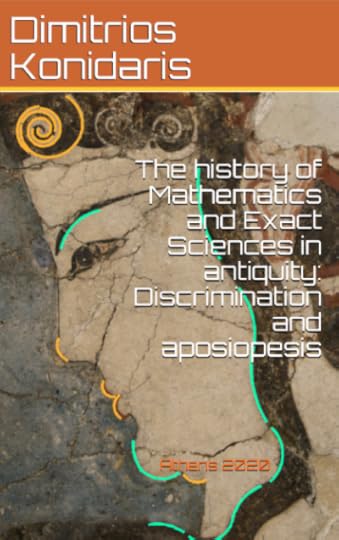
ÎλείνονÏÎ±Ï Ïο ÏαÏÏν ÏÏÏλιο ÏημειÏÎ½Î¿Ï Î¼Îµ Ïην Î±Ï ÏÏηÏή διαÏÏÏÏÏη ÏÎ¿Ï Neugebauer ÏÏι Ïα ÎÎ¹Î³Ï ÏÏιακά μαθημαÏικά δεν ÏÏ Î½ÎµÎ¹ÏÎÏεÏαν θεÏικά ÏÏην ανάÏÏÏ Î¾Î· ÏÎ·Ï Î¼Î±Î¸Î·Î¼Î±ÏÎ¹ÎºÎ®Ï Î³Î½ÏÏεÏÏ,[46] Ïε κάθε ÏεÏίÏÏÏÏη δε Ïα ÎαθημαÏικά καÏÎÏÏηÏαν εÏιÏÏήμη με Ïην ÏαÏÎμβαÏη ÏÏν ÎλλήνÏν!
ΣÎÎÎÎΩΣÎÎΣ
[1]. Doxiadis and Sialaros 2013, p. 368.[2]. ÎονιδάÏÎ·Ï 2021, Ïελ. 13.
[3]. Doxiadis and Sialaros 2013, n. 8.
[4]. ΠΠλάÏÏν ÏÏο ÎÏγο ÏÎ¿Ï Î¤Î¯Î¼Î±Î¹Î¿Ï Î¼Î±Ï ÏληÏοÏοÏεί ÏÏι ο ΣÏλÏν ÏαξίδεÏε και ÏÏην ÎÎ¯Î³Ï ÏÏο ÏÏÎ¿Ï ÎÎ½Î±Ï ÎιγÏÏÏÎ¹Î¿Ï Î¹ÎµÏÎÎ±Ï ÏÎ¿Ï ÎµÎ¯Ïε Ïα εξήÏ: ΣÏλÏν ÎÎ»Î»Î·Î½ÎµÏ Î±ÎµÎ¯ ÏÎ±Î¯Î´ÎµÏ ÎµÏÏÎ, γÎÏÏν δε Îλλην Î¿Ï Îº εÏÏίν, δηλαδή ΣÏλÏνα εÏÎµÎ¯Ï Î¿Î¹ ÎÎ»Î»Î·Î½ÎµÏ Î¼ÎνεÏε ÏάνÏα Ïαιδιά και δεν Ï ÏάÏÏει γÎÏονÏÎ±Ï ÎλληναÏ.
[5]. ÎονιδάÏÎ·Ï 2021, Ïημ. 48.
[6]. ÎονιδάÏÎ·Ï 2021, Ïημ. 47.
[7]. ÎονιδάÏÎ·Ï 2021, Ïημ. 102.
[8]. ÎονιδάÏÎ·Ï 2021, Ïελ. 38, Ïημ. 128, 130.
[9]-[14]. ÎονιδάÏÎ·Ï 2021, Ïημ. 90 ÎÏÏ 95.
[15]. ÎονιδάÏÎ·Ï 2021, Ïημ. 46.
ÎÎÎÎÎÎÎΡÎΦÎÎ
ÎονιδάÏηÏ, Î. Î. 2021. ÎÏÏοÏία ÏÏν θεÏικÏν ÏεÏνÏν και εÏιÏÏημÏν καÏά Ïην αÏÏαιÏÏηÏα, lulu.
https://www.academia.edu/347960/Sing_...
https://books.google.gr/books?id=-v3o...
Doxiadis, A. and M. Sialaros. 2013. âSing Muse on the Hypotenuse. Influences of Poetry and Rhetoric on the Formation of Greek Mathematics,â in Writing Science: Medical and Mathematical Authorship in Ancient Greece, ed. Markus Asper, pp. 367-410.
https://www.academia.edu/21210624/Geo.... Papaodysseus, C., M. Panagopoulos, P. Rousopoulos, G. Galanopoulos, & C. Doumas. 2008. "Geometric templates used in the Akrotiri (Thera) wall-paintings," Antiquity 82, pp. 401â408.Î ÎÎÎΠΠΡÎΣΦÎΤÎΣ ÎÎÎ ÎÎΥΤÎΣÎÎΣ - ÎÎ ÎÎÎÎÎÎÎ: 280922ΣÎÎÎÎΩΣÎ: Î ÏÏÏÏÎ¿Ï ÏÏν ÏÏ Î³Î³ÏαÏÎÏν αÏνήθηκε να εÏιÏειÏημαÏολογήÏει για Ïην άÏοÏή ÏÎ¿Ï ..



